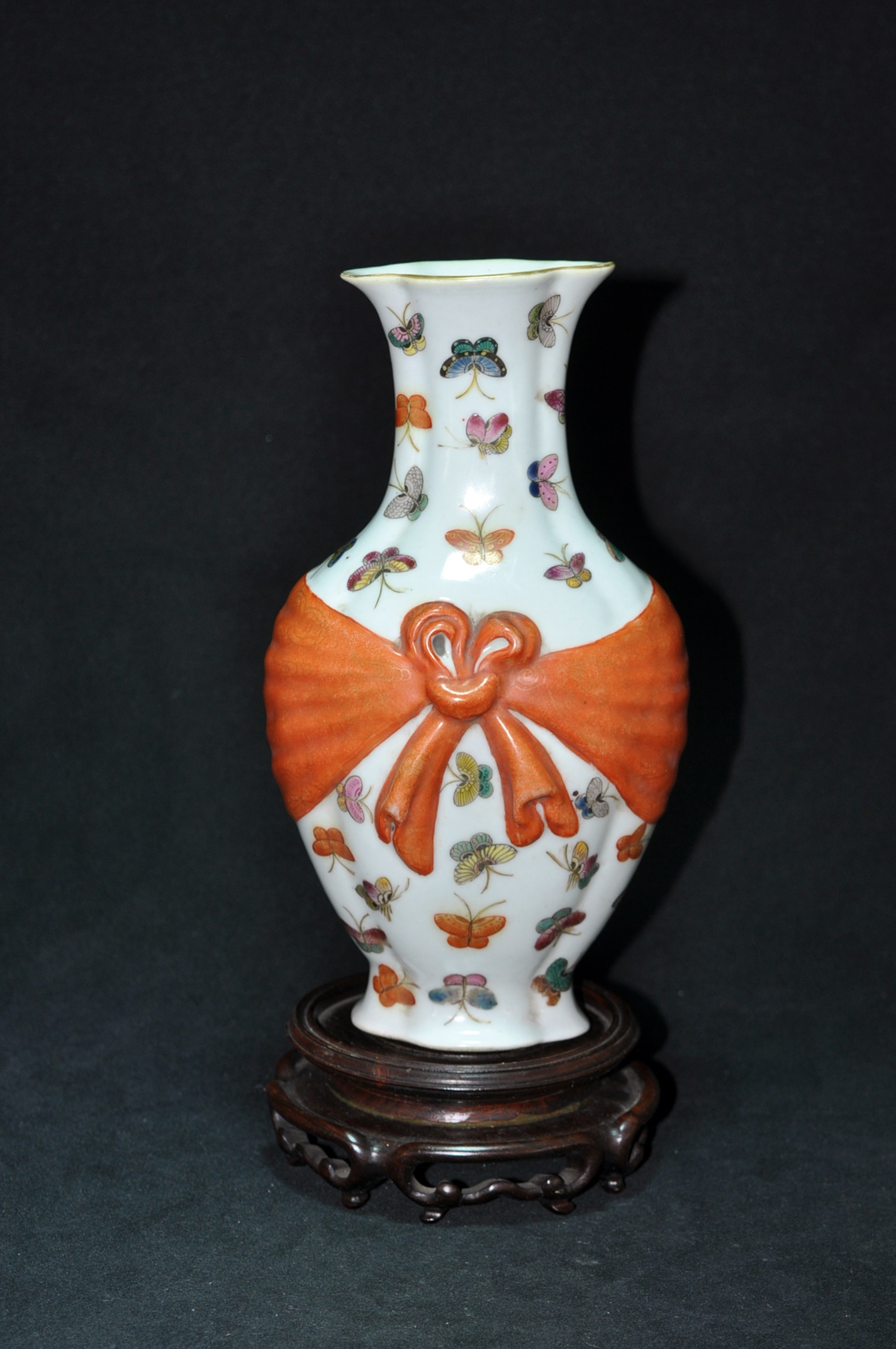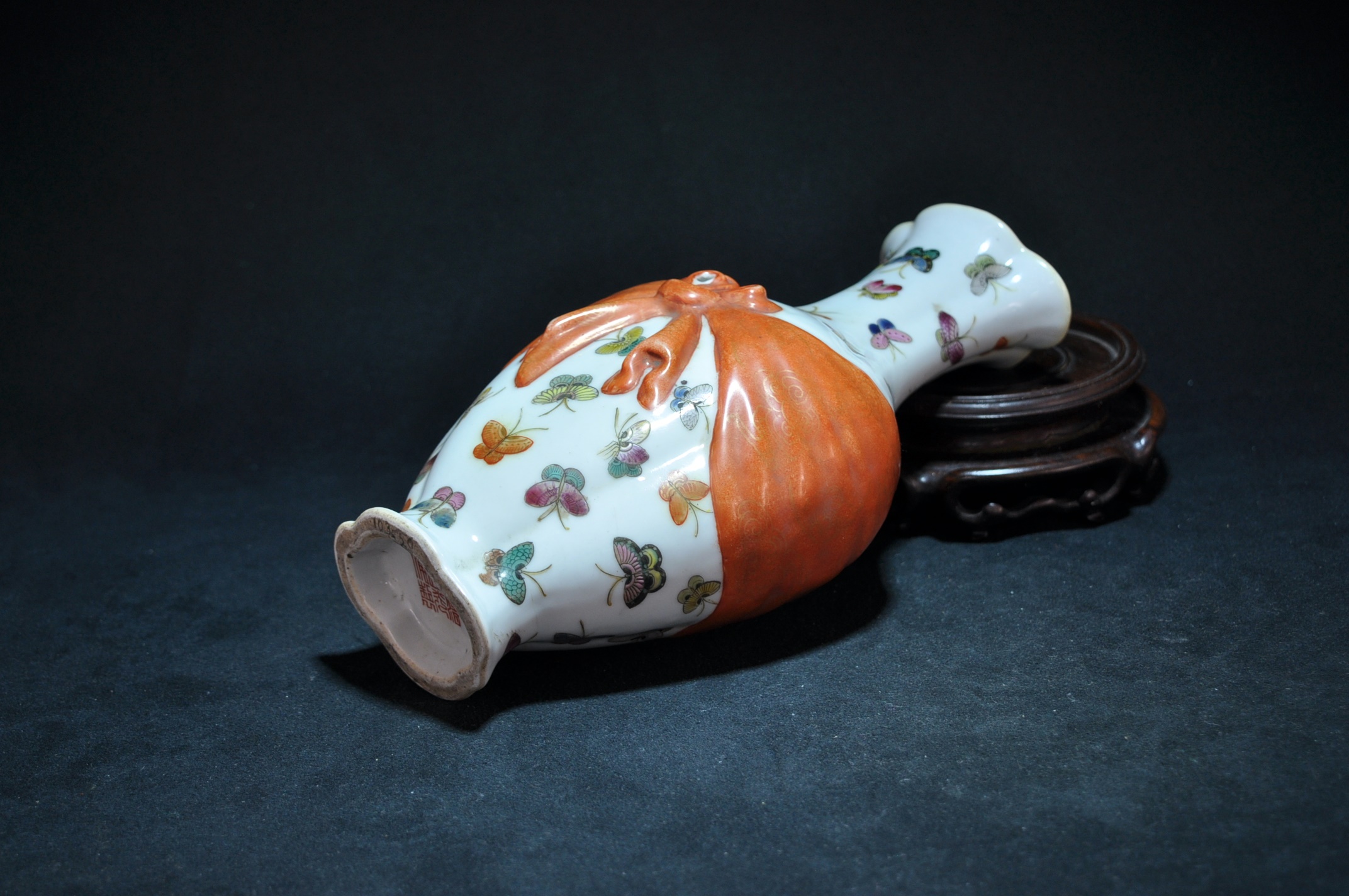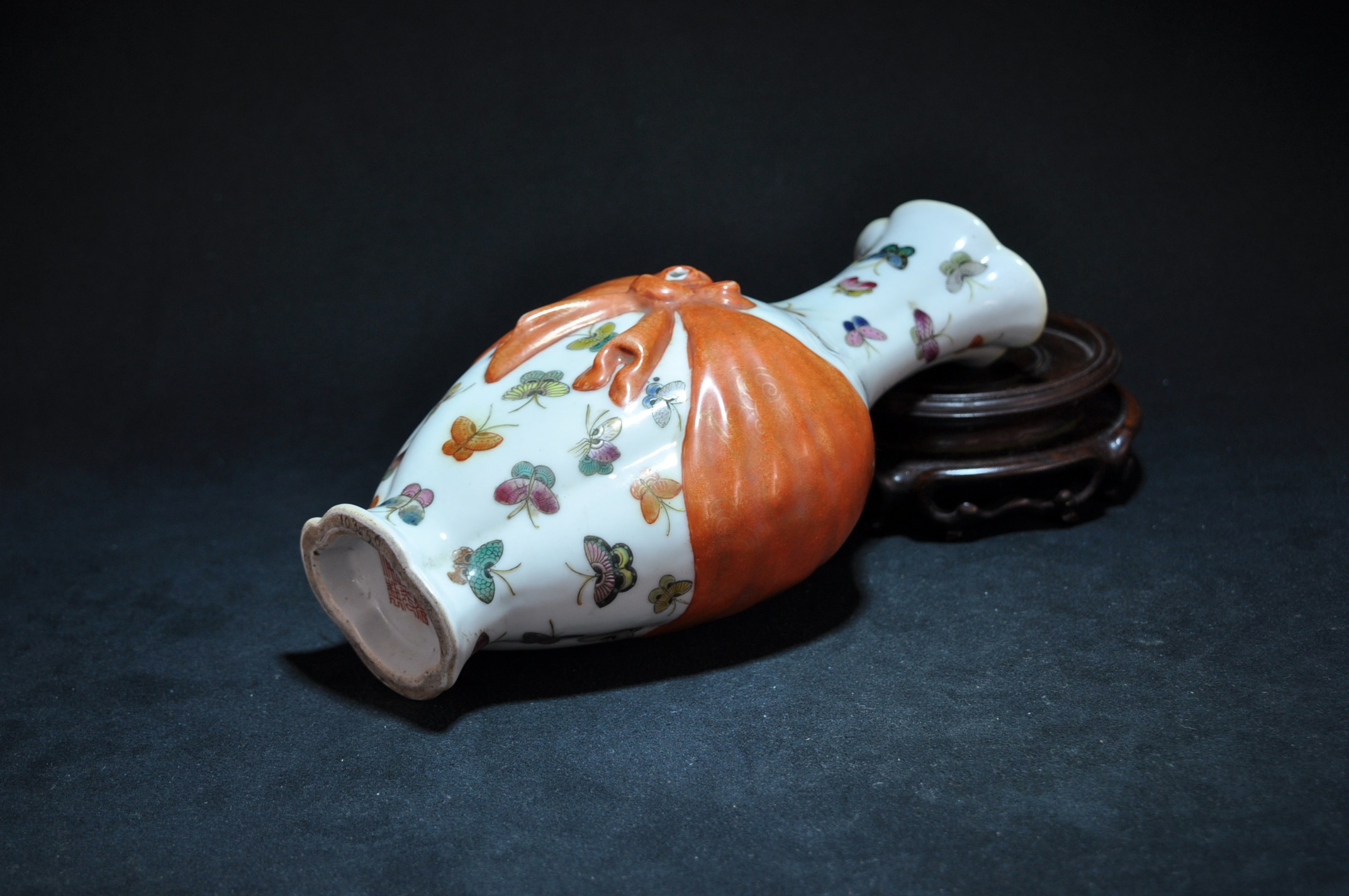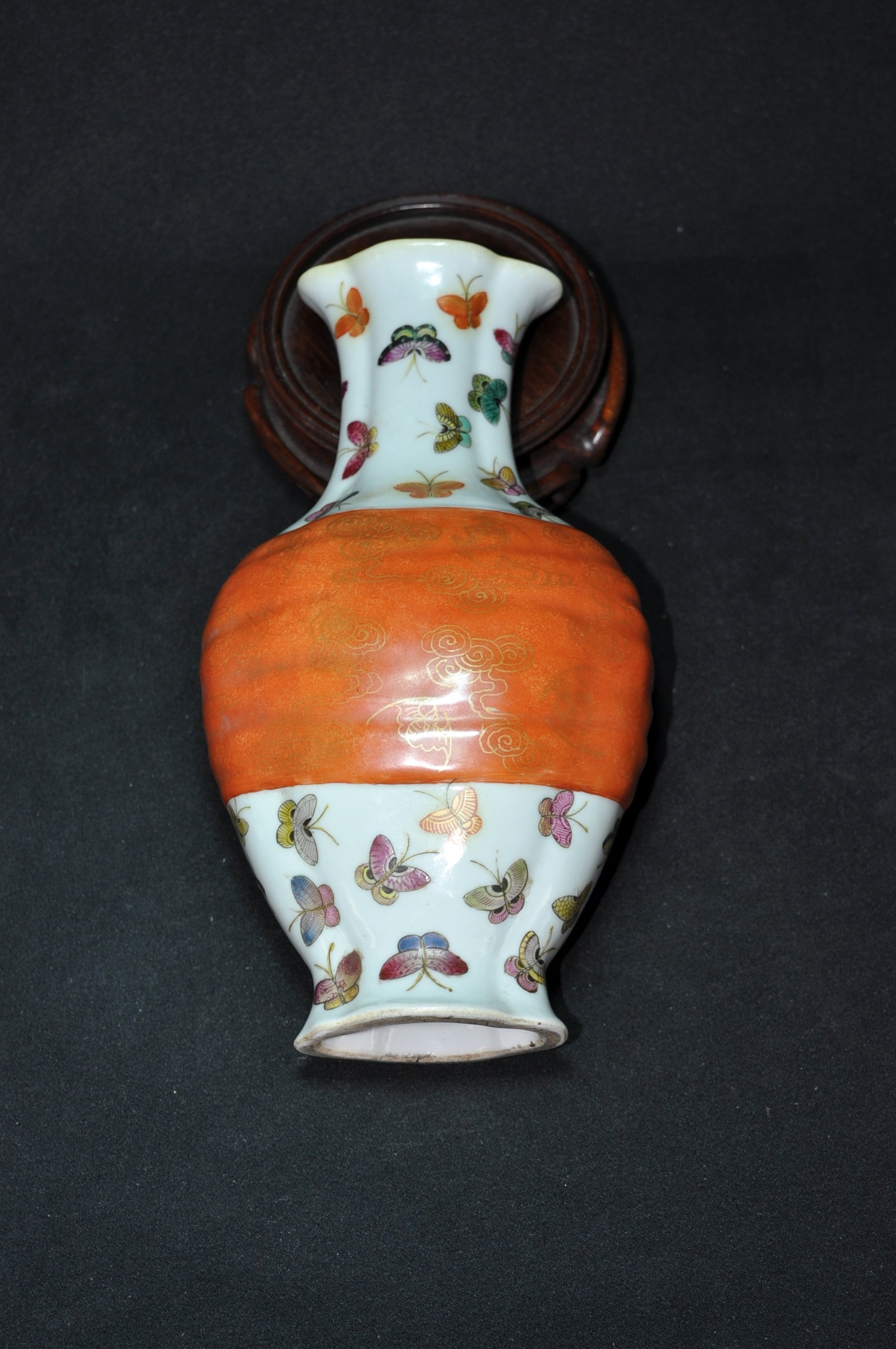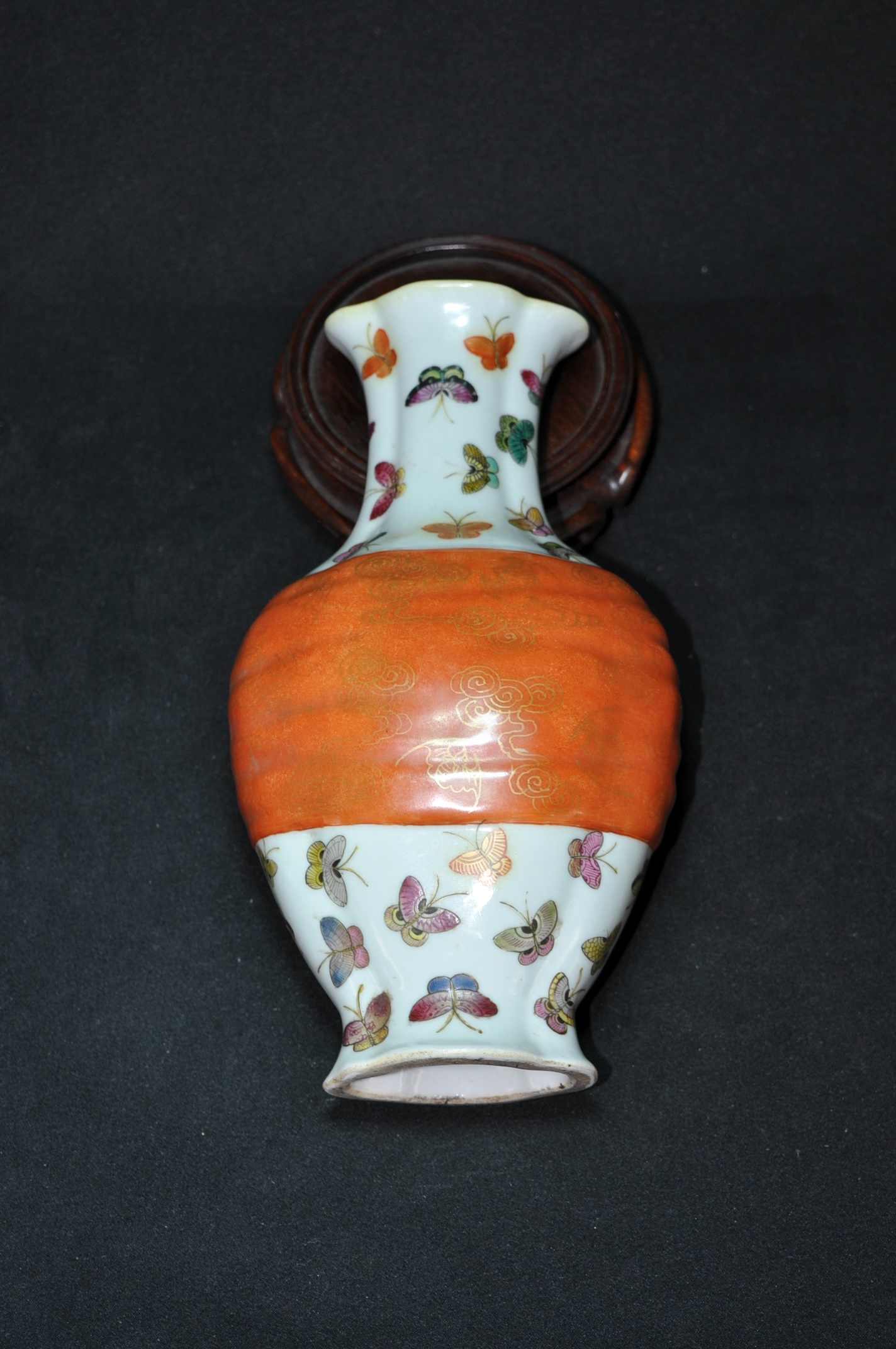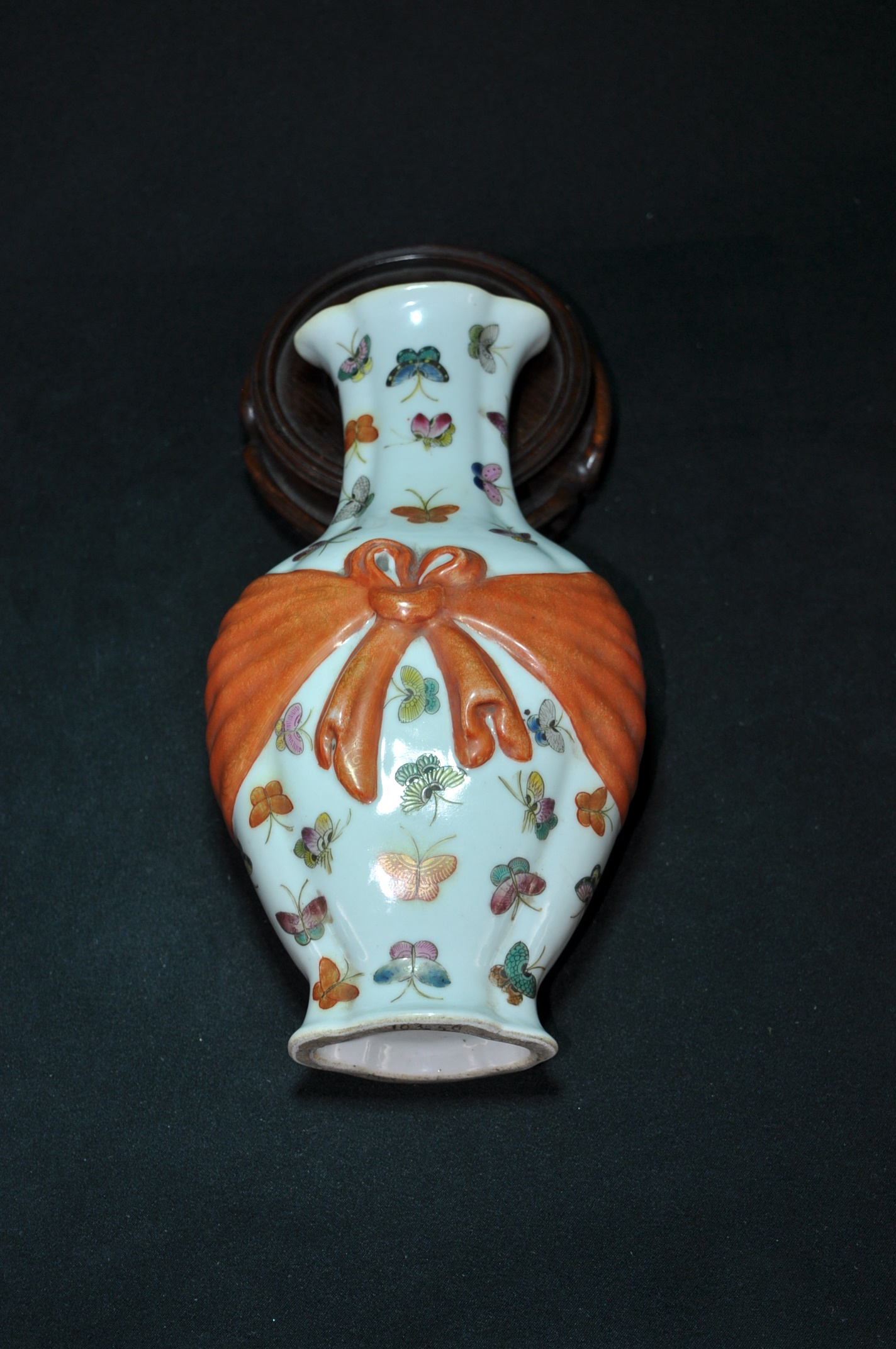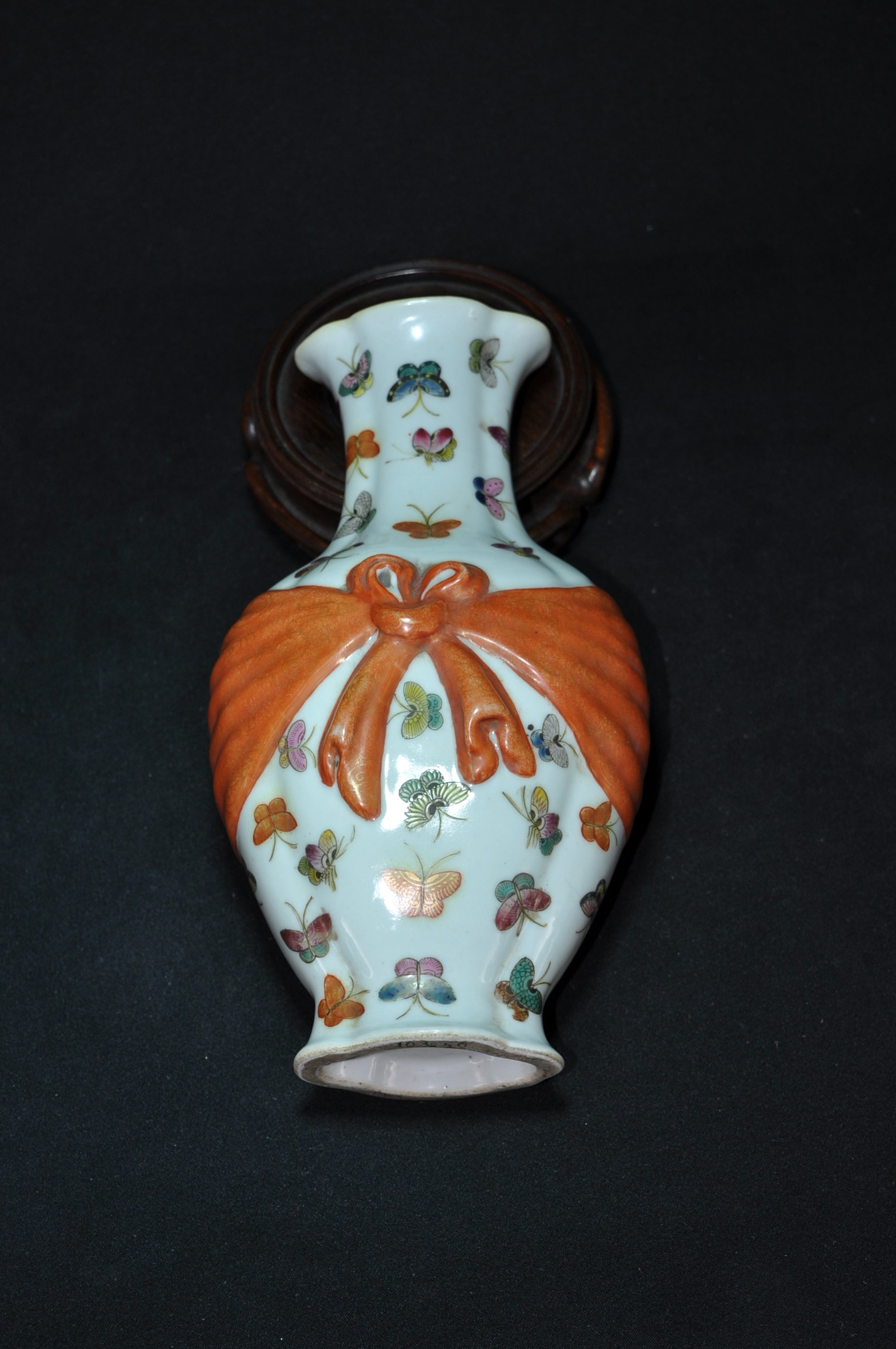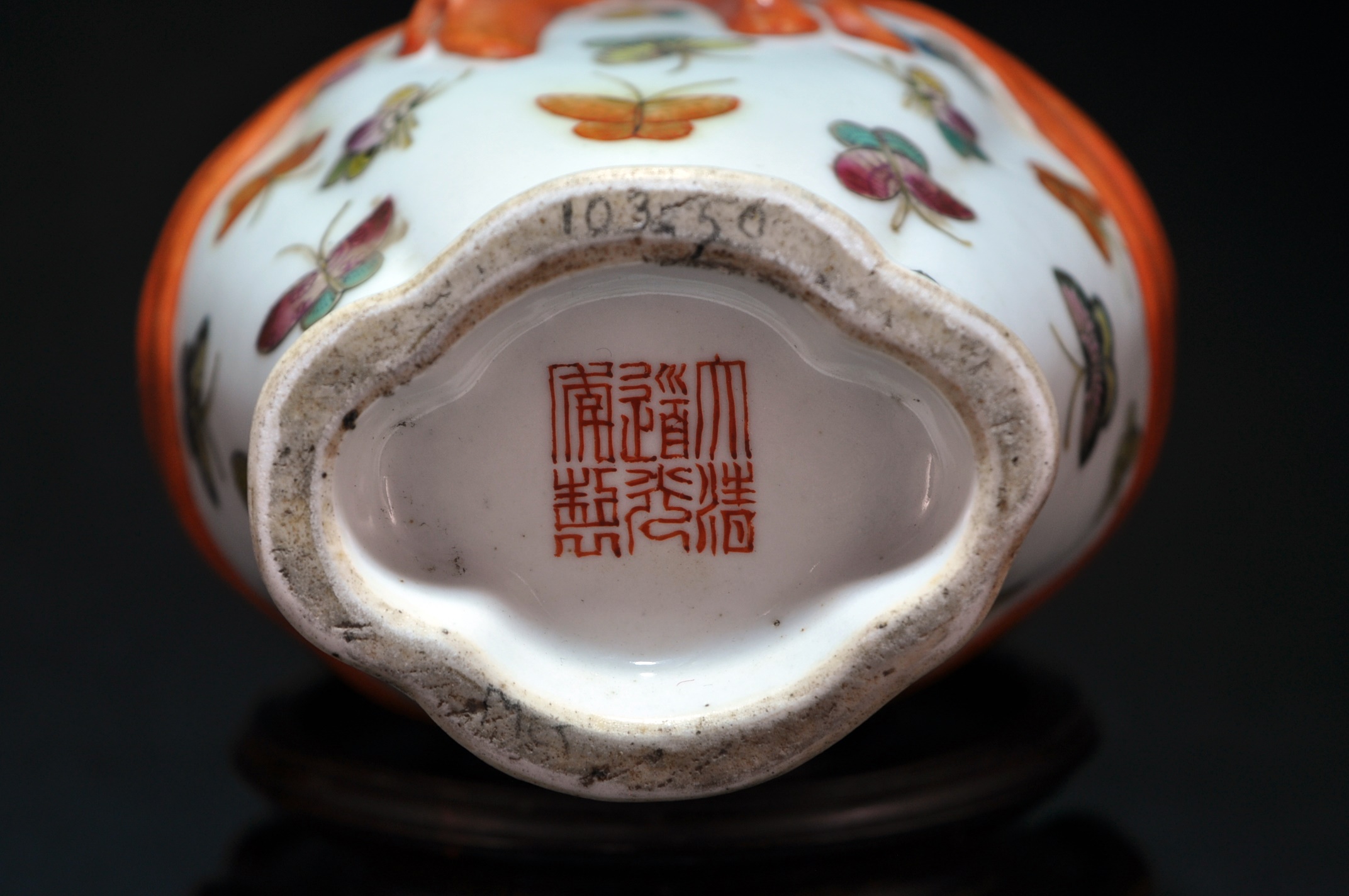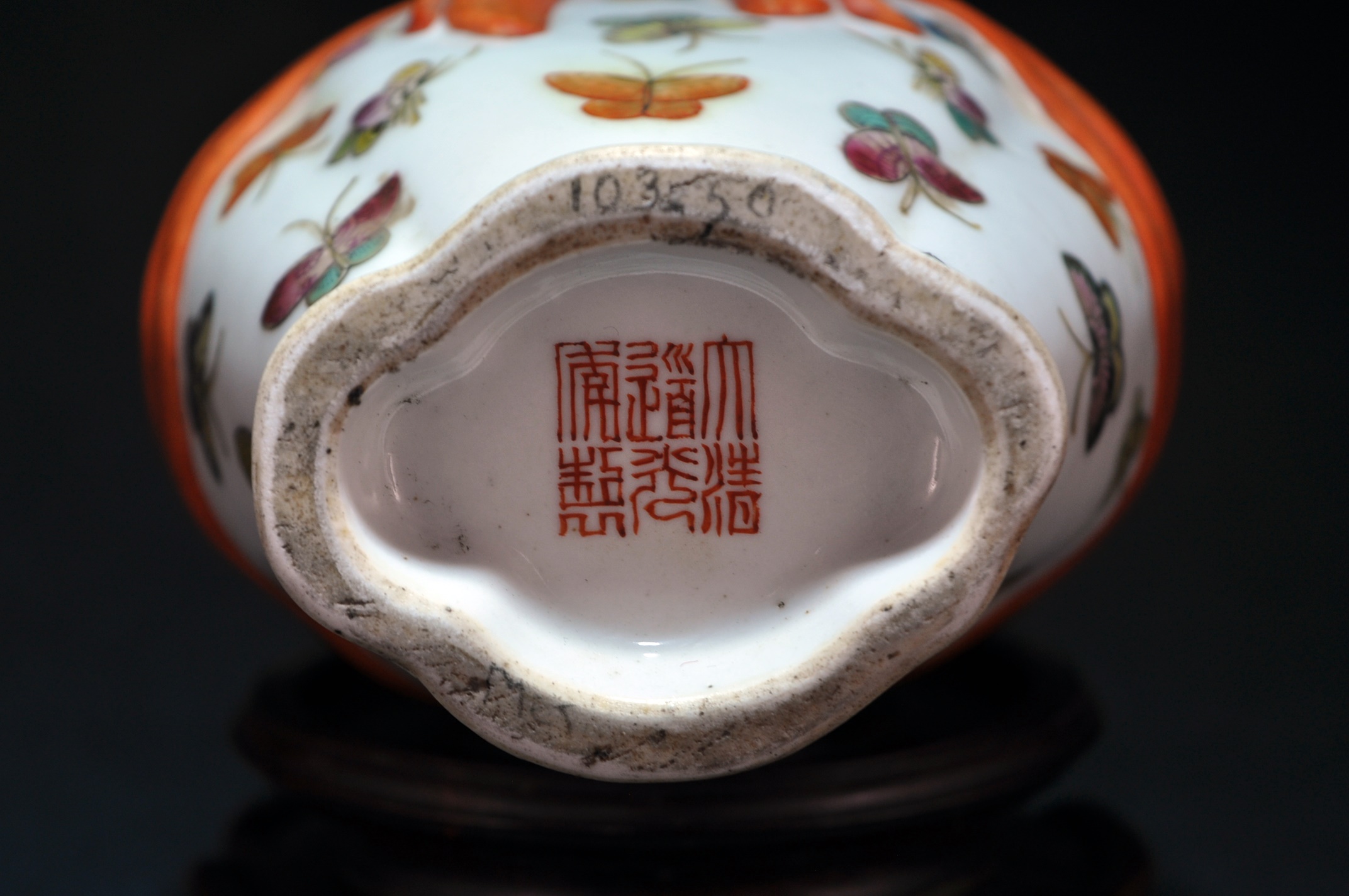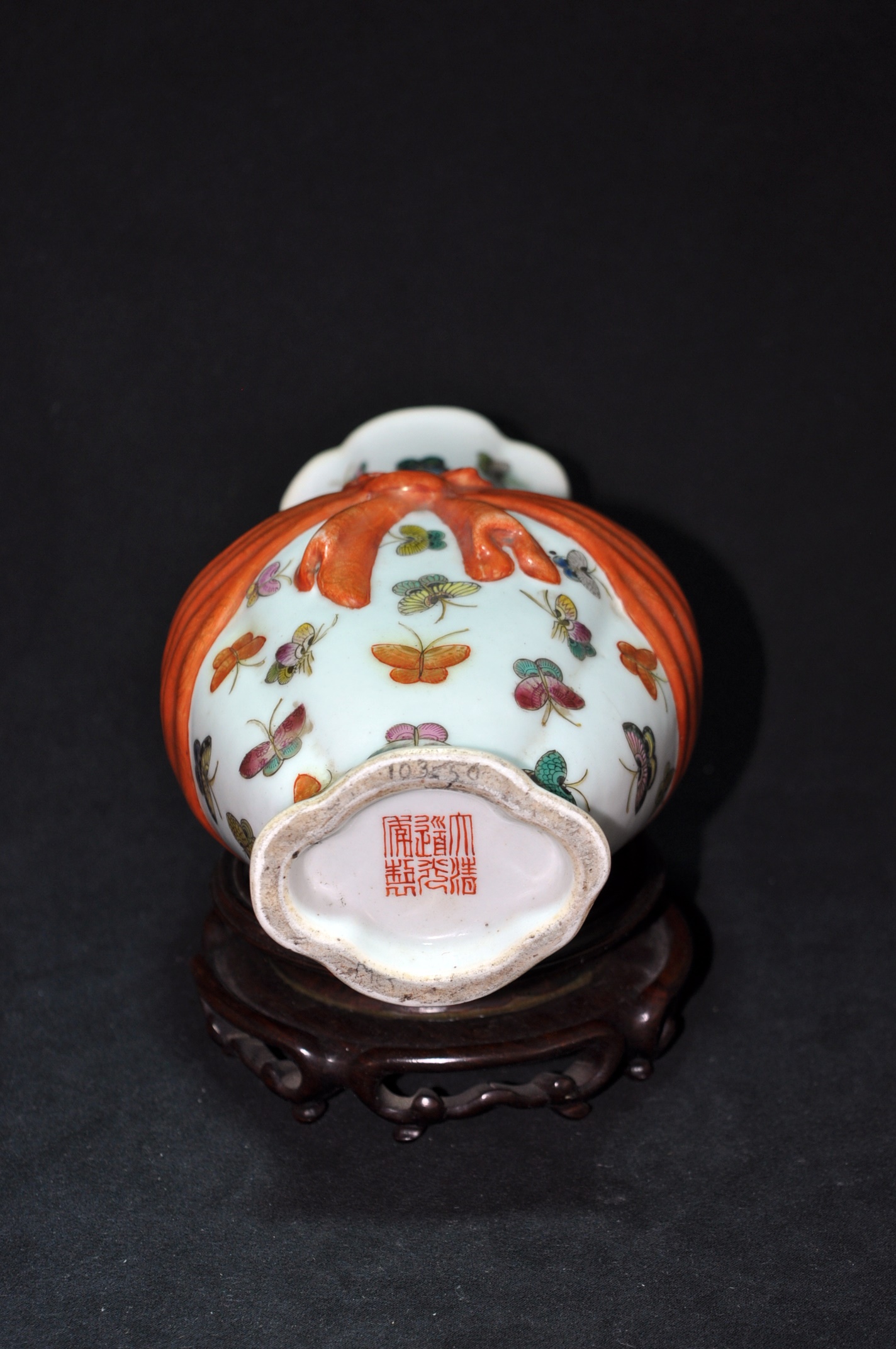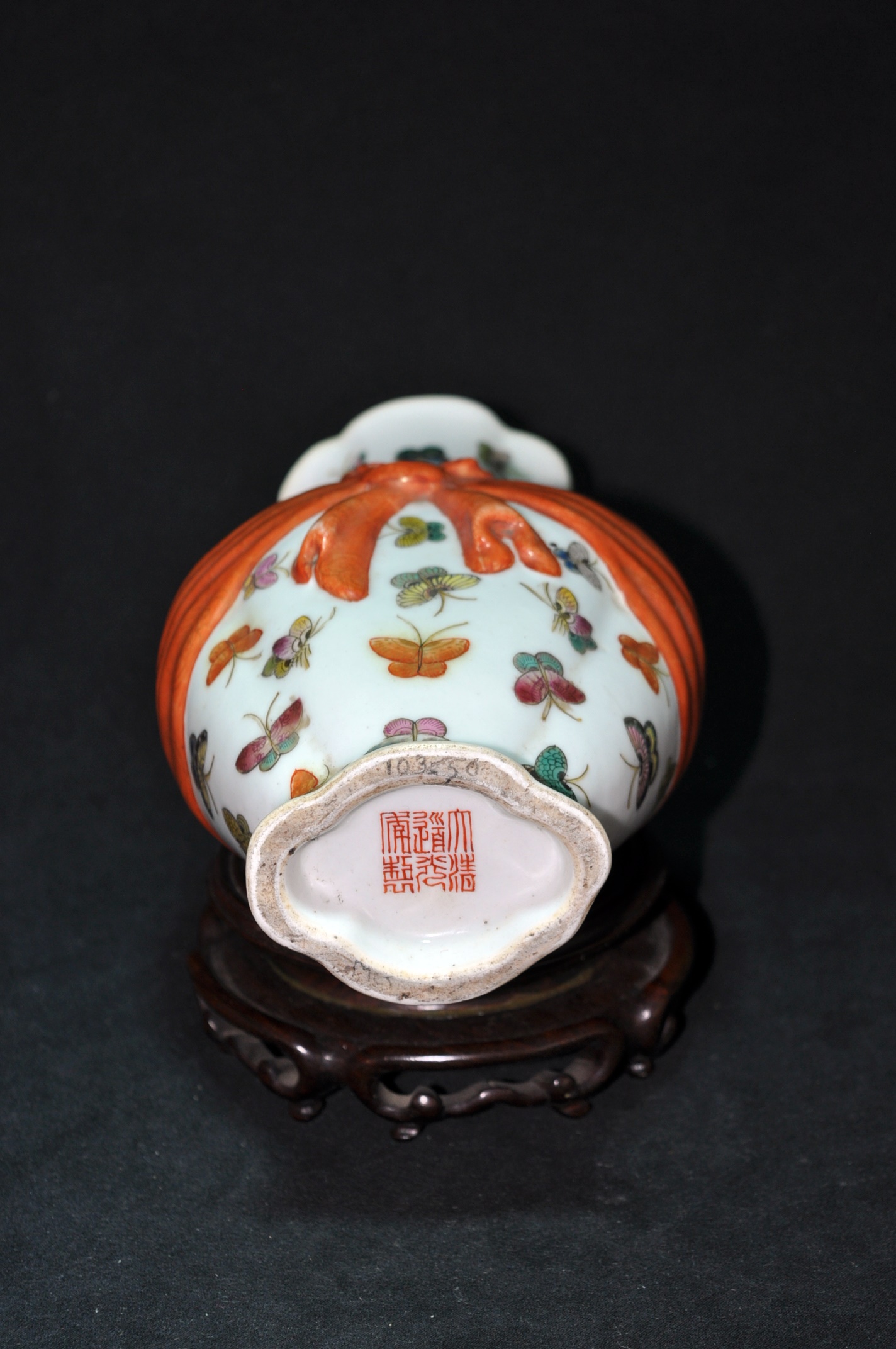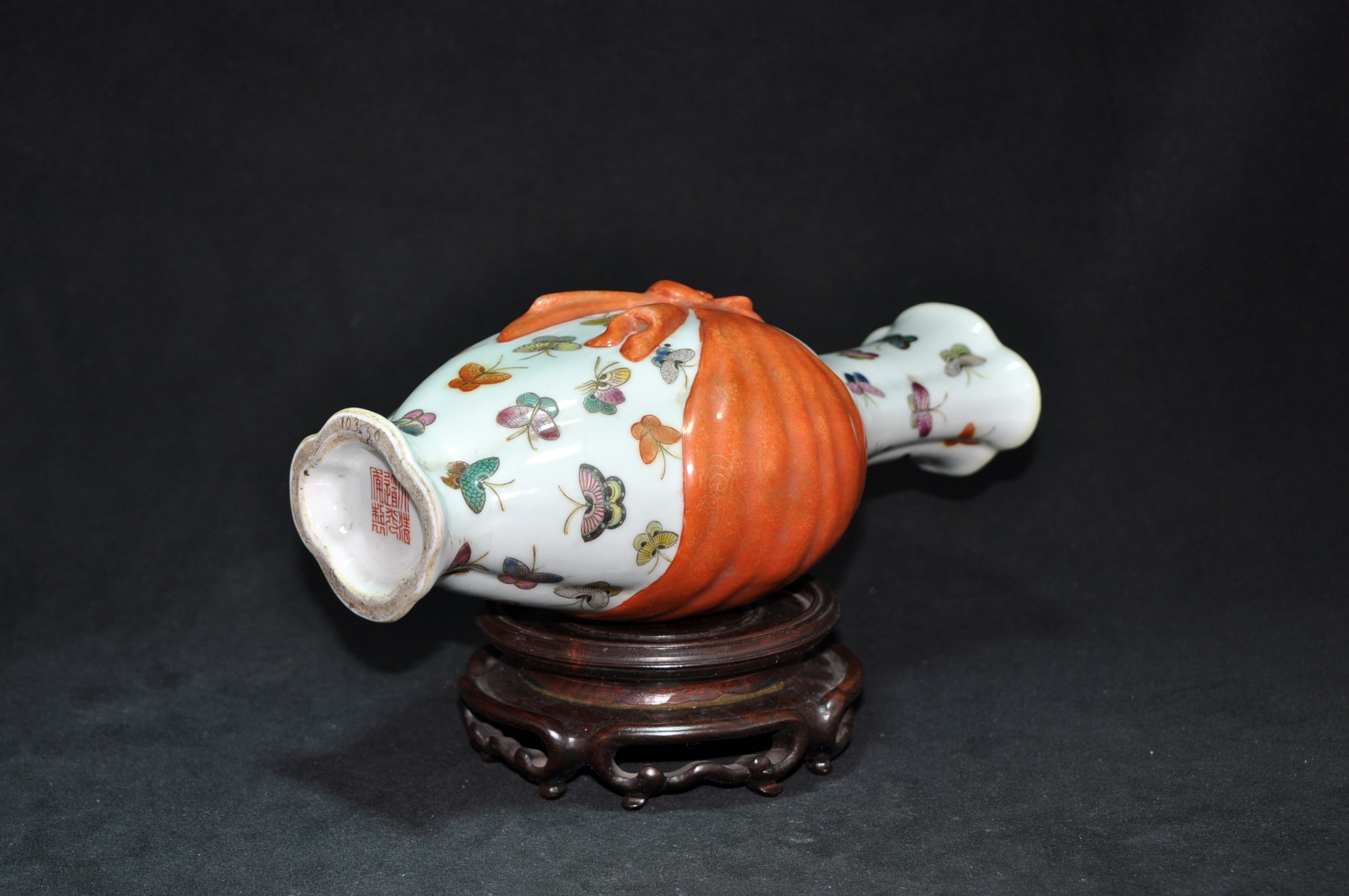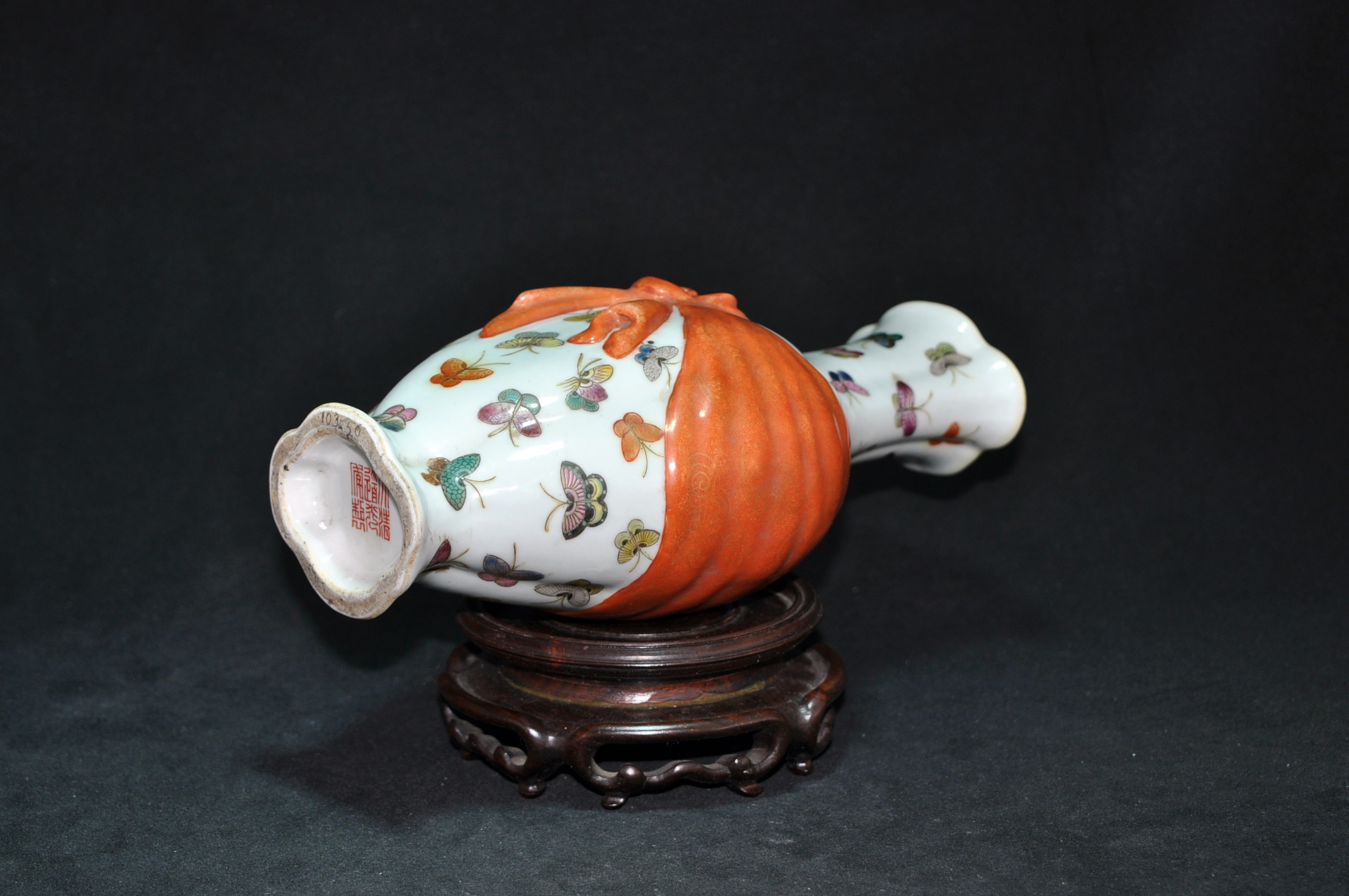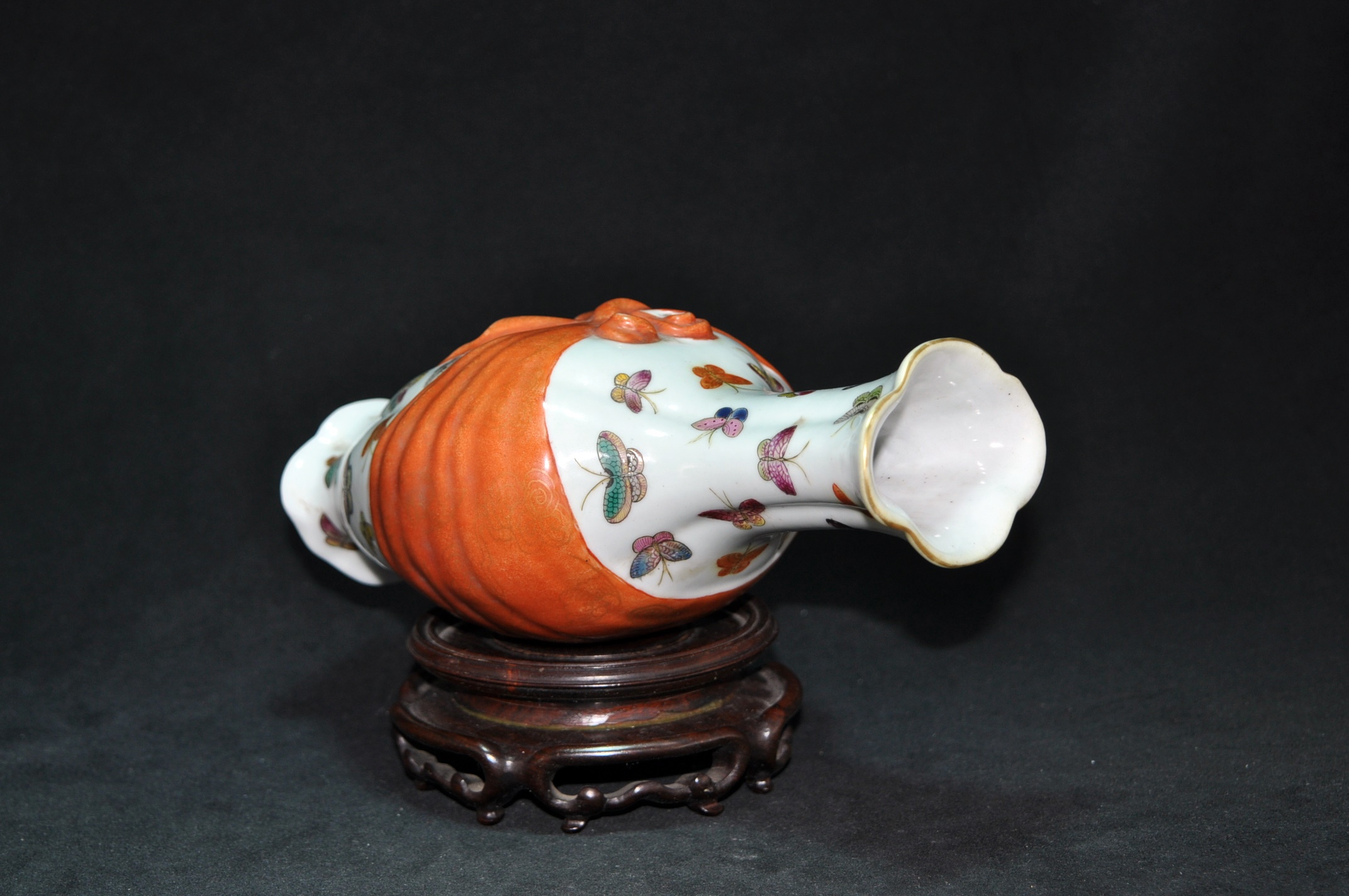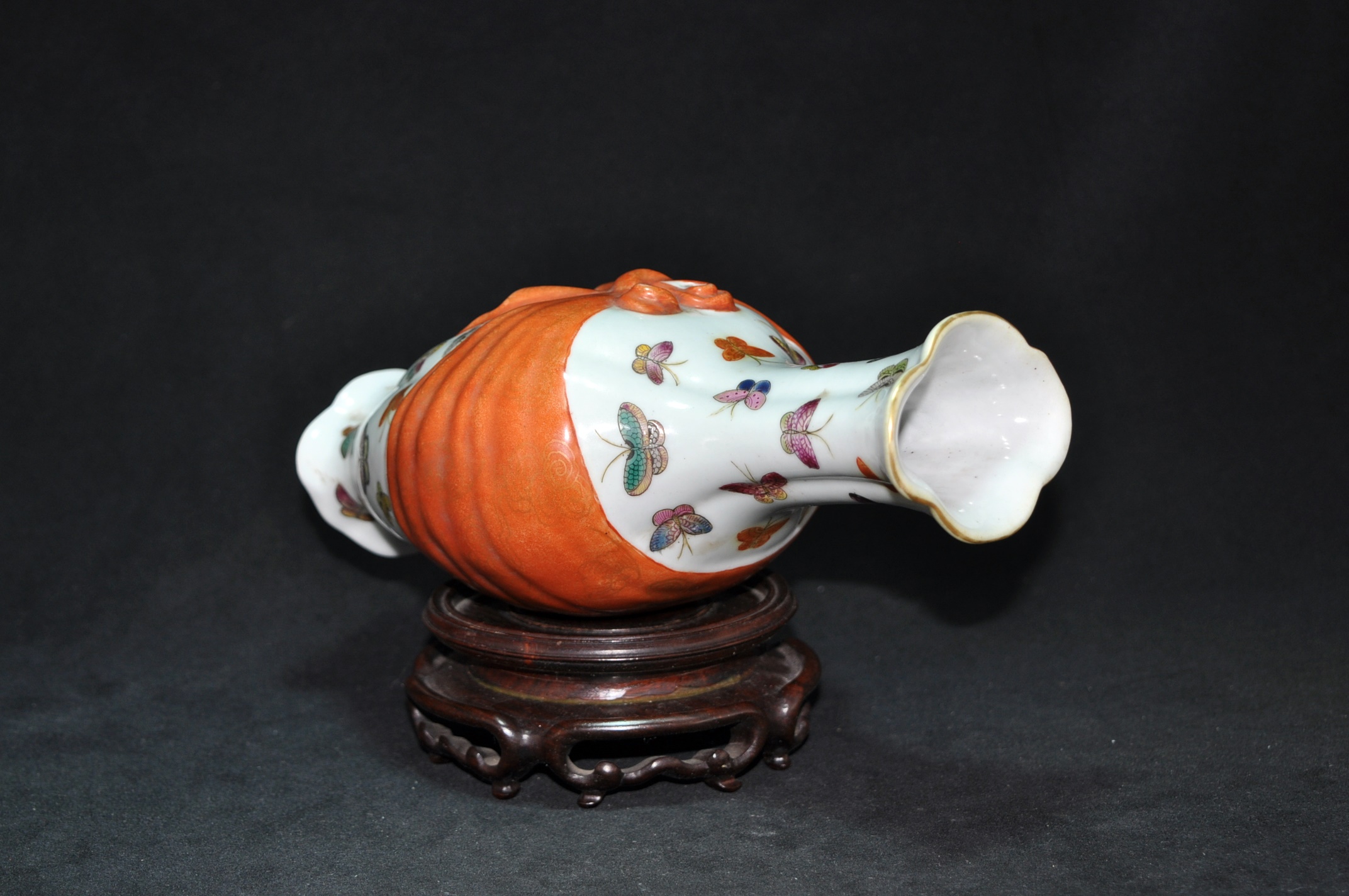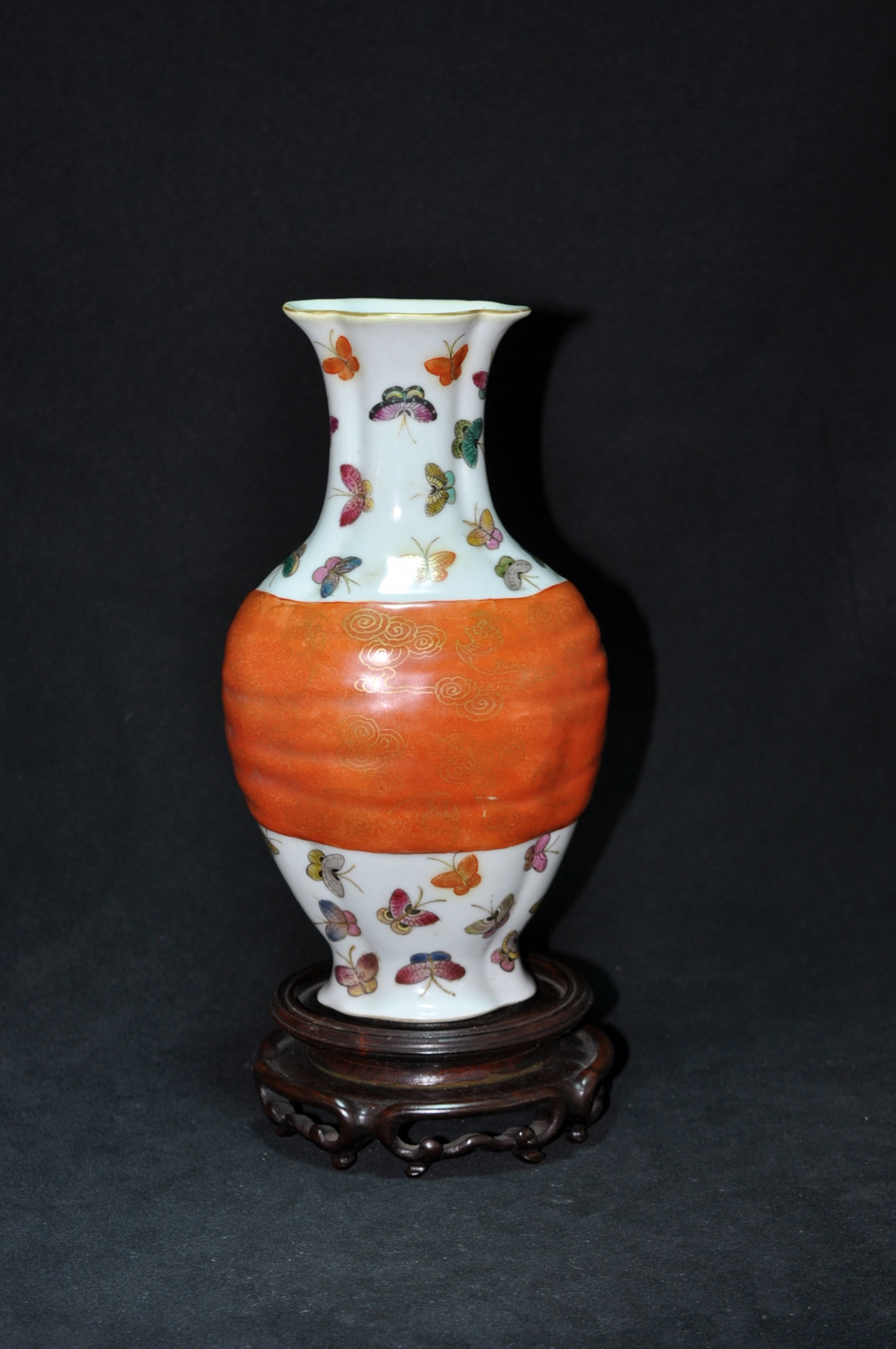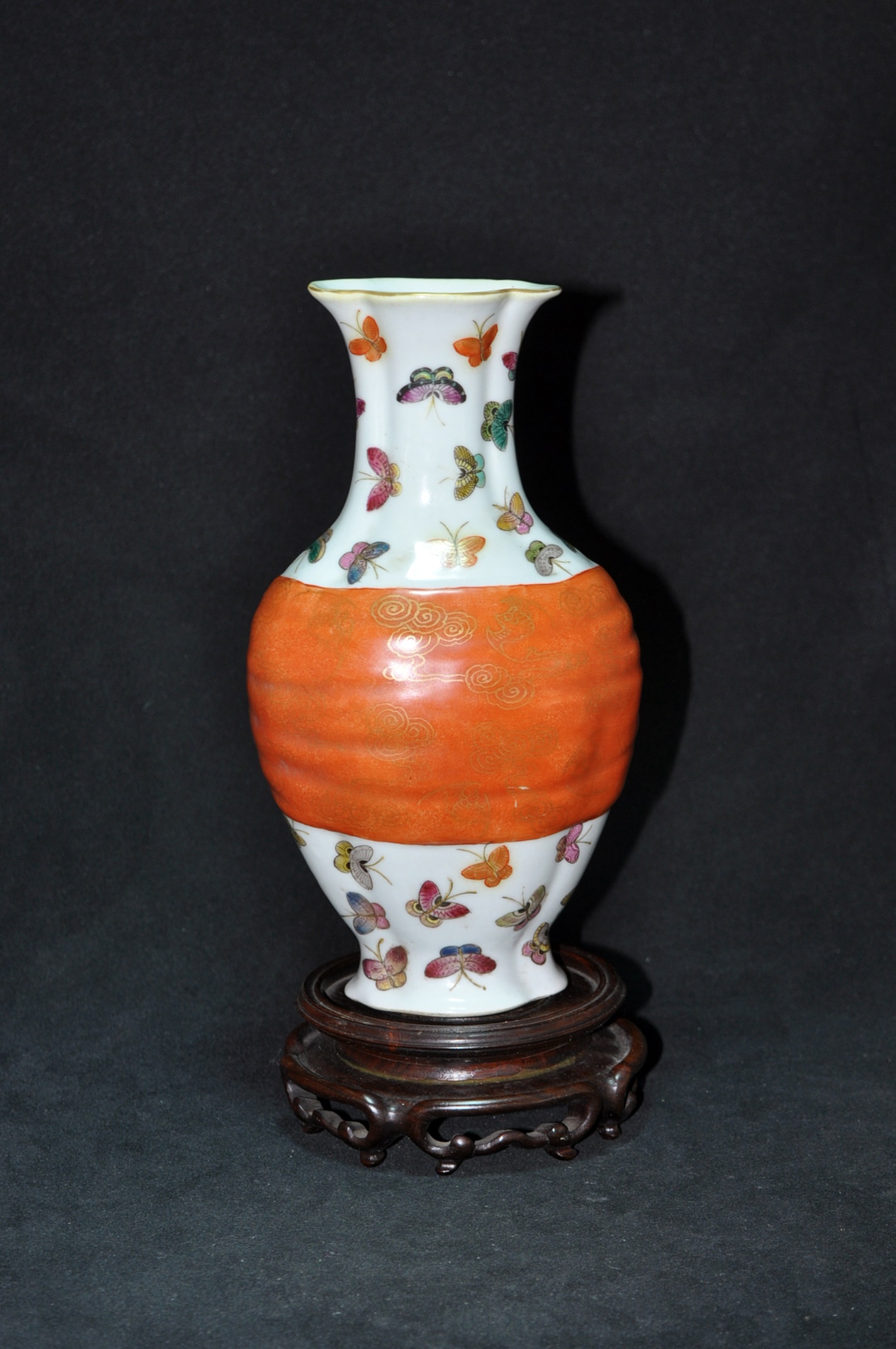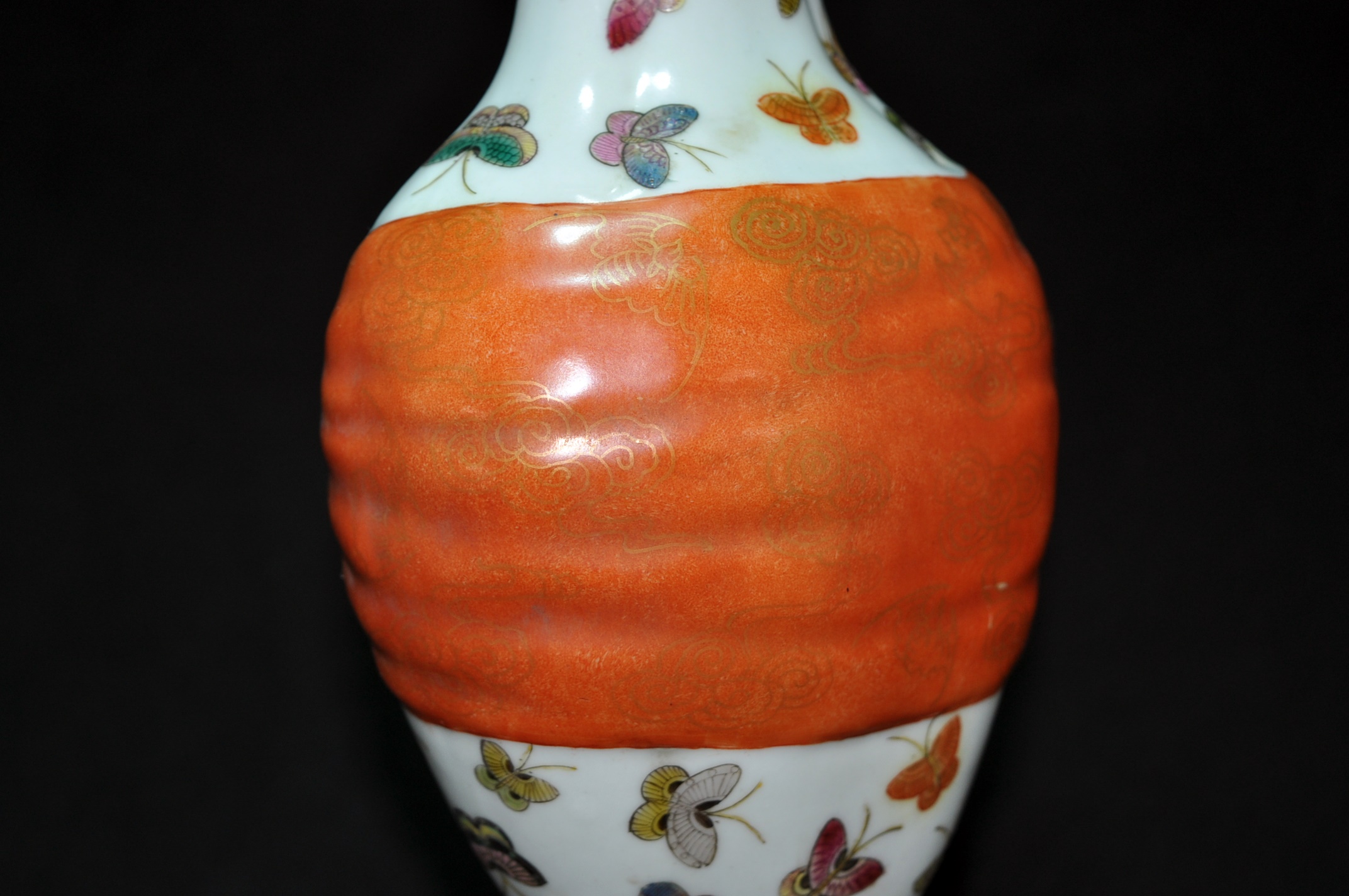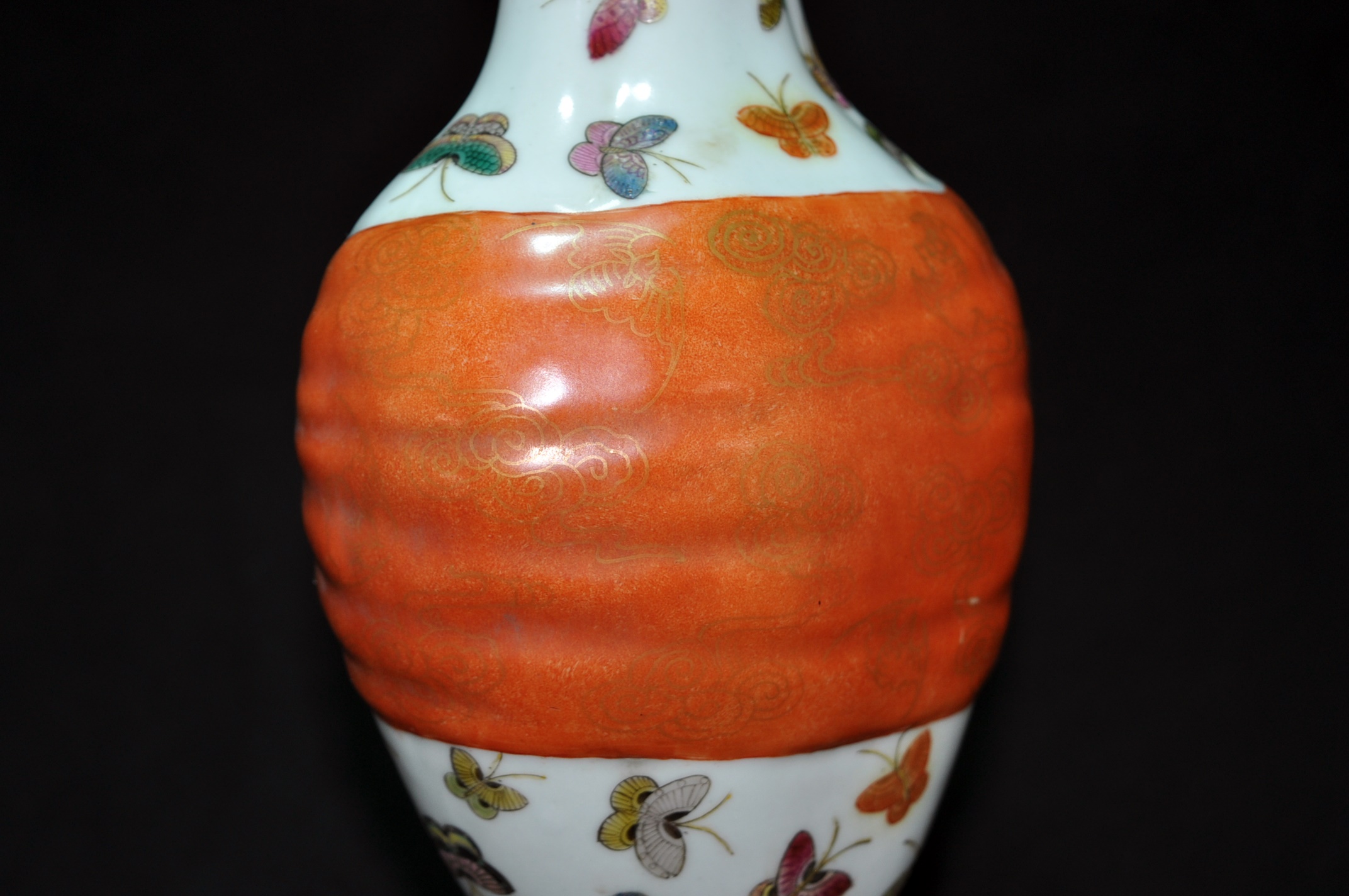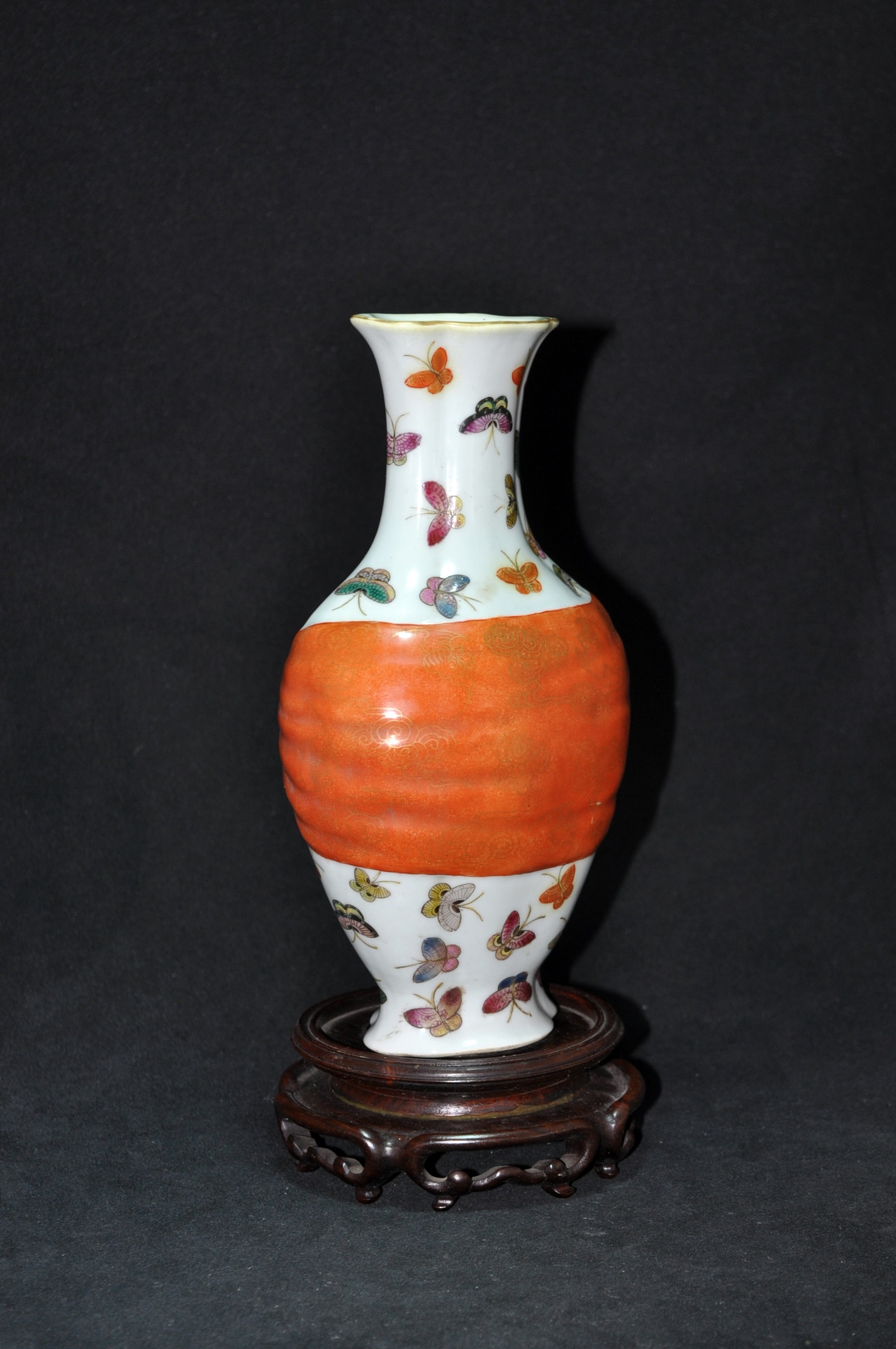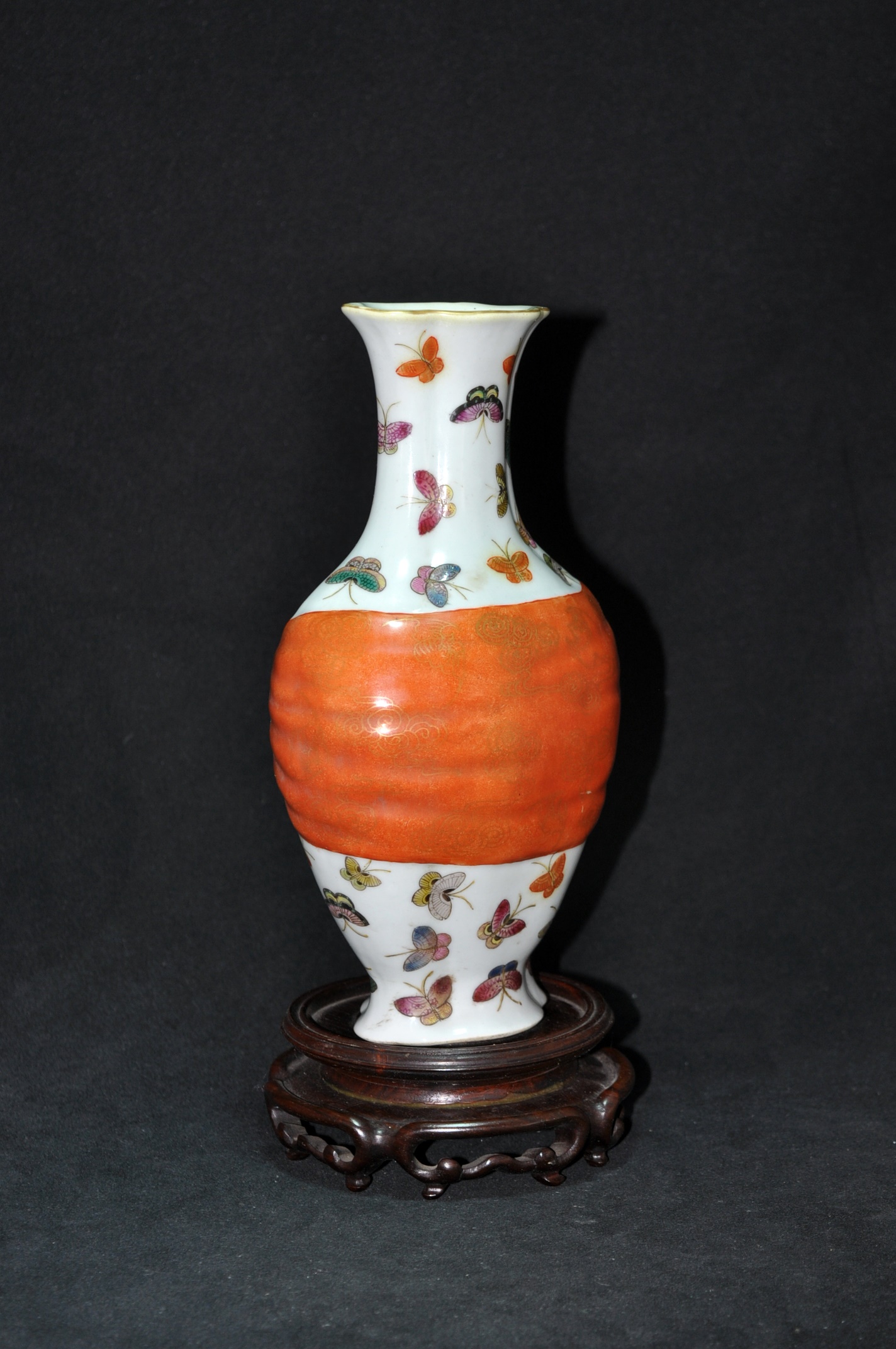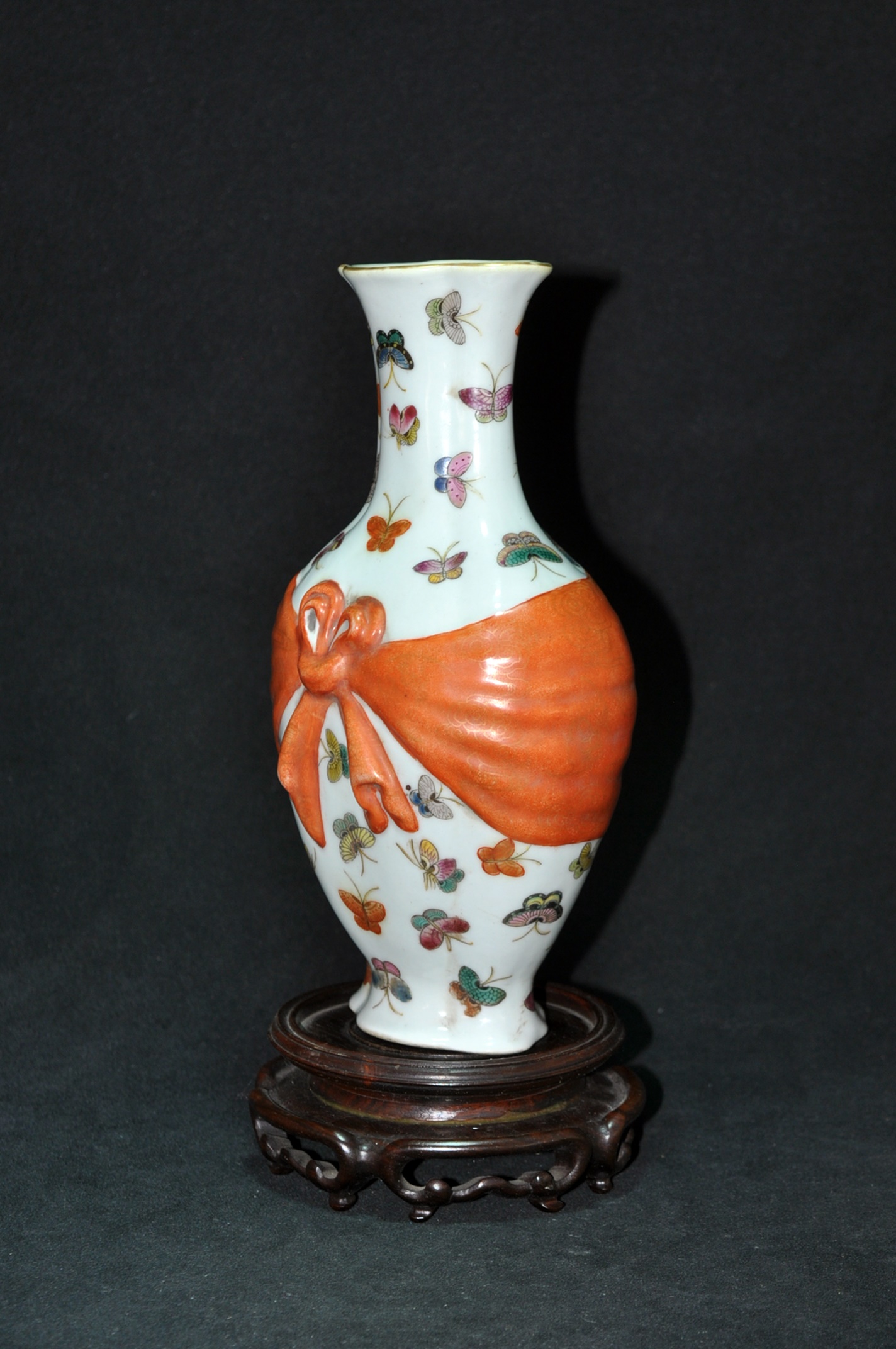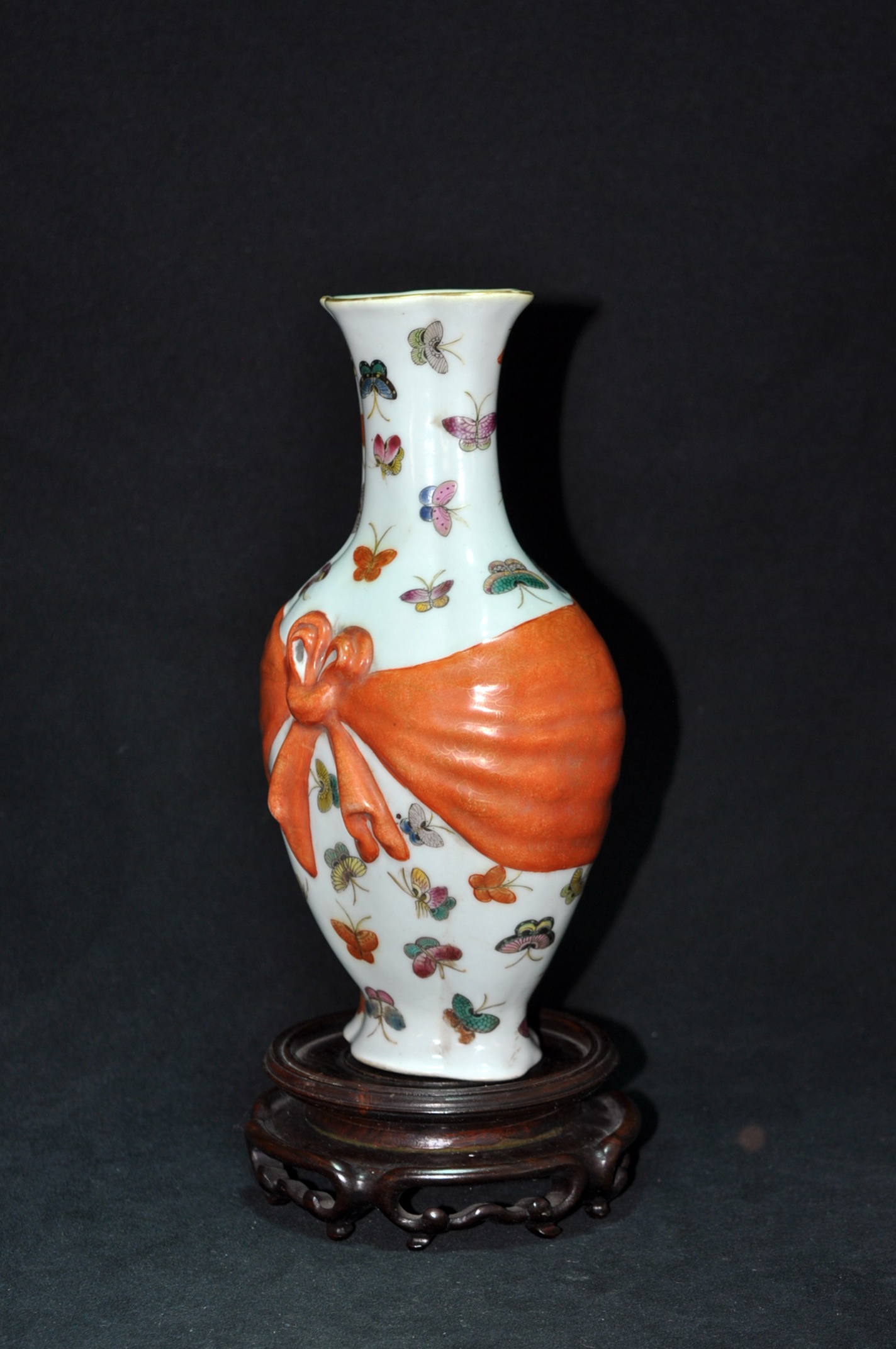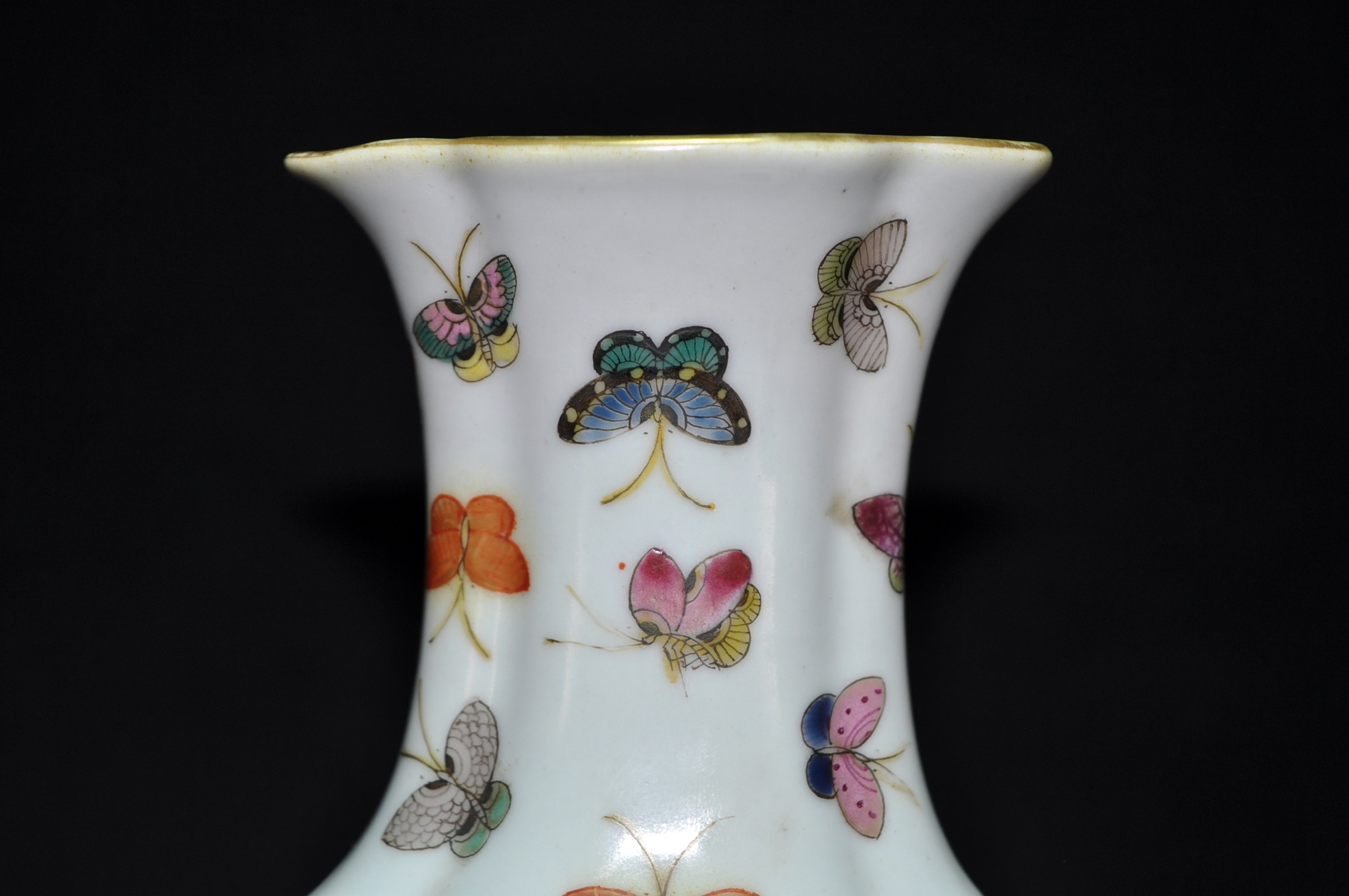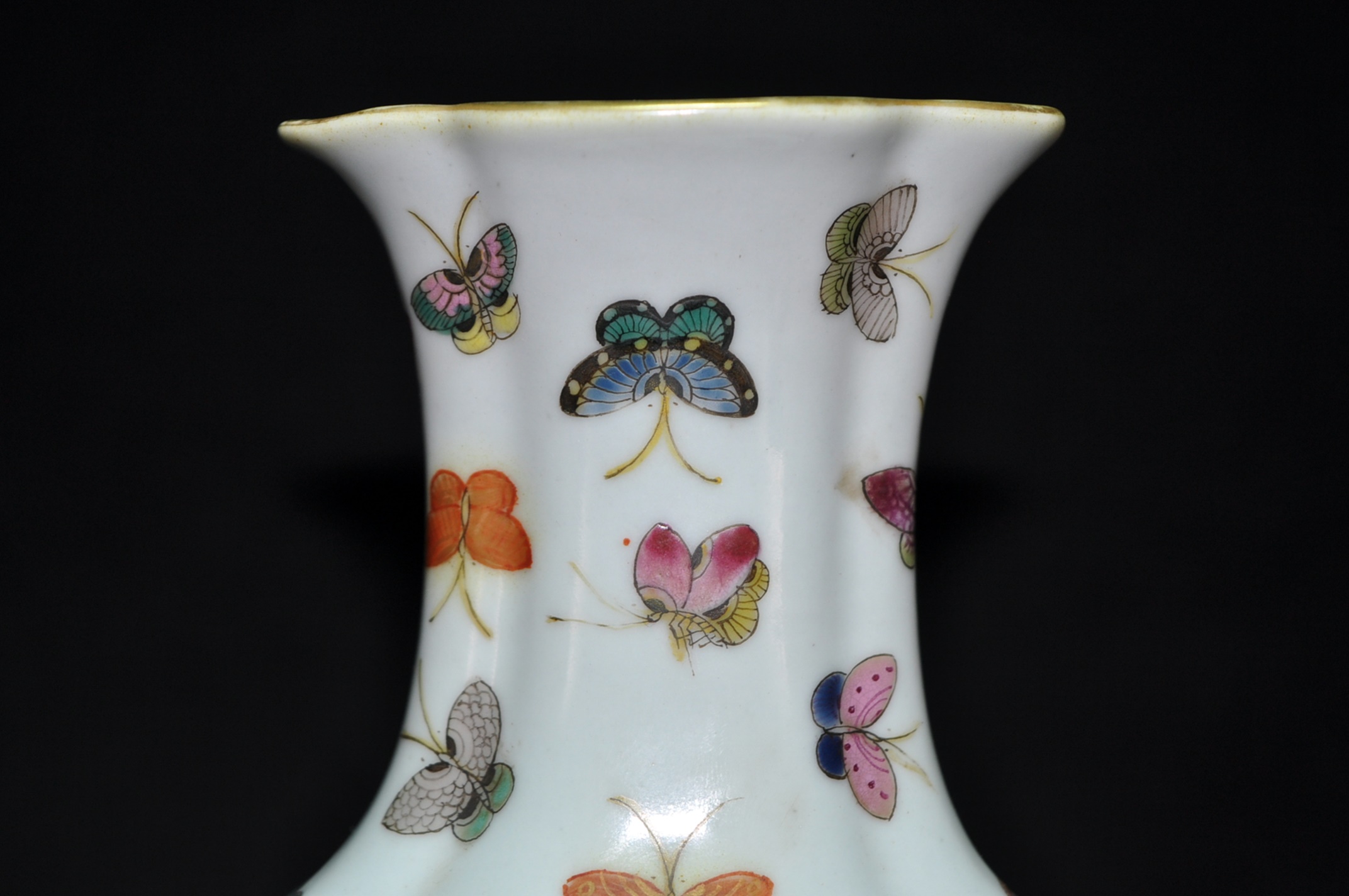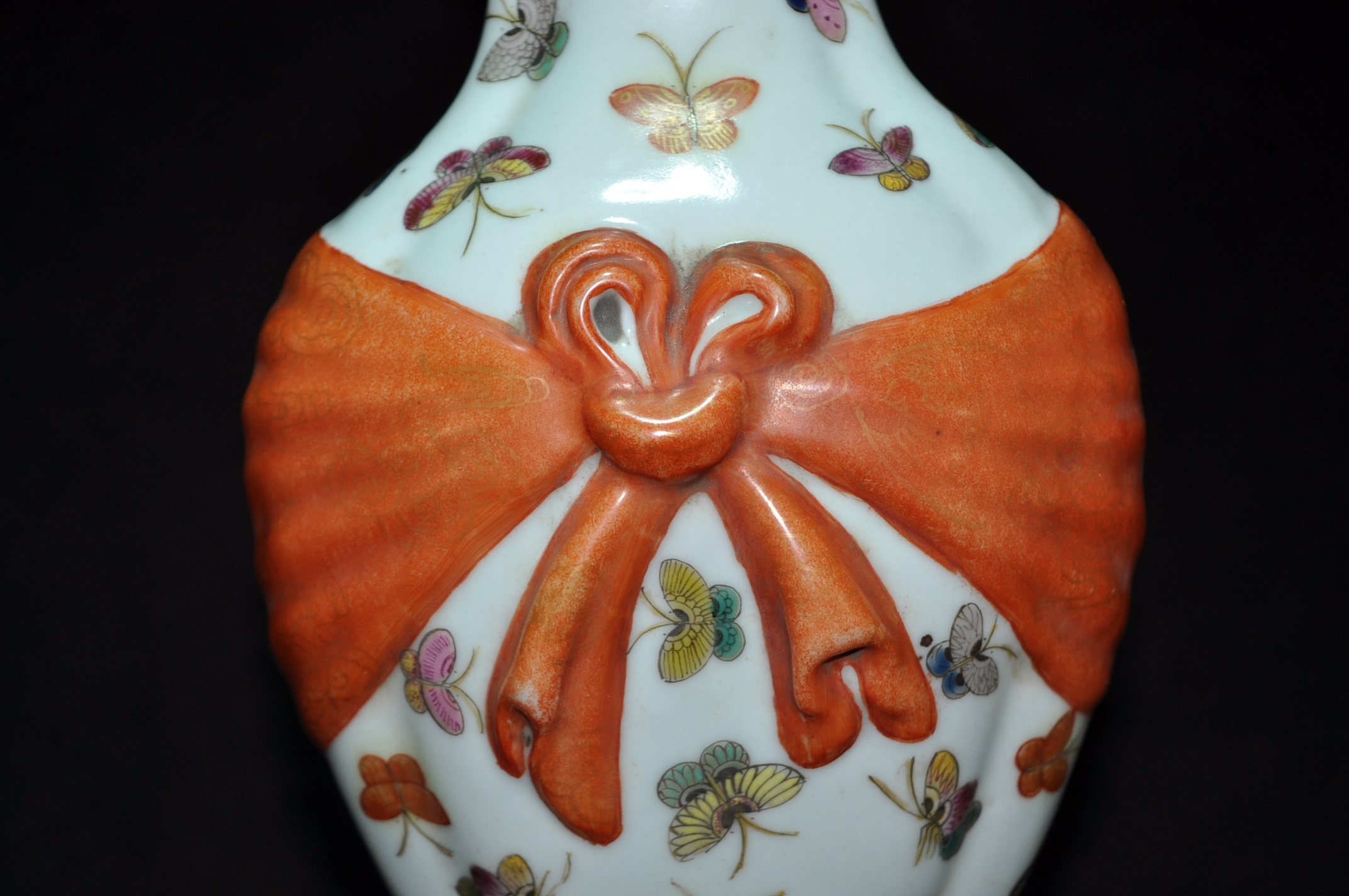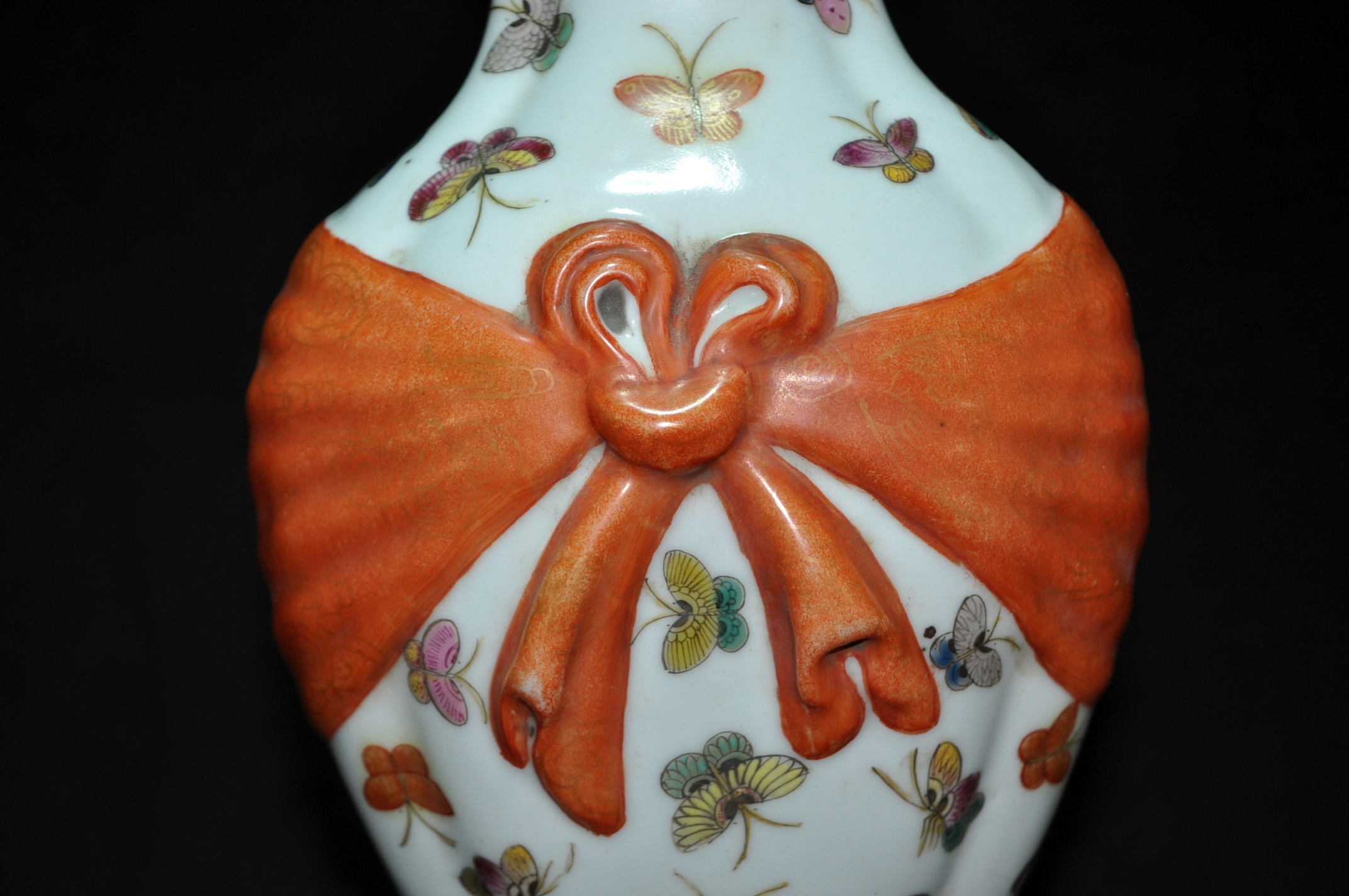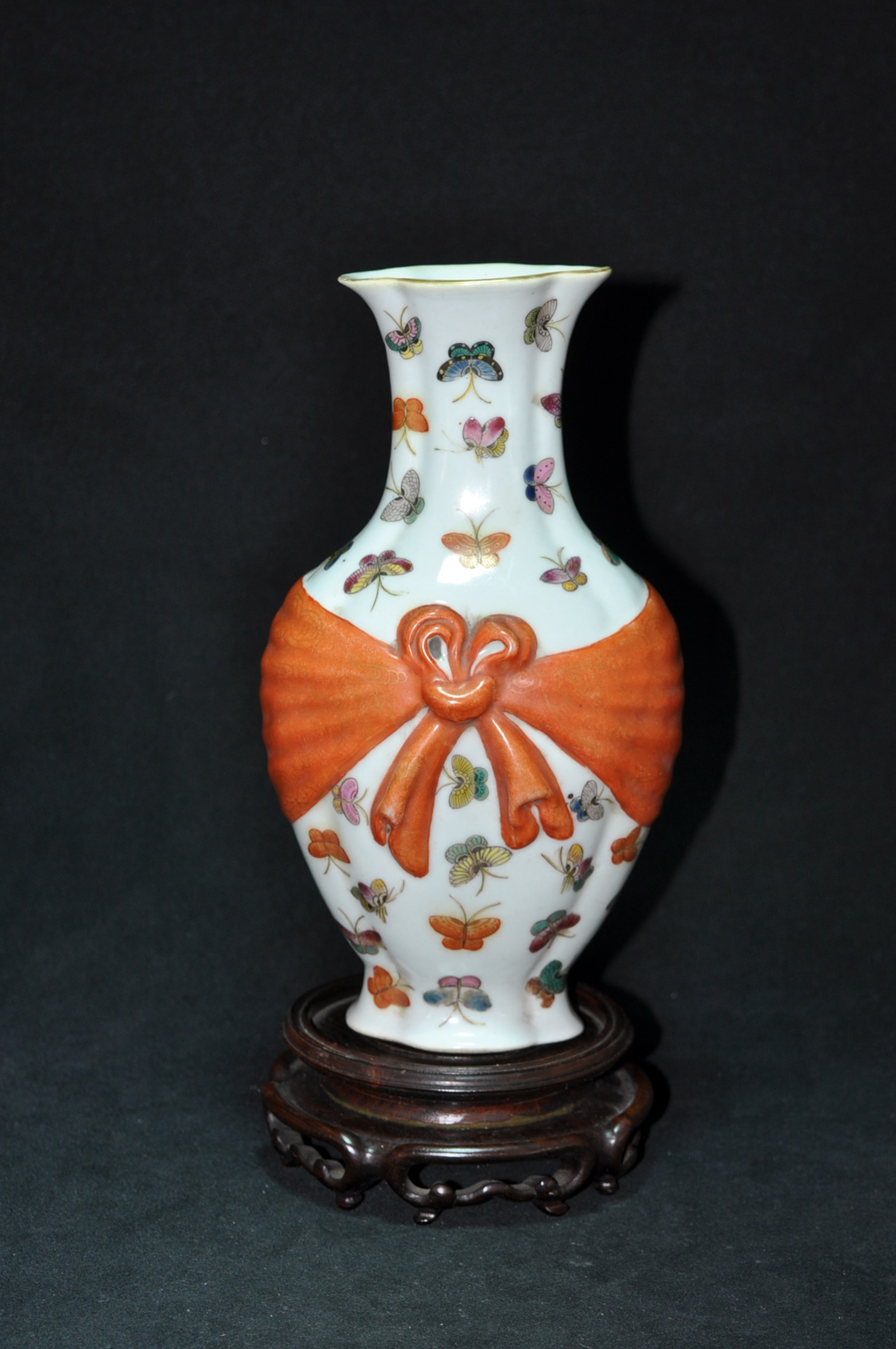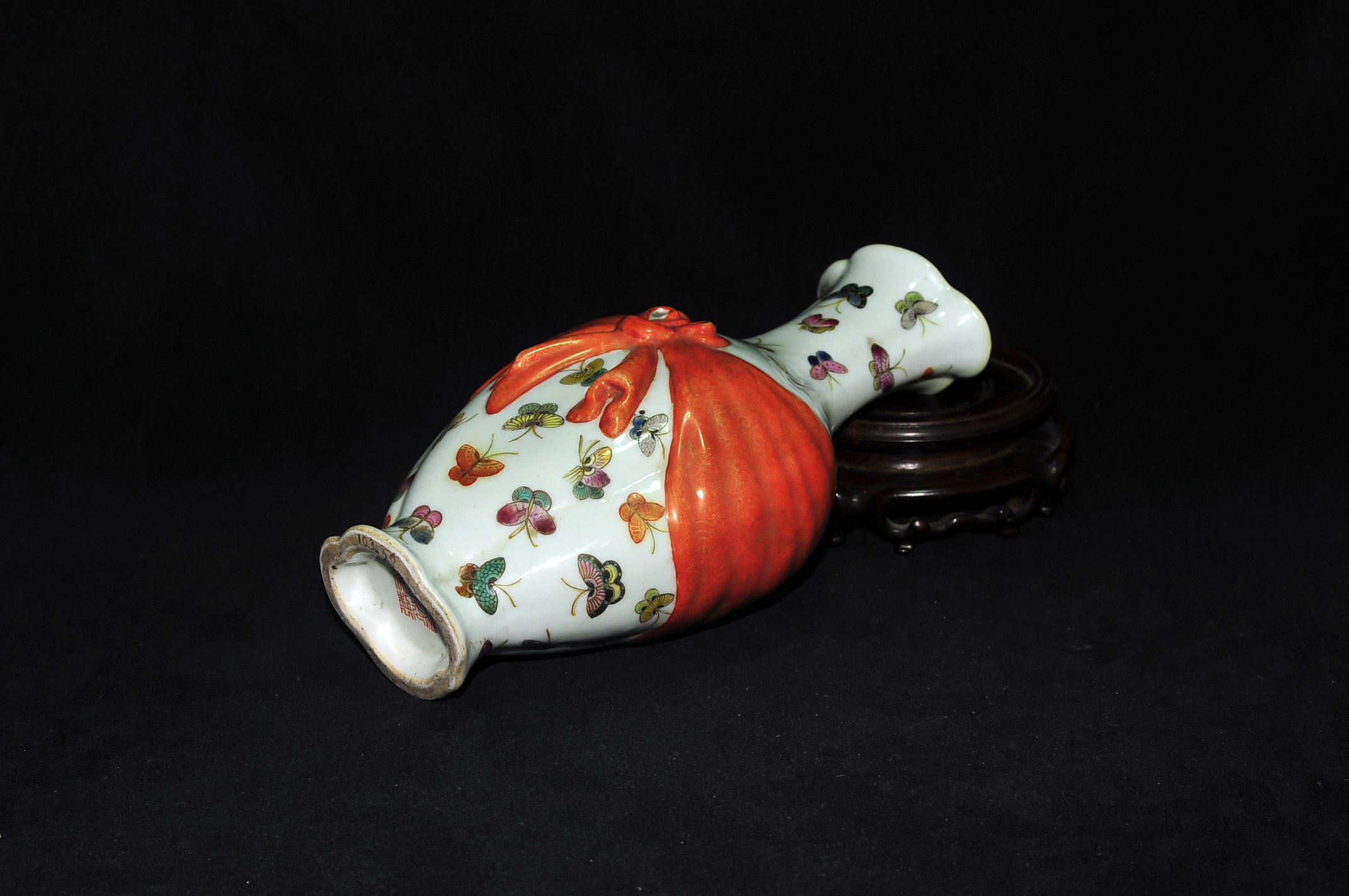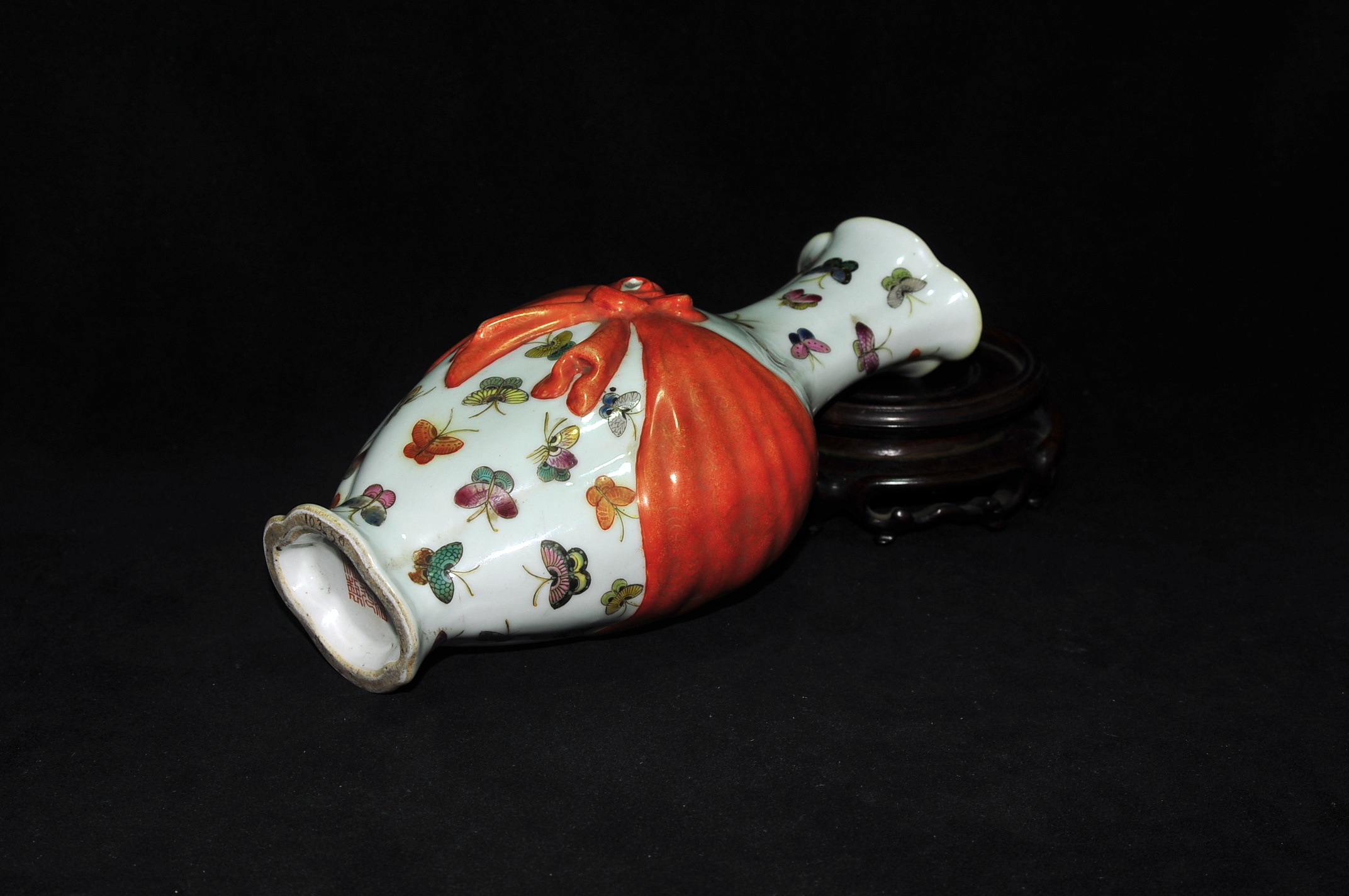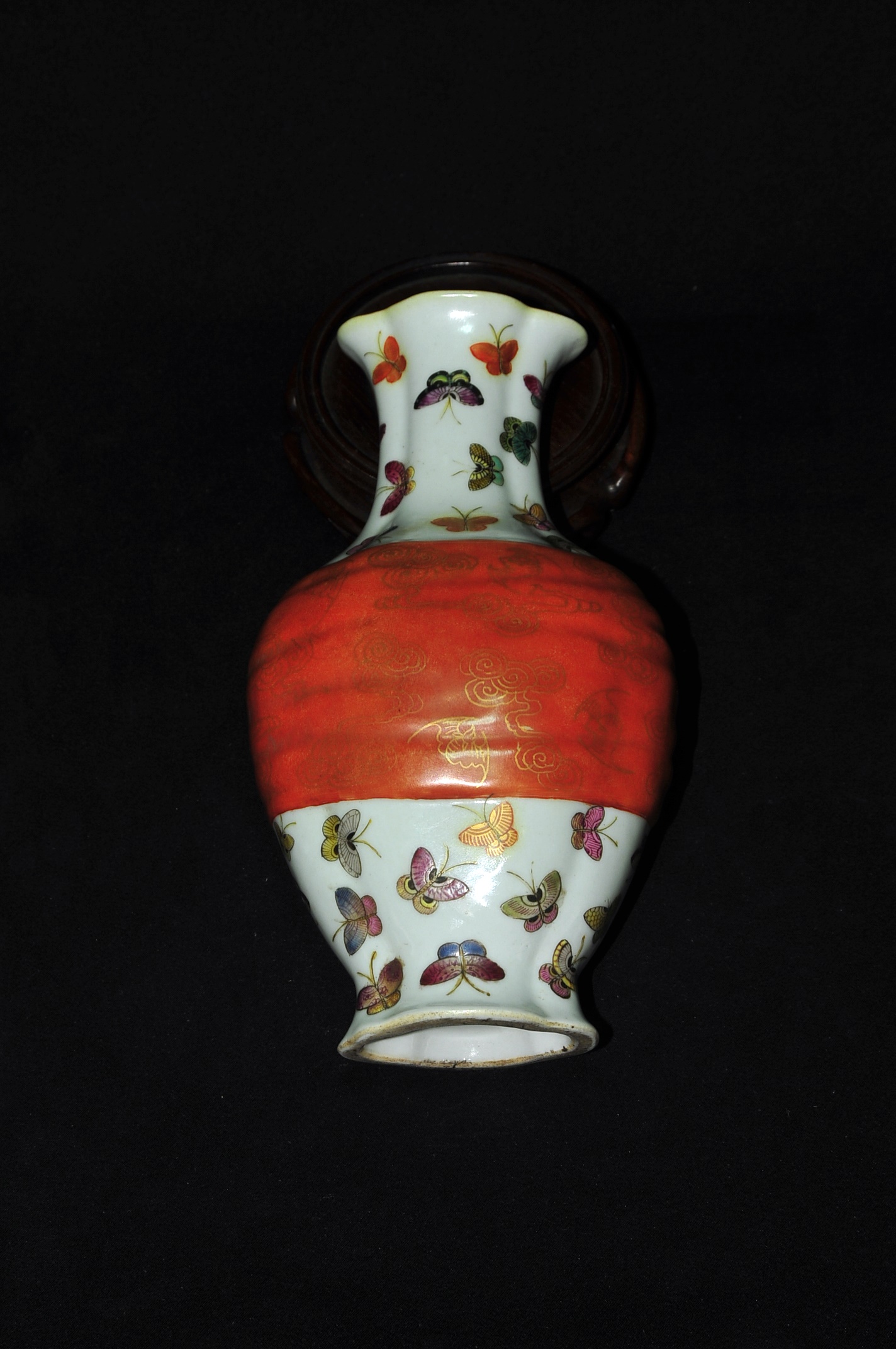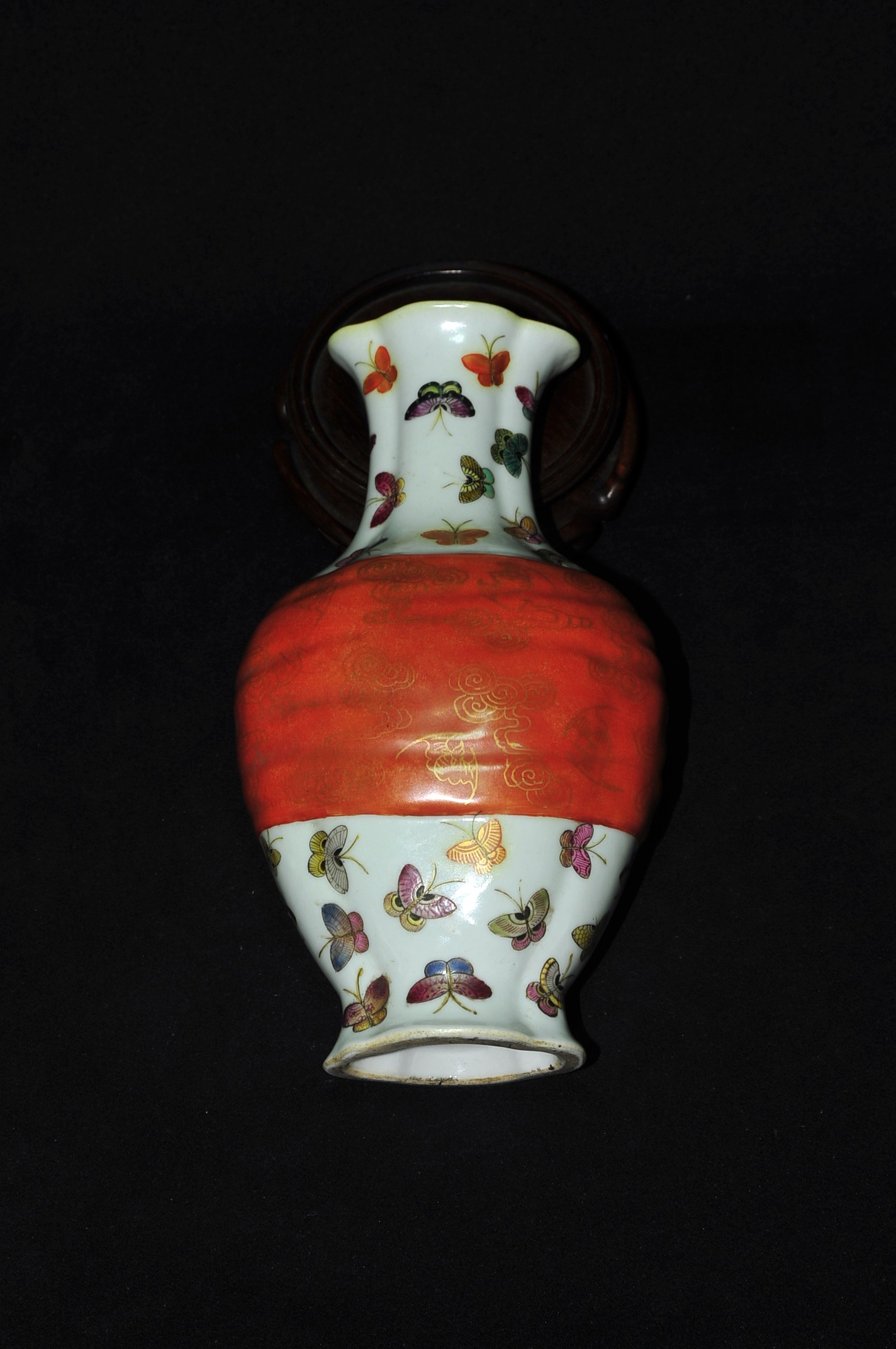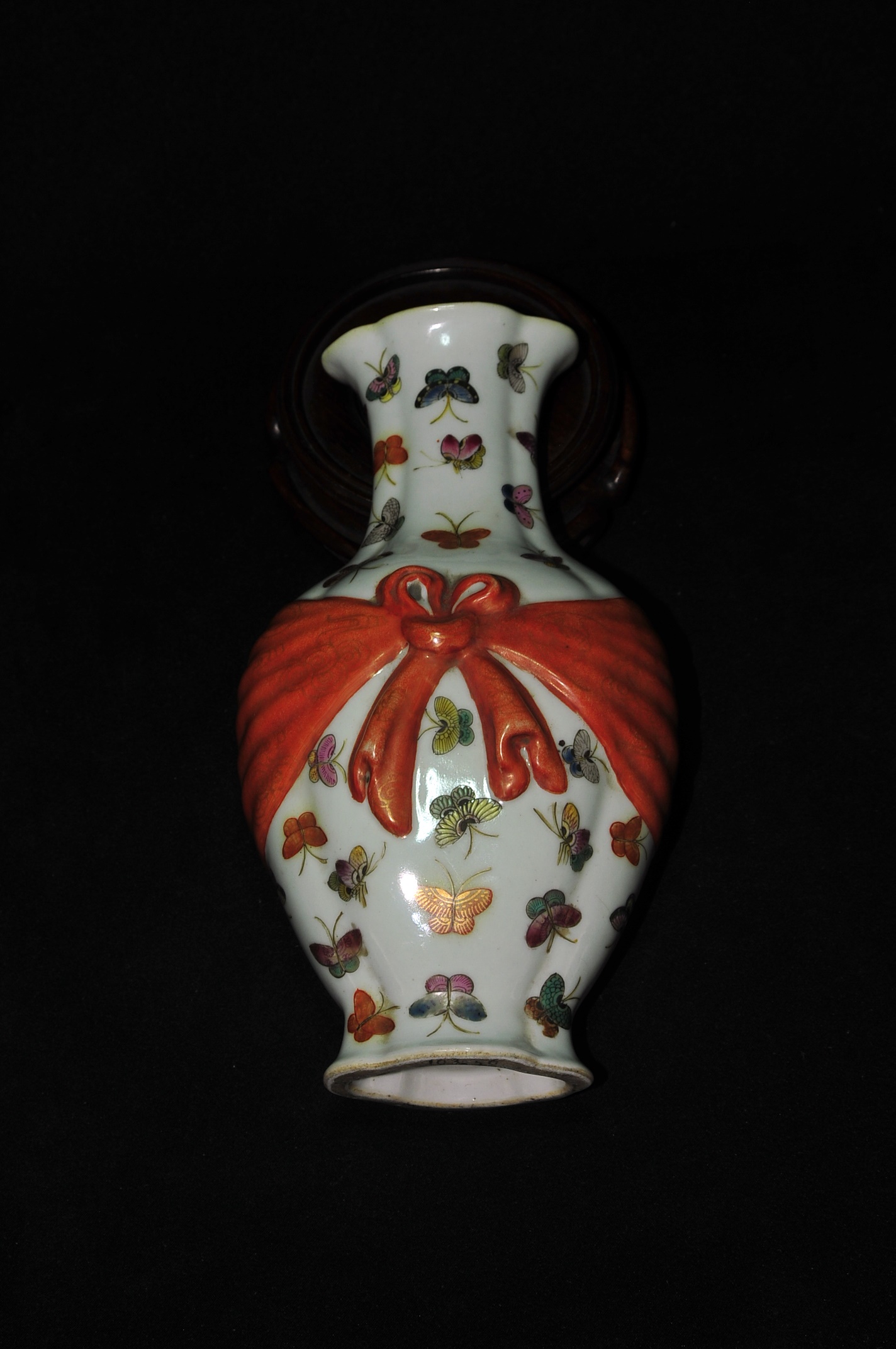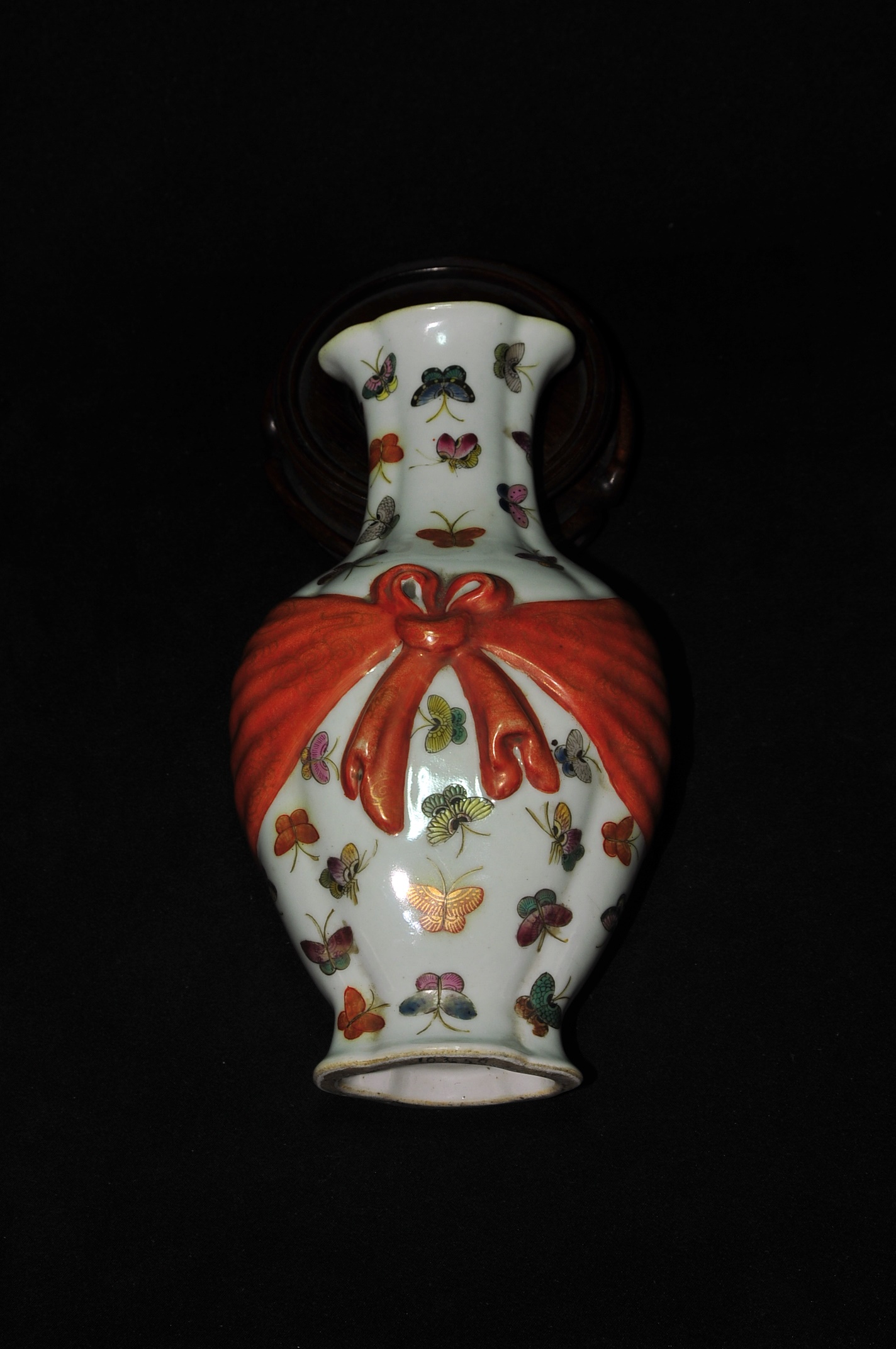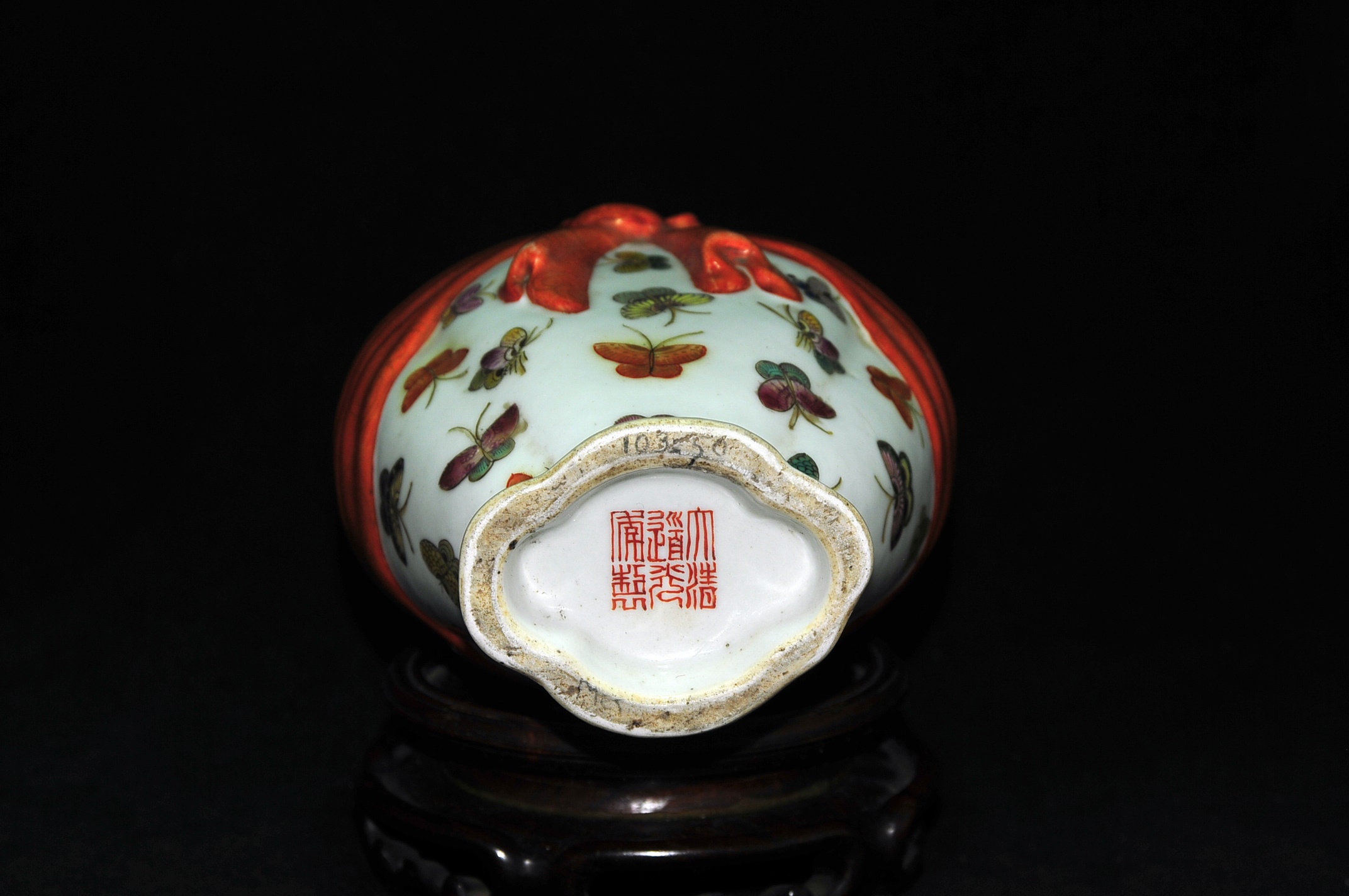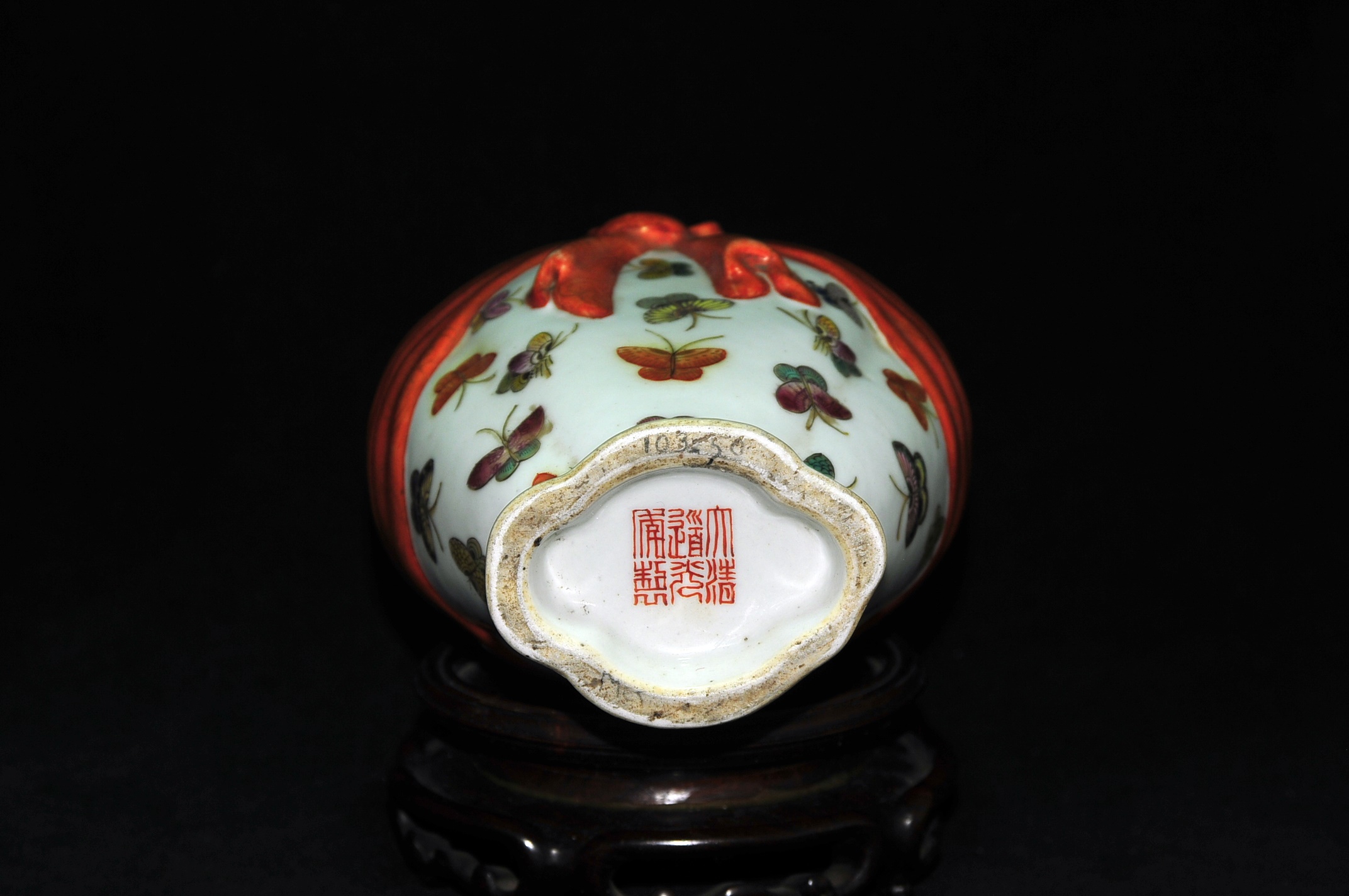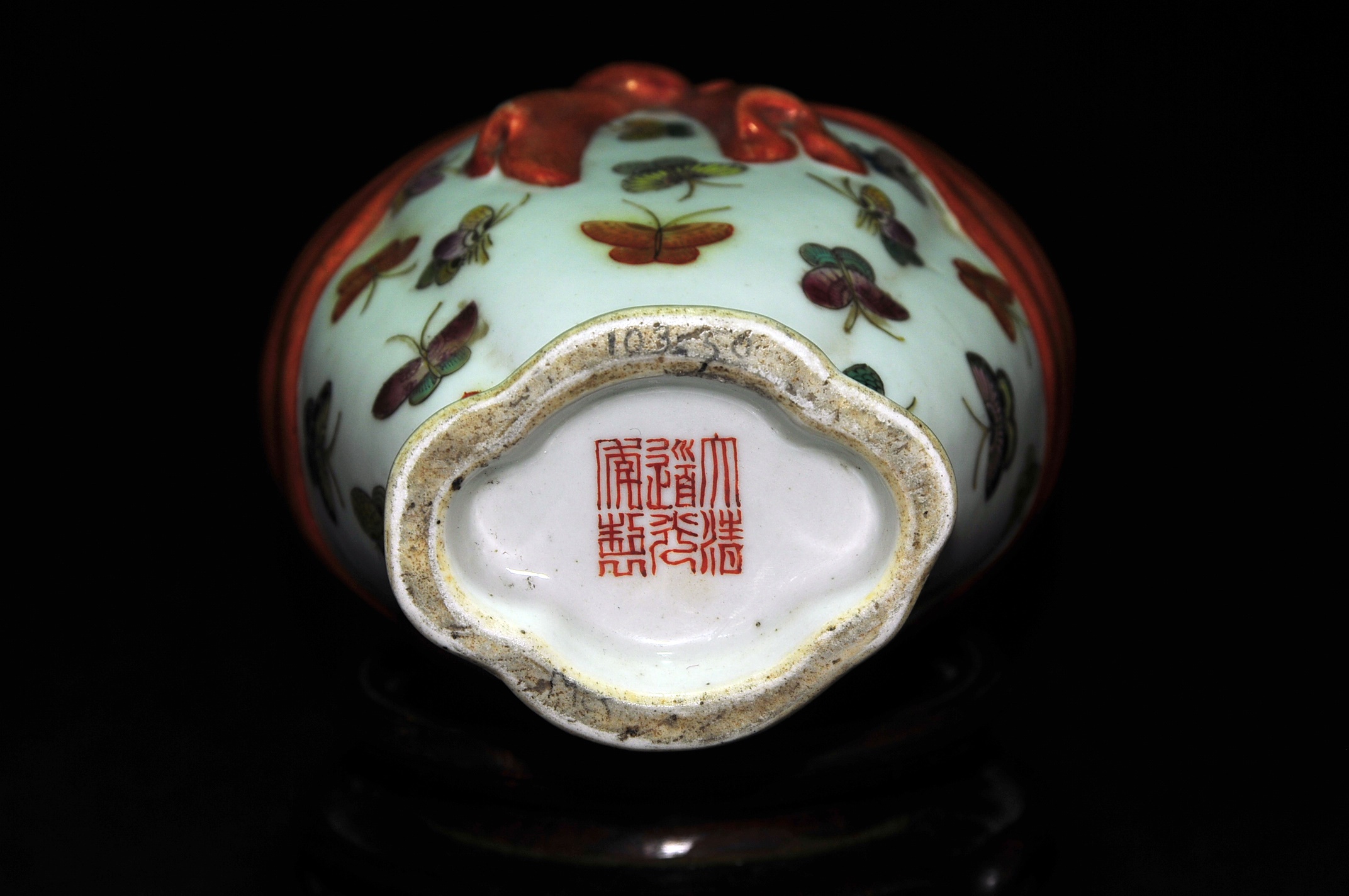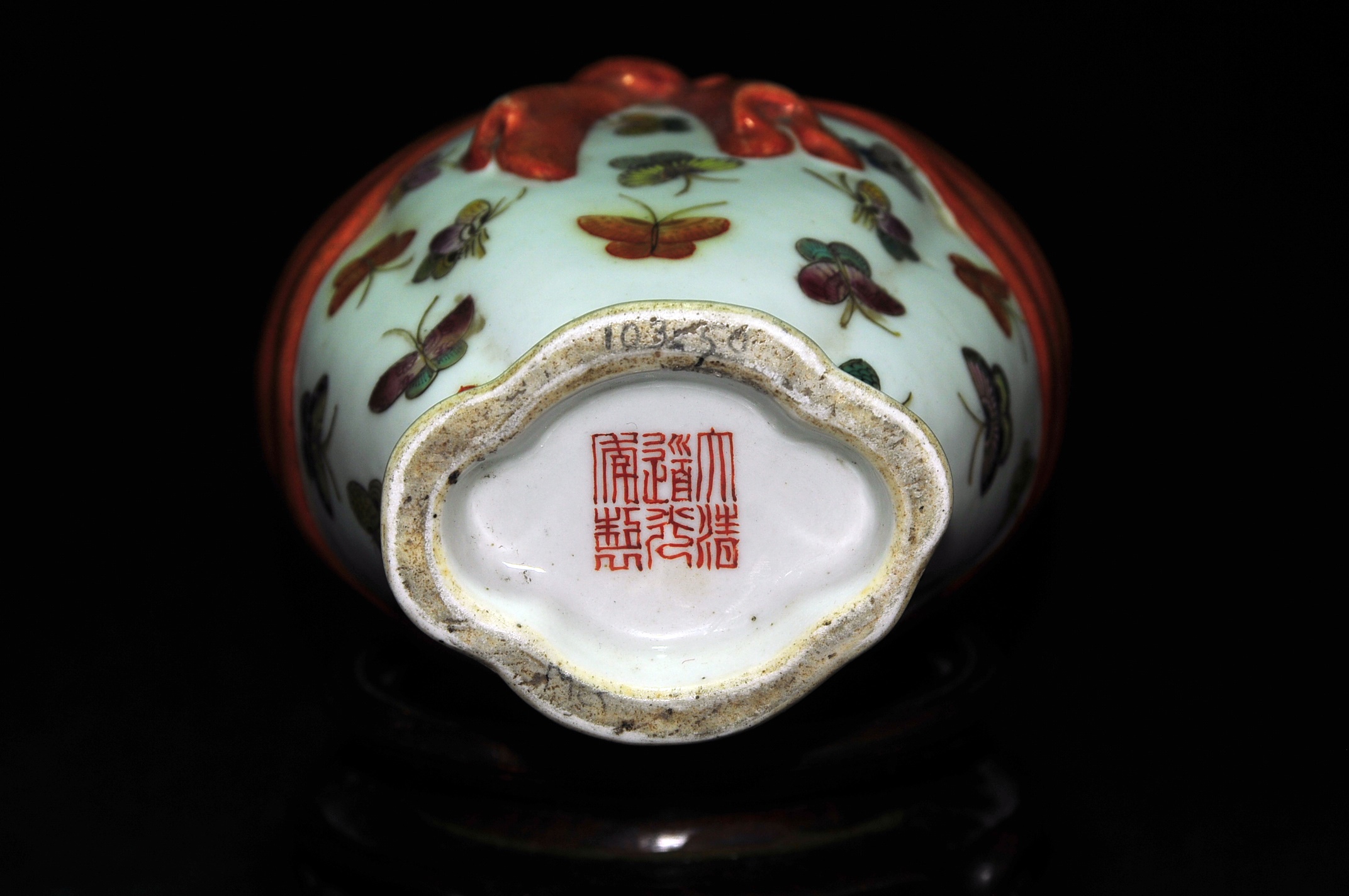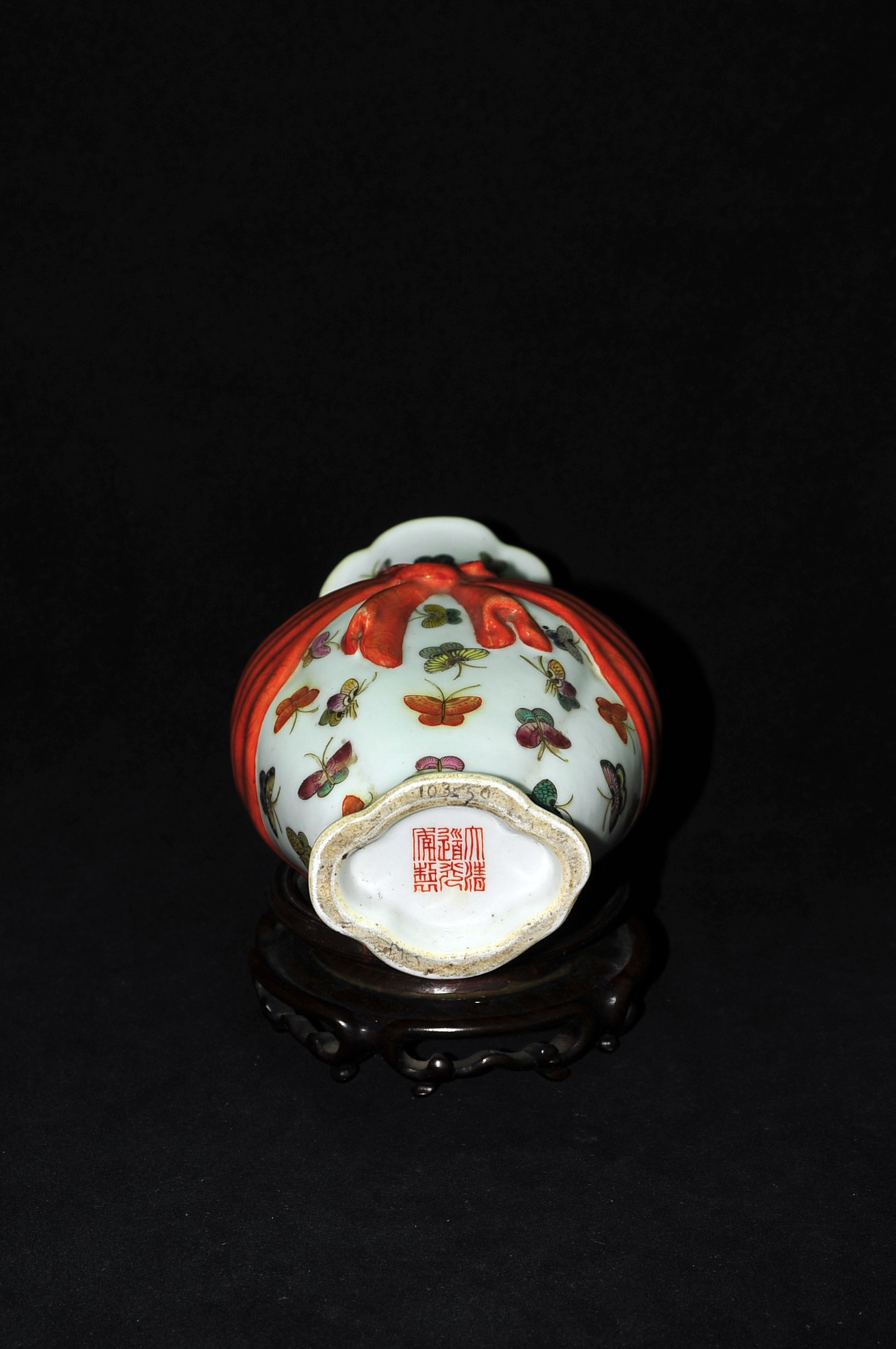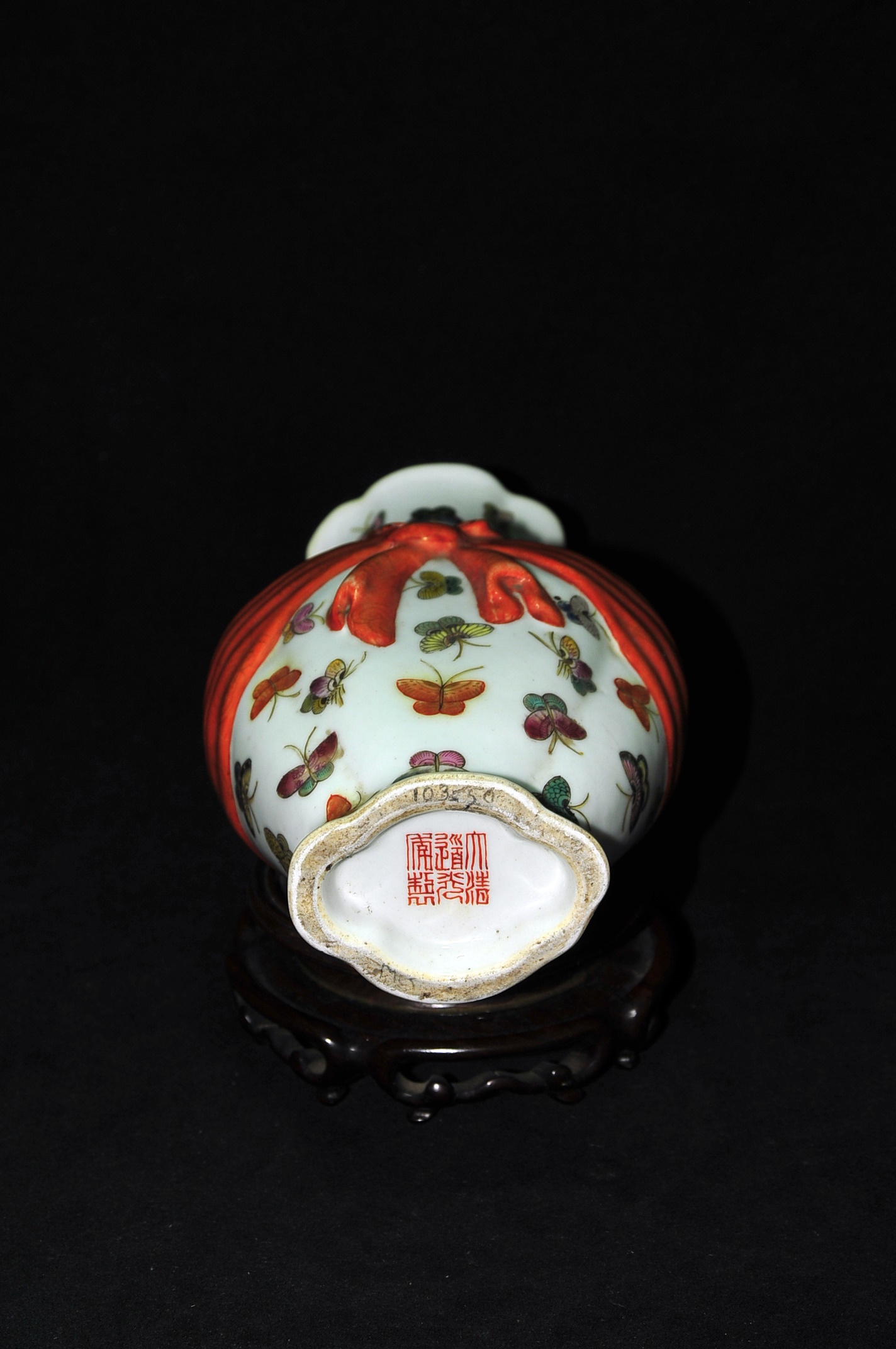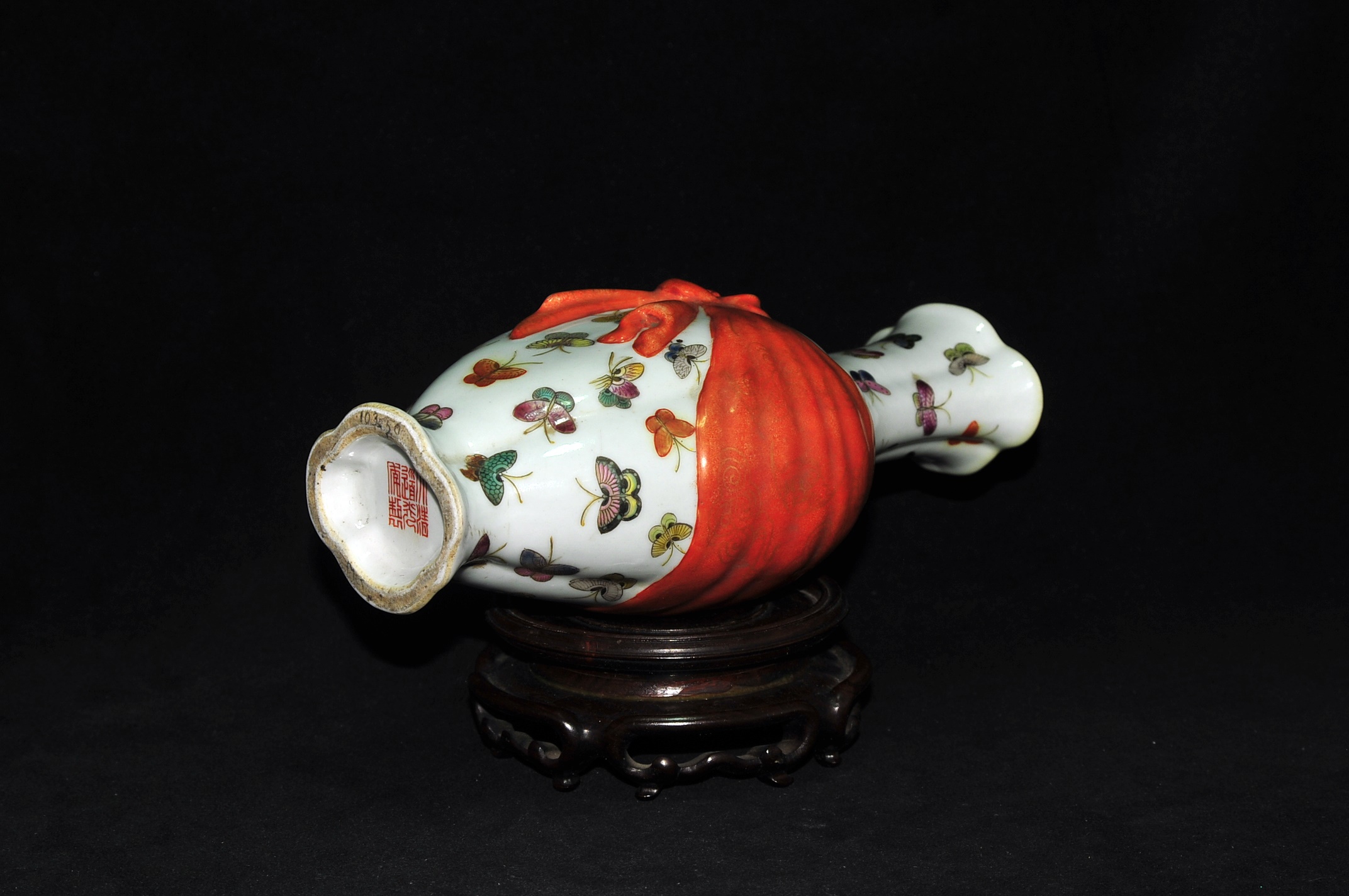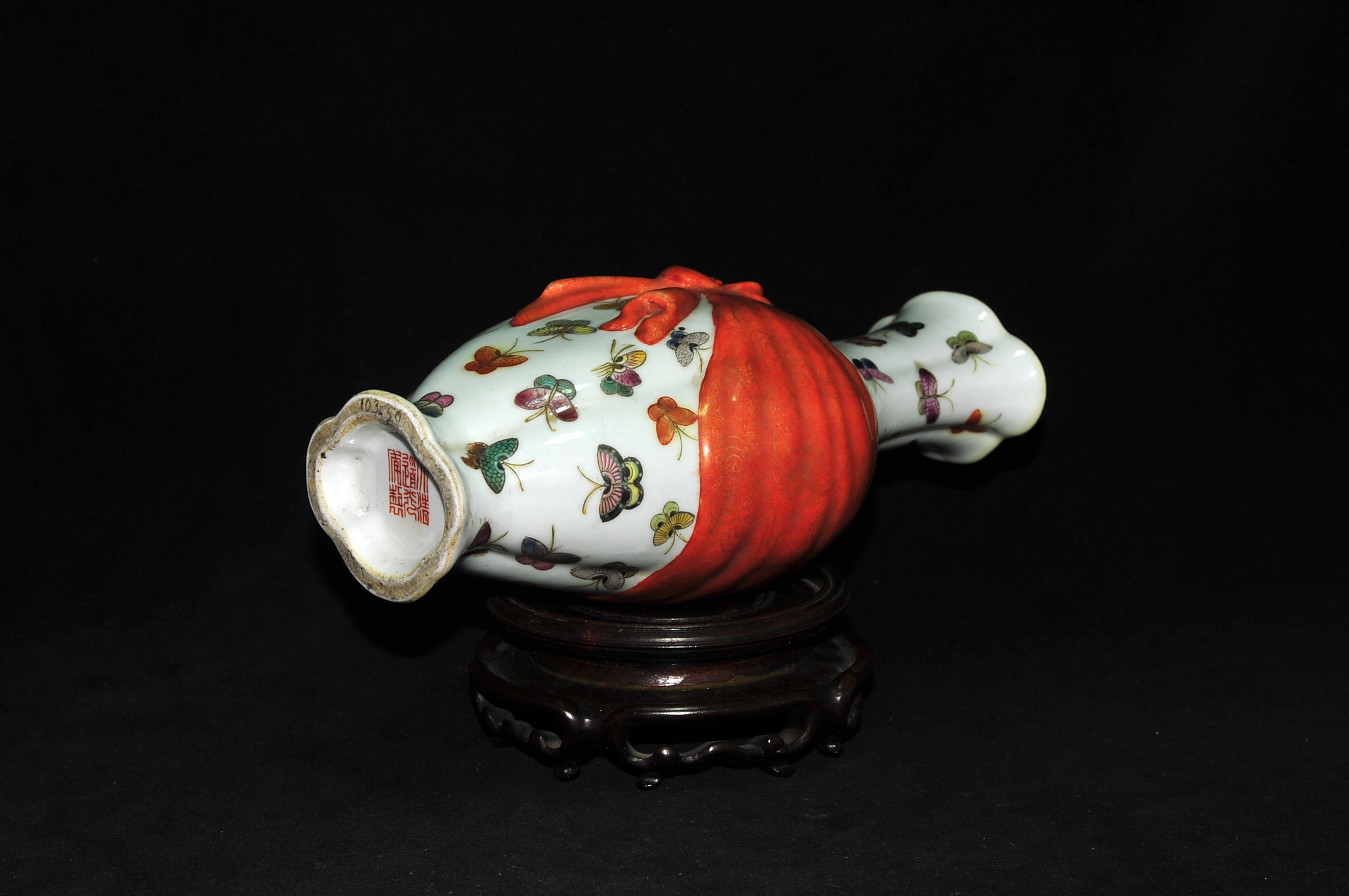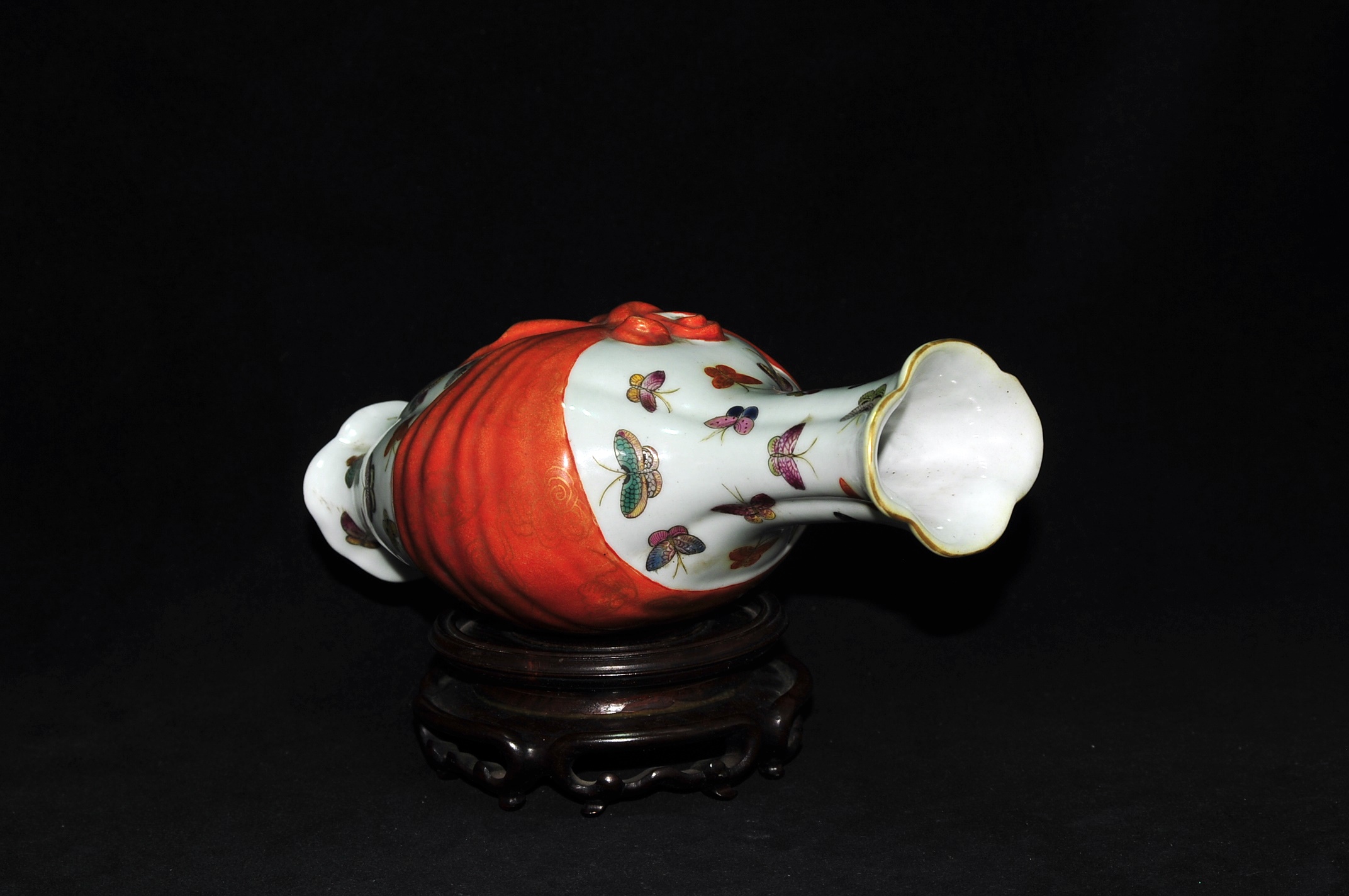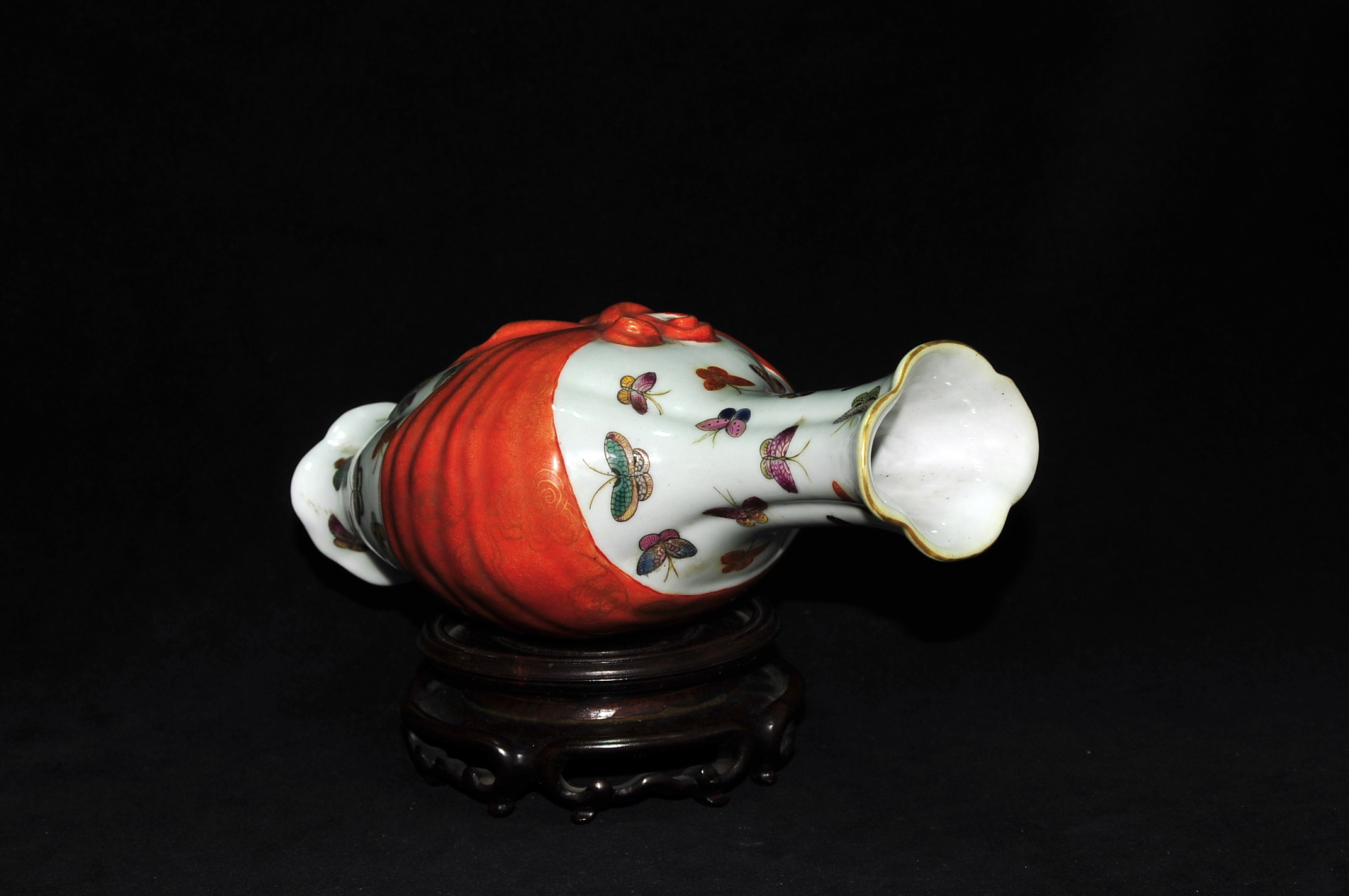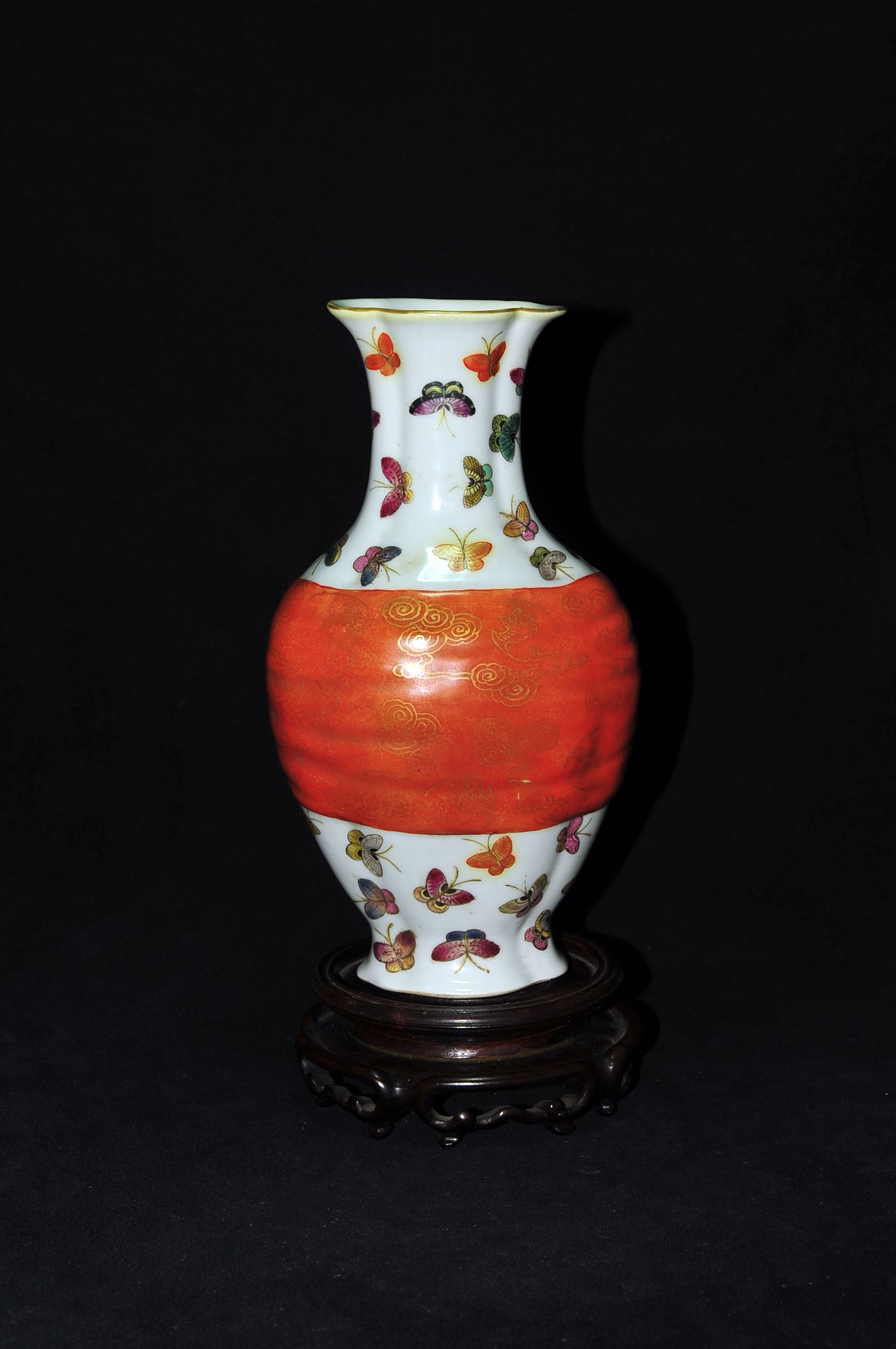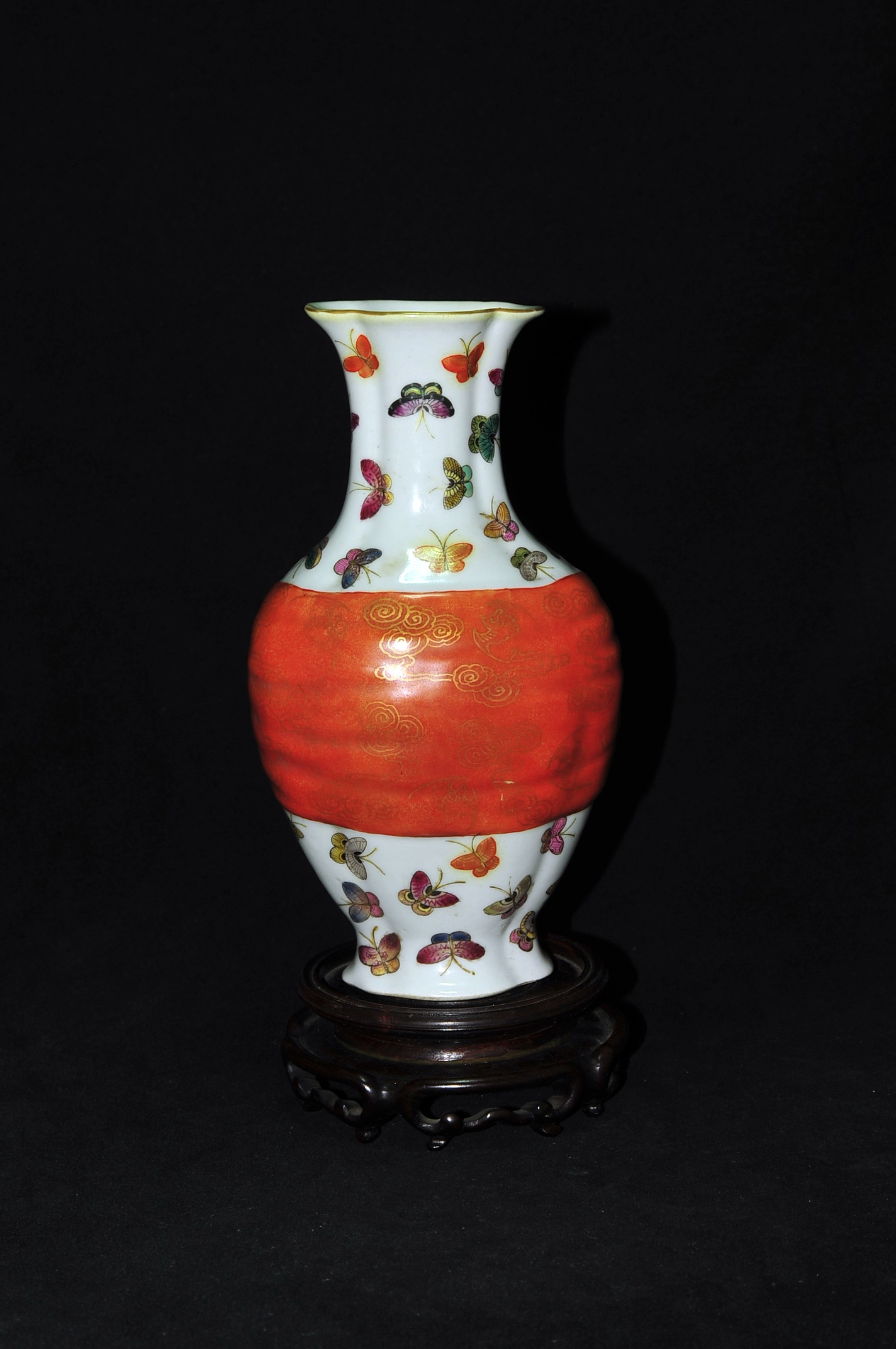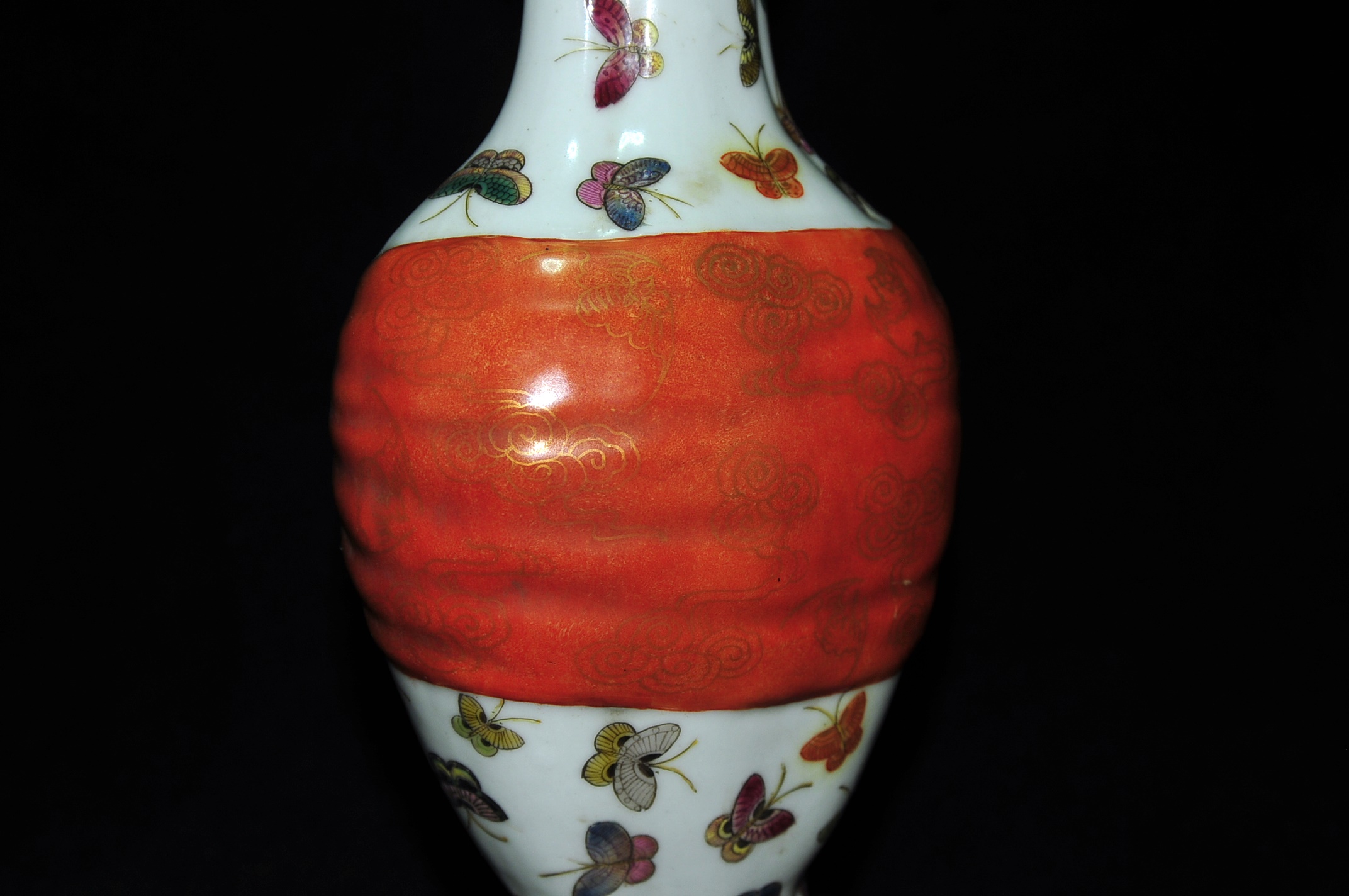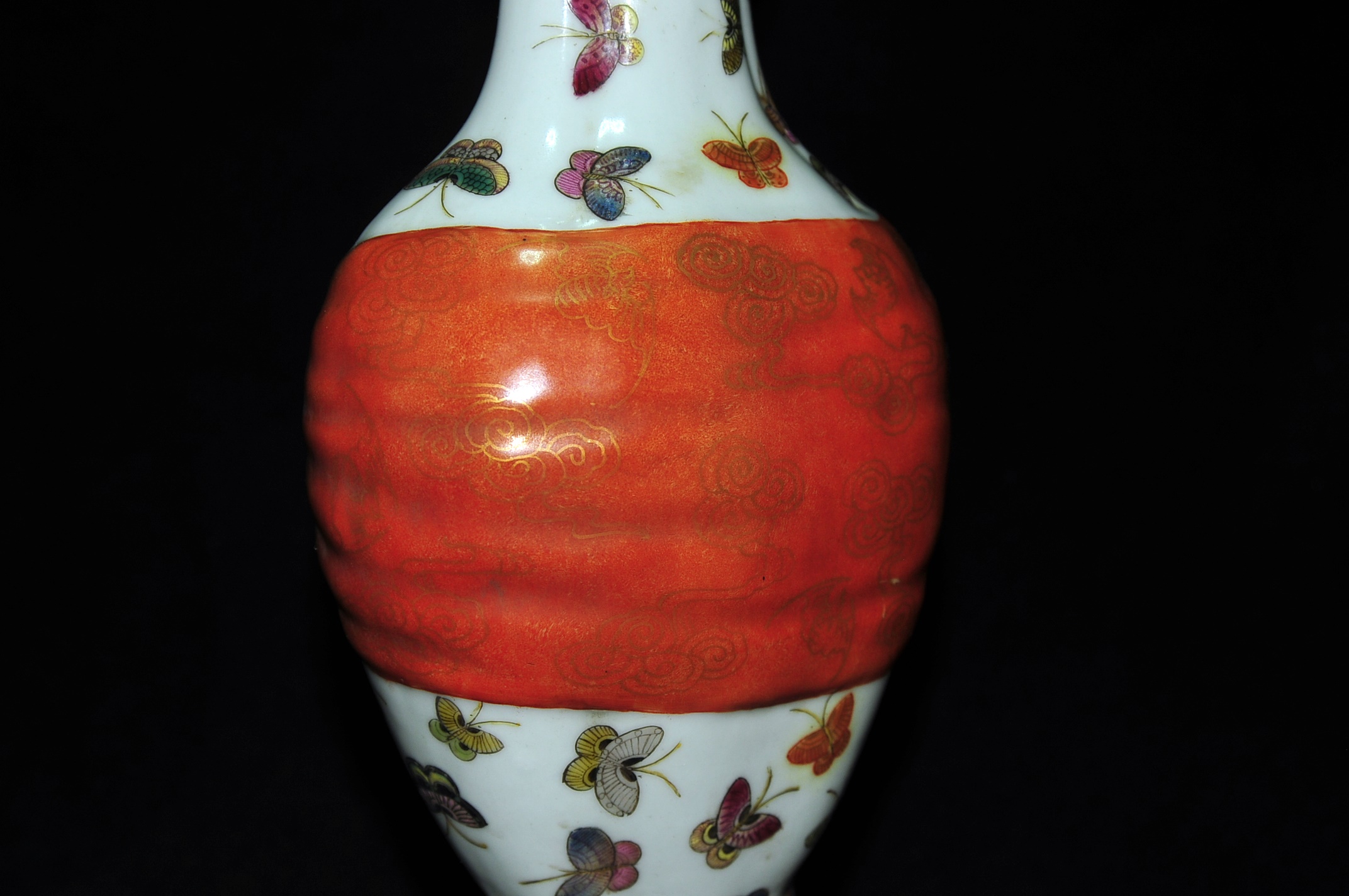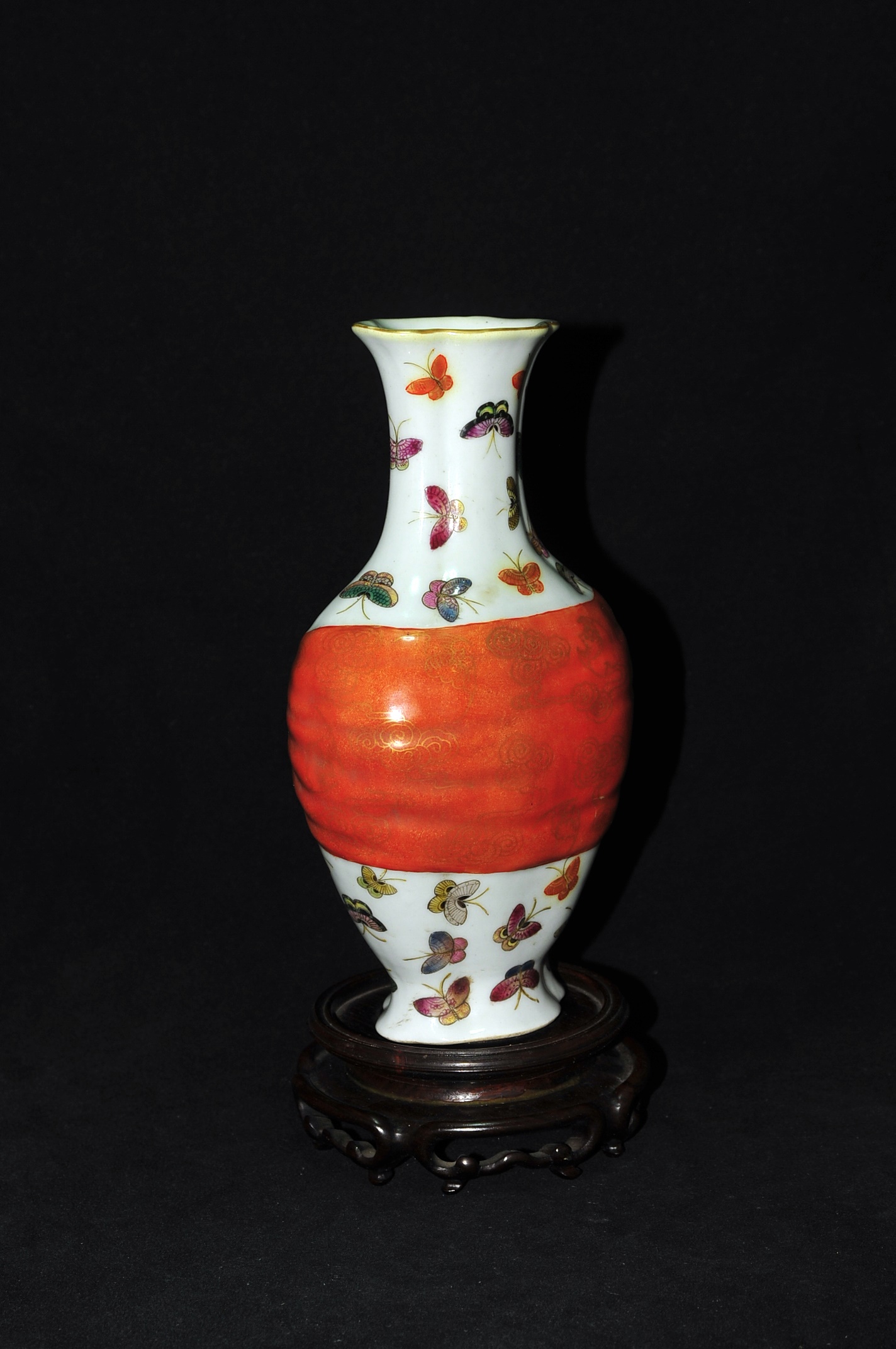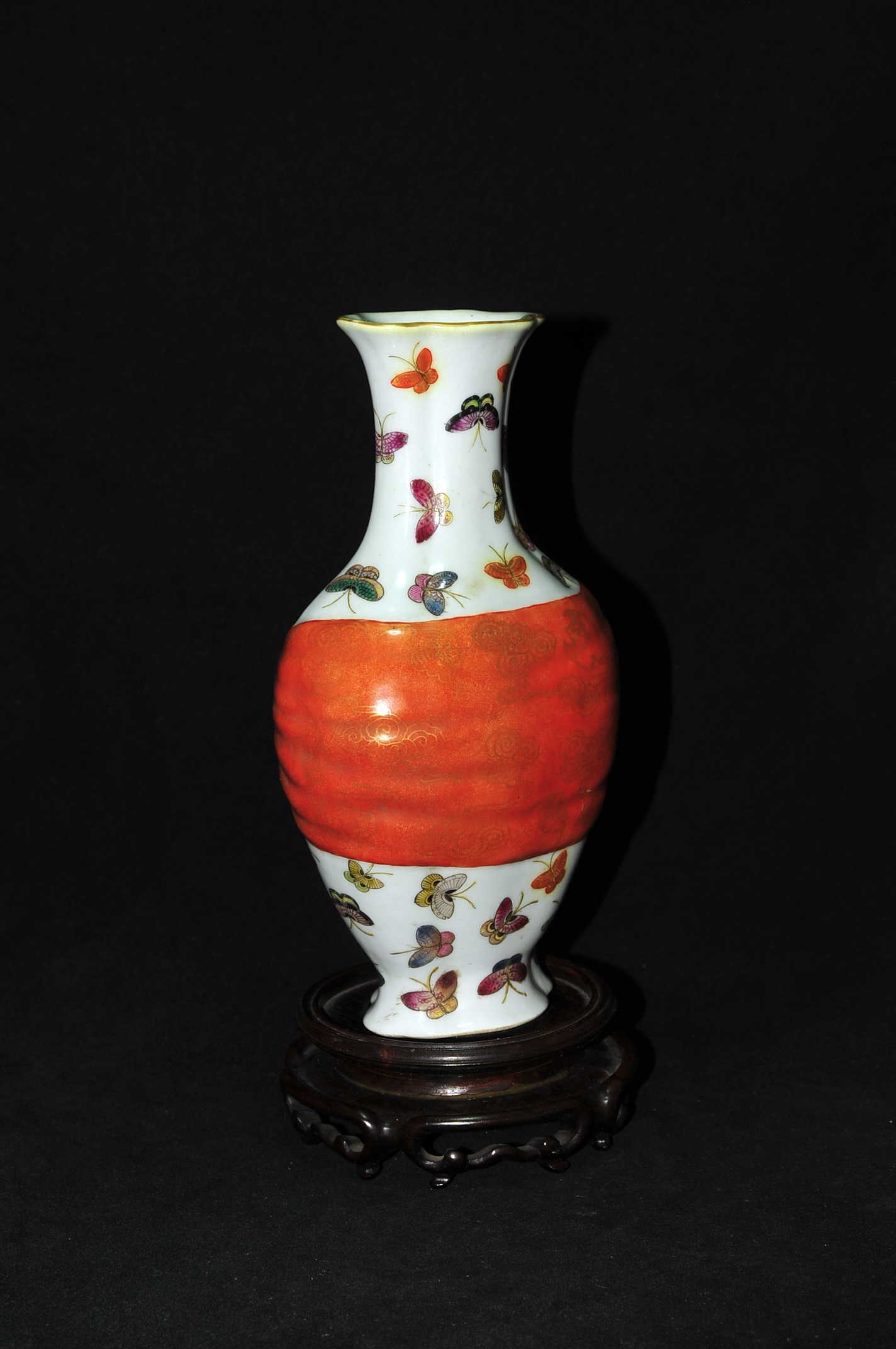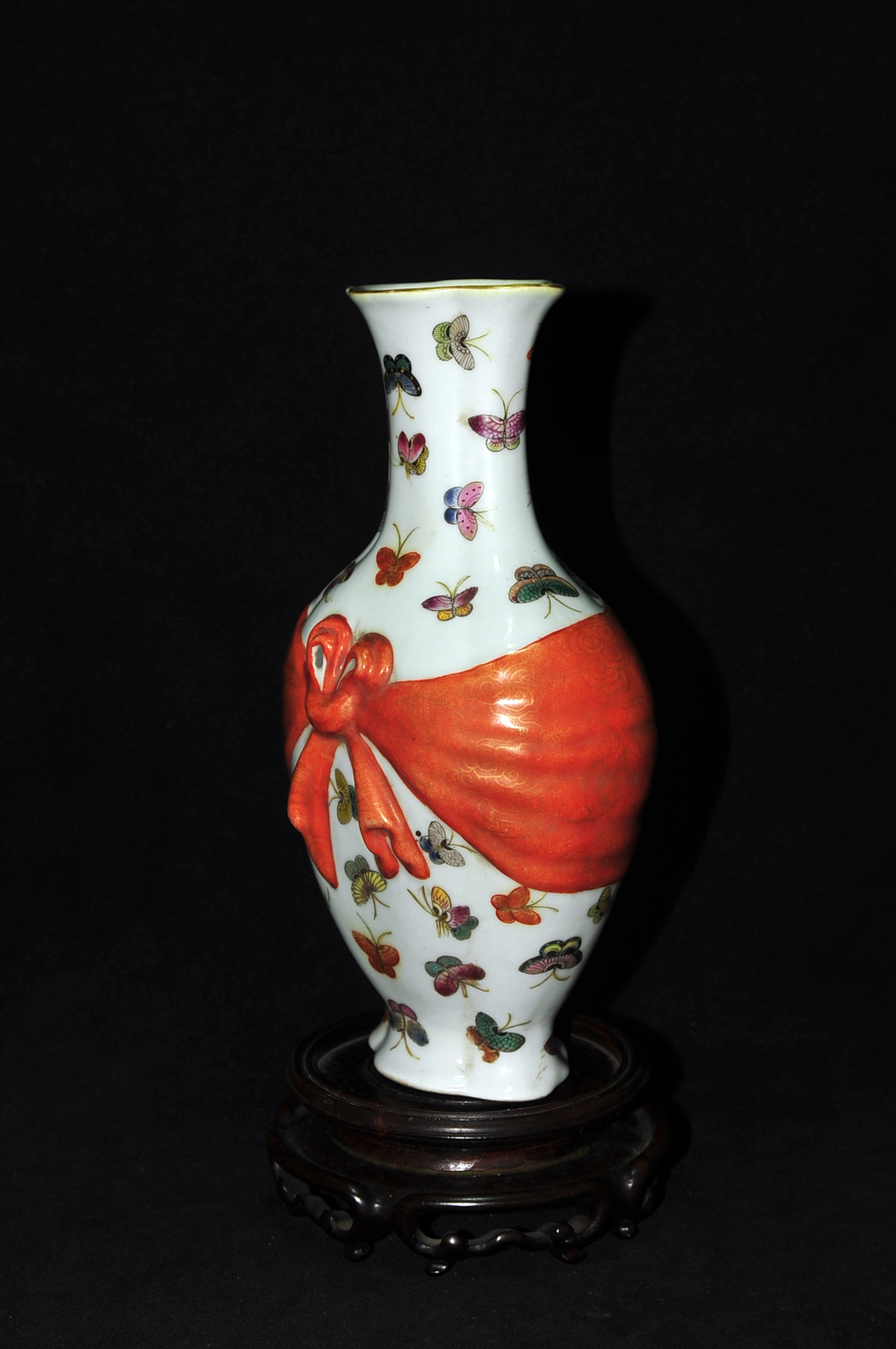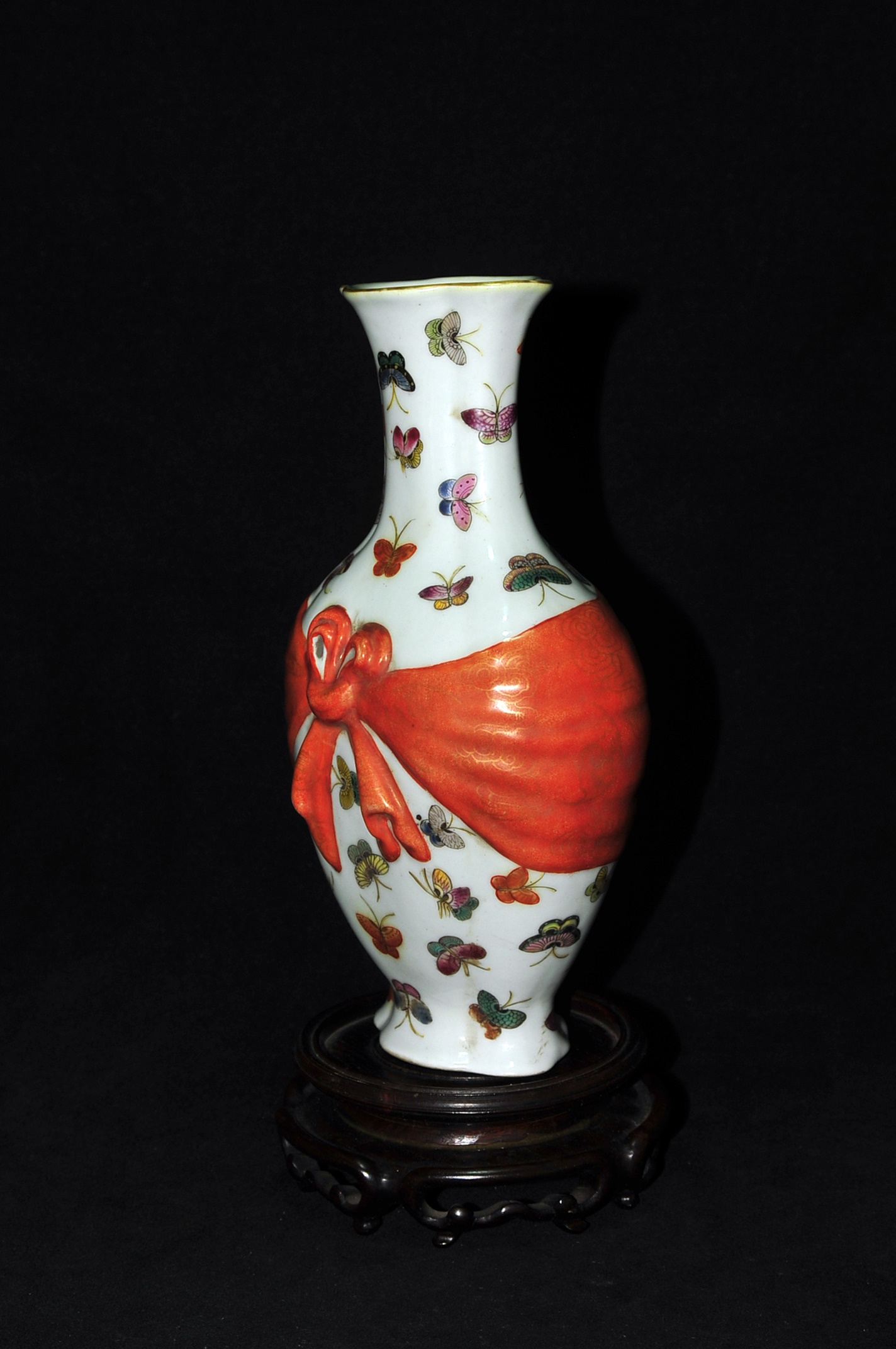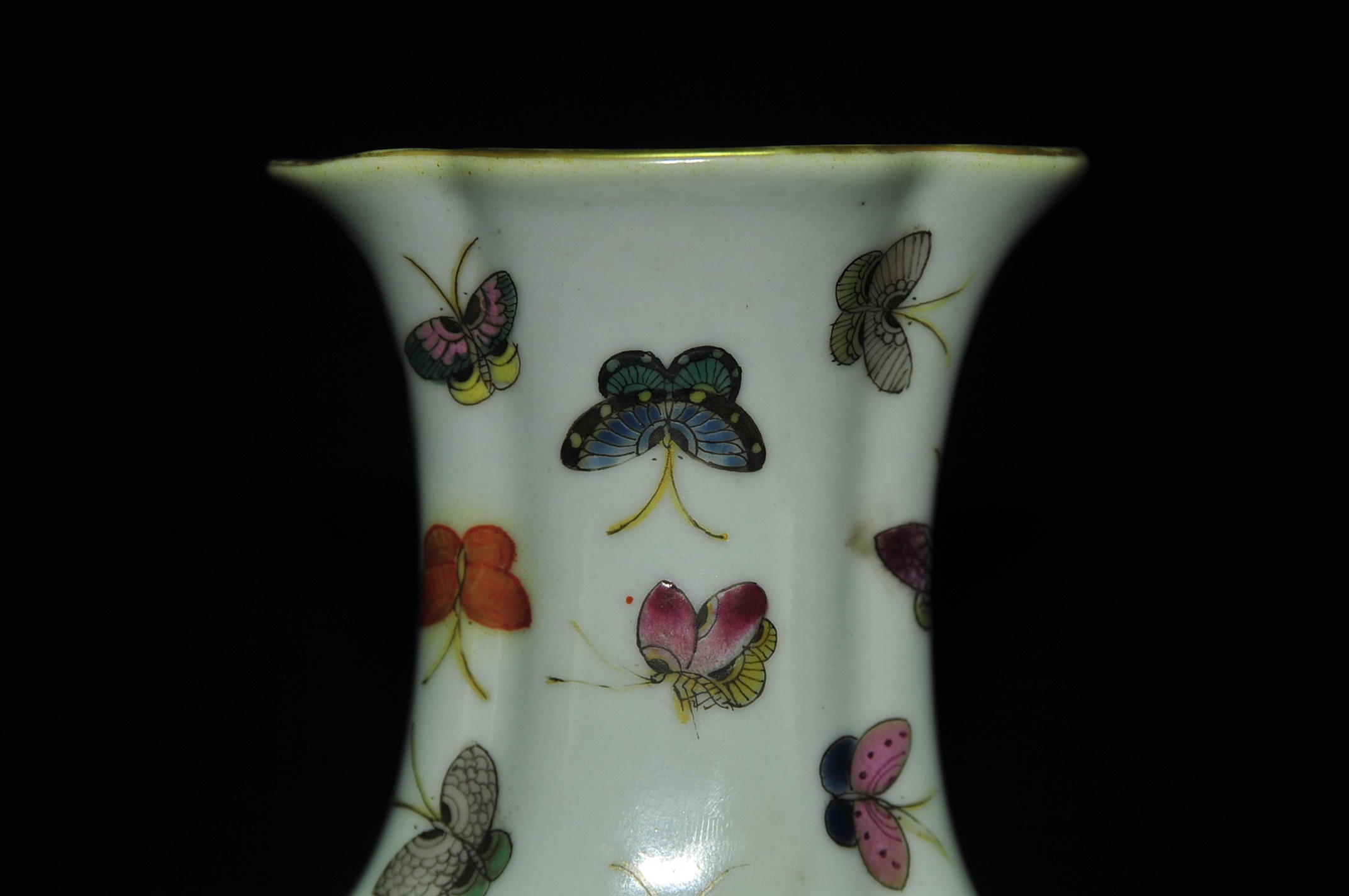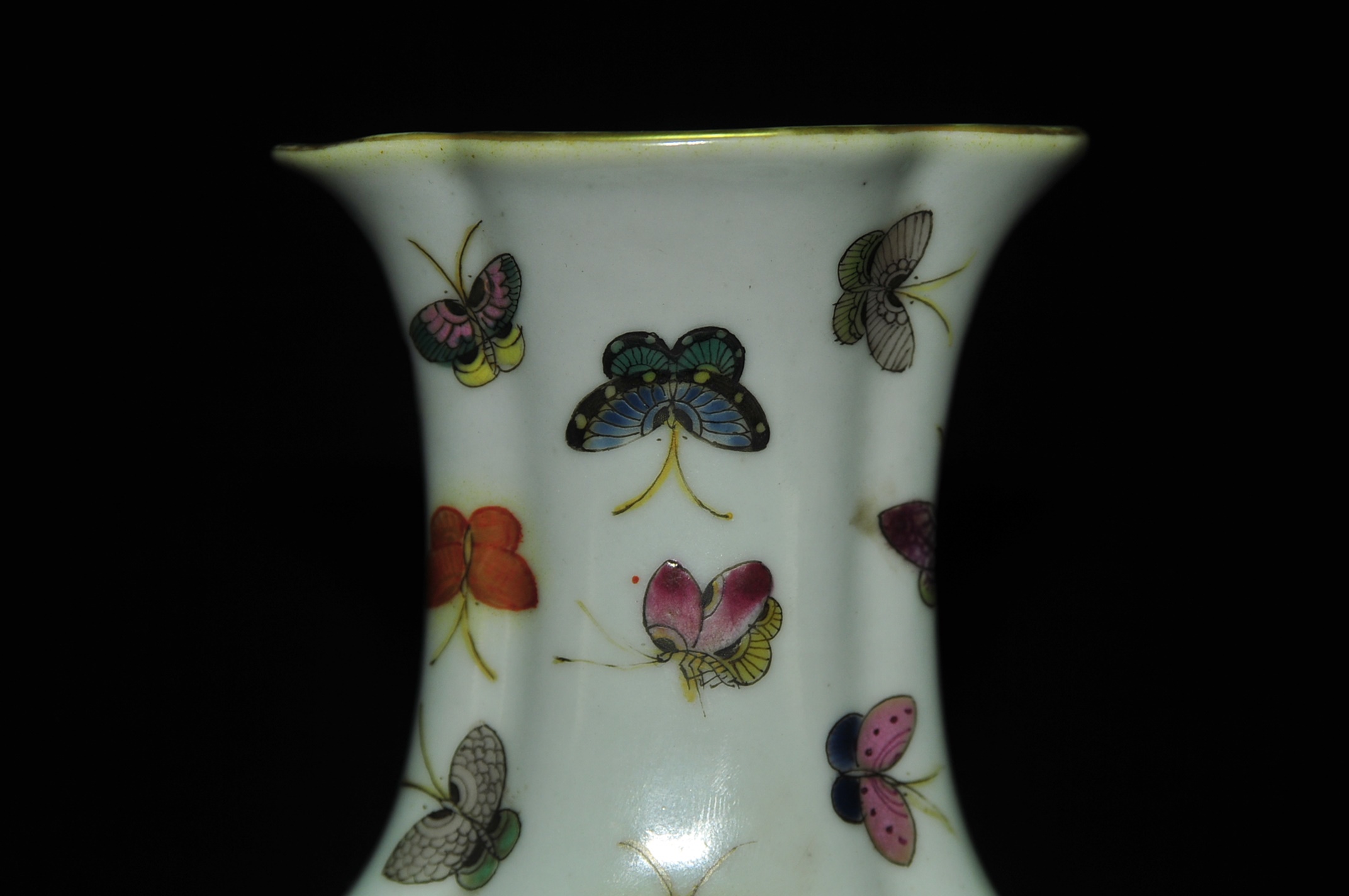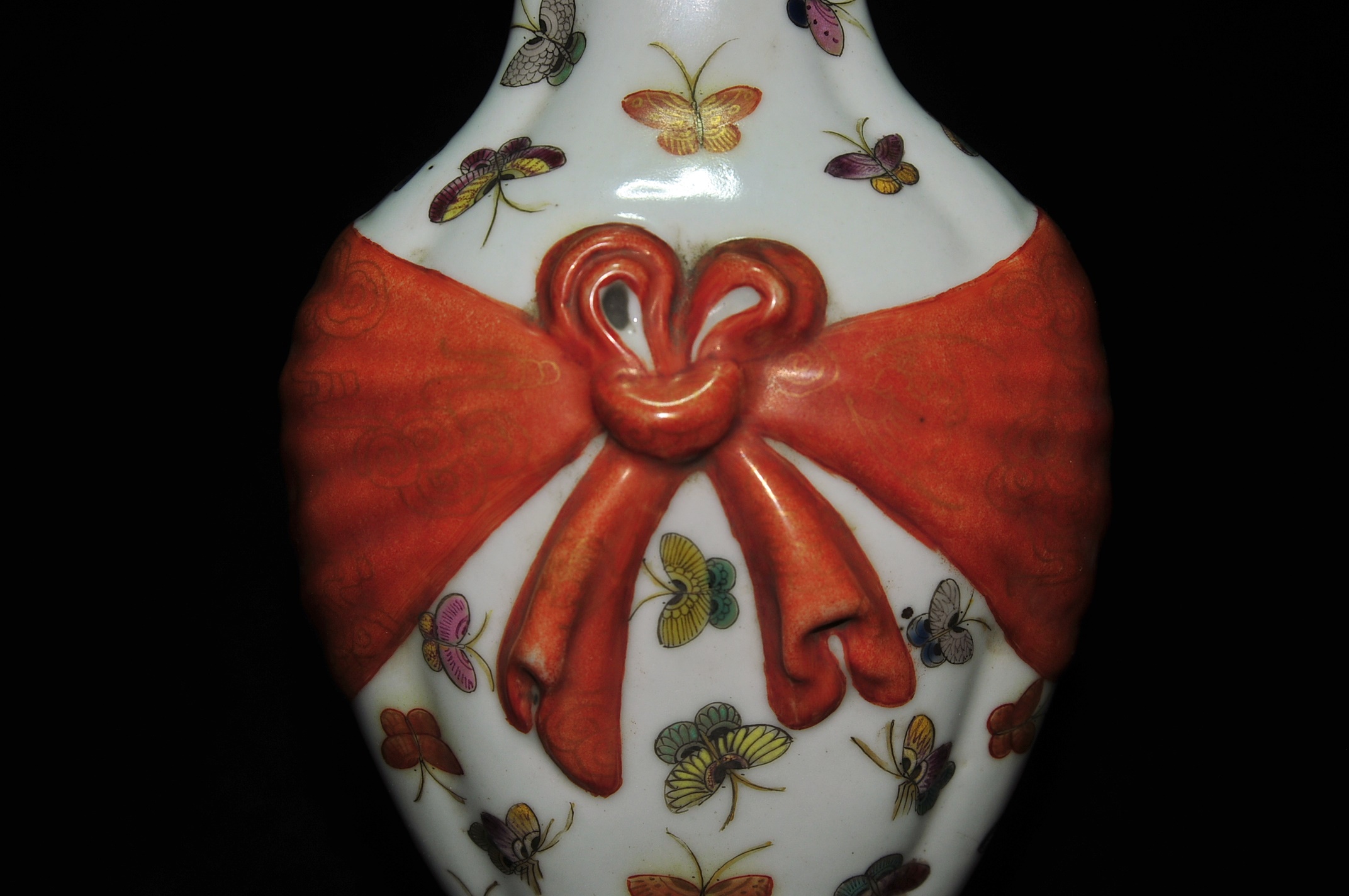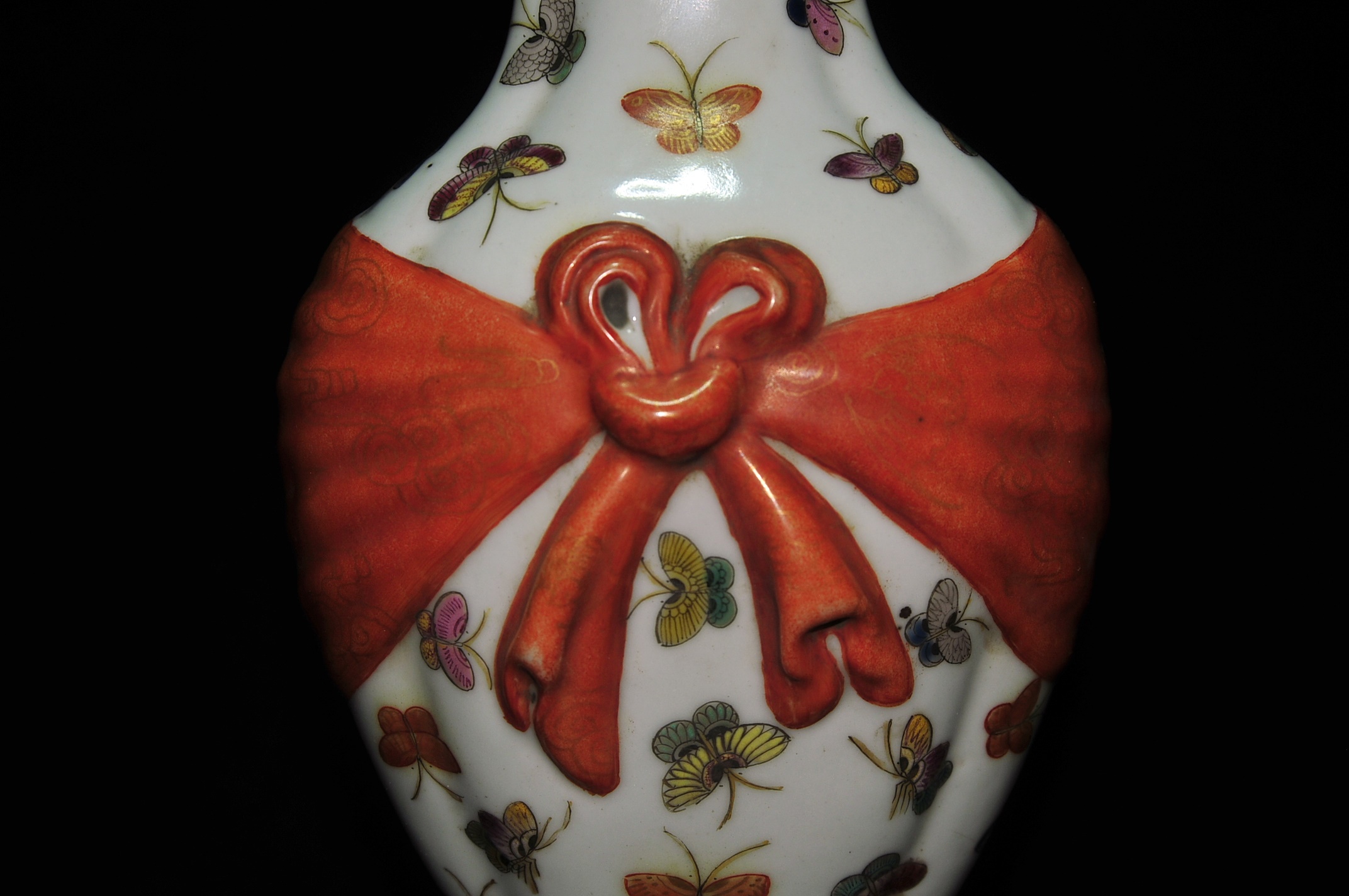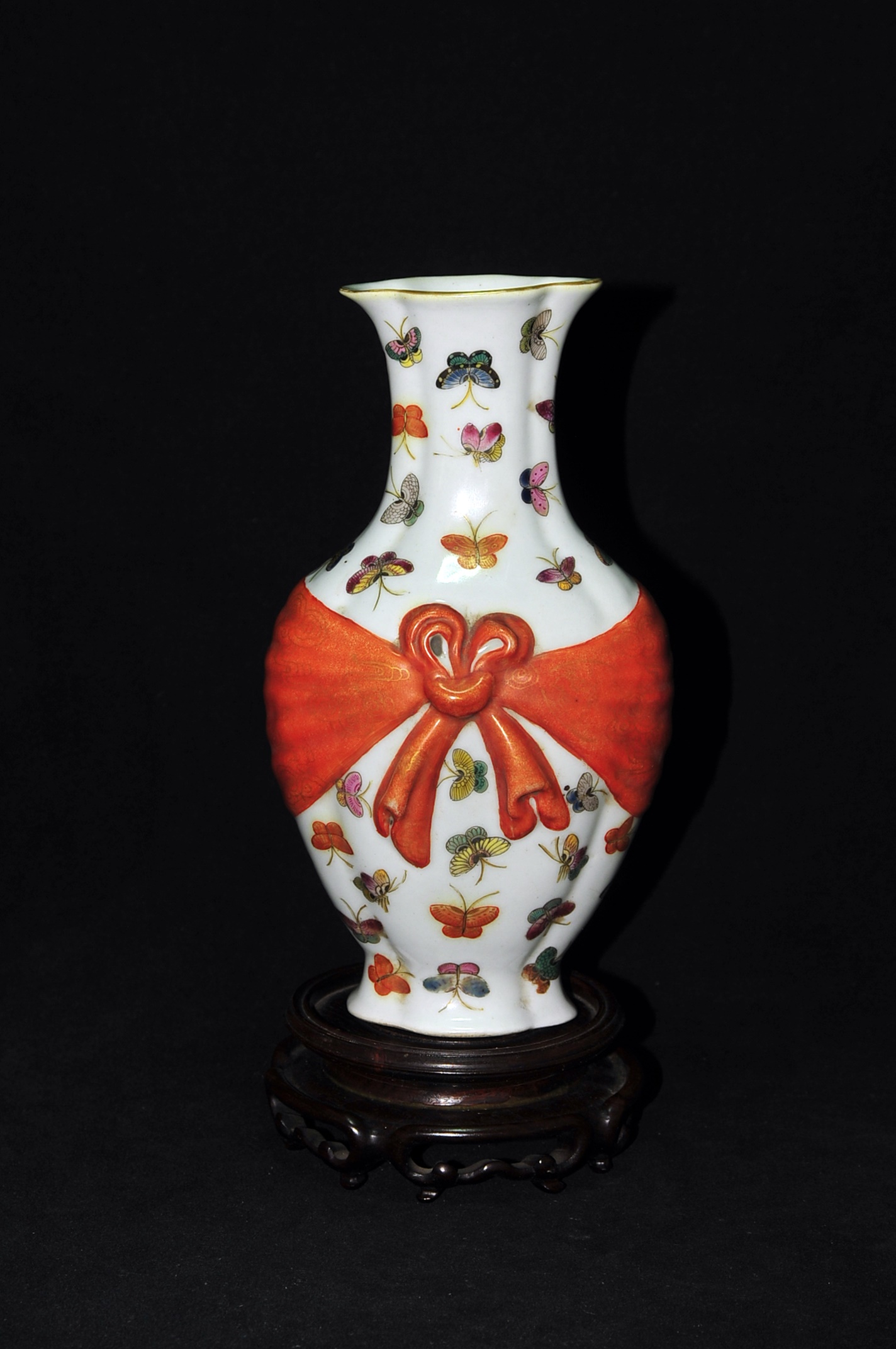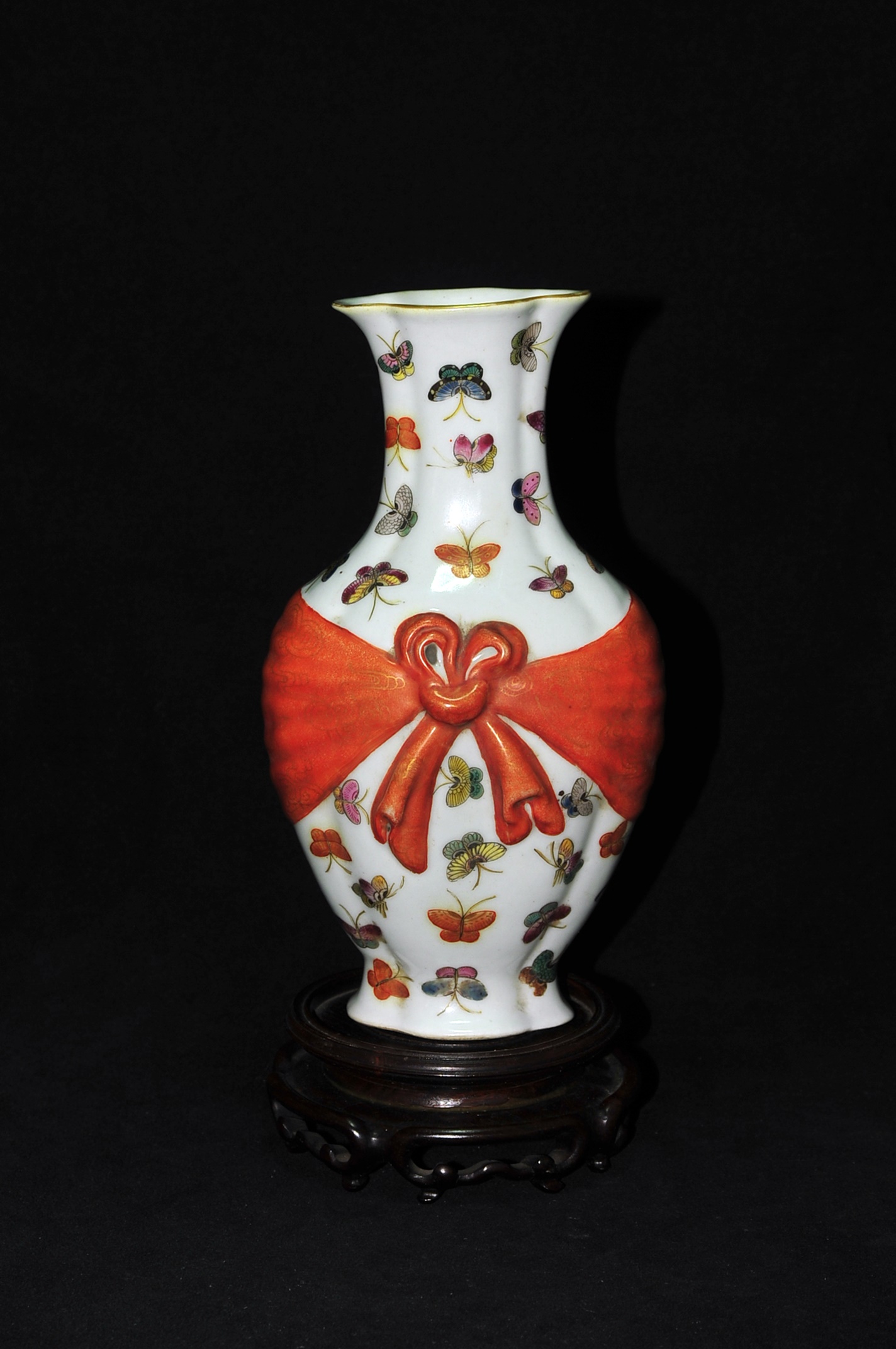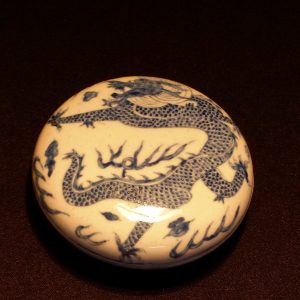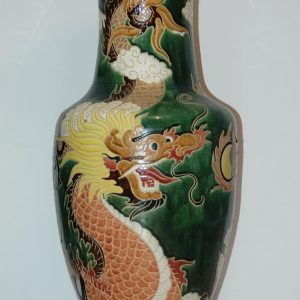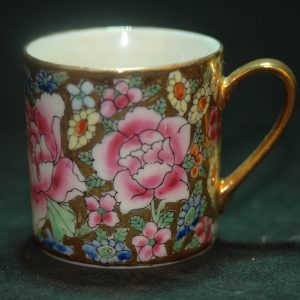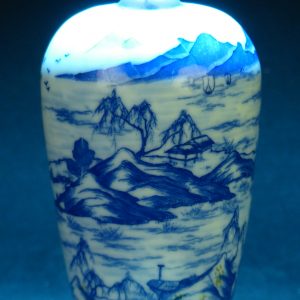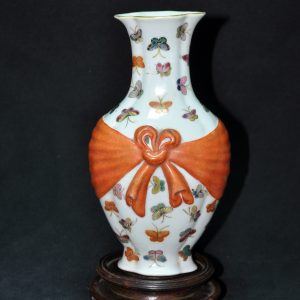Description
大清道光款 粉彩百蝶纹海棠形包袱瓶
以蝴蝶作为吉祥图案,除色彩斑斓外,以蝴蝶作装饰是象征长寿之意。“百蝶”与“百耋”谐音。“百耋”意味“年高百岁”。另外,“包袱瓶”也有 “报福平安”的意思。
参考:佳士得 現場拍賣 21660
重要中國瓷器及工藝精品
拍品 923 清乾隆 洋彩霽藍地描金花卉紋包袱瓶 六字篆書款
A RARE YANGCAI AND GILT-DECORATED BLUE-GLAZED BE-RIBBONED HU-FORM VASE
QIANLONG SIX-CHARACTER SEAL MARK IN UNDERGLAZE BLUE AND OF THE PERIOD (1736-1795)



估價 港元 1,200,000 – 港元 2,800,000
細節
清乾隆 洋彩霽藍地描金花卉紋包袱瓶 六字篆書款
12 in. (30.6 cm.) high.
來源
紐約佳士得,1987年9月22-23日,拍品180號
拍品專文
包袱紋為雍正、乾隆時期宮廷御用器的流行裝飾題材,常見於琺瑯器、玻璃器、瓷器。據檔案記載,乾隆會要求造辦處為其喜歡的各類器皿專門配做錦袱包裹,或用楠木匣盛裝,並將器物的名稱、年號刻在蓋匣上,以示珍藏。又因「包袱」諧音「包福」,寓意吉祥。故包袱紋飾的流行應與上述原因相關。
比較一件造型相若、尺寸相當(31公分高),同書乾隆篆書款例,拍賣於香港佳士得,1997年4月27-28日,拍品753號(圖一)。
参考:佳士得
現場拍賣 17113
2019年5月14日
中國瓷器及工藝精品
拍品 290 清同治 黃地粉彩百蝶紋渣斗 礬紅四字楷書款
A FAMILLE ROSE YELLOW-GROUND ‘BUTTERFLIES’ SPITTOON, ZHADOU
來源: 德國私人舊藏,於1911年前購自北京倫敦佳士得2008年11月4日,拍品233歐洲私人珍藏
TONGZHI FOUR-CHARACTER MARK IN IRON-RED AND OF THE PERIOD (1862-1874)
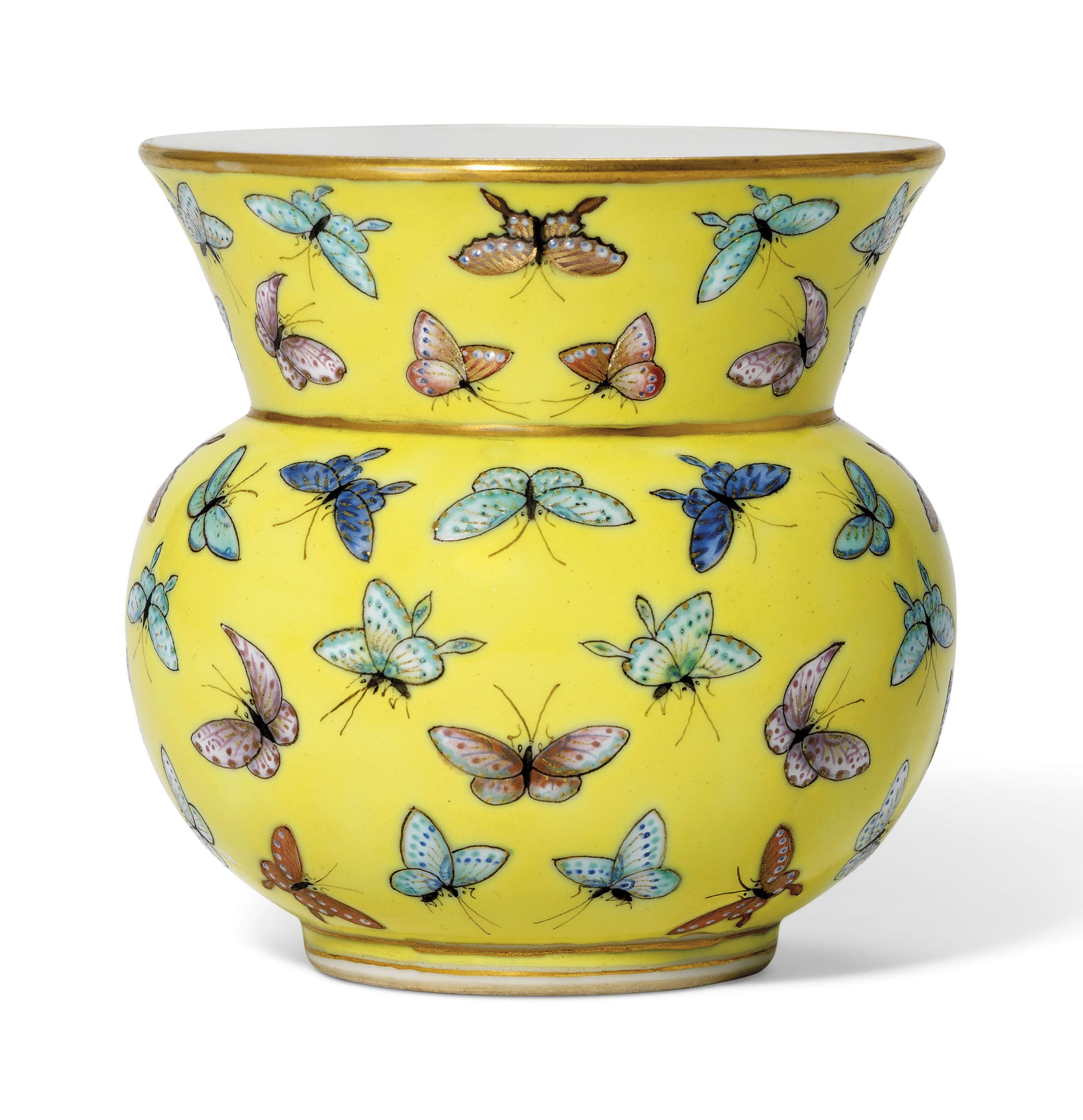
成交價 英鎊 25,000
估價 英鎊 5,000 – 英鎊 8,000
清同治 黃地粉彩百蝶紋渣斗 礬紅四字楷書款
來源:
德國私人舊藏,於1911年前購自北京
倫敦佳士得2008年11月4日,拍品233
歐洲私人珍藏
From an old German Collection formed in Beijing before 1911.
Christie’s London, 4 November 2008, lot 233.
A private European Collection.
3 ½ in. (8.9 cm.) high
状况报告
我们试图记录这件产品在初次制造后的状况变化。
– 该容器看起来整体状况良好,珐琅和镀金预计有轻微磨损。
参考:佳士得
現場拍賣 17113
2019年5月14日
中國瓷器及工藝精品
拍品 292 清同治 黃地粉彩百蝶紋盤 礬紅四字楷書款清十九世紀
A LARGE FAMILLE ROSE YELLOW-GROUND ‘BUTTERFLIES’ JARDINIÈRE AND A DISH
THE JARDINIÈRE: 19TH CENTURY THE DISH: TONGZHI FOUR-CHARACTER MARK IN IRON-RED AND OF THE PERIOD (1862-1874)
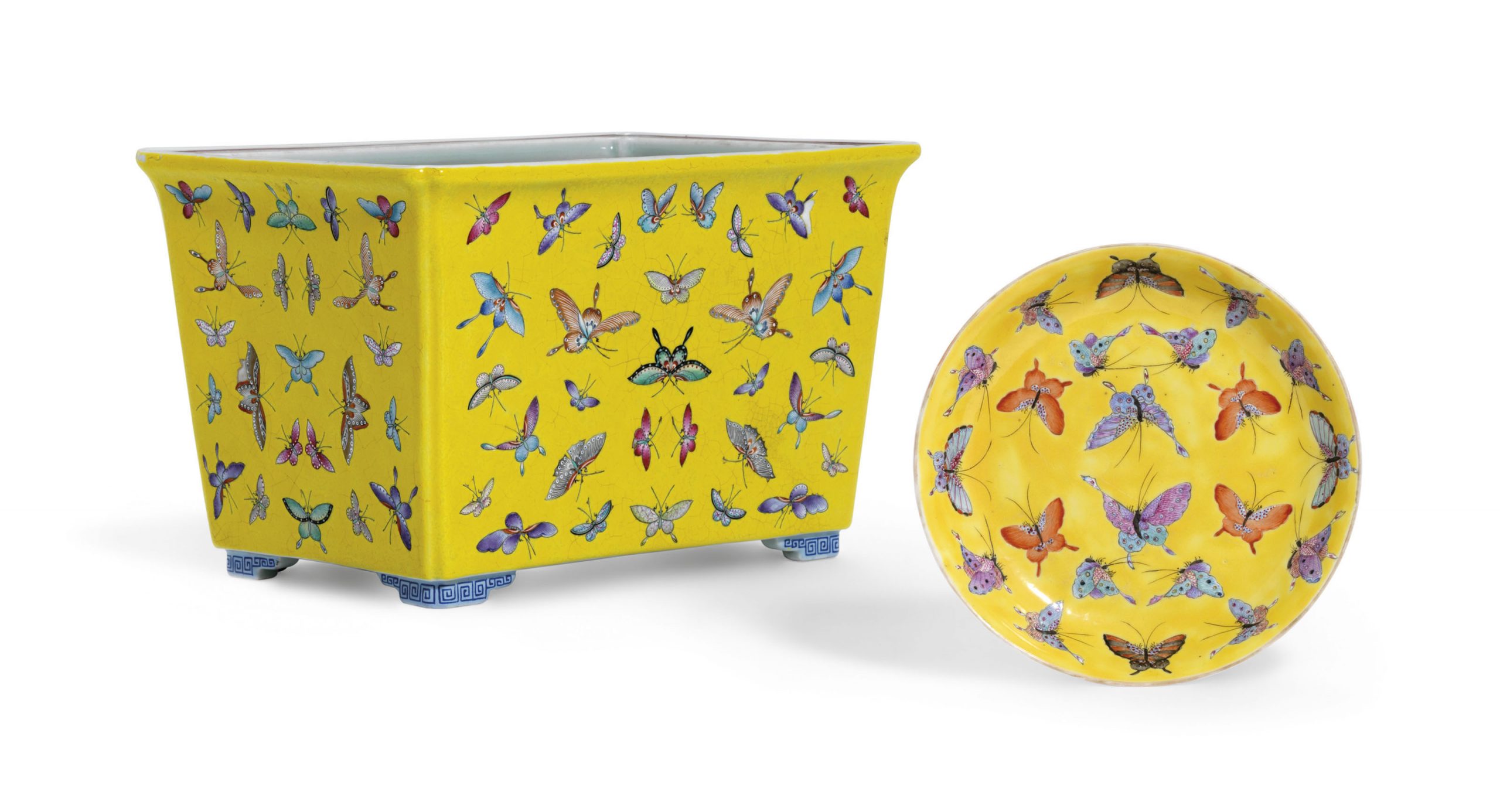
成交價 英鎊 7,500
估價 英鎊 5,000 – 英鎊 8,000
清同治 黃地粉彩百蝶紋盤 礬紅四字楷書款
清十九世紀 黃地粉彩百蝶紋盆
THE JARDINIÈRE: 19TH CENTURY THE DISH: TONGZHI FOUR-CHARACTER MARK IN IRON-RED AND OF THE PERIOD (1862-1874)
來源:
盤: 倫敦邦瀚斯2008年5月12日,拍品323
歐洲私人珍藏
The jardinière, 13 in. (33 cm.) wide
The dish: Bonhams London, 12 May 2008, lot 323.
A private European Collection.
狀況報告
我们已尝试记录这些器皿在初始制造后所发生的变化。
– 盆栽的黄色琺瑯上出现细微的开裂和一块小碎片(最大约1厘米),并且盆口周围以及口部存在一些磨损。
– 盘子的底部有一些小而浅的切割。
– 除此之外,两件器皿整体上看起来都处于良好状态,镀金和琺瑯上有些许轻微磨损,与年代相符。
参考:國立故宮博物院 清 乾隆 冬青撇口瓶
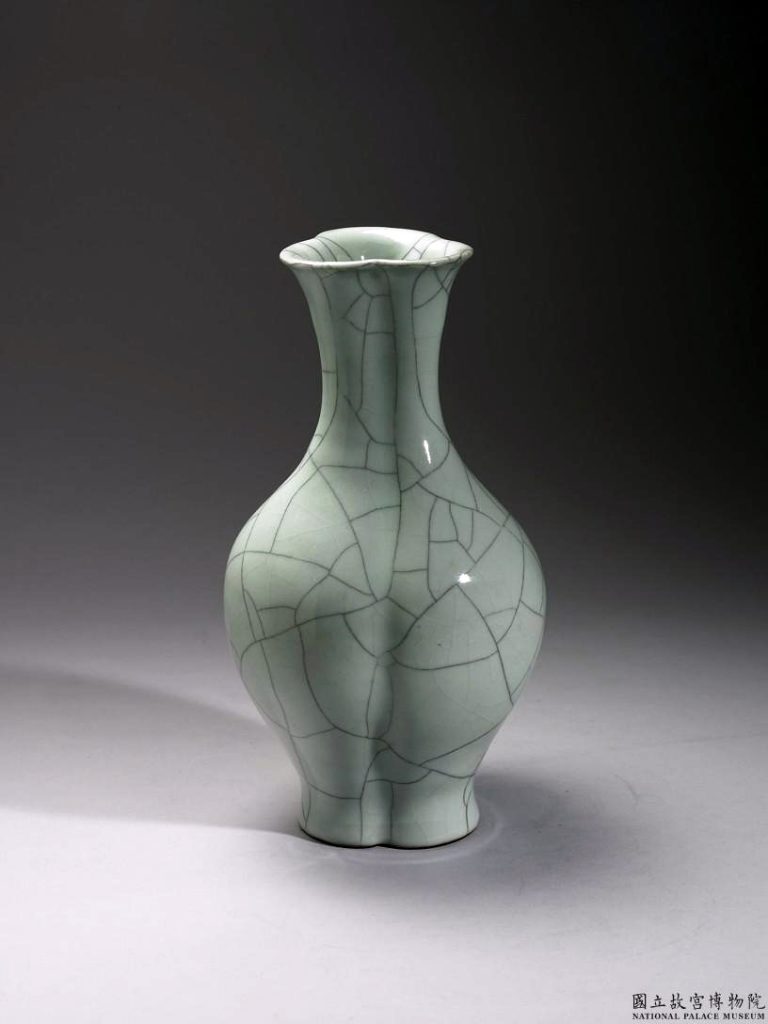
資料識別:中瓷001153N000000000
資料類型:陶瓷器
描述:
撇口,長頸,溜肩,斂腹,外撇圈足,刻三道棱線作三器相連狀。全器施仿哥釉,釉面上有開片裂紋,顏色深者較疏,淺者較密。圈足施醬褐色護胎汁。底青花書「大清乾隆年製」六字三行篆書款。
日期:1736 A.D.-1795 A.D.
格式:高26.5公分 口徑8.5公分底徑8.5公分
参考: 香港蘇富比拍卖有限公司
1996年秋季拍卖会
1996-11-05
中国瓷器、玉器杂项
LOT号: 0858 清乾隆 豆青釉凤耳海棠式瓶
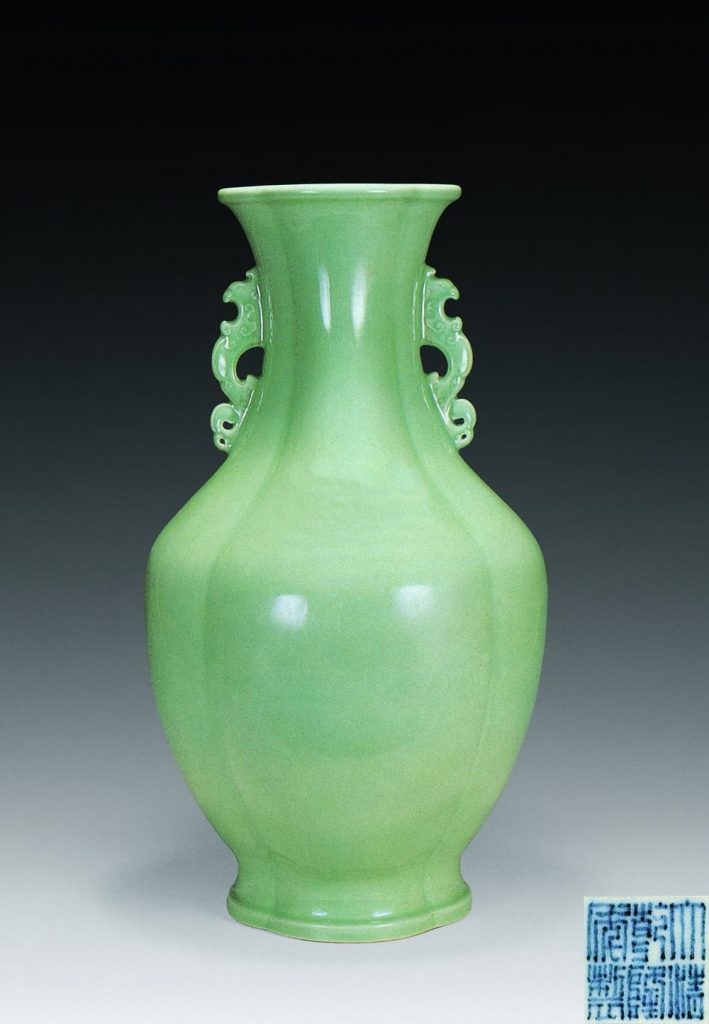
尺寸 68.6cm
估价 HKD 700,000-900,000
成交价 流拍
《大清乾隆年制》款
参考:北京东正拍卖有限公司
2013春季艺术品拍卖会
2013-05-10
皇家长物——宫廷艺术专场
LOT号:0166 清乾隆 官窑茶叶末釉双螭耳海棠瓶
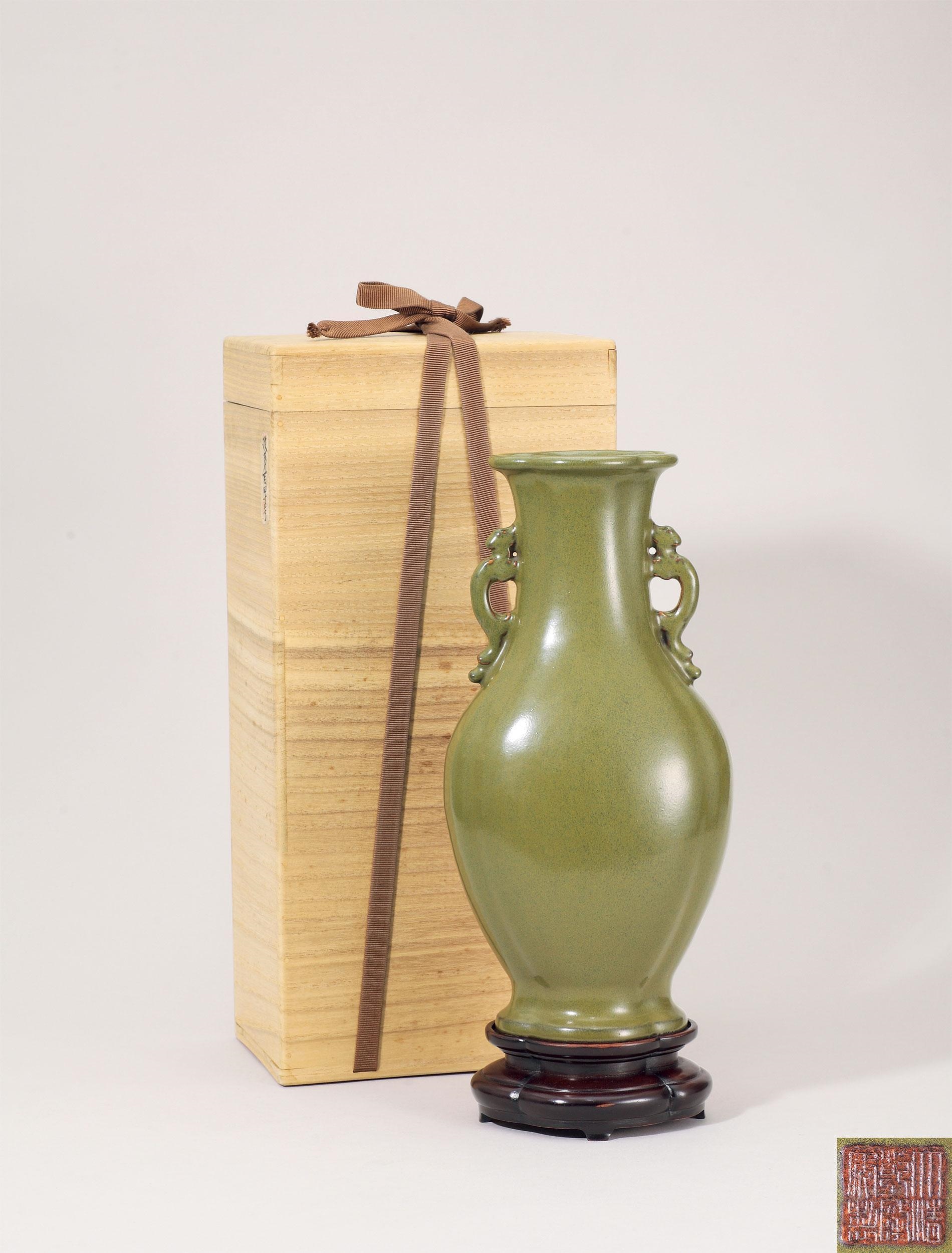
尺寸 高29.8cm
估价 RMB 1,200,000-1,500,000
成交价 RMB 2,070,000HKD 2,613,636USD 310,500EUR 227,700
专场 皇家长物——宫廷艺术专场
款识:大清乾隆年制
来源:早年为日本关西旧藏
说明:
瓶为海棠形,口沿微撇,细颈,扁圆形腹,颈饰双螭耳,圈足外撇,底落“大清乾隆年制”篆书刻款。通体皆施茶叶末釉,釉色深沉匀净,古朴典雅。茶叶末釉,学名称厂官釉,指一种铁、镁质结晶釉,唐代陕西铜川黄堡镇的耀州窑即烧制,清代雍正时期,唐英任督陶官时,景德镇御窑厂仿古新创、仿古釉色达57种之多,厂官釉即为其一,其“黄杂绿色,娇娆而不俗,艳于花,美如玉,范为瓶,最养目。”当时便视若“秘釉”,御窑厂专烧仅供皇室使用,清代内务府档案中记载乾隆皇帝曾多次过问厂官釉瓷器烧造的情况,可见此种釉色之珍贵。此造型在传世品中十分少见,为难得的乾隆官窑高温釉器中的精品。此瓶呈海棠式花口,烧造难度大,传世者绝少,目前见有日本静嘉堂文库美术馆之相同收藏。另有青花缠枝莲品种,粉青描金开光粉彩品种与仿哥釉品种等,各式皆精珍佳作。
参阅:《静嘉堂藏-清朝陶磁-景德镇官窑之美》静嘉堂文库美术馆 2006年 Lot.110
参考: 苏富比 有鳳來儀:樂從堂珍藏乾隆料胎畫琺瑯包袱瓶
2019年10月8日 | 上午 10:35 HKT | 香港
1 清乾隆 料胎黃地畫琺瑯鳳舞牡丹包袱瓶《乾隆年製》藍料款
拍賣編號: HK0898 拍品 : 1
簡介
御製料胎畫琺瑯包袱瓶,成於乾隆初年,堪稱私人收藏清代宮廷藝術品中至寶至珍。料胎畫琺瑯器,製作繁複,依仗清宮御作坊中能士巧手,方得如此雅緻成品。此瓶尺寸大方,屬料胎琺瑯器中最碩者,且造型獨特,妙仿明黃包袱,頸繫粉帶,丹鳳為飾,牡丹上,曼舞翔飛,祥雲縈繞,雍容華貴,觀此紋飾,應為皇后之品。牡丹盛綻,一蕾獨含蓄,妙寫乾隆四字年款,更添玩趣。昔日恭親王奕訢府中寶珍,先後收入巴爾、白納德伉儷典藏,至2000年秋為現藏家珍蓄,如今得見,誠藝壇美事。
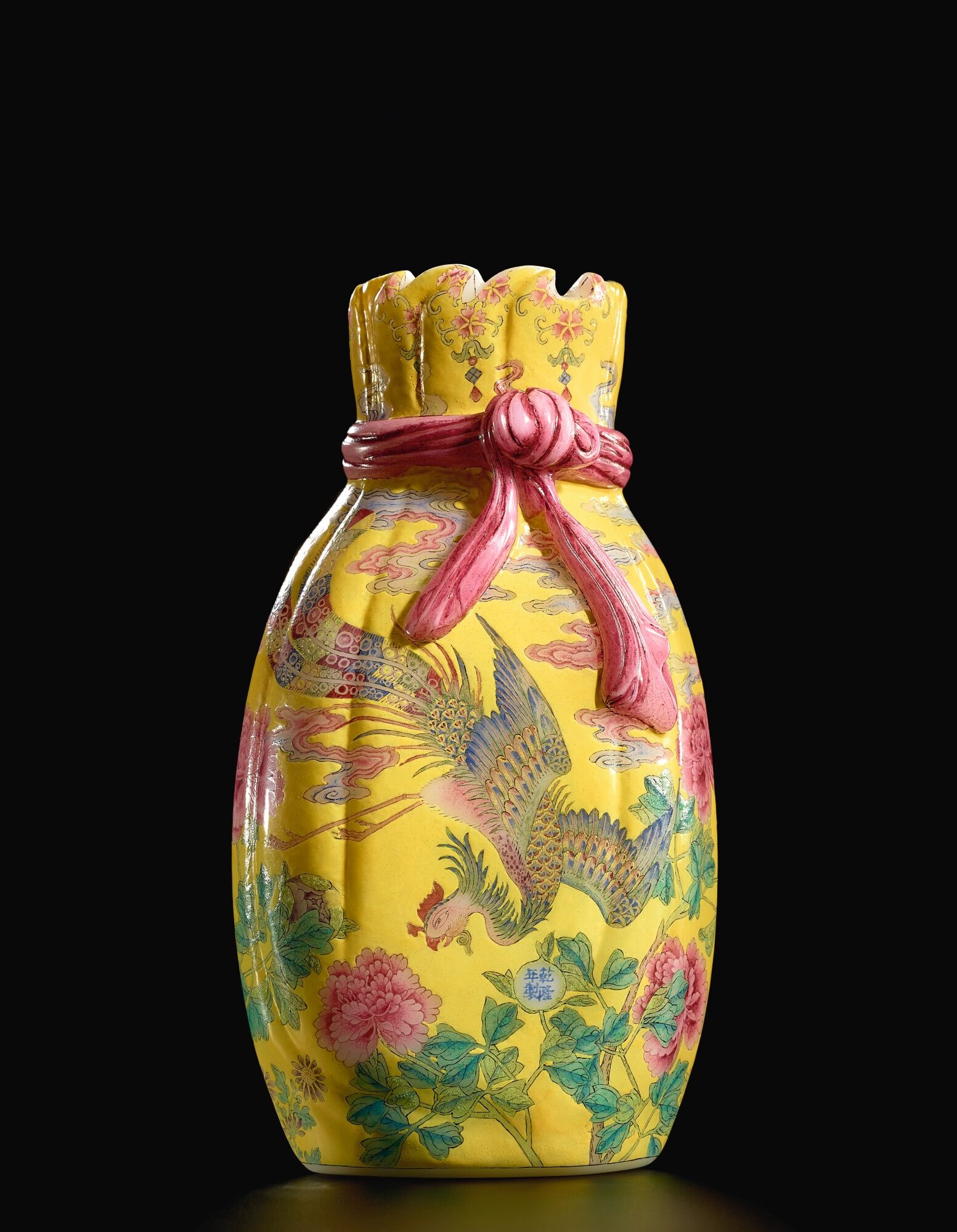
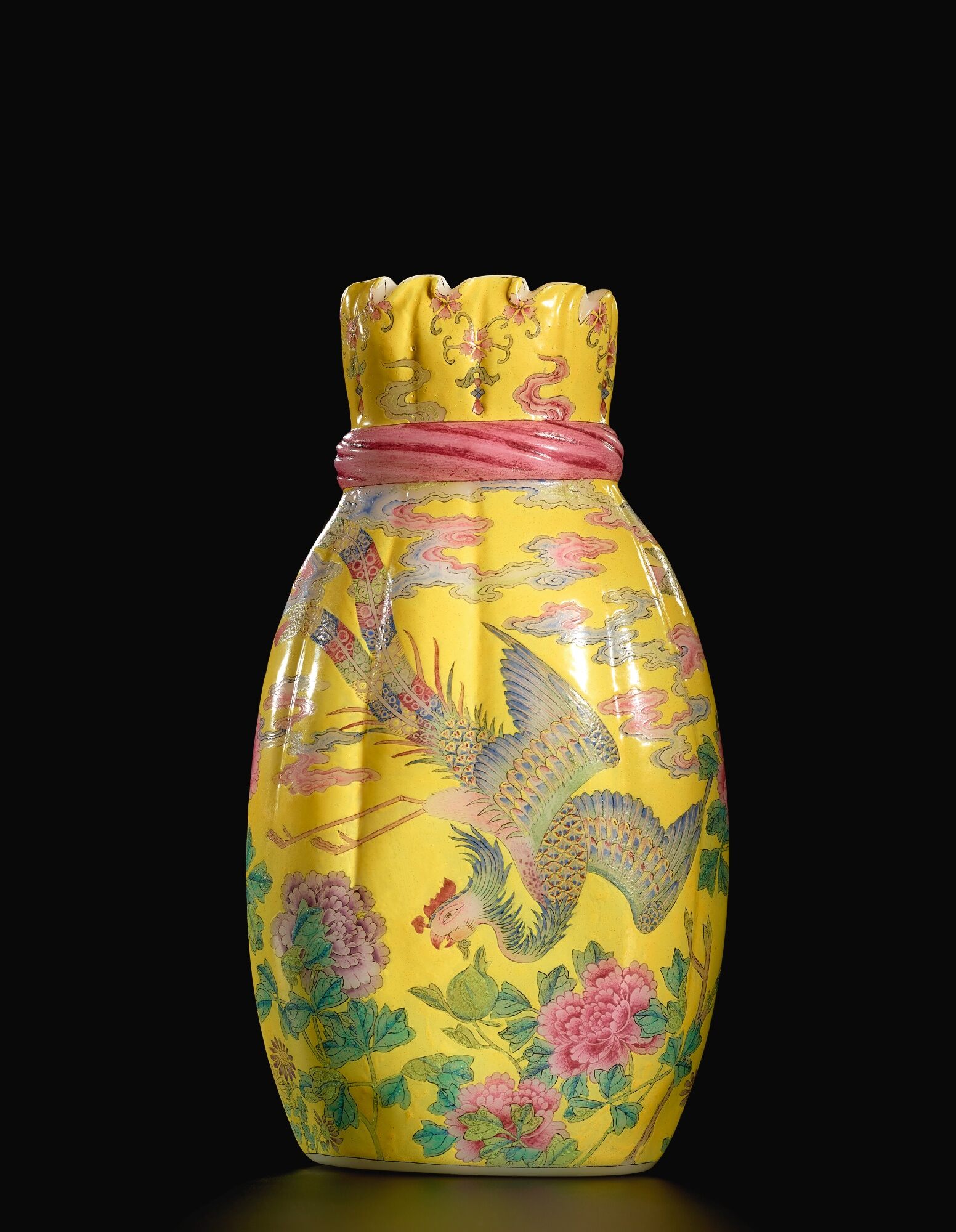
估價 估價待詢
拍品已售 207,086,000 港幣 成交價 (含買家佣金)
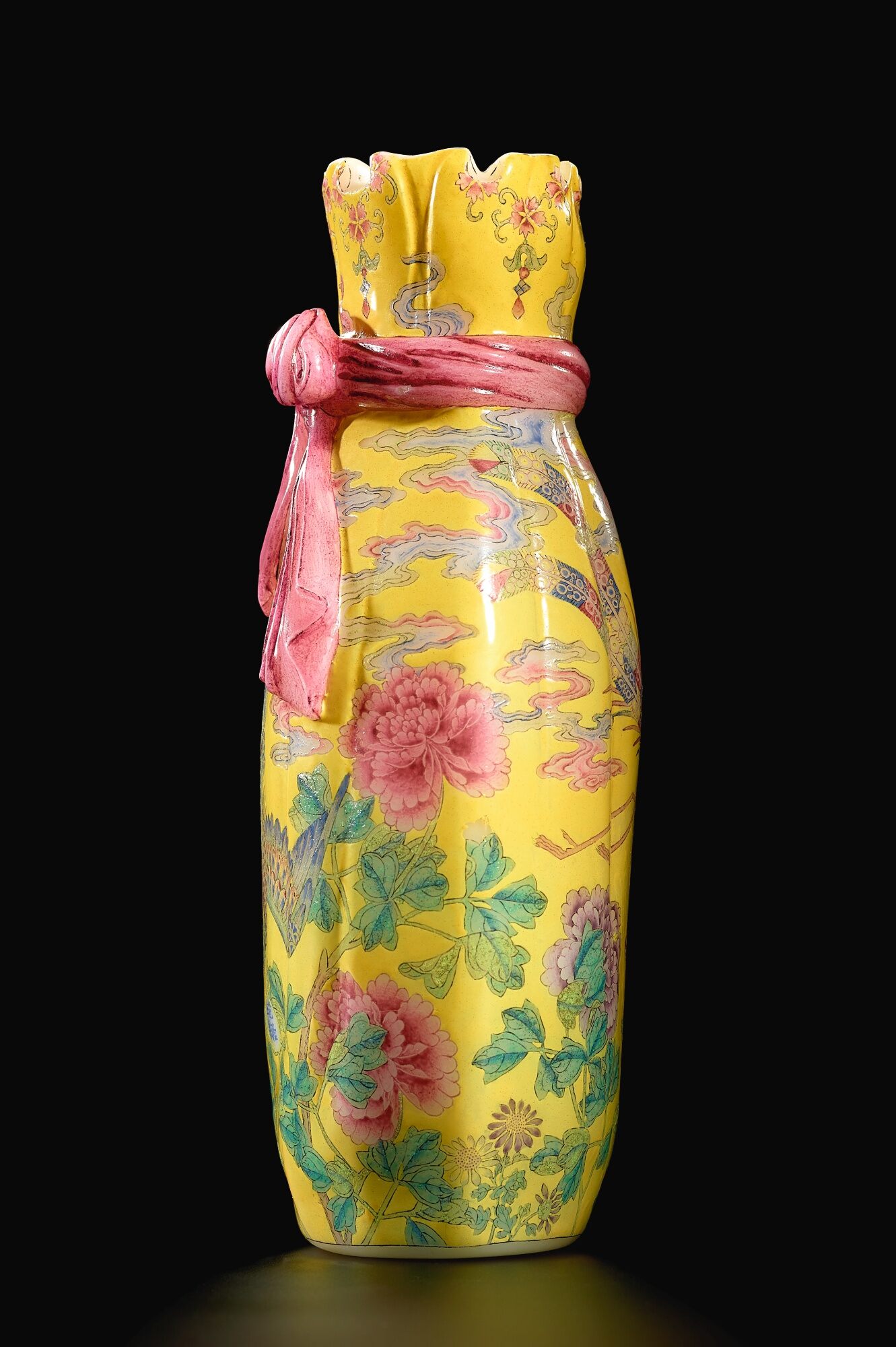
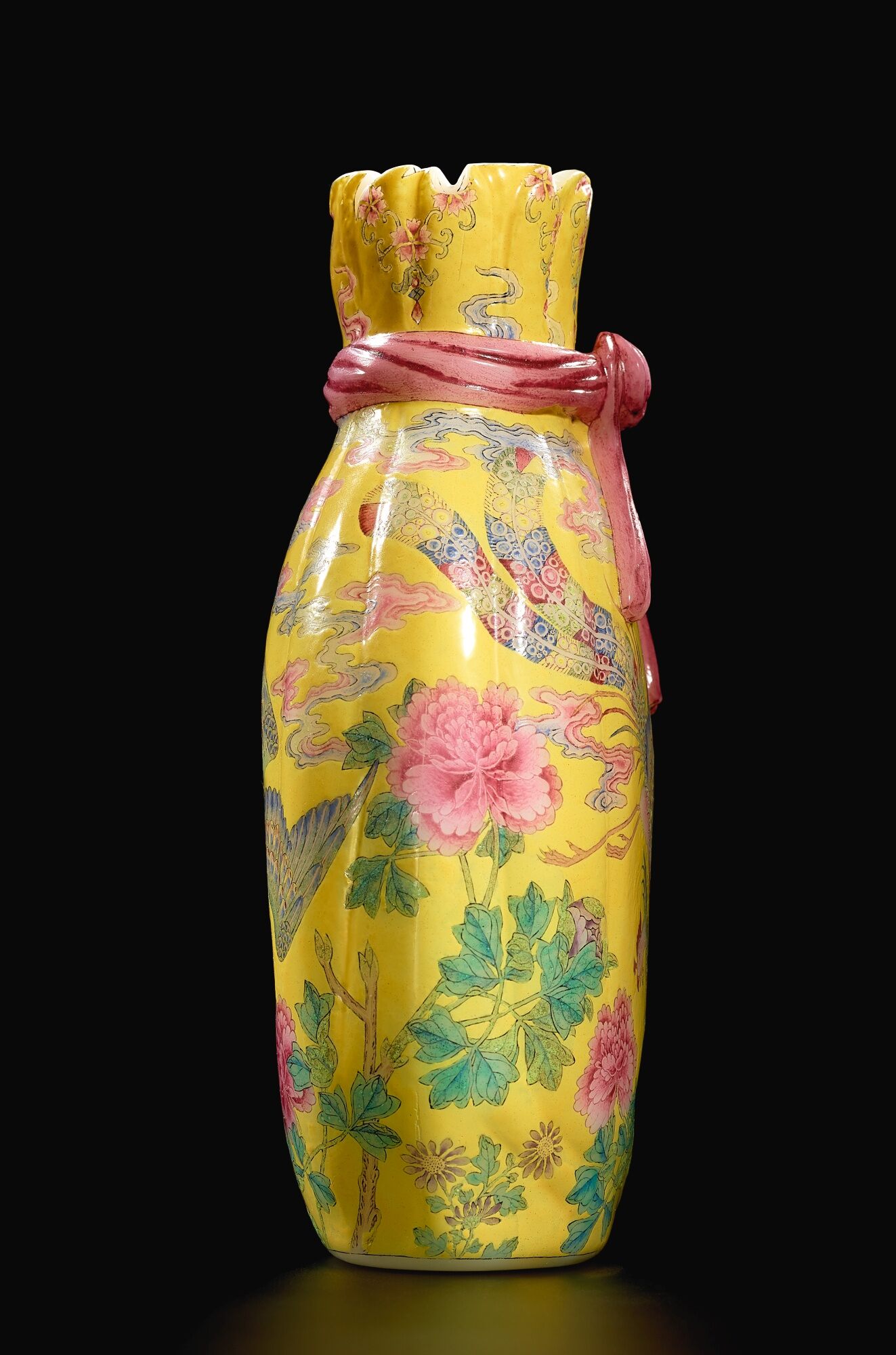
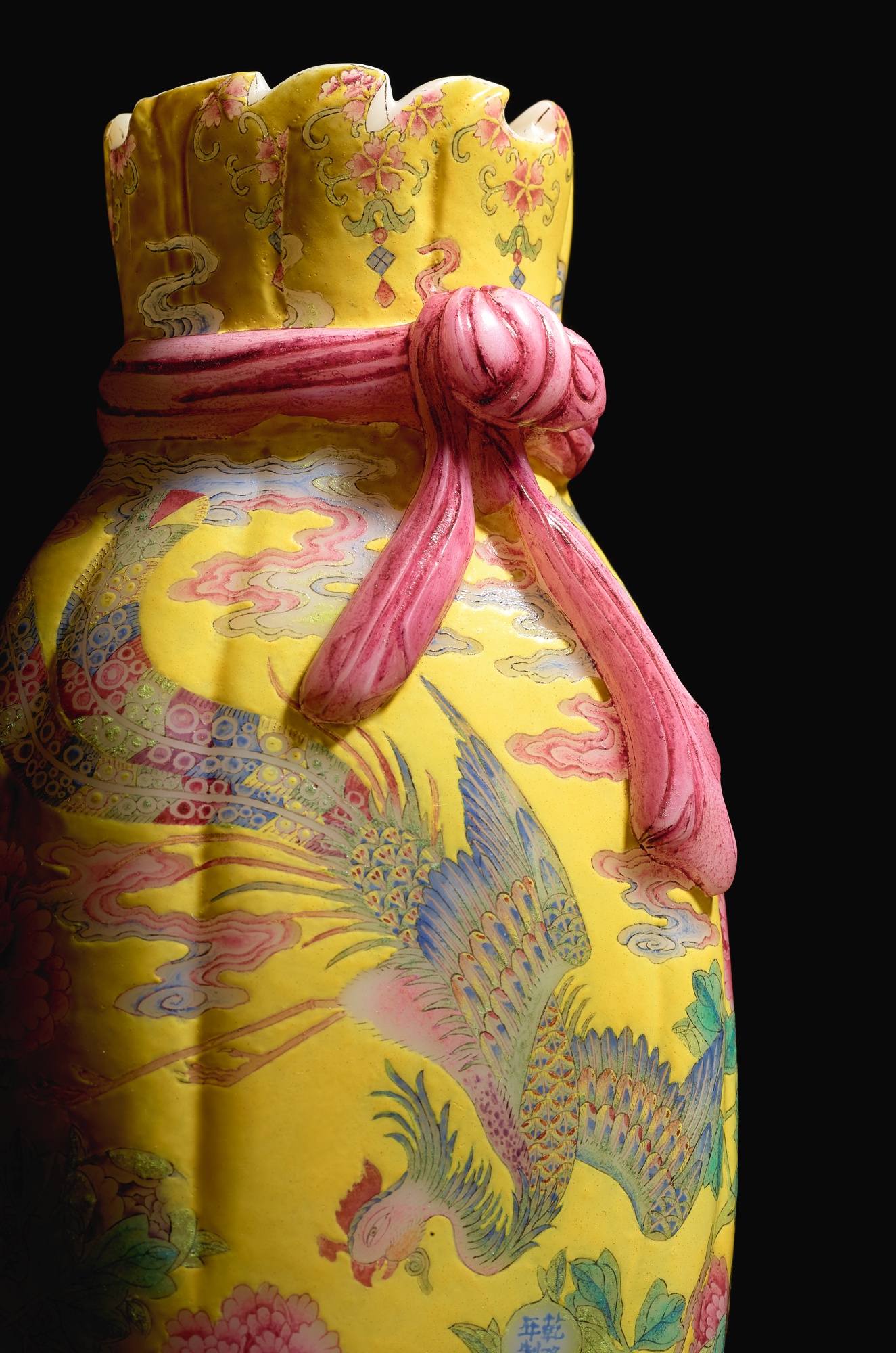
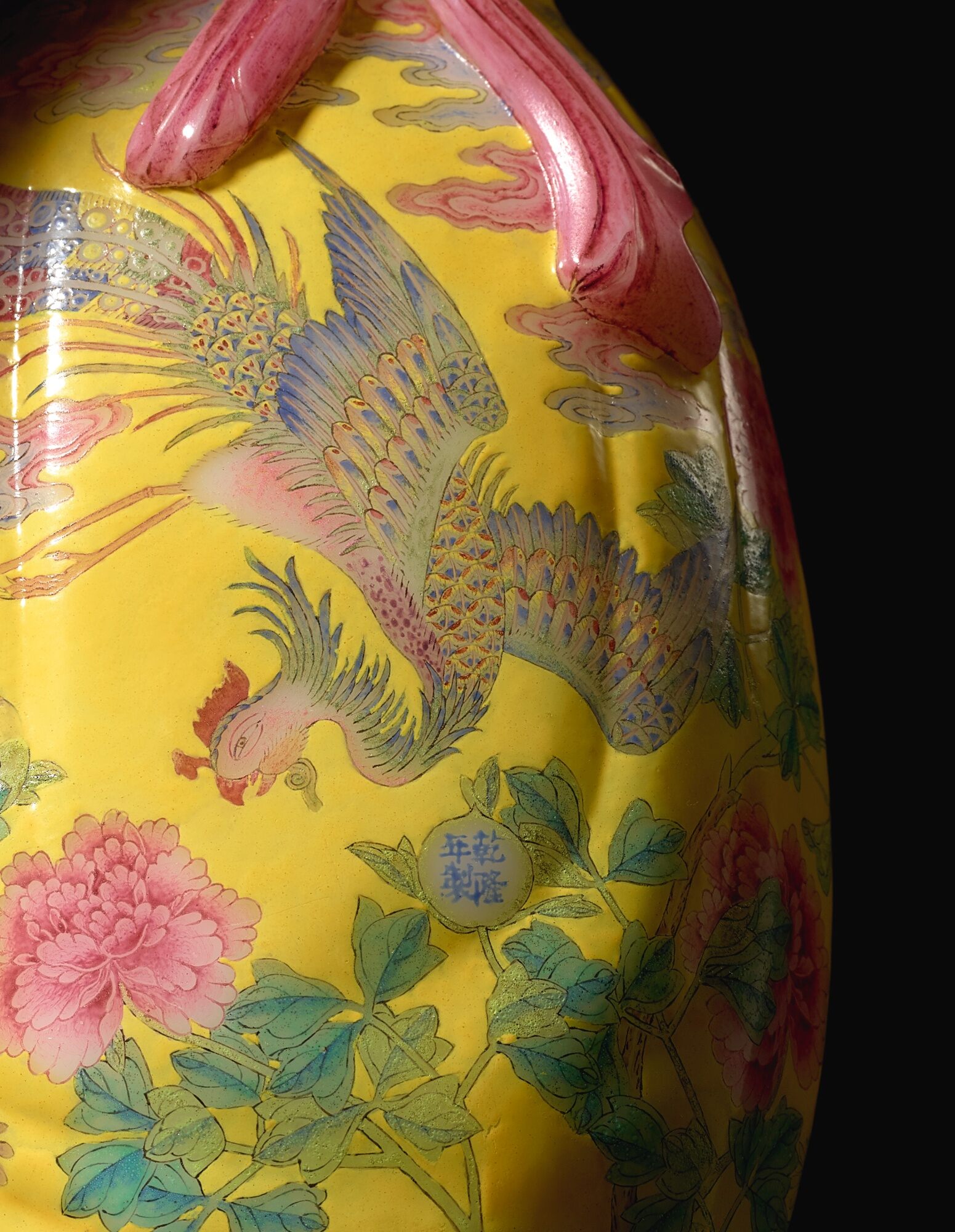
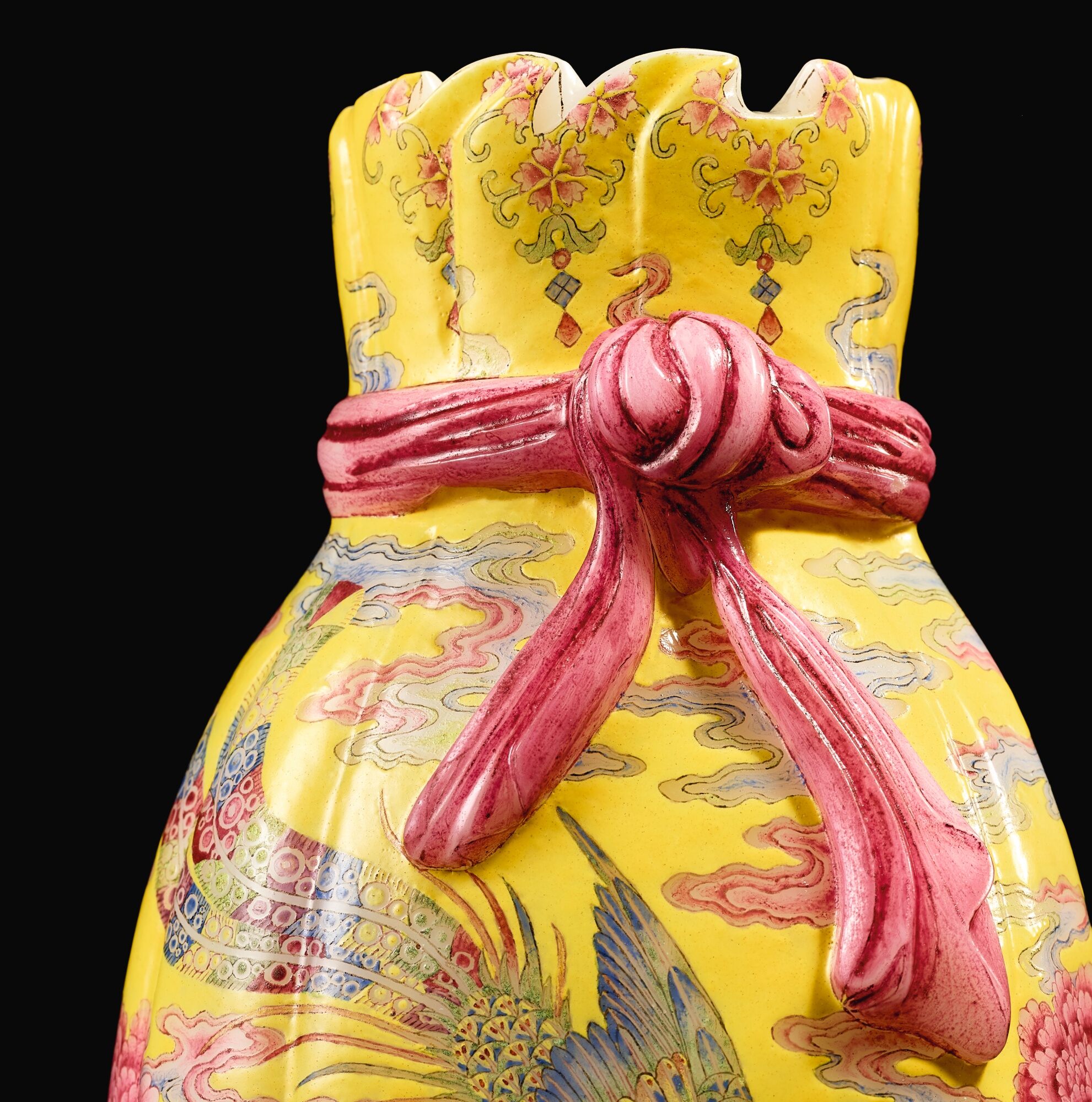
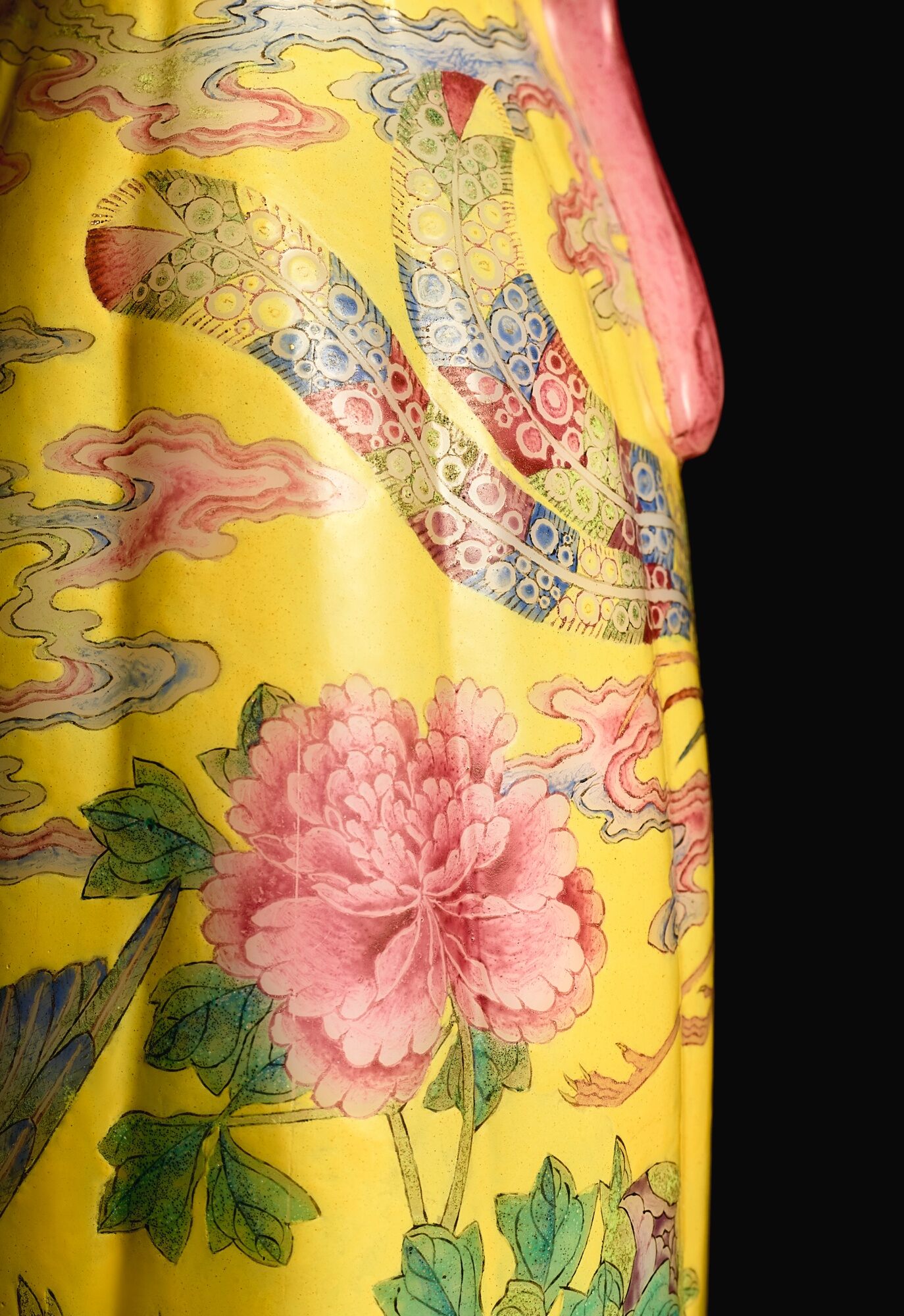
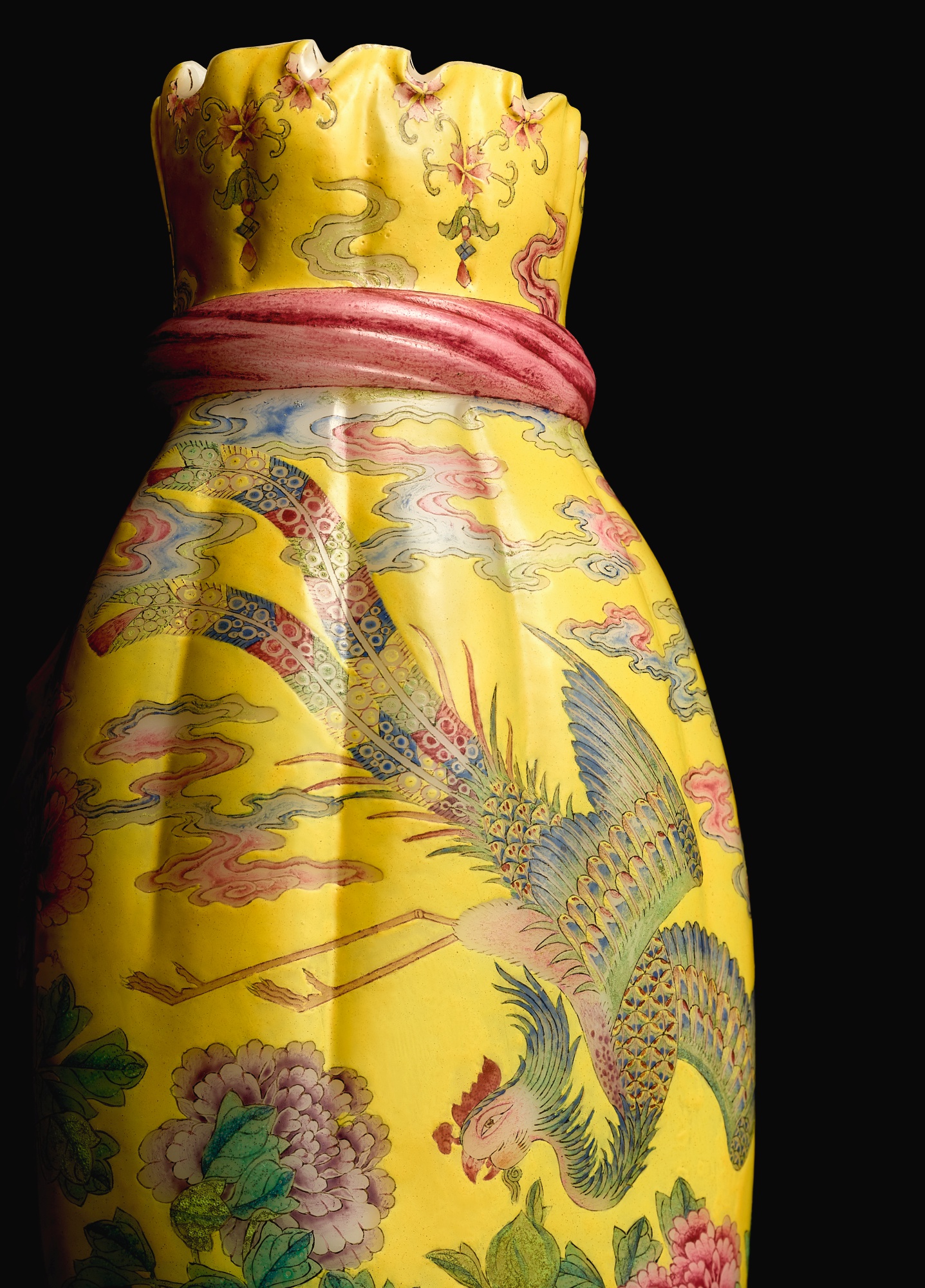
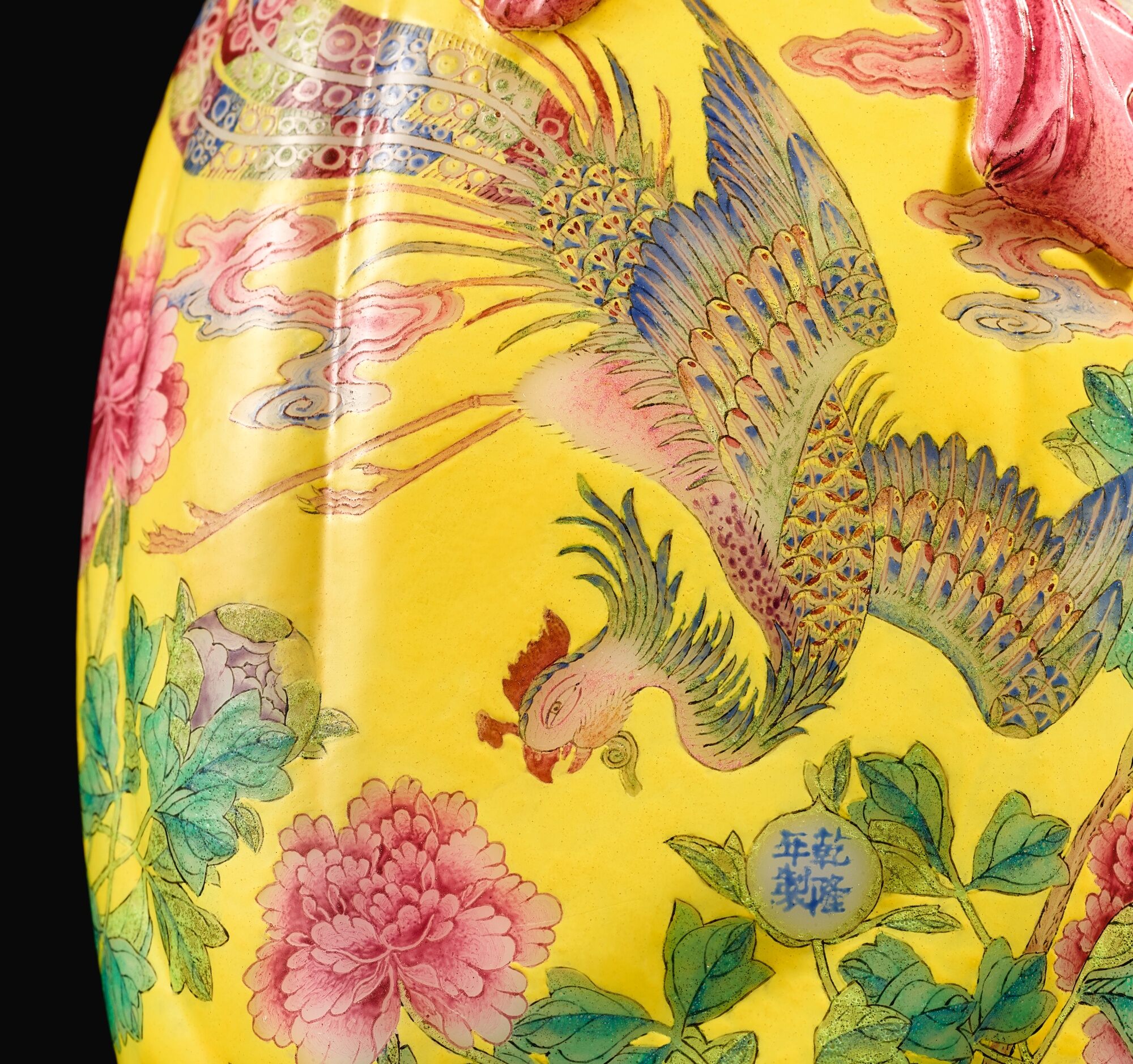
拍品詳情
清乾隆 料胎黃地畫琺瑯鳳舞牡丹包袱瓶《乾隆年製》藍料款
玻璃為胎,形採包袱,束口皺褶,凸飾紅帶繫結,豐腴飽滿。沿邊綴小花瓔珞,隨起伏曲褶而繪,摹擬錦布結集,妙不可言。巧施琺瑯彩,黃地明亮,猶如晨光和煦,祥雲中,天鳳臨,儀態雍容盈萬方。飛鳳頂紅冠,翎毛柔密輕巧,多彩繽紛,描金添飾,細膩入微。曦照下,金翅展,牡丹雛菊叢上飛,翔舞頌昇平。鞓紅魏紫中,一蕾獨含苞,內書「乾隆年製」四字款,佐證御匠神技。
18.2 公分,7 1/8 英寸
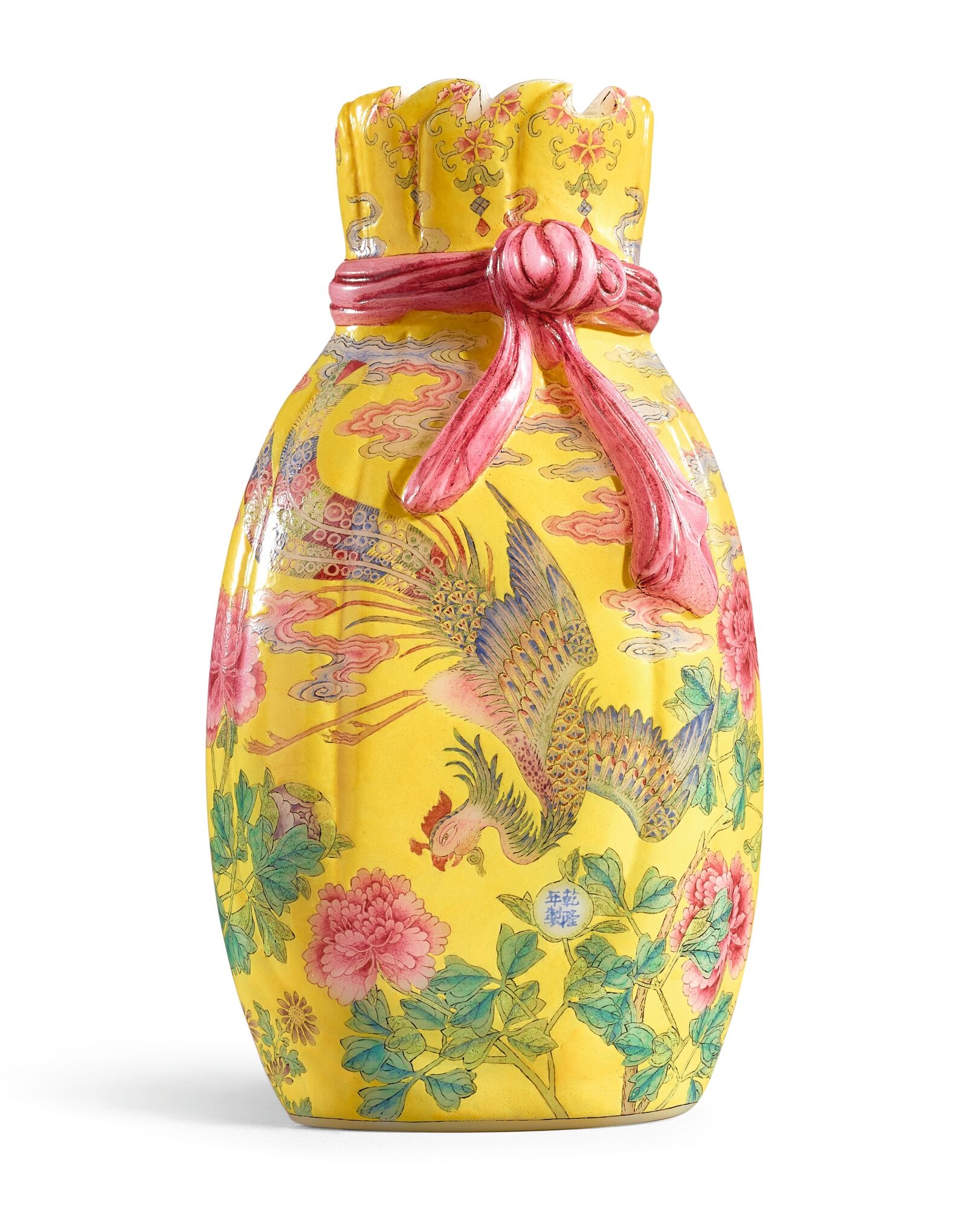
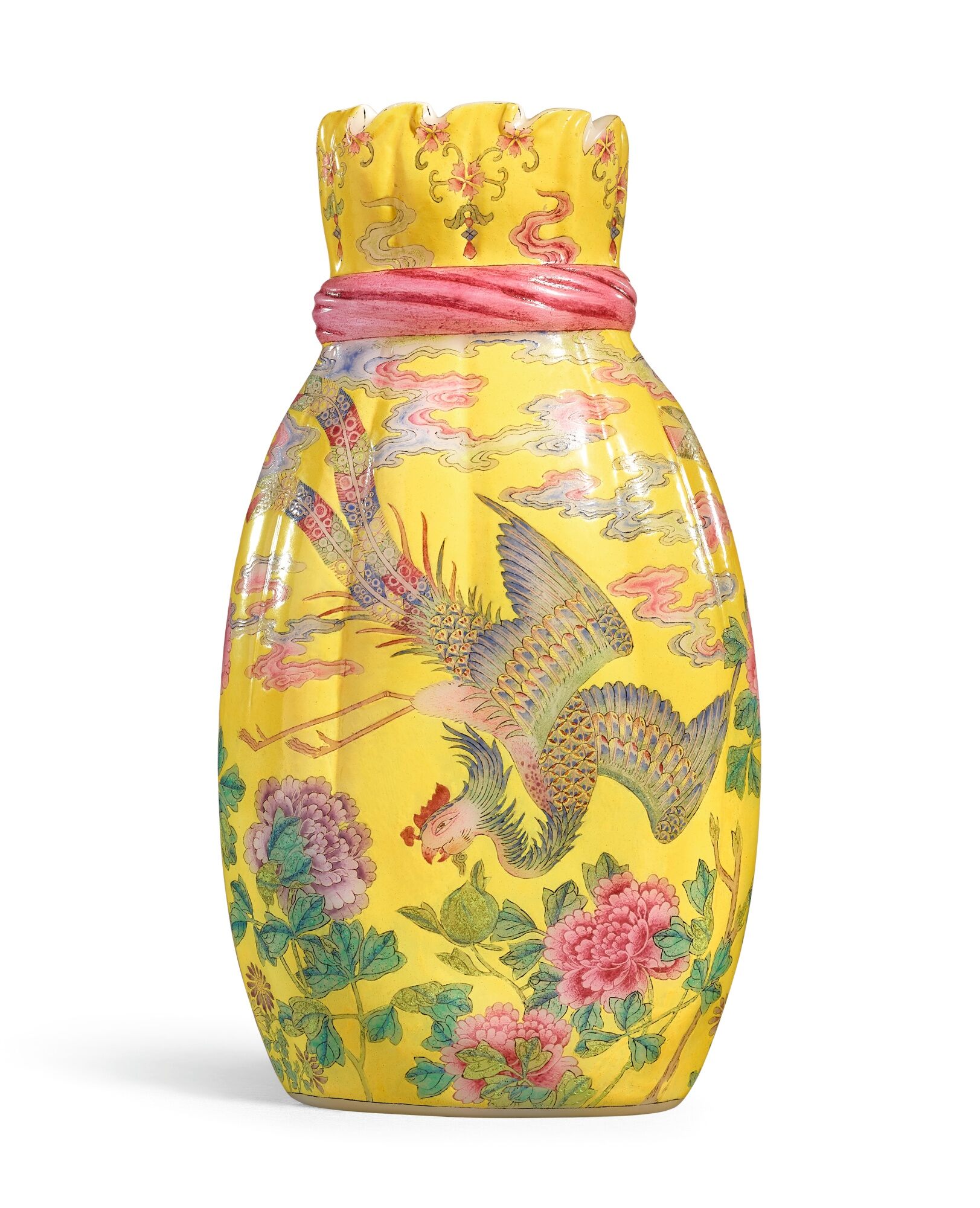
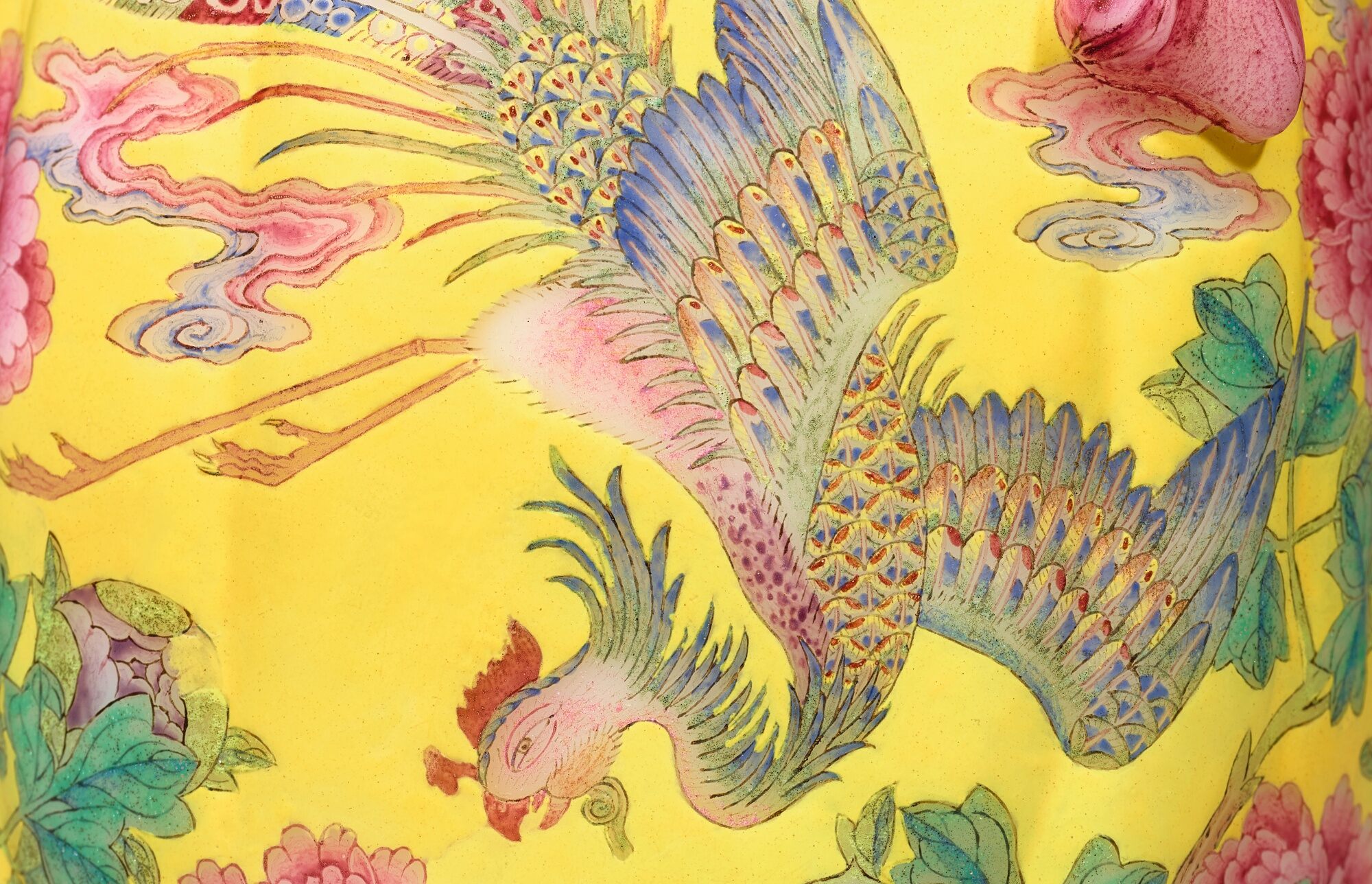
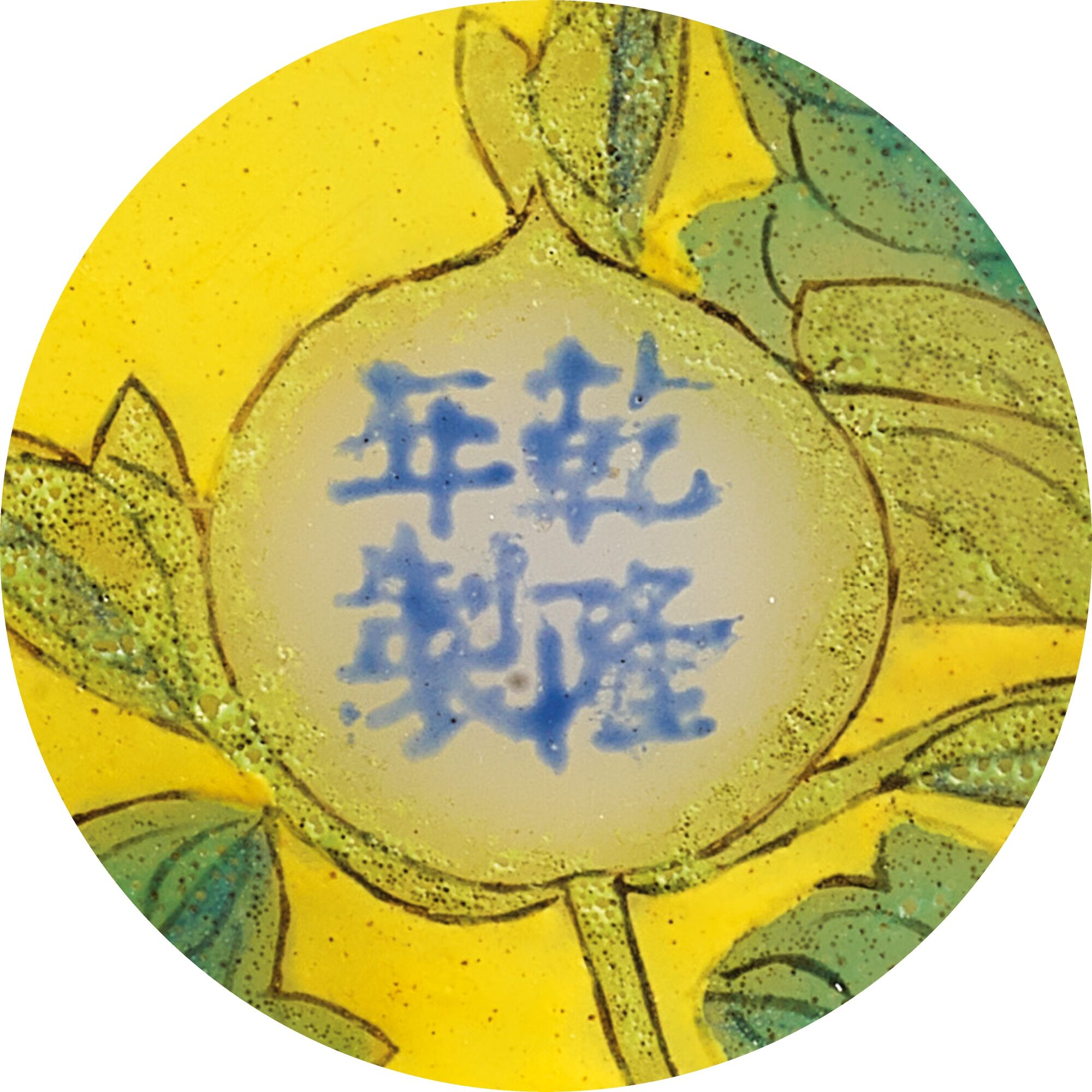
來源
傳恭親王奕訢(1833-1898年)收藏
亞伯.巴爾(1877-1959年)收藏,上海
保羅.白納德伉儷(Paul and Helen Bernat)收藏,麻薩諸塞州大波士頓地區布魯克蘭
香港蘇富比1988年11月15日,編號75
香港蘇富比2000年10月29日,編號2
展覽
《清翫雅集廿周年慶收藏展:器物》,台北,2012年,編號73
出版
《香港蘇富比二十年》,香港,1993年,圖版430
《香港蘇富比三十年》,香港,2003年,圖版439
耿寶昌,〈雅器天成——清翫雅集珍藏陶瓷器掇英〉,《清翫雅集廿周年慶收藏展:器物》,台北,2012年,頁15,編號73(局部)
錦袱珍翫博君歡
康蕊君
清宮內務府造辦處活計作,設於北京紫禁城中,得帝王直接管轄督造,所創製器物,精美絕倫,尊貴非凡,為中國藝術史之至寶。料胎黃地畫琺瑯鳳舞牡丹包袱瓶,由造辦處玻璃廠製胎,後送至琺瑯作由宮廷畫師以琺瑯彩繪製紋飾,於作坊中燒造而成,無論造形、繪畫、尺寸、製作工藝,均拔萃超群,美善卓絕,乃存世料胎畫琺瑯器中最為重要之例。本品獨一無二,惟有另一相應之器,相同器形與配色,紋飾則相異,應同時所造,遞藏歷史亦同,1980年代入藏香港藝術館(圖一)。
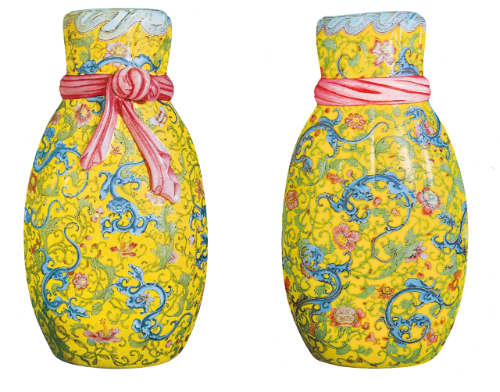
清乾隆 料胎黃地畫琺瑯龍游花卉包袱瓶 《乾隆年製》墨彩款 兩面
香港蘇富比1988年11月15日,編號77
香港藝術館藏品
乾隆三年(1738年)正月二十二日,造辦處活計檔記載上交「亮藍玻璃包袱式瓶一件」,乾隆帝傳旨著:「照樣燒玻璃胎琺瑯瓶,燒造幾件」(圖二)。與弘曆此諭吻合者,似僅只二器,即本品與香港藝術館藏例。料胎畫琺瑯器燒造,須造辦處各作坊相互合作始成,製程艱澀,困難重重,另例之畫琺瑯燒製雖不及本品完美,仍得以入宮呈上。
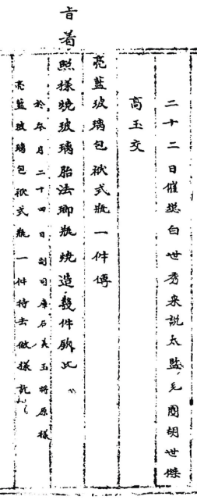
《造辦處活計檔》乾隆三年(1738年)正月二十二日
以史觀之,此二件料胎畫琺瑯瓶之歷史地位極為崇高,意義重大。康熙三十二年(1693年),設造辦處琺瑯作,玻璃廠則設立於三十五年(1696年),而最晚至四十四年(1705年)時,已能燒成玻璃胎畫琺瑯,並上交帝王。康熙晚期至乾隆中期,清宮檔案記載上交大量精美銅胎及瓷胎畫琺瑯器,其中許多仍傳承至今,然料胎畫琺瑯器卻寥寥可數。料胎者,多為鼻煙壺,再者為小型花插、筆筒,或案頭水盂等,高度多不超過11公分。簡言之,本品與香港藝術館藏例乃存世僅見大尺寸之料胎畫琺瑯器,且造形繁複勝於他例,彰顯造辦處匠人技藝高超絕倫,盛清工藝之至高巔峰。
台北及北京兩岸故宮博物院,均無類同藏品。近期,台北故宮博物院之玻璃器特展,曾展出四十五件料胎畫琺瑯器,其中三十八件為鼻煙壺(二例無蓋,稱為瓶,但尺寸、器形仍類鼻煙壺),唯兩例尺寸較大,分別為13.4公分、16.3公分,錄於張湘雯編,《若水澄華:院藏玻璃文物特展》,國立故宮博物院,台北,2017年,編號193-237。北京故宮之玻璃器藏品,據張榮所述,僅見二十例畫琺瑯器,二為小瓶,9.8公分、8.5公分,其他皆為鼻煙壺(張榮編,《光凝秋水:清宮造辦處玻璃器》,北京,2005年,頁20,編號84-93)。
造辦處檔案中關於「包袱式瓶」之製作,可參考林業強,〈乾隆朝造辦處玻璃檔案選〉,當中載錄數以百計玻璃器,僅見另外三例畫琺瑯:一件小水盂及二鼻煙壺(張榮,同上,頁44-55、74-83)。料胎畫琺瑯器如此珍稀,可溯因於製作過程之繁冗,據台北故宮圖錄所述,「在素地玻璃胎體上,以琺瑯色料圖繪紋飾,經分別施色,並依色料所需之不同燒成溫度,數次焙燒,使紋飾與胎體結合。由於玻璃熔點與琺瑯熔點接近,若溫度稍高,則胎體異於軟化變形,若溫度略低,則琺瑯呈色不佳」(張湘雯,前述出處,頁178)。
前述香港藝術館藏包袱式瓶,綴十二螭龍遊翔纏枝花卉紋間,乍看似與本品應為成對,二瓶皆以檸檬黃彩為地,乳白玻璃胎,書年款於紋飾花蕾開光內。細觀之,與鳳紋相應者應為龍紋,非螭龍,且此瓶年款以墨彩書之,落款於瓶背,異於本品之藍彩,年款書於正面。論其紋飾構圖,二瓶差異亦大,龍紋瓶為納十二螭於一器,構圖更見緊密。二器或應出自不同匠人之手(圖三)。
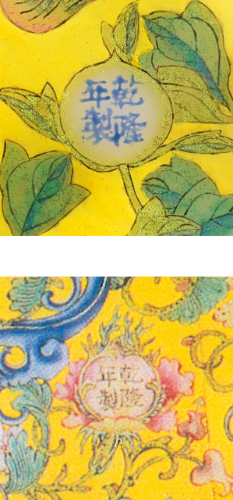
乾隆年款:拍品編號一(上)及香港藝術館藏包袱式瓶(下)
以玻璃製作包袱式瓶,過程繁複,難度極高。本品仿傚錦緞包覆橢圓形瓶身,瓶口巾褶層疊豐厚,瓶頸粉紅袱繫柔軟飄逸,整體渾然天成,自然逼真。
以織物包覆器皿,現今以日本傳統「風呂敷」最廣為人知,然舊時中國亦常見以巾帛包裹珍貴器物。如《胤禛行樂圖冊》中〈圍爐觀書頁〉,見帝王身側書架上,數軸書畫以包袱繫之;〈乘槎成仙頁〉,世宗安坐仙槎,旁置書籍,及素絹包袱珍器(《雍正:清世宗文物大展》,國立故宮博物院,台北,2009年,編號 I-58、I-76)。
摹傚以織品包裝器物的裝飾風格常見於日本漆器,尤其深得雍正青睞。世宗珍藏日本漆器中,可見數例以巾帛包覆為裝飾主題,布褶作立體浮雕,以錦繩繫之,或作風呂敷式結,或作錦囊式,以絲帶繫束(《清宮蒔繪:院藏日本漆器特展》,國立故宮博物院,台北,2002年,編號01、50、51、61、64)。清宮造辦處各作坊,皆致力於以各式媒材傚擬此類裝飾風格,如漆器(圖四)、檀香木雕(《清代宮廷包裝藝術》,故宮博物院,北京,1999年,編號64、65)。
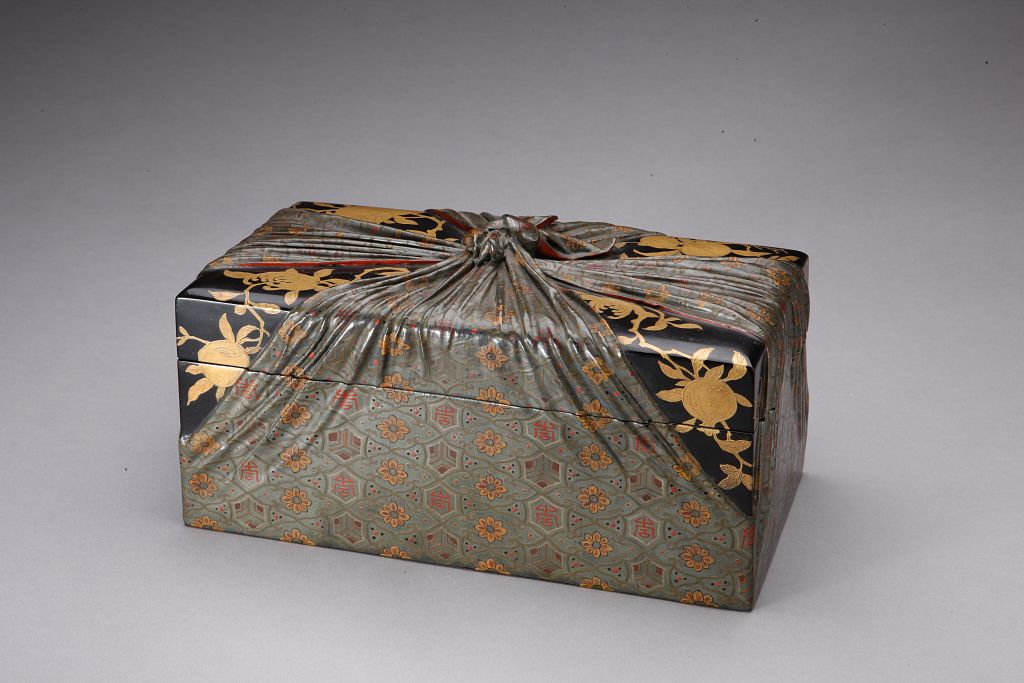
清雍正 彩漆描金包袱式盒 清宮舊藏
© 北京故宮博物院藏
造辦處琺瑯作亦創燒包袱式銅胎畫琺瑯器,例見一小型蓋罐(圖五)及一件鼻煙壺,書雍正年款(台北,2009年,前述出處,編號 II-90、II-91);另見瓷作,如巴黎吉美國立亞洲藝術博物館藏琺瑯彩瓶(Xavier Besse,《La Chine des porcelaines》,巴黎,2004年,圖版54)(圖六)。相類紋飾,同見於景德鎮御窰廠燒造御瓷,如一對粉彩粉地包袱式四繫蓋罐,2016年10月5日售於香港蘇富比,編號3611。上述作例之包袱式繫結均以平面描繪,而本品及香港藝術館藏例則以繪畫搭配浮雕展現繫結,更顯立體如真。
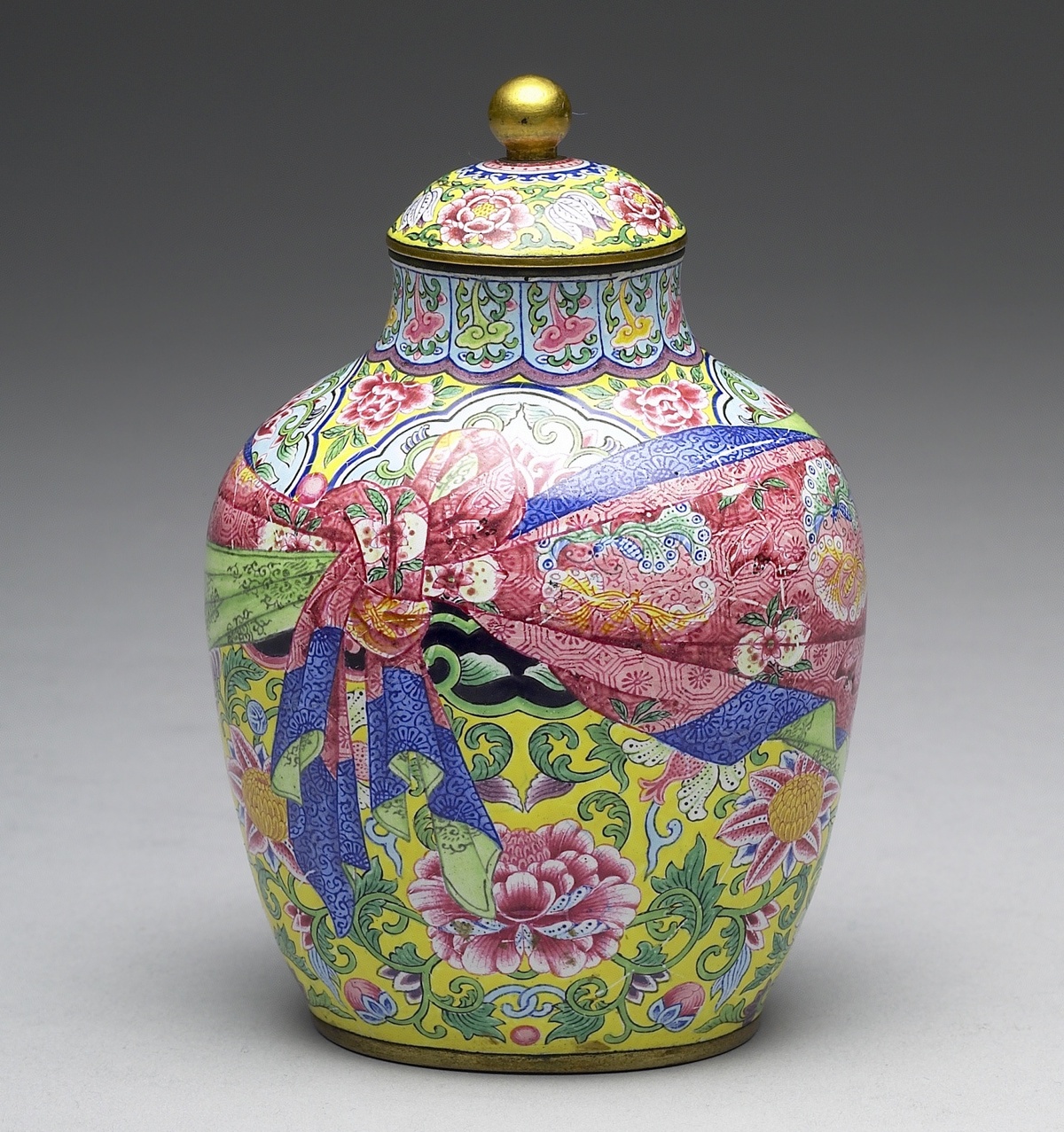
清雍正 銅胎畫琺瑯包袱式蓋罐 《雍正年製》款
圖片鳴謝台北國立故宮博物院
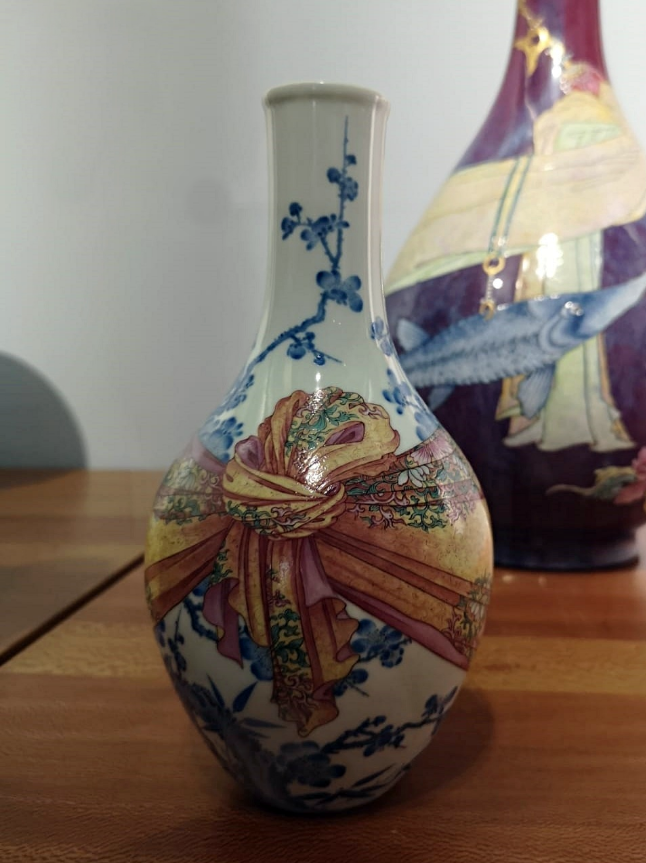
清乾隆 瓷胎畫琺瑯包袱瓶 《乾隆年製》藍料款 巴黎吉美國立亞洲藝術博物館藏品
攝影 © RMN-Grand Palais (MNAAG, Paris) / Thierry Ollivier
瓶身鳳舞牡丹紋,鳳羽設色繽紛,豐潤耀眼,更以描金細綴,光彩輝映。如此融合多彩之複雜技法,應始於郎世寧(1688-1766年)筆下鳥禽繪畫,後得多位西洋傳教士宮廷畫師運用。然以紋飾、風格觀之,本品應純屬中式。玻璃廠、琺瑯作均以西洋匠師為首,雍正帝曾評其所製之器雖好,卻流於洋風。
牡丹紋以粉紅、藕荷二色為主,柔美富麗,得自清初六大家之一惲壽平(1633-1690年)所創花卉畫派。綜上紋飾之琳瑯設色、檸檬黃彩地,皆為數十載前,西洋傳教士傳入宮廷方得。
書乾隆年款於牡丹花苞,彷若花開自得,似範製年款於葫蘆瓜身之匏藝,僅現於此二件料胎包袱瓶。雍正朝銅胎畫琺瑯器,則可見相類年款,書於器底之仙果或其他造形開光內,或如一件料胎畫琺瑯鼻煙壺,底部繪靈芝形開光,內書年款(台北,2009年,前述出處,編號 II-23)。此亦近類題字落款於繪畫瓜果或珍物之中,如乾隆三年書畫冊頁,與包袱瓶同年所作(台北,2009年,前述出處,編號 II-101)。
內頁亦見書詩文於方箋,綴折枝花卉,一如此包袱瓶身側所繪紫菀花叢(同上)。此類紋飾,用於填補畫面中主要紋飾外之空間,並符合題材的自然意趣,亦是西洋畫師傳入技法,可參考郎世寧所作駿犬圖(《郎世寧作品專輯》,台北,1983年,圖版022-031)。
鳳舞牡丹包袱瓶,美善無瑕,明豔動人,乃紫禁城內各作坊匠師通力而成之結晶。造於乾隆初年,仍帶有雍朝遺風,如彩地,源自銅胎畫琺瑯,雍正一朝應用於瓷上,乾窰則甚少類例。此紋飾設計,不僅華美奪目,且寓意祥瑞。耿寶昌述「包袱」音同「包福」(前述出處,頁15)。鳳舞牡丹紋,祝意富貴吉祥,彩雲漫天,難能可貴,更是盛世吉兆。
鳳紋包袱瓶與相對應之螭龍紋瓶,專為乾隆帝而造,深藏宮闈直至晚清,傳予恭親王奕訢(1833-1898年,圖七),道光皇帝六子,亦是咸豐皇帝之異母弟。道光三十年,封為恭親王,為愛新覺羅氏二位王儲之一。咸豐二年(1850年),賜恭親王府,此處曾屬乾隆權相和珅府邸,後為郡王府。1860年,咸豐帝任命奕訢為欽差大臣,負責與英、法、俄之談判,並簽訂條約。帝王宮眷至熱河避難時,奕訢掌握軍政大權,設總理衙門,主管國際事務。同治帝五歲即位,奕訢任議政王大臣,與東、西皇太后共治天下。同治十一年(1872年),受封「鐵帽子親王」,爵位世襲罔替。奕訢之政治影響力甚為深遠,延續至光緒一朝(1875-1908年)。
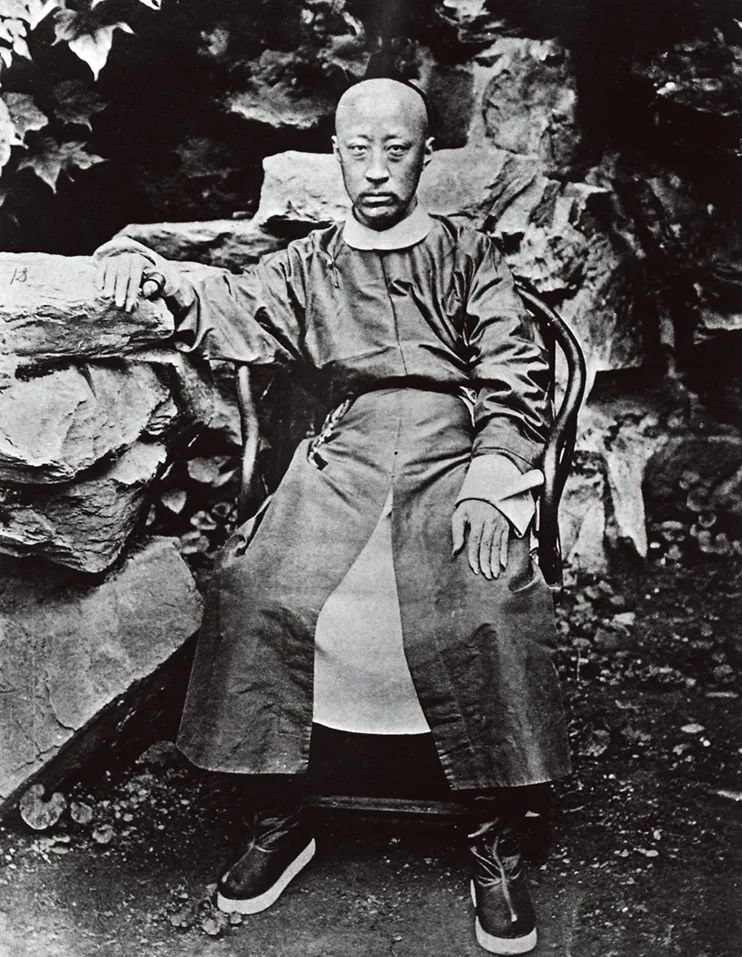
恭親王奕訢(1833-1898年)
© 倫敦英國國家肖像館
亞伯.巴爾(1877-1959年,又名巴爾祿,圖八),中德混血,生於中國,長住上海直至1910年,從商任職皇家亞洲學會北中國支會秘書。1905年,開始投入中國藝術收藏,其後成為骨董商,於滿清末年,蒐羅甚多皇族舊藏藝術品。1908年,巴爾於上海舉辦展覽會,展出超過三千件中國瓷器與工藝品,1911年出版展覽圖錄。巴爾骨董收藏曾於1922年紐約 American Art Galleries 曾舉辦大型拍賣會;1926年,紐約 Anderson Galleries 亦舉行另一場拍賣會,之後續辦數場。巴氏曾借展多幅繪畫,展於倫敦皇家藝術學院1935-6年中國藝術大展。巴爾收藏中國書畫及藝術品,經由捐贈或買賣,已入藏許多知名博物館,如紐約大都會藝術博物館、芝加哥菲爾德自然史博物館、華盛頓弗利爾美術館、倫敦大英博物館。
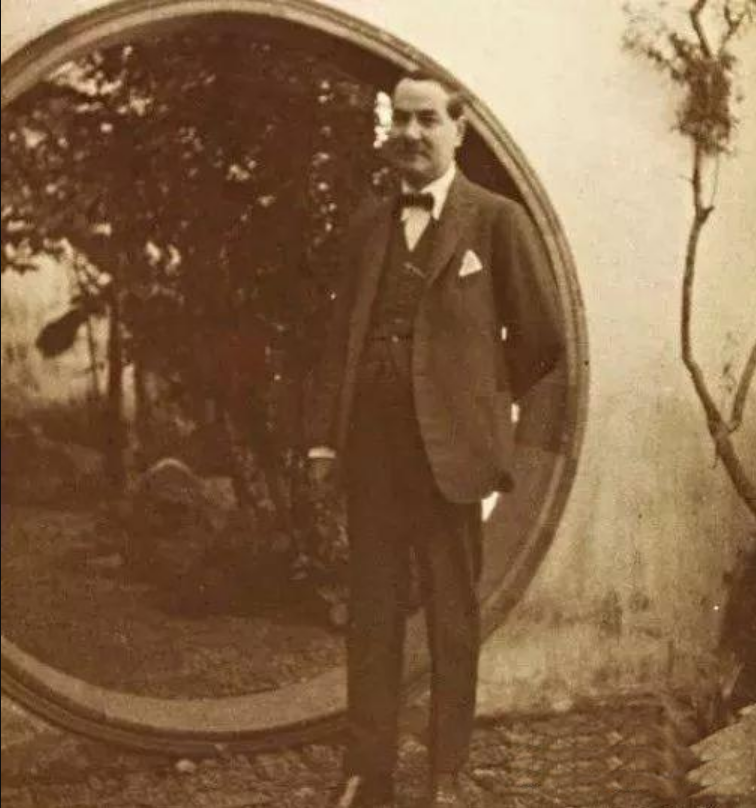
亞伯.巴爾(1877-1959年)
© 華盛頓史密森尼弗利爾及賽克勒美術館檔案部藏 A.W. Bahr Papers(亞伯.巴爾檔案,編號 FSA_A2001.14) 2001年11月12日 Penelope Jane Bahr 惠贈
保羅.白納德(1902-1987年,圖九)為織品製造商,與妻海倫居住於波士頓地區,其兄尤金收藏早期與明代瓷器,保羅則專注於建構其清代御瓷珍藏,藏品包括數件琺瑯彩瓷,與本品及螭龍紋包袱瓶,均造於清宮造辦處琺瑯作,師出同源。白納德伉儷捐贈許多藏品予波士頓美術館,保羅離世後,其珍藏多數,包含二件包袱瓶,於香港蘇富比售出。
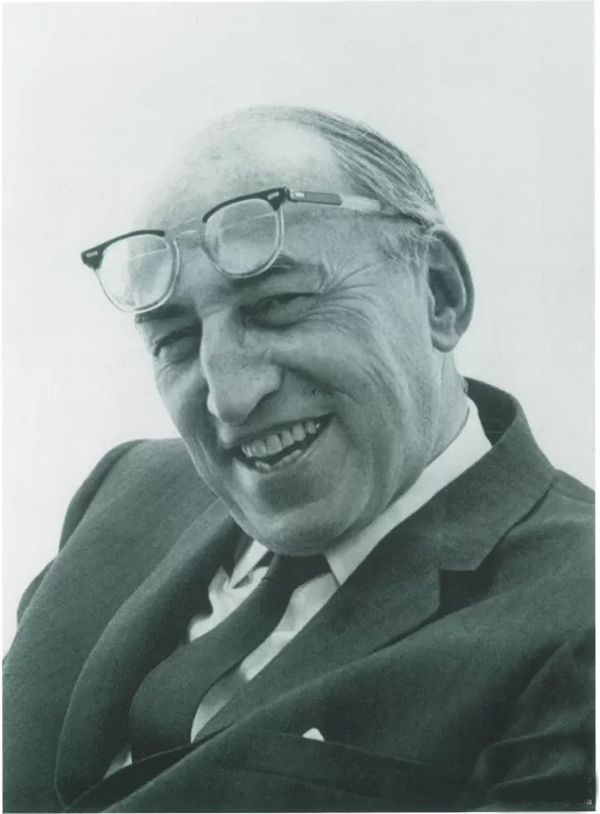
保羅.白納德(1902-1987年)
香港藝術館藏螭龍紋包袱瓶,與本品同為恭親王奕訢、巴爾、白納德伉儷遞藏,1988年11月15日售於香港蘇富比,編號77,屢錄於文獻,如莫士撝,《御製》,1976年,圖版41。
______________
有鳳來儀
乾隆款玻璃胎畫琺瑯鳳舞牡丹袱繫瓶
兼論清代御製康雍乾玻璃胎畫琺瑯器
張榮
寫於紫禁城壽安宮
琺瑯,是外來語的音譯詞,其基本成分為石英、長石、硼砂和氟化物,與陶瓷、琉璃、玻璃同屬矽酸鹽類。琺瑯器是以琺瑯為材料製成的器物,依據其加工工藝的不同,琺瑯器分為掐絲琺瑯、鏨胎琺瑯、內填琺瑯、畫琺瑯和透明琺瑯五大類別。其中畫琺瑯在清代康熙年間出現,宮廷造辦處、廣東和北京均有製作。畫琺瑯有金、銀、銅、紫砂、瓷和玻璃六種胎質。在博物館內,畫琺瑯是專門指銅胎,而銀胎稱為銀燒藍,瓷胎、玻璃胎稱為琺瑯彩。在清宮檔案中畫琺瑯分為金胎畫琺瑯、銀琺瑯、銅胎畫琺瑯、宜興胎畫琺瑯、瓷胎畫琺瑯和玻璃胎畫琺瑯。本文專門探討和論述玻璃胎畫琺瑯,鼻煙壺不包括在內。
清代造辦處是製造皇家御用品的專門機構。康熙年間建於養心殿,又名養心殿造辦處。康熙三十五年(1696年)玻璃廠成立。1 中國第一歷史檔案館藏《造辦處各作成做活計清檔》(以下簡稱《清檔》),如實記錄了各類宮廷製品的名稱、來源、時間、規格、用料、開銷、工序、去處以及皇帝的旨意,為清代工藝製作研究和文物鑑別提供了最直接可靠的依據。《清檔》始於雍正元年(1723年),迄於宣統三年(1911年)。玻璃胎畫琺瑯是造辦處玻璃廠與琺瑯作共同參與完成的新「玩意」。通過查閱檔案、研究實物得知,宮廷玻璃胎畫琺瑯僅在康熙雍正乾隆三朝燒造。
康雍乾三朝玻璃胎畫琺瑯,基本收藏在境內外博物館和私人機構,據不完全統計,北京故宮二件、台北故宮七件、大維德基金會九件(現大英博物館95號展廳展出)、香港藝術館一件、美國康寧玻璃博物館二件、荷蘭海牙博物館一件、香港李先生一件。某拍賣行曾拍賣兩件乾隆玻璃胎畫琺瑯筆筒。
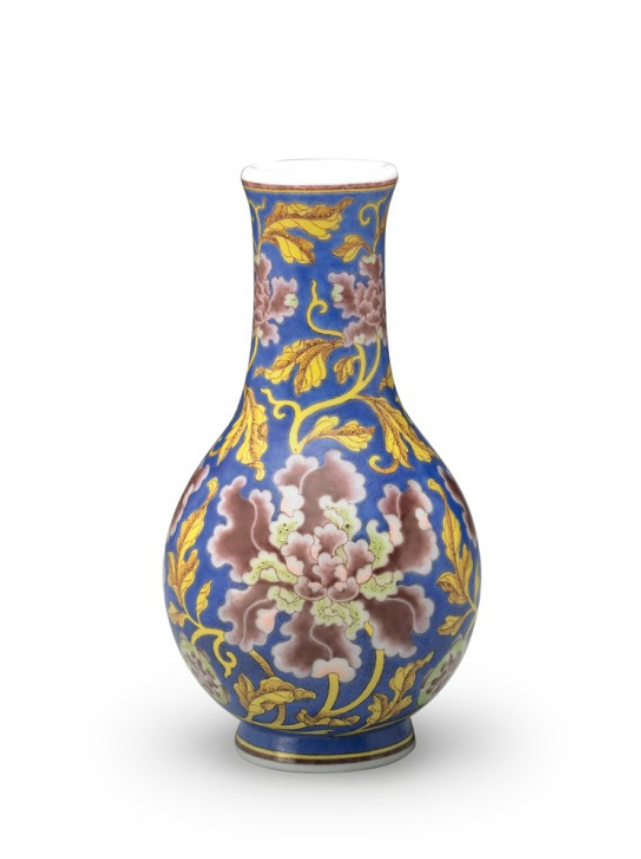
清康熙 玻璃胎畫琺瑯藍地牡丹膽瓶 清宮舊藏
圖片鳴謝:台北故宮博物院
康熙朝玻璃胎畫琺瑯,經過多年搜集與調研,目前所知傳世作品僅有三件,一是台北故宮收藏的玻璃胎畫琺瑯藍地牡丹膽瓶(圖十),高12.7公分。2 二是荷蘭海牙博物館收藏的康熙御製款玻璃胎畫琺瑯黃地牡丹花盒(圖十一),3 三是香港李景勳先生收藏的康熙御製款玻璃胎畫琺瑯開光四季花卉紋盃(圖十二)。4 故宮博物院圖書館收藏《琺瑯玻璃宜興瓷胎陳設檔案——道光十五年七月十一日立》(圖十三)記錄,「康熙款玻璃胎琺瑯牡丹藍地膽瓶一件。」5 此為唯一一件陳設檔記錄的康熙玻璃胎畫琺瑯。膽瓶裝在楠木盒內,盒為上下插蓋式,高16.5公分。蓋面陰刻填藍楷書「康熙年製玻璃胎畫琺瑯牡丹藍地膽瓶一件」,此楠木匣為清高宗弘曆下旨配製盛裝。匣蓋上的名稱為當時定名,雖無款識,乾隆弘曆鑑定它是康熙朝器物。玻璃胎畫琺瑯是康熙朝首創的新工藝品,康熙皇帝不僅自己把玩,也賞給外官內臣,以示恩寵和炫耀。康熙四十五年(1706年)賞賜羅馬教皇特使一件「畫琺瑯玻璃瓶」。6 康熙五十五年(1716年)將「御製琺瑯五彩紅玻璃鼻煙壺」賞賜給廣西巡撫陳元龍。7 從這完整的三件器物可以看出,康熙朝玻璃胎畫琺瑯的燒造技術已經成熟,且造型、紋樣、款識具有康熙朝文物的特徵。
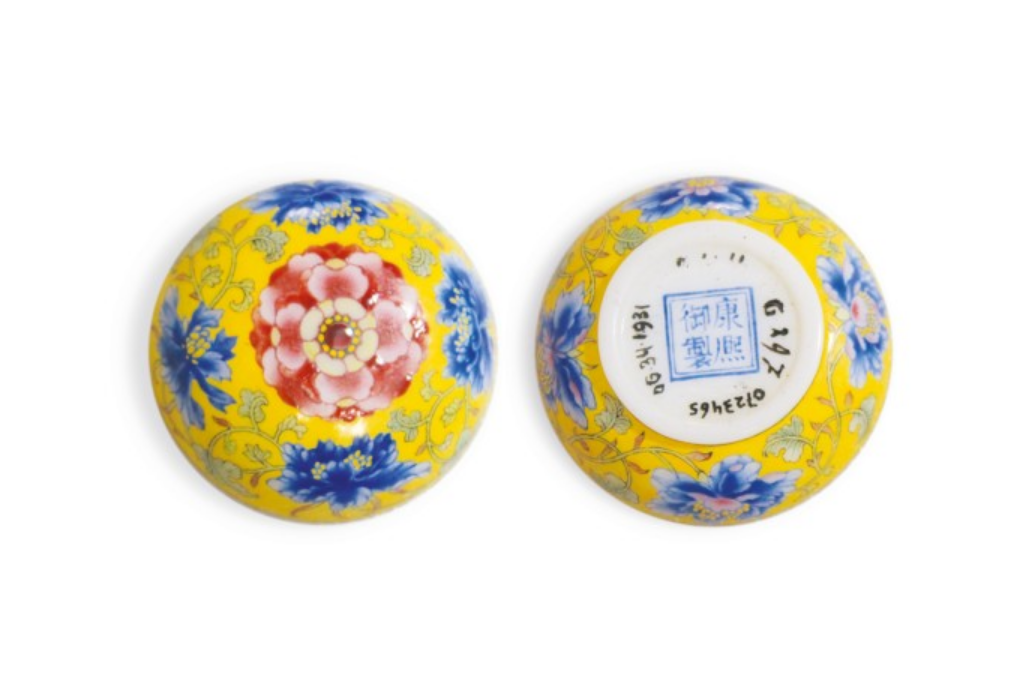
清康熙 御製款玻璃胎畫琺瑯黃地牡丹花盒 《康熙御製》款
荷蘭海牙博物館藏
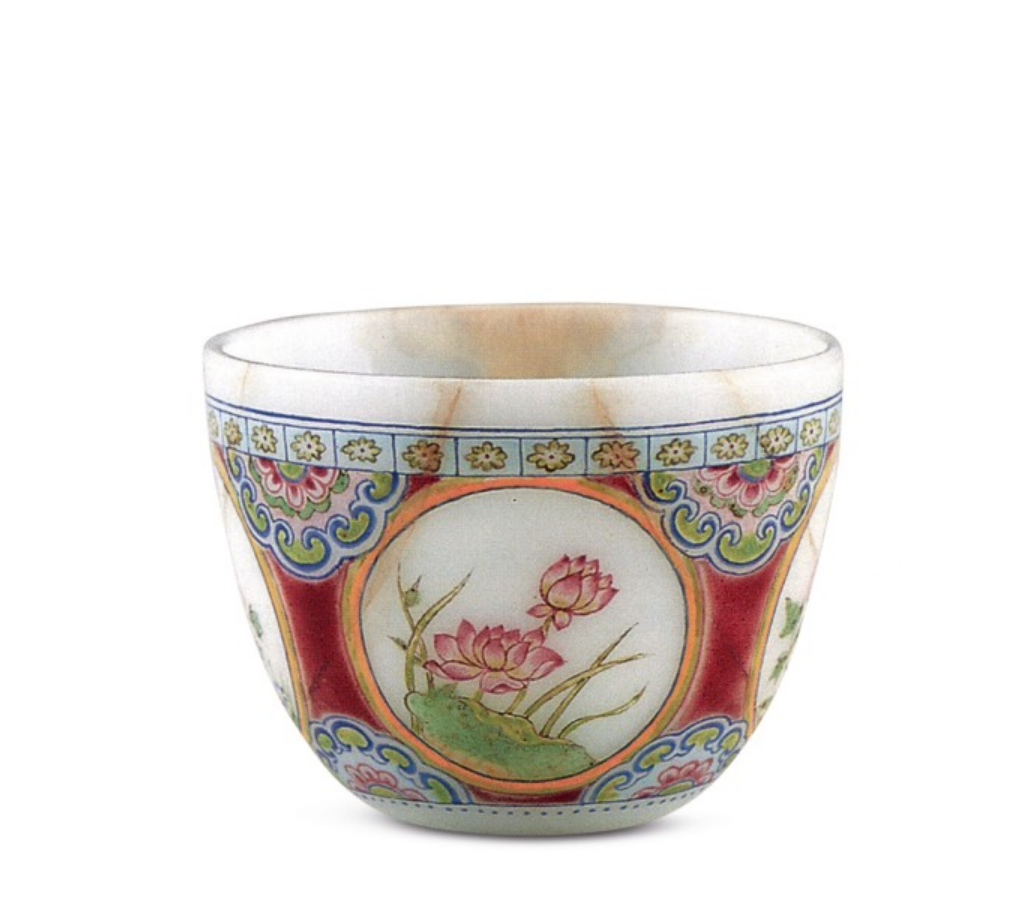
清康熙 玻璃胎畫琺瑯開光四季花卉紋盃 《康熙御製》款
李景勳先生收藏,香港
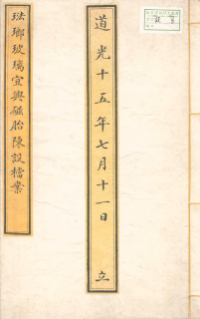
道光十五年七月十一日《琺瑯玻璃宜興瓷胎陳設檔案》
北京故宮博物院圖書館藏
雍正朝玻璃胎畫琺瑯存世品,僅見台北故宮收藏的雍正年製款玻璃胎畫琺瑯竹節式鼻煙壺(圖十四)。《清檔》記載,「雍正六年,雜活作,二月十五日做得玻璃胎琺瑯節節雙喜鼻煙壺一件。」除此之外,見於雍正朝造辦處活計檔記錄的玻璃胎畫琺瑯僅有五件,遺憾的是未見到實物。8
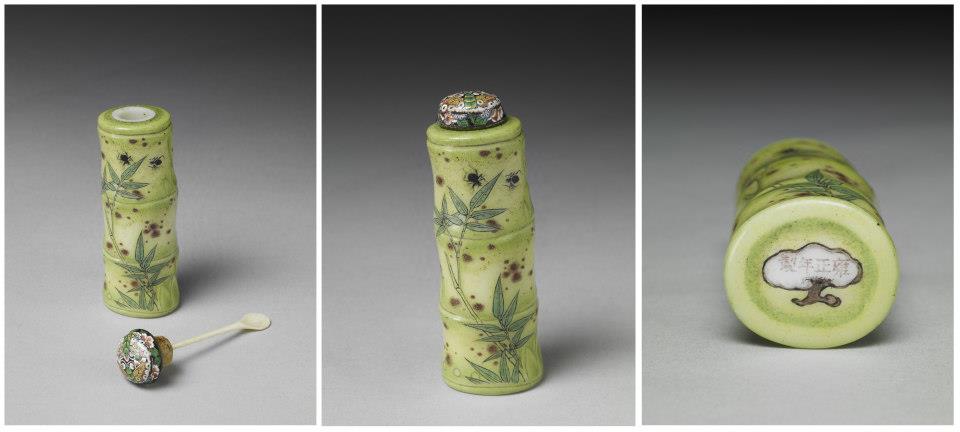
清雍正 玻璃胎畫琺瑯竹節式鼻煙壺 《雍正年製》款 清宮舊藏
圖片鳴謝:台北故宮博物院
如「雍正二年,琺瑯作,二月初四日怡親王交呆黃玻璃瓶一件,奉旨,此樣甚好,嗣後燒琺瑯瓶玻璃等俱照此樣燒些欽此。」9
「雍正三年,琺瑯作,九月初十日,海望交玻璃琺瑯雞鼓水注一件,隨象牙嵌紅座,郎中海望呈進。」10
「雍正五年,十二月二十二日郎中海望傳做(入琺瑯作)雨過天晴玻璃畫泥金番花包袱式花插一件。記此。」11
「雍正七年,四月十七日據圓明園來帖內稱(入琺瑯作),夲月初三日郎中海望持出呆白玻璃半地瓶一件。傳旨,此玻璃瓶顏色甚好,底子不要渾楞砣平,其瓶身上畫琺瑯緑竹,寫黑琺瑯字,酌量落款,章法畫樣呈覧過燒造。再著玻璃作照此樣瓶燒些。照此瓶顏色用別樣好款式的亦燒些,上面或畫綠竹或畫紅花或如何落款之處酌量配合燒造。欽此。」12
「雍正十三年,養心殿造辦處收儲清冊,玻璃燒琺瑯盌一件。」13
乾隆朝玻璃胎畫琺瑯,從《清檔》記錄看,比雍正朝製作的數量多,保存至今的實物比康熙雍正朝稍多。道光十五年陳設檔記錄的三件玻璃胎畫琺瑯,均在台北故宮收藏。除此之外,台北故宮還有兩件重要收藏,即玻璃胎畫琺瑯五福捧壽八棱瓶和西洋仕女圖渣斗。14 大維德基金會重要的作品是,玻璃胎畫琺瑯盃兩件,人物圖筆筒一件,牧羊女圖小罐一件等。15 美國康寧玻璃博物館收藏兩件詩句花卉紋瓶。
玻璃胎畫琺瑯之所以珍貴,傳世量少,是與它高難度的製作工藝分不開。在六個材質的畫琺瑯器中,玻璃胎是難度最大的。一個當代製作玻璃胎畫琺瑯鼻煙壺的演出者告訴我,「琺瑯彩的燒製溫度一般在八百五十度左右,這時候壺體與琺瑯顏色均已接近熔點,只有這樣才能夠讓壺體與顏色更好地結合,但是此時溫度的掌控也是很難的,溫度稍低,顏色不能完全融化,達不到理想的效果,溫度稍高,壺體就會因為承受不住而變形,那麼,前面所有的工作就前功盡棄了,而這樣的高溫燒製要經歷不少於五次,每一次都是一種考驗,燒製過程中還要在上面皴染出顏色的變化來,這就如同工筆劃中的皴染,每皴染一次, 就要進行燒製一次,通過層層皴染,一件完美的小藝術品就誕生了,猶如一個可愛的小精靈,滿載著作者的期望呈現在眾人面前。」之所以燒製四到五次,是因為每一個顏色琺瑯的呈色溫度不同,要從高溫開始,到低溫結束。當時焙燒的燃料是木炭,又沒有儀器測量溫度,完全憑工匠日積月累的經驗,故玻璃胎畫琺瑯以小件的鼻煙壺為主,而立體的器物,難度更大,故傳世品甚少。《清檔》中也有燒造失敗的記錄。
本文隆重介紹的玻璃胎畫琺瑯鳳舞牡丹袱繫瓶,高18.2公分。瓶體呈包袱狀,口邊為規律美觀的褶皺紋,實際上是工匠按照包袱做成瓶的式樣。頸部裝飾粉紅色立體袱繫紋。通體在不透明乳白色玻璃上先燒一遍黃色琺瑯,瓶體畫兩條俯身下飛的鳳,鸚鵡嘴,丹鳳眼,細頸,振翅,羽毛狀的尾部向著天空方向飛舞,兩支細長的腿甩向左前方。鳳的下方為盛開的牡丹花和一枝雛菊,鳳的上方為彩色流雲,天女散花般的鳳尾在雲中飛舞,鳳的身上還運用了描金工藝。在綠色樹枝處做桃心形開光,內書藍色琺瑯「乾隆年製」。瓶底為溫潤的乳白色玻璃。整個花紋使用深淺不一的綠色、紅色、藕荷色、藍色繪製而成,再加上富貴的黃色,格外亮麗奪目。無獨有偶,香港藝術博物館收藏一件與此幾乎一模一樣的包袱瓶(頁26,圖一),瓶的造型、黃顏色的地色,特別是署款方式都一樣,只是紋樣不同,裝飾螭龍紋和花卉。這是一對同時製作的精品,也是目前所見尺寸最大的瓶。僅瓶的成型也有一定的難度,瓶身具有楞狀,需要有模吹製,而瓶口的褶皺,則需要工匠手快、眼快,技術好,因玻璃在瞬間就凝固了,至少在成型時需要反復幾次,才能製作出漂亮美觀的器形。
《清檔》記錄,「雍正五年,十二月二十二日郎中海望傳做(入琺瑯作)雨過天晴玻璃畫泥金番花包袱式花插一件記此。」16
「乾隆三年,玻璃作,元月二十二日催總白世秀來説太監毛團胡世傑髙玉交,亮藍玻璃包袱式瓶一件,傳旨,著照樣燒玻璃胎法瑯瓶燒造幾件。欽此。於本月二十四日副司庫石美玉將原樣亮藍玻璃包袱式瓶一件持去做樣訖。」17
「乾隆五年,記事錄,三月初三日栢唐阿盛德來説太監魏珠催總鄧八格奉旨,著玻璃厰人進六所燒造玻璃小式活計欽此。於本年五月初二日首領吳書將玻璃琺瑯花插一對,玻璃燒琺瑯桃式水盛二件,玻璃燒琺瑯葫蘆一件持進交太監高玉呈進訖。」18
這是筆者在《清檔》中搜集到的與這件琺瑯瓶相關的資料。透過寥寥幾句的描述,我們不難看出,雍正五年(1727年)便開始製作玻璃畫泥金包袱式花插,雨過天晴是指仿柴窰瓷器的顏色,檔案中屢有記載。乾隆三年(1737年)檔案的記錄,沒有明確具體燒造幾件,也沒有是否燒造成功的記錄。而乾隆五年(1739年)明確說明燒造成功「玻璃琺瑯花插一對」,乾隆五年的「玻璃琺瑯花插一對」,也許就是乾隆三年下令製作的包袱瓶。在檔案中經常會看到「瓶」或「花插」,其功能均是陳設或插花,如何區別,界限不清。檔案中有很多記錄均是模糊不清或模棱兩可,令今人難以分辨。我們不妨大膽假設,雍正皇帝在位僅僅十三年,雍正駕崩後,工匠可以繼續為乾隆效勞,雍正五年能夠製作包袱式瓶的工匠與乾隆三年、五年製作包袱式瓶或花插的也許是同一位工匠。不管是乾隆三年還是五年,玻璃胎畫琺瑯鳳舞牡丹紋袱繫瓶是乾隆早期的作品,從包袱瓶流雲的畫法,以及使用桃形開光寫款的方式,都有雍正的遺韻。
道光年間記錄的宮中陳設檔案,即《琺瑯玻璃宜興瓷胎陳設檔案——道光十五年七月十一日立》,玻璃胎畫琺瑯僅有四件,康熙一件,乾隆三件。乾隆三件是,玻璃胎畫琺瑯花卉三喜梅瓶,玻璃胎畫琺瑯葫蘆花插,玻璃胎琺瑯八棱瓶。三件均在台北故宮。19 本文所言玻璃胎畫琺瑯包袱瓶,亦是乾隆朝玻璃重器,為何不在陳設檔中記載呢?故宮藏陳設檔是道光十五年所立,陳設檔內容僅僅包括當年在紫禁城內陳設的器物。而北京郊區的三山五園或瀋陽故宮、避暑山莊亦有清宮物品陳設。就目前出版的頤和園和靜明園陳設檔案中亦沒有查到包袱瓶陳設的記錄。還有一種情況是當年孝敬或賞賜給身邊的皇親國戚。從牡丹鳳紋判斷,只有乾隆的母親或后妃有資格享用,也許是乾隆皇帝為其生母孝聖憲皇后準備的五十大壽的禮物。20 從據蘇富比提供的資料看,最早記錄是曾在恭親王處收藏。
包袱,比喻為「包福」,具有吉祥美好之意。做為裝飾紋樣,在雍正年間流行,故宮博物院收藏黑漆描金包袱式盒一件(頁29,圖四),雖無款識,但通過檔案梳理為雍正朝所造。雍正款瓷器也有包袱紋瓶。乾隆朝亦有包袱式瓶或盒,故宮博物院收藏有紫檀包袱式盒,而包袱作為紋飾比較多見,如法國吉美博物館收藏的洋彩包袱繫紋瓶,故宮博物院收藏的白瓷包袱繫紋瓶、銅胎畫琺瑯包袱繫紋罐、透明琺瑯包袱繫紋瓶(圖十五)、掐絲琺瑯包袱繫紋雙連瓶等。可見包袱形或包袱紋因寓意美好深受皇家喜歡。而鳳舞牡丹紋更是喜聞樂見的吉祥圖案。鳳是女性的象徵,鳳作為裝飾紋樣,在歷代文物中均有表現,更多的是與象徵帝王的龍紋同時出現,即常見的「龍飛鳳舞」。故宮博物院藏嘉靖款戧金彩漆中即有鳳穿牡丹紋菊瓣式盤,乾隆年製款紅漆鳳穿牡丹紋盌(圖十六)和乾隆香色鳳銜牡丹妝花稠女棉袍(圖十七),這些栩栩如生的鳳紋形象給人們帶來了美的享受和視覺衝擊力。
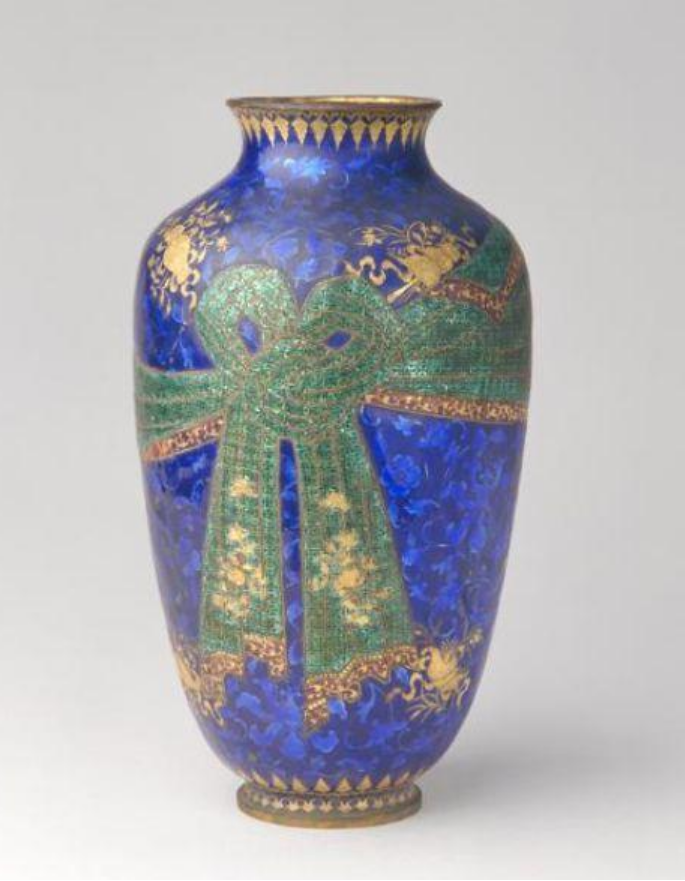
清乾隆 廣琺瑯貼金包袱式瓶 《乾隆年製》款
© 北京故宮博物院藏
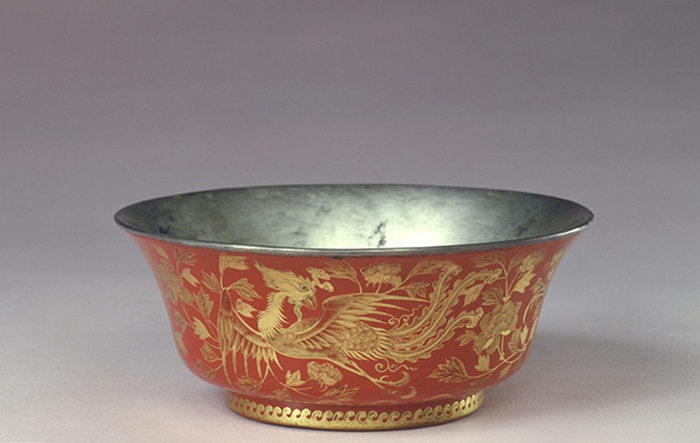
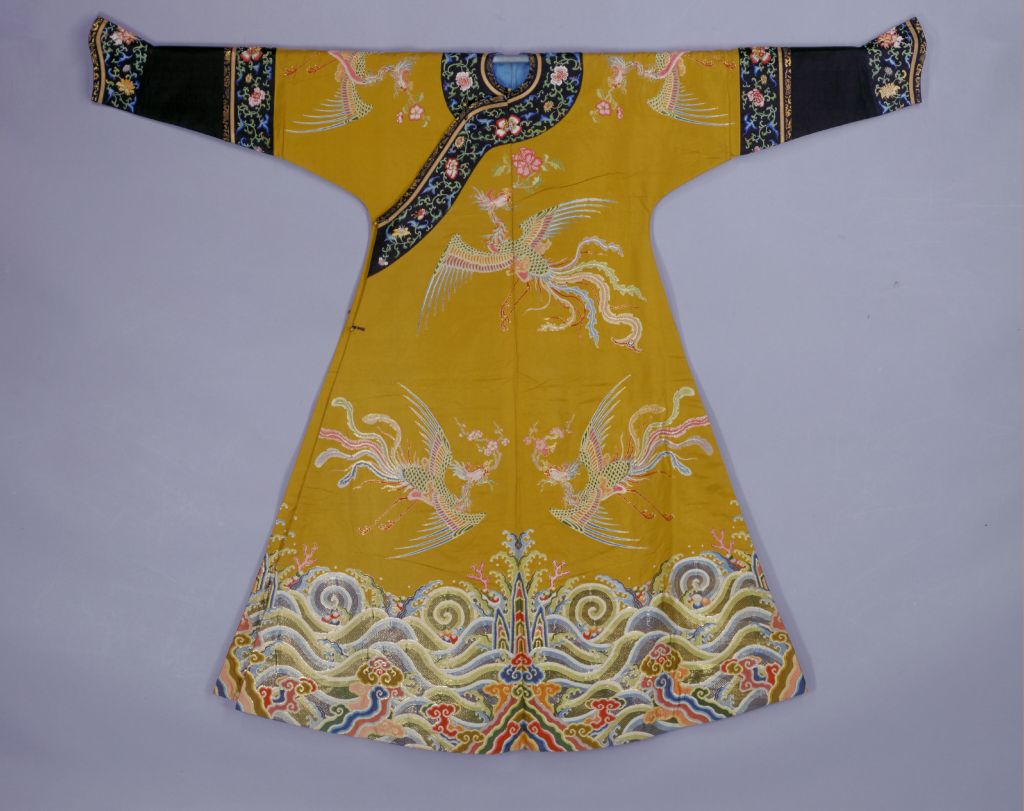
清乾隆 香色鳳銜牡丹妝花稠女棉袍(局部)
© 北京故宮博物院藏
有鳳來儀,乃中華成語。出自《尚書.益稷》:「簫韶九成,鳳凰來儀」。鳳為傳說中的百鳥之王,以此寓意吉祥美好的成語作為該文題目,即是對這件絕世佳品的讚美,也是祝福天下有緣人能看到它或擁有它。
1 張榮,〈清康熙朝御製玻璃〉,《明清論叢.第二輯》,北京,2001年。
2 嵇若昕,〈康熙朝玻璃工藝與琺瑯工藝結合的極致——玻璃胎牡丹藍地膽瓶〉,《故宮文物月刊》,2011年,第11期,頁32-38。
3 上海視覺藝術大學副教授薛呂老師提供資料。
4 許建勳、林業強合著,黎淑儀編,《虹影窰輝——李景勳藏清代玻璃》,香港,2000年。
5《故宮博物院藏清宮陳設檔案》,北京,2013年。
6 庫爾提斯,〈清朝的玻璃製造與耶穌會士在蠶池口的作坊〉,《故宮博物院院刊》,2003年,第1期,頁62-71
7 張臨生,《故宮鼻煙壺》,北京,1991年;《宮中檔案康熙朝奏摺》,第六輯,台北,1976年,頁602-603。
8 中國第一歷史檔案館、香港中文大學文物館合編,《清宮內務府造辦處檔案總匯》,北京,2005年,第3冊,頁357。
9 同上註,第1冊,頁358。
10 同上註,第1冊,頁672。
11 同上註,第2冊,頁574。
12 同上註,第3冊,頁521。
13 同上註,第6冊,頁762。
14《若水澄華:院藏玻璃文物特展》,台北,2017年。
15 大英博物館95號展廳。
16 同註8,第2冊,頁574。
17 同上註,第8冊,頁147。
18 同上註,第9冊,頁521。
19 嵇若昕,〈康熙朝玻璃工藝與琺瑯工藝結合的極致〉,出處同註2;嵇老師說,兩件在台北故宮,筆者認為台北故宮藏乾隆年製款玻璃胎畫琺瑯嬰戲圖葫蘆花插即陳設檔中所言玻璃胎畫琺瑯葫蘆花插。故陳設檔中記錄的乾隆三件玻璃胎畫琺瑯,均在台北故宮收藏。
20 孝聖憲皇后,1692年11月5日至1777年3月2日。
参考: 苏富比 643
中國藝術品 包括趙從衍家族收藏藝術珍品
清十八至十九世紀 五彩百蝶圖棒槌瓶
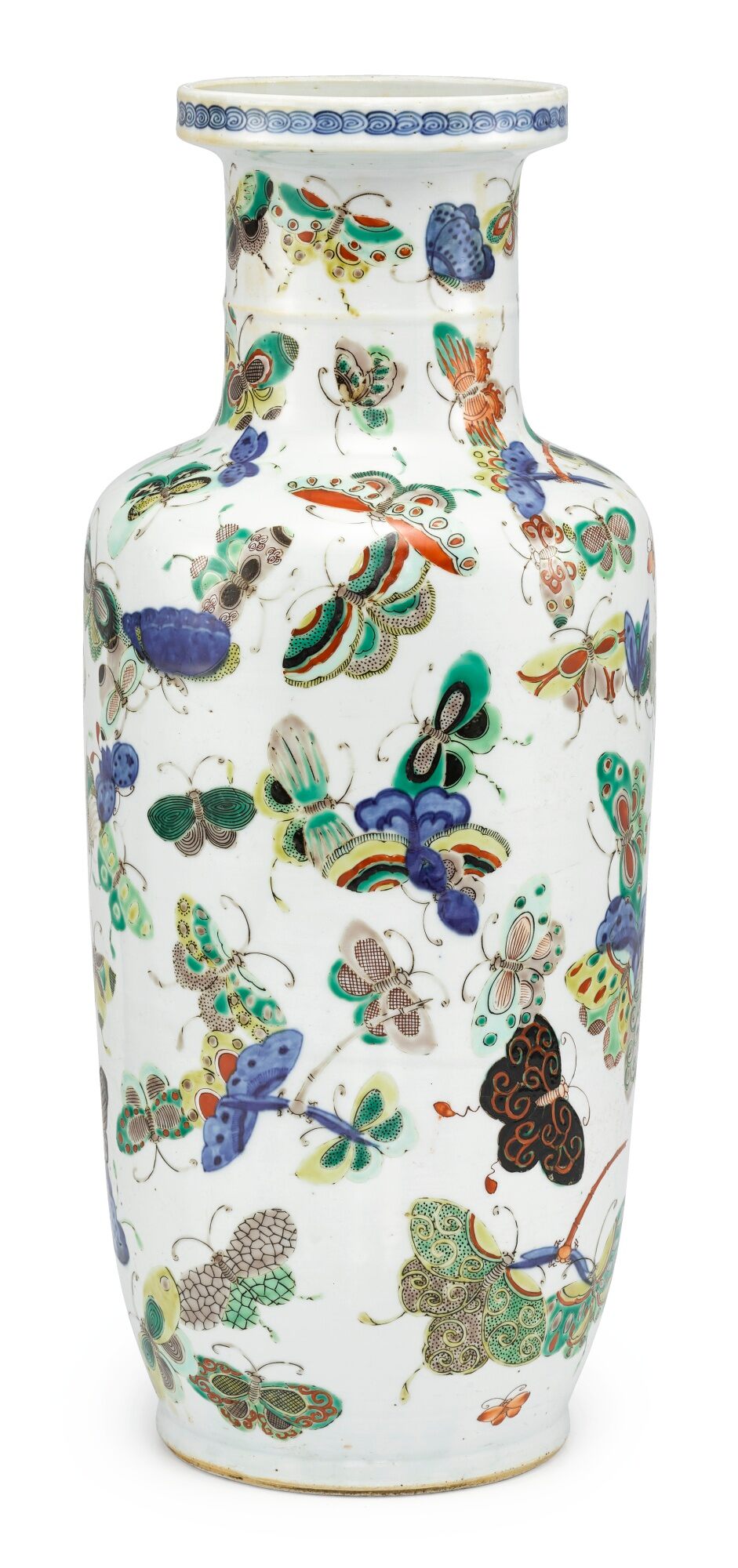
50,000 — 70,000港幣
拍品已售 106,250 港幣 成交價 (含買家佣金)
拍品詳情
清十八至十九世紀 五彩百蝶圖棒槌瓶
47.8 公分,18 7/8 英寸
中國藝術品 包括趙從衍家族收藏藝術珍品
2017年11月30日 – 2017年12月1日 | 下午 2:00 HKT
香港
参考: 苏富比 3640
中國藝術珍品
清乾隆 粉彩松綠地雲蝠紋棱式包袱瓶
《大清乾隆年製》款
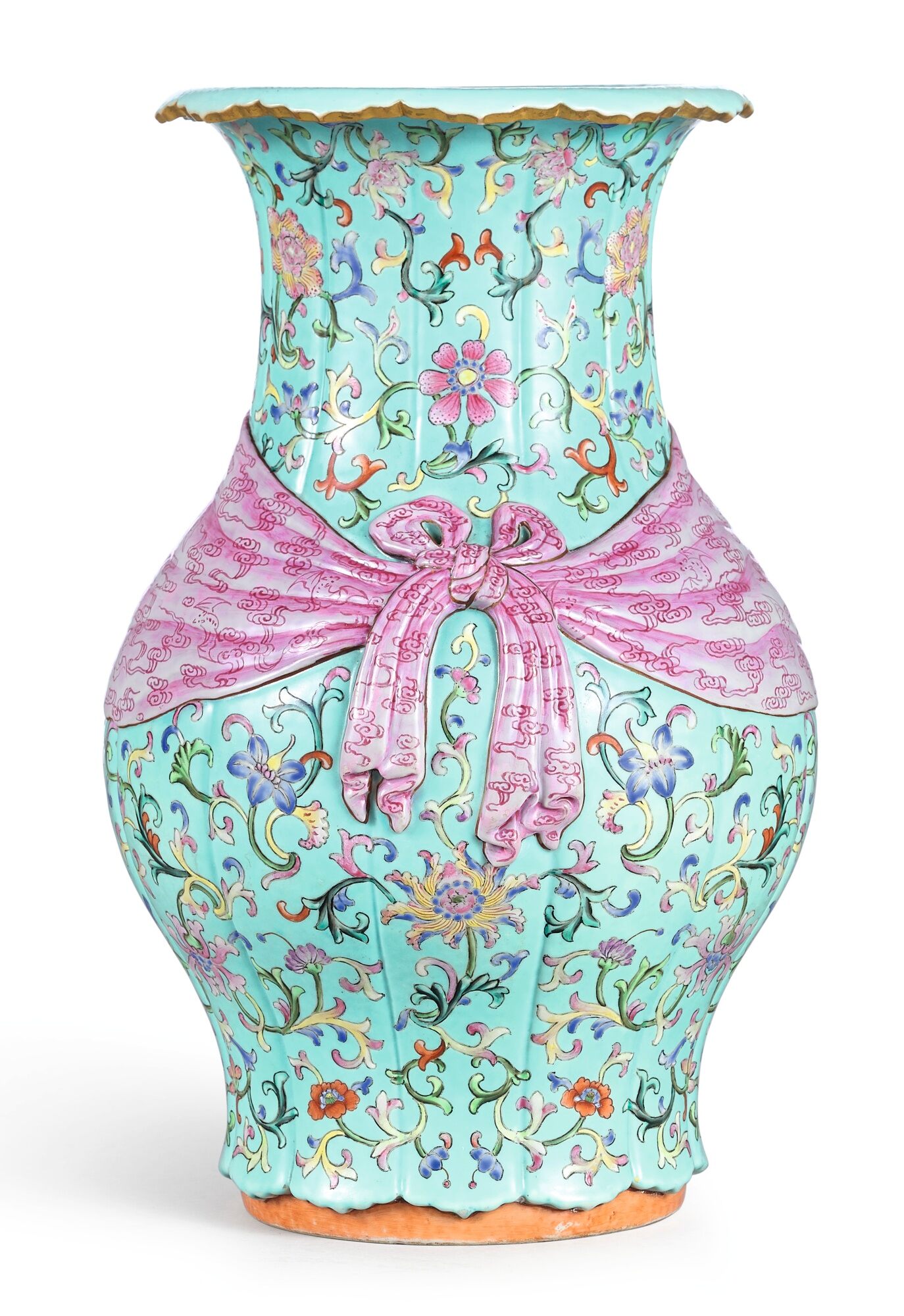
《大清乾隆年製》款
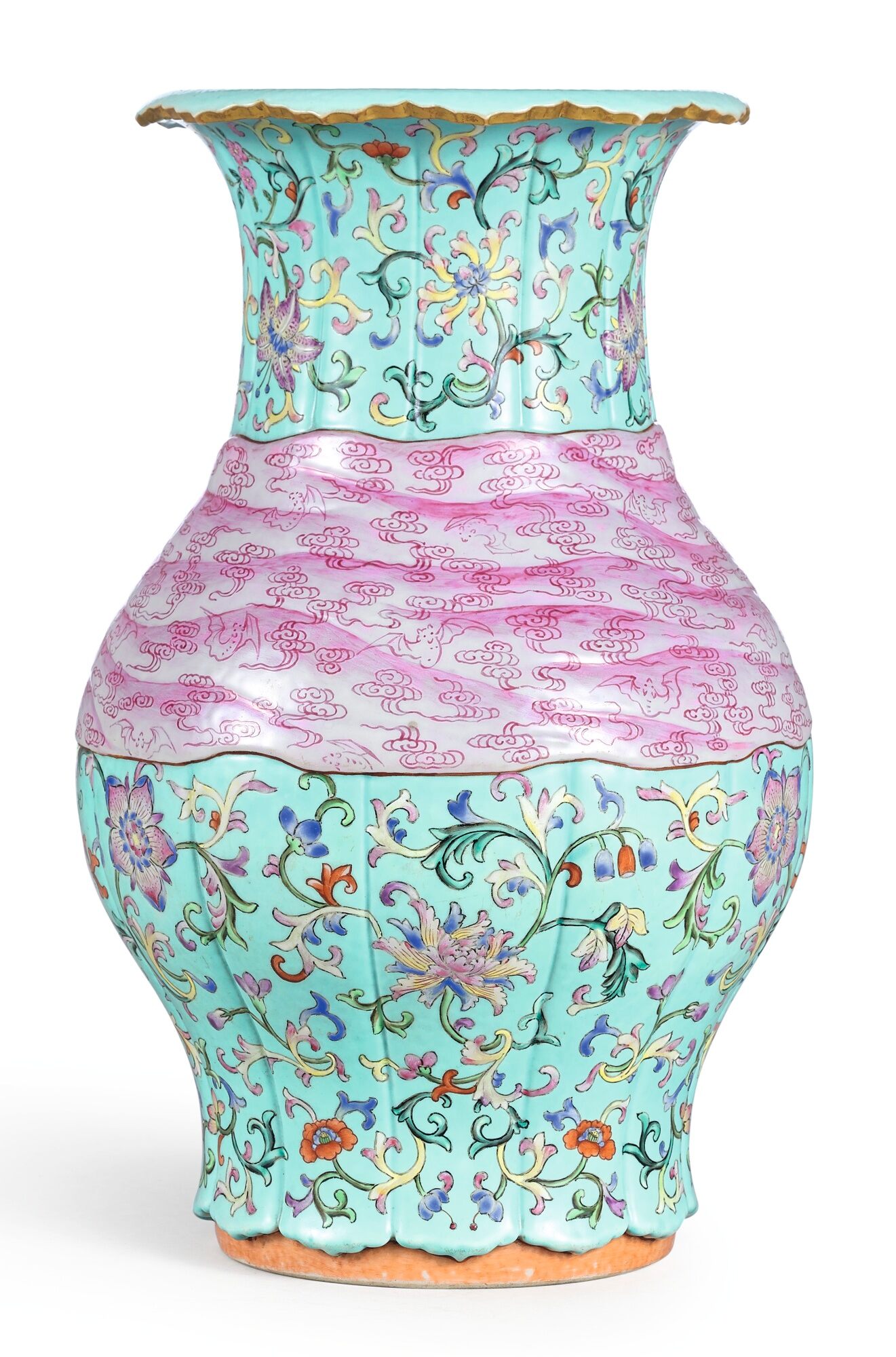
《大清乾隆年製》款
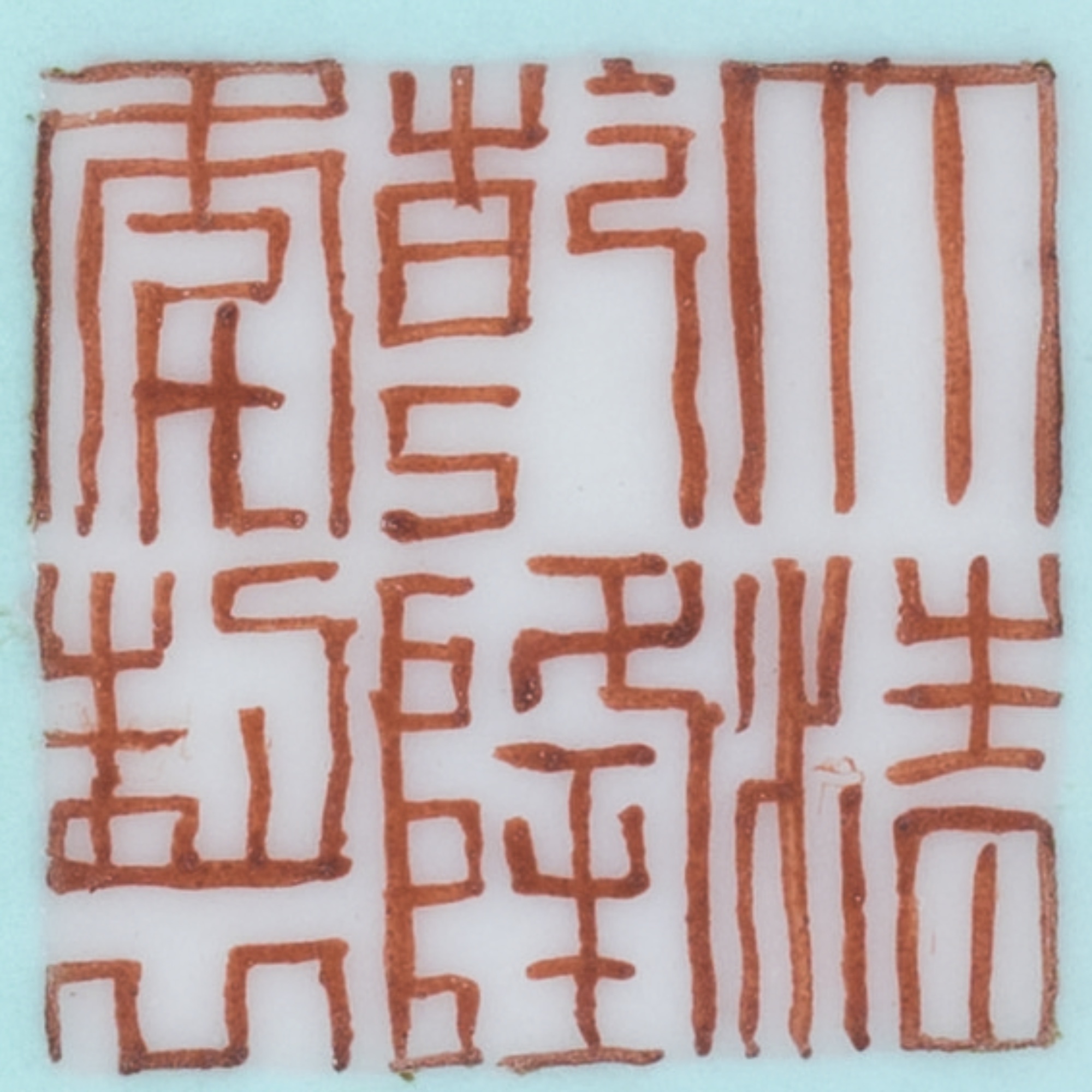
《大清乾隆年製》款
2,000,000 — 3,000,000港幣
拍品詳情
清乾隆 粉彩松綠地雲蝠紋棱式包袱瓶
《大清乾隆年製》款
31 公分,12 1/8 英寸
狀況報告
蝴蝶結左方絲帶末端有一約0.9公分處有小修。瓶口外松綠且有輕微補彩(八時方向約4公分)。表面有常見磨損及剝彩,但此外整體品相良好。
相關資料
此粉彩包袱紋瓷形飾出眾,雅致像生,為弘曆喜愛。景德鎮御窰瓷匠奉乾隆帝命,推陳創新,所製珍品標新立異,巧奪天工,本品正為佳例,尤合帝意。乾隆年間,御匠工藝更見嫻熟,材質出眾,所製瓷器,愈見雄心。本瓶精巧臻妙,令人驚嘆,乃像生瓷中之佳例精品。
乾隆年製之包袱紋瓷器,異常罕見,論器形、紋飾,本品舉世無雙,孤例也。相類飾有包袱紋之品,可參見北京故宮博物院收藏一松石綠地例,尺寸較小,錄於《清宮珍藏康雍乾瓷器圖錄》,香港,1989年,頁359,圖版40。另有一觚例,瓶口環飾如意雲頭紋,售於倫敦佳士得1999年6月15日,編號100。胡惠春家族舊藏粉彩粉地包袱紋蓋罐一對,也可資參考,售於紐約蘇富比1985年6月4日,編號72,後兩度易手於香港蘇富比,分別為1999年11月1日,編號400及2016年10月5日,編號3611。
此瓶所繪包袱紋,受啟發於日式傳統包袱布風呂敷,常見於日本漆器,例見一盒,展出於《東洋漆工芸》,東京,1977年,編號297。如此包袱裝飾,除瓷器外,有見於乾隆年製各式器物之上,例如北京故宮博物院藏金屬胎畫琺瑯彩黃地包袱紋罐,展於《Splendors of China’s Forbidden City. The Glorious Reign of Emperor Qianlong》,菲爾德博物館,芝加哥,2004年,編號336。另可比較咸豐帝兄長恭忠親王奕訢舊藏乾隆料瓶,整體作黃地牡丹鳳紋包袱之形,瓶頸以粉色綬帶打結束之,先後入 A.W. Bahr 及 Paul and Helen Bernat 伉儷收藏,錄於莫士撝,《御製》,香港,1976年,圖版41,售於香港蘇富比1988年11月15日,編號77。
中國藝術珍品
2017年4月5日 | 下午 2:30 HKT
香港
参考: 苏富比 385
中國藝術珍品
清十九世紀 粉彩百蝶圖缸
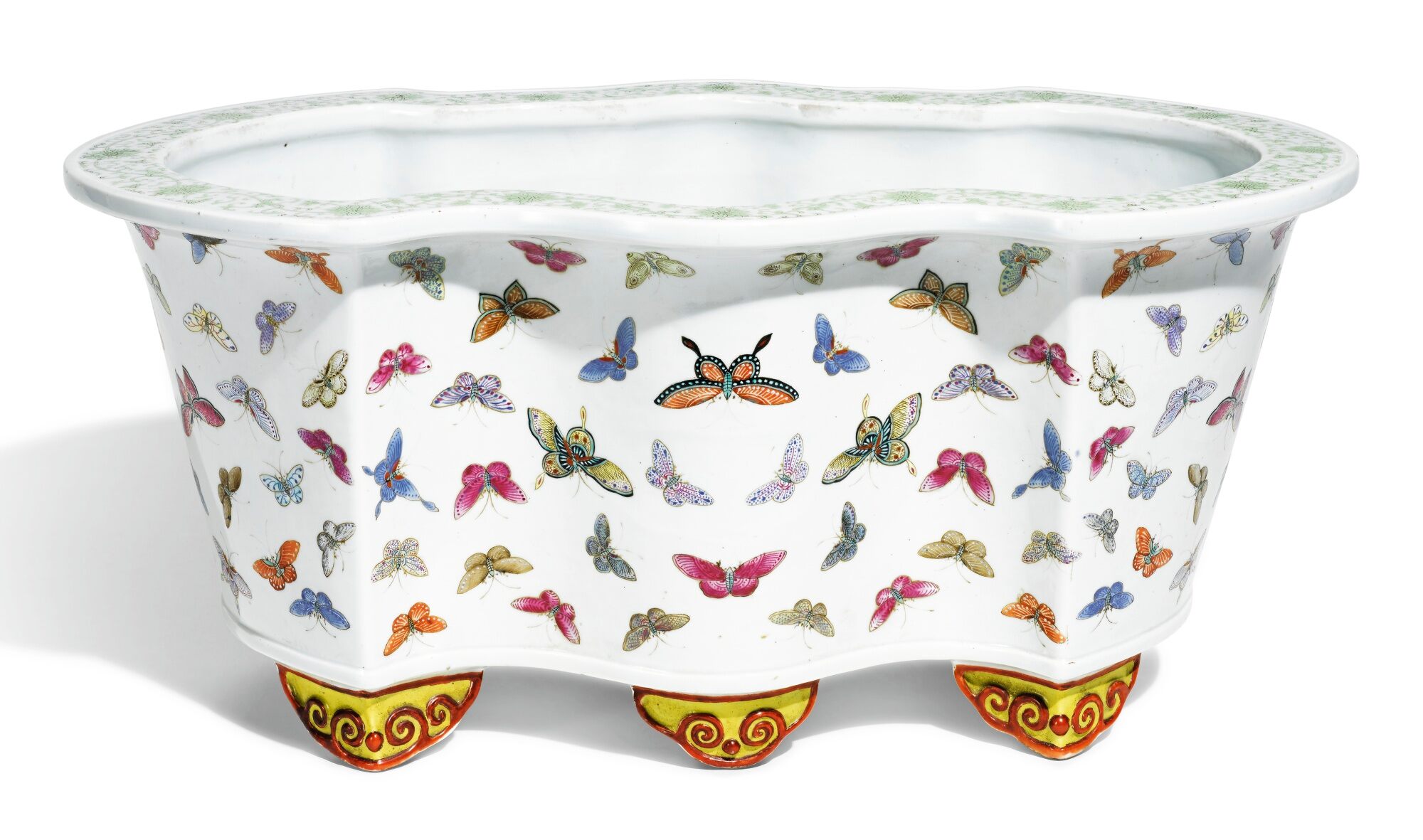
30,000 — 40,000英鎊
拍品詳情
清十九世紀 粉彩百蝶圖缸
51.8 公分,20 3/8 英寸
狀況報告
品相良好,但見內壁有輕量磨損。
中國藝術珍品
2016年11月9日 | 上午 11:30 GMT
倫敦
参考:佳士得 拍賣 2152
重要中國瓷器及工藝精品
香港|2003年10月27日
拍品696 清 乾隆 茶叶末绿釉瓜棱耳瓶
A FINE AND VERY RARE TEADUST-GLAZED QUATREFOIL VASE
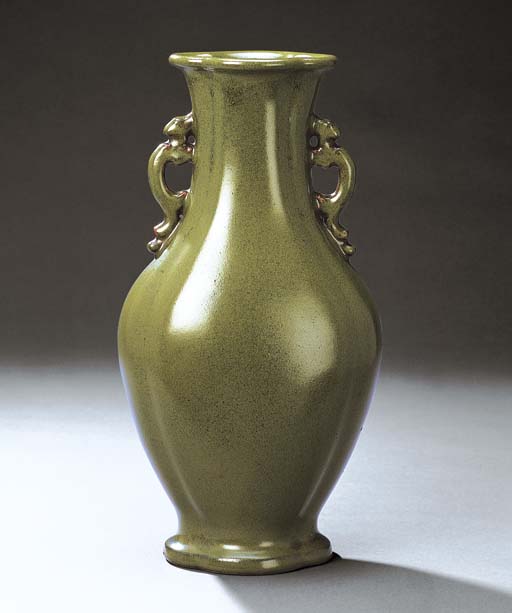
成交總額
HKD 537,750
估價
HKD 250,000 – HKD 300,000
A FINE AND VERY RARE TEADUST-GLAZED QUATREFOIL VASE
QIANLONG INCISED SIX-CHARACTER SEALMARK AND OF THE PERIOD (1736-1795)
Of an elegant baluster shape, the vase is finely potted with compressed quatre-lobed sides rising to a gently waisted neck flanked by a pair of zoomorphic loop handles, the everted lipped mouth rim and splayed foot of conforming foliate section, covered overall with an attractive olive-green glaze with fine yellow speckles
11 5/8 in. (29.5 cm.) high
拍品專文
No other vase of this shape and with teadust glaze appears to be recorded.
Compare, instead, a slightly taller vase (31.5 cm.) of this exact form covered with a ge-type glaze, previously from the T. Y. Chao Private and Family Trust Collection, exhibited at the Chinese University of Hong Kong, Ch’ing Porcelain from the Wah Kwong Collection, 1973, illustrated in the Catalogue, no. 20, and sold in these Rooms, 31 March 1992, lot 577.
参考:佳士得 拍賣 2633
戴萍英基金會珍藏: 清乾隆御製粉紅地粉彩軋道蝴蝶瓶
Hong Kong|2008年12月3日
拍品2388|清乾隆 御製粉紅地粉彩軋道蝴蝶瓶
A MAGNIFICENT IMPERIAL PINK-GROUND FAMILLE ROSE ‘BUTTERFLY’ VASE
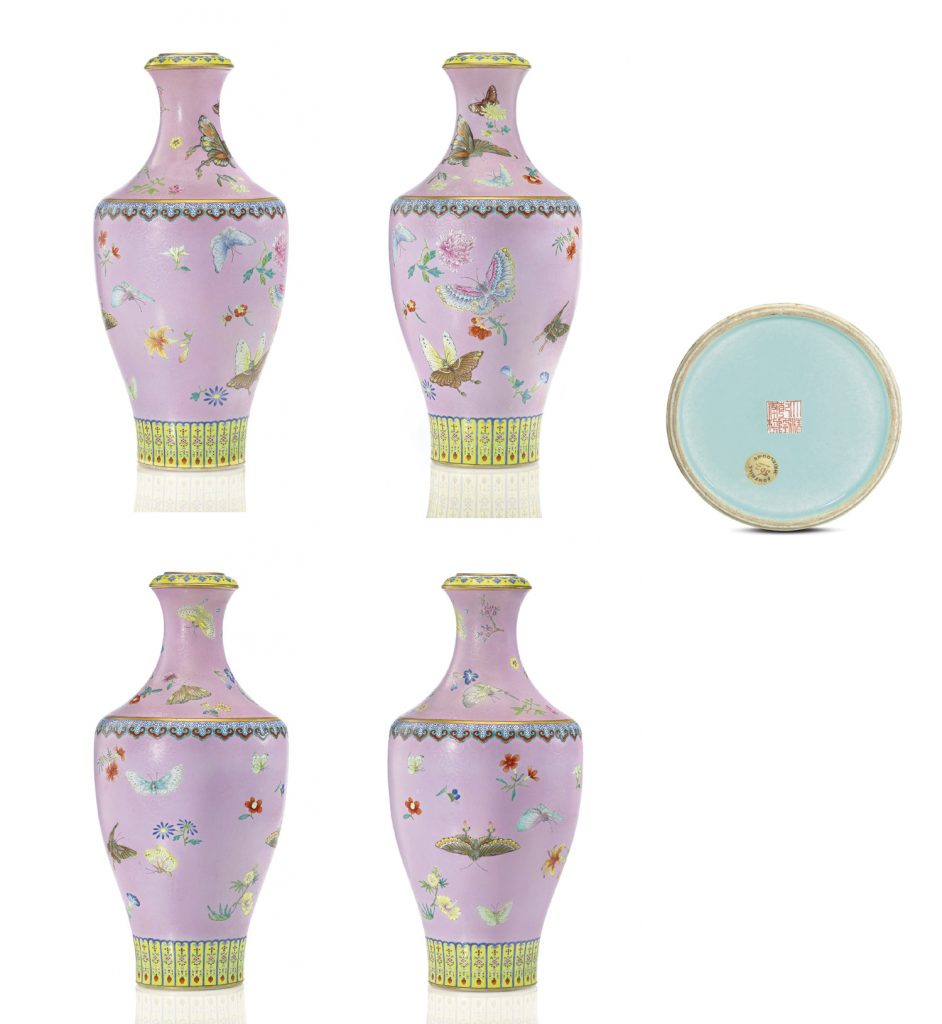
成交總額
HKD 53,300,000
估價
清乾隆 御製粉紅地粉彩軋道蝴蝶瓶
礬紅六字篆書款
高45.7 公分
估價待詢
來源
Yuanmingyuan, removed in 1860, by repute
Lord Loch of Drylaw (1827-1900), by repute
Alfred Morrison (1821-1897) and thence by descent to Lord Margadale of Islay, at Fonthill House, Tilsbury, Wiltshire (Fonthill Heirlooms)
The Morrison Collection of Chinese Porcelains, Christie’s London, 18th October 1971, lot 65
Messrs. S. Marchant & Son
文獻及展覽
文獻
Soame Jenyns, Later Chinese Porcelain, London, 1971, pl. CVI, fig. 2
拍品專文
A Magnificent and Extremely Rare Famille Rose Vase
with Graviata Pink Ground
Rosemary Scott, International Academic Director
This magnificent vase was formerly in the Fonthill Collection of Alfred Morrison, which is one of the most famous 19th century English collections of Chinese art. Alfred Morrison (1821-97) was the second son of the textile merchant James Morrison, who was believed to be the wealthiest commoner in 19th century England. On his father’s death in 1857, Alfred Morrison inherited considerable wealth and the Fonthill estate in Wiltshire. The latter had previously belonged to another famous collector William Beckford (1759-1844) and indeed Morrison’s house on the estate was the surviving wing of Beckford’s Fonthill Splendens. Alfred Morrison devoted his time and his wealth to filling his homes in London and Wiltshire with rare works of art. In the early years much of his Chinese art was acquired from Henry Durlacher, the founder of the famous London dealers Durlacher Brothers. However a large proportion of his Chinese porcelains and enamels on metal were purchased in 1861 from Lord Loch of Drylaw (1827-1900), who brought them to Britain following the storming of the Yuanming Yuan in Beijing in 1860. Morrison then commissioned the famous architect Owen Jones to design a room at Fonthill House ‘in the Cinque-centro style’ especially for the Chinese objects. The current vase was published by the British scholar Soame Jenyns in 1951.1 By that time the collection had passed to John Morrison, and, in discussing the porcelains with graviata enamelled grounds, Soame Jenyns notes: ‘A superb range of these pieces is in the collection of Mr. John Morrison.’
Interestingly, the butterfly and flower design and the form of the vase must have particularly appealed to the Qianlong Emperor. In addition to the current vase, a further pair of Qianlong vases from the Alfred Morrison collection, very similar in design to the ‘Ping Tai’ vase but with slight variations in the ruyi band around the shoulder, a slightly more crowded design around the body and apparently lacking the graviata-ground found on the present piece, was sold in the first sale of Fonthill Heirlooms held at Christie’s London, 31 May 1965, lot 107 (fig. 1). The 1965 catalogue entry erroneously states that one of the pair was illustrated by S. Jenyns, Later Chinese Porcelain as it is now apparent that the vase illustrated by Jenyns is in fact the current vase being offered in this sale.
It is highly likely that all three vases would have originally been kept in one location in the Yuanmingyuan and removed by Lord Loch on the same occasion. This would explain why all three of pieces of this extremely rare design found their way into the collection of Alfred Morrison. The pair of vases sold at Christie’s in 1965 remains the only closely related example of this size and design to have been published. It is extremely rare to find a Qianlong vase of this large size decorated with such delicacy on a graviata ground (fig. 2). Most vases completely covered with graviata ground are smaller, while the larger vases usually employ graviata only in limited areas. The technique would have been very time-consuming as well as requiring a particularly skilled craftsman if it was to be executed to the extremely high standard seen on the current vase. These scrolls have been incised with a very fine point and are small in scale, delicate, and feather-like. It is also notable that the graviata scrolls incised into the pale pink enamel ground of this vase are especially dense and would have required the greatest care to ensure that they formed a coherent pattern and were evenly distributed.
The technique of cutting through slips, glazes and enamels, before they were fired, in order to produce decoration has a long history in China. The origins of the Qing technique probably lie in the Northern Song period (960-1127), when a related technique was used on stonewares belonging to the Cizhou group. On these Cizhou vessels a relatively fine point, or comb-like row of points, were used in one of two ways. The fine points either incised though an upper black slip layer to reveal decorative details in the contrasting white slip layer below, as seen on pieces such as the ruyi-shaped pillow with floral scrolls and wave border in the Palace Museum, Beijing, (fig. 3)2 or designs were incised through a white slip to reveal a darker body material beneath, as in the case of the bean-shaped pillow decorated with fish in water, also from the Palace Museum collection.3 Such stonewares were then covered with a thin, transparent glaze.
Another related decorative technique is that known as ‘cut-glaze’. As with the enamel in the Qing graviata technique, the ‘cut-glaze’ method relied on the glaze staying in place, rather than flowing, when it was fired. ‘Cut-glaze’ was employed at northern Chinese kilns in the Jin (AD 1115-1234) and Yuan (1279-1368) dynasties on stonewares which bore thick, viscous, black or dark brown glazes. On these vessels areas of glaze were cut away before firing, leaving the background of the design in unglazed buff-coloured body material, while details were also cut through to the body using a fine point. Such vessels tend to be large vases or jars of globular form. A Jin dynasty jar is in the collection of the Palace Museum, Beijing (fig. 4)4 while a Yuan dynasty jar is in the British Museum, London.5 The same ‘cut-glaze’ technique was used to decorate stonewares made in the Xi Xia dynasty (1038-1227) kilns of north-western China on a much wider range of forms, including not only vases and jars but also shapes such as flasks and bowls.6
Several versions of this ‘cut-glaze’ technique were used on other ceramics, but it was rarely applied to early porcelain, except for a small number of Yuan dynasty white-glazed wares from the Jizhou kilns, most of which have simple prunus and moon decoration, where most of the glaze was removed using a stencil rather than a knife.7 This latter technique is, of course, related to the Ming dynasty use of wax-resist to produce areas of decoration which were free of glaze, such as those of the ‘green dragon’ group which appear at the imperial kilns as early as the Chenghua reign (1465-87).8 On these porcelains wax prevented the normal porcelain glaze from adhering to the body material in the areas reserved for dragon decoration, in order that green enamel could be applied to these biscuit fired areas in a second, lower temperature, firing.
None of these early techniques achieved anything like the delicacy possible when cutting a design through enamels applied over a fired porcelain glaze. Indeed the incising of decoration through overglaze enamels on porcelain was only possible on any scale once the more stable enamels of the famille rose palette were perfected in the Yongzheng reign (1723-35). The application of the graviata technique creating scrolling, leiwen and lattice patterns on enamels covering the background of porcelain vessels reached its peak of refinement on imperial porcelains of the Qianlong reign, when the current vase was made.
The colours of these graviata background enamels varied, but deep pink, mid-blue and yellow are among the most frequently seen. The pale pink of the current vase is very rare. An example of deep pink enamel with lattice graviata designs can be seen on a Qianlong vase in the Victoria and Albert Museum.9 Like the current vase, the Victoria and Albert Museum is decorated with flowers and butterflies against the pink ground, although the flowers on the latter vessel grow from the lower part of the band, rather than appearing as small sprays as on the current vase. Three very similar vases, one in the collection of the National Palace Museum, Taipei (fig. 5) and a pair in the Baur Collection are decorated with butterflies and floral sprays on a deep pink ground with graviata scrolls similar to those on the current vase.10 Another vase in the collection of the Palace Museum, Beijing has a blue enamel ground with graviata lattice design, which forms the background for a design of butterflies, floral sprays and flower heads (fig. 6).11
Although the pale opaque pink enamel ground with graviata scrolls seen on the current vase is quite rare, it is interesting to note that the style obviously appealed to Alfred Morrison, since a small Qianlong moon flask, with the same graviata pale pink enamel – in this case acting as a ground for formal polychrome floral scrolls – was among the porcelains from his collection sold in our London rooms on 9 November 2004 in the sale Chinese Porcelains and Enamels from The Alfred Morrison Collection, Fonthill House, Lot 47 (fig. 7). The same opaque pale pink enamel with a graviata design, in this case of leiwen, also appears on a Qianlong bowl in the collection of the National Palace Museum, Taipei (fig. 8).12 On the Taipei bowl the pink graviata provides the ground against which formal floral scrolls appear.
The shape of the current vase is also rare, and belongs to a group of vase shapes with especially sharp junctions at the shoulder, which appeared in the Yongzheng reign (1723-35) and gained popularity under the Qianlong emperor. It is probable that all the vase forms with this feature owe their original inspiration to metalwork. A similar sharp shoulder junction and the same unusual flared mouth with inverted rim can be seen on a Yongzheng white ‘soft-paste’ porcelain vase in the Baur Collection.13 Similar sharp shoulder junctions can also be seen on a Yongzheng flambé vase and a Qianlong pale celadon vase in the same collection.14
The combination of flowers and butterflies to decorate porcelain can be seen as early as the Yongle reign (1403-24) on blue and white vessels such as the pear-shaped vase in the Percival David Foundation,15 and the Chenghua reign (1465-87) on doucai wares, such as the globular jar also in the Percival David Foundation.16 However, the combination of butterflies and flower sprays painted in overglaze enamels on porcelain became particularly popular at the imperial court in the Yongzheng reign. A variant of this design can be seen in the famous ‘butterfly bowls’ of the Yongzheng reign on which the butterflies and flowers form roundels. An example of this type from the Yuen Family Collection was sold in our Hong Kong rooms on 30 April 2000, lot 588. In the same sale (lot 589) was a Qianlong vase which has even closer links with the current vase. Although the Yuen vase had no coloured background enamel, the butterflies and flower sprays which decorated it display many similarities with those on the current vase. Indeed a number of the same flowers and types of butterfly appear on both vases.
Butterflies are often included in Qing dynasty decoration in order to suggest a duplication of an auspicious wish, since the word for butterfly in Chinese die is homophonous with a word meaning to repeat. It also sounds like a word meaning eighty years of age, and thus expresses a wish for longevity. When combined with prunus the butterfly provides a rebus for beauty and longevity. Butterflies are also seen as symbols of happiness in marriage as well as everlasting romantic love. The latter interpretation is due to a number of traditional Chinese stories in which butterflies play a part. The most famous is the one by Feng Menglong (1574-1646) in which the star-crossed lovers Liang Shanbo and Zhu Yingtai are transformed after death into butterflies. In Daoism butterflies are associated with dreamlike reflection and the freedom of the soul.
Not surprisingly, the combination of butterflies and flowers to provide decoration was not confined to porcelain, and examples can be found in a number of other materials. A comparable roundel to those seen on the Yuen Yongzheng bowl can be seen embroidered on a Qing dynasty silk robe.17 A Beijing enamel on metal vase decorated with butterflies and floral sprays is in the Palace Museum, Beijing,18 while a Yongzheng/Qianlong painted lacquer tray decorated with these motifs, also from the Palace Museum, is illustrated in Zhongguo Meishu Quanji, Gongyi Meishu bian 8 qiqi, Wang Shixiang (ed.), Beijing, 1989, p. 161, no. 161.
However, the soft pink ground on this vase from the Ping Y. Tai Foundation particularly enhances the butterfly and flower motifs, and rarely has the design been more effectively employed than on this spectacular porcelain vessel.
Notes:
1 Soame Jenyns , Later Chinese Porcelain – The Ch’ing dynasty (1644-1912), Faber and Faber, London, 1951, plate CVI, fig. 2.
2 The Complete Collection of Treasures of the Palace Museum 32 Porcelain of the Song Dynasty (I), Commercial Press, Hong Kong, 1996, pp. 182-3, no. 165.
3 ibid., p. 186, no. 168.
4 Illustrated in Zhongguo wenwu qinghua daquan- Taoci juan, Taipei, 1993, p. 324, no. 524.
5 Illustrated by Tsugio Mikami in Sekai Toji Zenshu – 13- Liao, Jin, Yuan, Shogakukan, Tokyo, 1981, p. 244, no. 282.
6 Illustrated in the excavation report Ningxia Lingwu yao fajue baozao, Beijing, 1995, pls. XXX and LX, respectively.
7 Examples from the Bristol City Art Gallery and the Bernat collection are illustrated by Margaret Medley in Yuan Porcelain and Stoneware, Faber and Faber, London, 1974, pls. 111A and 111B and C, respectively.
8 Catalogue of the Special Exhibition of Ch’eng-hua Porcelain Ware, National Palace Museum, Taipei, 2003, pp. 124-5, nos. 110-111.
9 Illustrated by Rose Kerr in Chinese Ceramics – Porcelain of the Qing Dynasty 1644-1911, Victoria and Albert Museum, London, 1986, p. 116, pl. 99.
10 Illustrated in Emperor Ch’ien-lung’s Grand Cultural Enterprise, National Palace Museum, Taipei, 2002, p. 197, no. V-34; and by John Ayers in Chinese Ceramics in The Baur Collection, volume 2, Collections Baur, Genève, 1999, pp. 128-9, no. 236 and 237, respectively.
11 Illustrated in The Complete Collection of Treasures of the Palace Museum 39 Porcelains with Cloisonné Enamel Decoration and Famille Rose Decoration, Commercial Press, Hong Kong, 1999, p. 37, no. 30.
12 Illustrated in Emperor Ch’ien-lung’s Grand Cultural Enterprise, National Palace Museum, Taipei, 2002, p. 194, no. V-30
13 Illustrated by John Ayers in Chinese Ceramics in The Baur Collection, volume 2, Collections Baur, Genève, 1999, pp. 206-7, no. 307.
14 Illustrated ibid. p. 152, no. 259, and pp. 188-9, no. 290, respectively.
15 Illustrated by Rosemary Scott in Elegant Form and Harmonious Decoration – Four Dynasties of Jingdezhen Porcelain, Percival David Foundation, London, 1992, p. 38, no. 25.
16 Illustrated ibid. p. 64, no. 61.
17 Illustrated by Rosemary Scott in ‘Decorative Links between Porcelain and Silk in the Qing Period’, Transactions of the Oriental Ceramic Society, vol. 58, 1994, p. 71, fig. 6.
18 Illustrated in Splendors of a Flourishing Age, Macau, 2000, no. 73.
編製圖錄及詳情
拍品前備註
The Ping Y. Tai Foundation Collection of Important Chinese Art
Ping Y. Tai (1915 – 1998) was the wife of the legendary connoisseur, collector and dealer, Jun Tsei Tai (1911-1992), fondly known in international Chinese art circles as J.T. Tai. The collection of the Ping Y. Tai Foundation comprises a hitherto little-known group of important classical paintings, ceramics and archaic bronzes given to Ping Y. Tai by her husband. The Chinese paintings were acquired by Mr. and Mrs. Tai without commercial intent and indeed were kept at home for their personal enjoyment. The superb early Ming white porcelain meiping and the unique Qianlong imperial famille-rose ‘butterfly’ vase also were treasured at home by Mr. and Mrs. Tai. Christie’s is therefore especially privileged to present the collection in three sales in New York and Hong Kong in the autumn of 2008.
Mrs. Tai was born Chang Ping Ying in Suzhou in 1915. In 1932 in Shanghai, she married Jun Tsei Tai, who was already a highly respected connoisseur and dealer of Chinese ceramics, ancient bronze vessels and carved jades. Like many of their compatriots, Mr. and Mrs. Tai moved to Hong Kong in 1949, a year of great political and social upheaval in China. In 1950 Mr. Tai settled in New York and was joined by Mrs. Tai in 1953. Working first with the leading Paris-based dealer C.T. Loo, Mr. Tai soon established his own gallery, J.T. Tai and Co., on Madison Avenue in New York City’s elite district of museums and galleries. Many masterpieces in major American museums and collections such as the Metropolitan Museum of Art, the Freer Gallery of Art, the Avery Brundage collection and the Arthur M. Sackler collections were acquired from Mr. Tai. In this way, he was a primary force that profoundly influenced the appreciation of Chinese art in America and Europe.
Ping Y. and J.T. Tai were a central part of the cultural elite in New York’s Chinese community, which included such renowned artistic and literary figures as the artist and collector C.C. Wang, the author and scholar Lin Yutang, the scholar and collector Wan-go Weng as well as the calligrapher and collector Wang Fang-yu. It was to this small group of friends and intellectual equals that Mr. and Mrs. Tai showed their private collection of art treasures. In the time-honored tradition of Chinese collectors, they would study and enjoy each painting or object during private moments together or at gatherings with their connoisseur friends. These meetings were relaxed and informal occasions. In addition to good food and art, there were also frequent mah-jong games and Mrs. Tai was an especially enthusiastic participant.
It is not difficult to imagine Mr. and Mrs. Tai at home – studying and appreciating together the technique and beauty of Qiu Ying’s (1495 – 1552) magnificent ‘Lotus Picking’ (offered in Hong Kong in December). They might have recalled their hometown origins as they gazed at the depiction of a scholar seated at leisure surrounded by his finest treasures on the banks of one of Suzhou’s rivers. Perhaps they were reminded of the warm summer days of their youth in that picturesque city. Qiu Ying, one of Suzhou’s great masters, produced many of the most elegant and technically skillful paintings in the history of Chinese art.
Two porcelain masterpieces which were displayed in the New York home of Mr. and Mrs. Tai reflect contrasting aspects of their taste in ceramics. On the one hand, the exceptionally rare early 15th century meiping (offered in New York in September) with its incised peony scroll under an unmistakable milky white glaze is an important example of the famed tianbai or “sweet white” ware of the Yongle period (1403-1425). Elegant, technically perfect and in pristine condition, the vase is surely one of the greatest early Ming monochromes to become available in decades. Its restrained decoration, subtle glaze and perfect form is best appreciated by the cognoscenti.
Equally important is the magnificent 18th century Imperial famille rose ‘butterfly’ vase (offered in Hong Kong in December) formerly in the Fonthill Heirlooms collection. Exquisitely and elaborately decorated in brilliant colors with a multitude of butterflies reserved on a brilliant pink ground meticulously incised with a delicate floral scroll, the vase is a tour-de-force of Qing enamelling technique. It is also a supreme testament to the luxurious taste of the Qianlong Emperor, whose seal mark graces its base. In contrast to the meiping the “butterfly” vase emphasizes surface decoration, a rich palette and virtuoso technique.
All three of these treasures reflect the couple’s appreciation of the highest levels of artistic and technical achievement and this is repeated throughout the Ping Y. Tai Foundation Collection.
Ping Y. Tai established the Ping Y. Tai Foundation in New York in order to continue her charitable work. This organization, which primarily supports institutions that provide vital aid in the areas of health and humanitarian services, regularly benefits such groups as the American Red Cross, American Cancer Society, American Heart Association, UNICEF, City Meals on Wheels, Lighthouse International and Memorial Sloane-Kettering Hospital. The proceeds from the sales of this collection will help the Foundation to continue its important philanthropic endeavors.
Christie’s sales of this exceptional collection in New York and Hong Kong provide collectors all over the world with a rare opportunity to participate in a tradition characterized by the most refined approach to art appreciation and collecting. Having benefited from the connoisseurship and discerning eye of Ping Y. and J. T Tai, these treasures, unavailable for many years, can now be handed over to another generation of discerning collectors.
ALFRED MORRISON, VICTORIAN MAECENAS
CAROLINE DAKERS
PROFESSOR OF CULTURAL HISTORY, CENTRAL SAINT MARTINS COLLEGE OF ART AND DESIGN
Alfred Morrison (1821-1897) was the second son of the millionaire textile merchant James Morrison, probably the richest commoner in the 19th century. As a young man, James (born 1789) had left his small Hampshire village where his father had been innkeeper, to seek his fortune in London. Alfred, however, grew up in considerable luxury, enjoying the comforts of a town house in Harley Street and country estates at Fonthill in Wiltshire and Basildon in Berkshire. He attended Edinburgh and Cambridge Universities, travelled regularly on the continent and spent over three years criss-crossing North America on behalf of his father’s merchant bank. While travelling with him in 1842, his elder brother Charles wrote home: ‘I have been observing Alfred – & do not think he will become a working man of business… I think that nothing but necessity will induce him to become the inmate of a countinghouse… [he] does not value money & does like his ease’ (private collection).
Fortunately for Alfred he would never be forced to become the ‘inmate of a countinghouse’. When his father died in 1857, Alfred inherited the Fonthill estate and £750,000 in stocks and shares. His country home was called the Pavillion (fig. 1); it was the surviving wing of William Beckford’s Fonthill Splendens (the ruins of the famous Abbey were close by). And like Beckford, Alfred would use his inheritance to amass an extraordinary collection of art treasures. He began by collecting engravings and Chinese art, the latter often acquired from Henry Durlacher. However, a significant proportion of the Chinese ceramics and enamel on metal were purchased in 1861 from Lord Loch of Drylaw (1827-1900). The latter had brought them to Britain from China following the sack of the Imperial Yuanmingyuan (Garden of Perfect Brightness) in Beijing in 1860.* Alfred commissioned the internationally famous architect Owen Jones to design a room at Fonthill especially for the Chinese objects ‘in the Cinque-cento style….The chimney-piece and fittings [made by Jackson and Graham] are entirely of ebony, inlaid with ivory, and the ceiling is of wood panelled and inlaid, the mouldings being black and gold’ (The Builder, 9 May 1874, p.385).
While work was proceeding in Wiltshire, Alfred acquired the lease, in 1865, to 16 Carlton House Terrace; Jones, Jackson and Graham proceeded to create for him a palace of art behind the dull stucco exterior. ‘Pass through this heavy doorway, and in an instant every fair clime surrounds you, every region lavishes its sentiment; you are the heir of all the ages… There is no sham in this house – no wood pretending to be metal, and no iron affecting to be marble… We may ascend the magnificent stairway, past the globes of light upheld by bronze candelabra rising seven feet from the floor, and as we go from story to story find good, painstaking work meeting us everywhere.’ The house was a riot of colour, pattern and texture; inlaid woodwork; coffered geometrical ceilings; walls hung with rich Lyons silks. ‘It makes the chief palaces of Northern Europe vulgar’ (Moncure Conway, Travels in South Kensington, London, 1882, pp.154-159). Alfred filled his homes with paintings and sculpture, Persian carpets, tapestries, lace and embroidery, coins and medals, Greek antiquities, autographs and letters, as well as Chinese porcelain, adding three top-lit galleries to Fonthill in the 1880s (fig. 2). He bought work by contemporary artists including Frederic Leighton and John Brett, but he also ‘loved to be the Maecenas’ of contemporary craftsmen, commissioning exquisite and priceless pieces from the Spanish metalworker Placido Zuloaga, the French enamellists Charles Lepec and Fernand Thesmar, and the goldsmith Lucien Falize.
Perhaps Alfred was inspired by William Beckford. A description of Fonthill Splendens written early in the century could as easily have been applied to his own achievements in his London and Wiltshire homes: ‘an astonishing splendour is shown here, combined with the finest taste, and one can say without exaggerating that those who are in the business of decorating for the great and rich, to perfect their art would find in Fonthill the most excellent examples’ (C.A.G.Goede, England, Wales and Ireland, Dresden, 1805, vol.5, p.116).
*Three important sales of important Chinese art from Morrison’s Fonthill Heirlooms Collection have taken place at Christie’s King Street. The first was on 31 May 1965, when the famous Xuande cloisonné enamel jar and cover now in the Uldry Collection was among the pieces sold. The second sale of fine Qing cloisonné and porcelains was on 18 October 1971, which included and the current ‘butterfly’ vase. The third sale of enamels and porcelains took place on 9 November 2004.
Caroline Dakers is the author of a study of the Morrison family, Making Money in 19th Century Britain: The Morrisons of Fore Street, Yale University Press due to be published in 2010.
PROPERTY OF THE PING Y. TAI FOUNDATION
参考:佳士得 拍賣 8833
中國瓷器、工藝精品及紡織品
倫敦南肯辛頓|2013年5月17日
拍品1331 清 乾隆 青釉双耳瓜楞瓶
A CELADON-GLAZED TWO-HANDLED LOBED VASE
QIANLONG UNDERGLAZE BLUE FOUR-CHARACTER MARK AND OF THE PERIOD (1736-95)
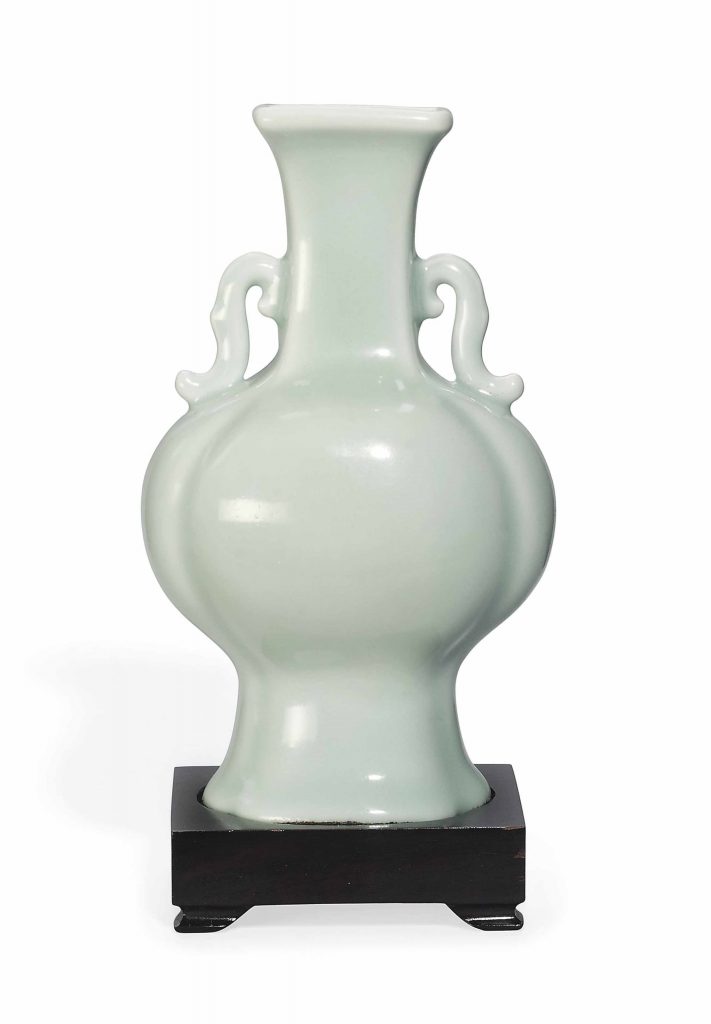
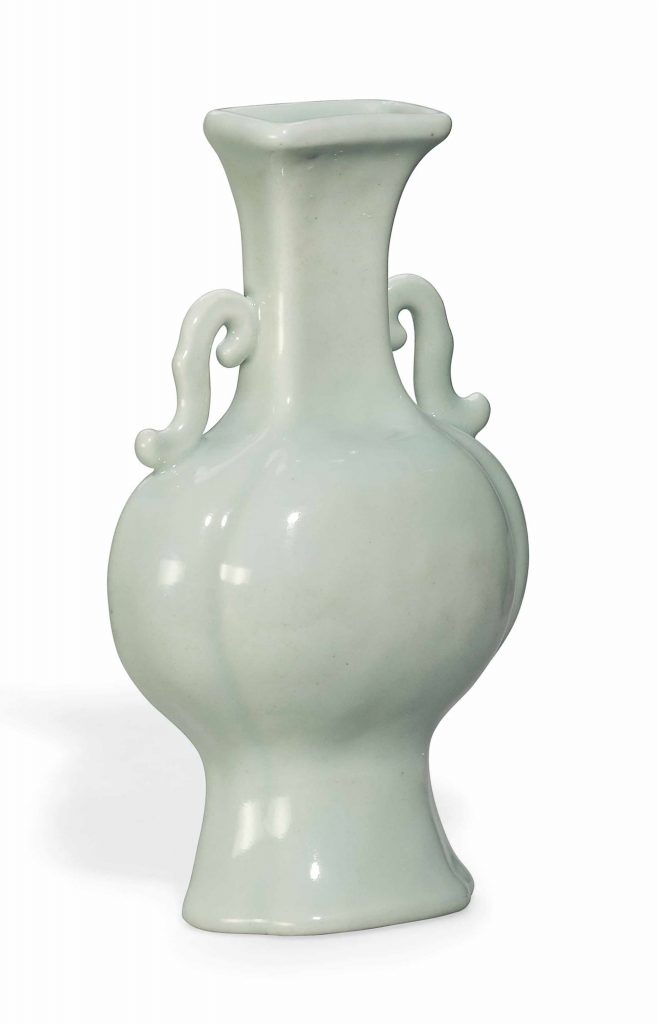
成交總額
GBP 6,000
估價
GBP 3,000 – GBP 5,000
A CELADON-GLAZED TWO-HANDLED LOBED VASE
QIANLONG UNDERGLAZE BLUE FOUR-CHARACTER MARK AND OF THE PERIOD (1736-95)
The vessel is of square-section with a rounded lobed body rising to a slightly flaring neck and galleried rim. It is decorated all over with a pale bluish-green glaze.
7 1/8 in. (18 cm.) high, wood stand
來源
Property from The Y.C.Chen Collection.
參考:Sotheby‘s: 乾隆 仿哥釉海棠形瓜棱瓶 A FINE AND RARE GE-TYPE LOBED VASE
SEAL MARK AND PERIOD OF QIANLONG
IMPORTANT CHINESE ART
3616 PROPERTY FROM AN ASIAN PRIVATE COLLECTION
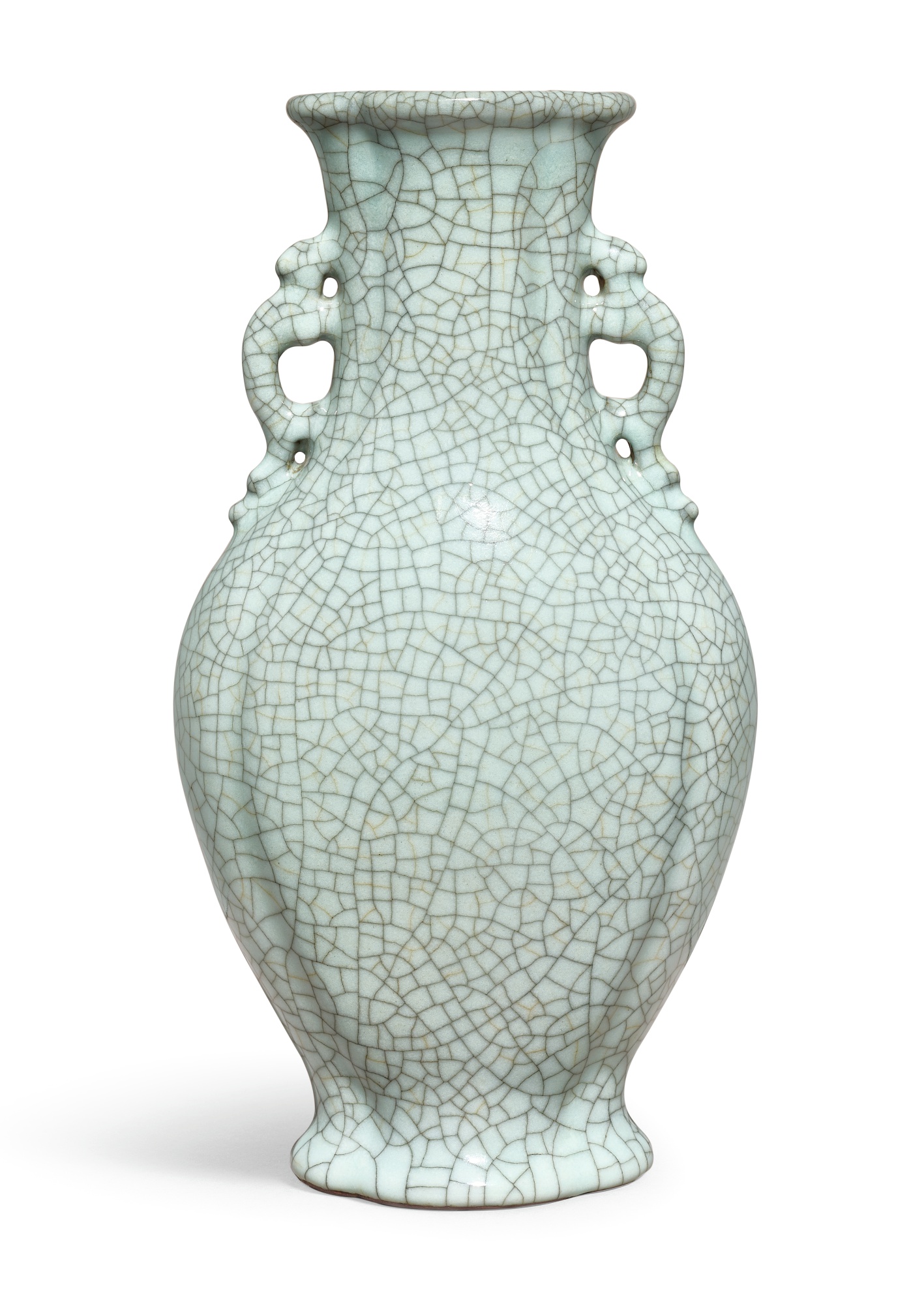
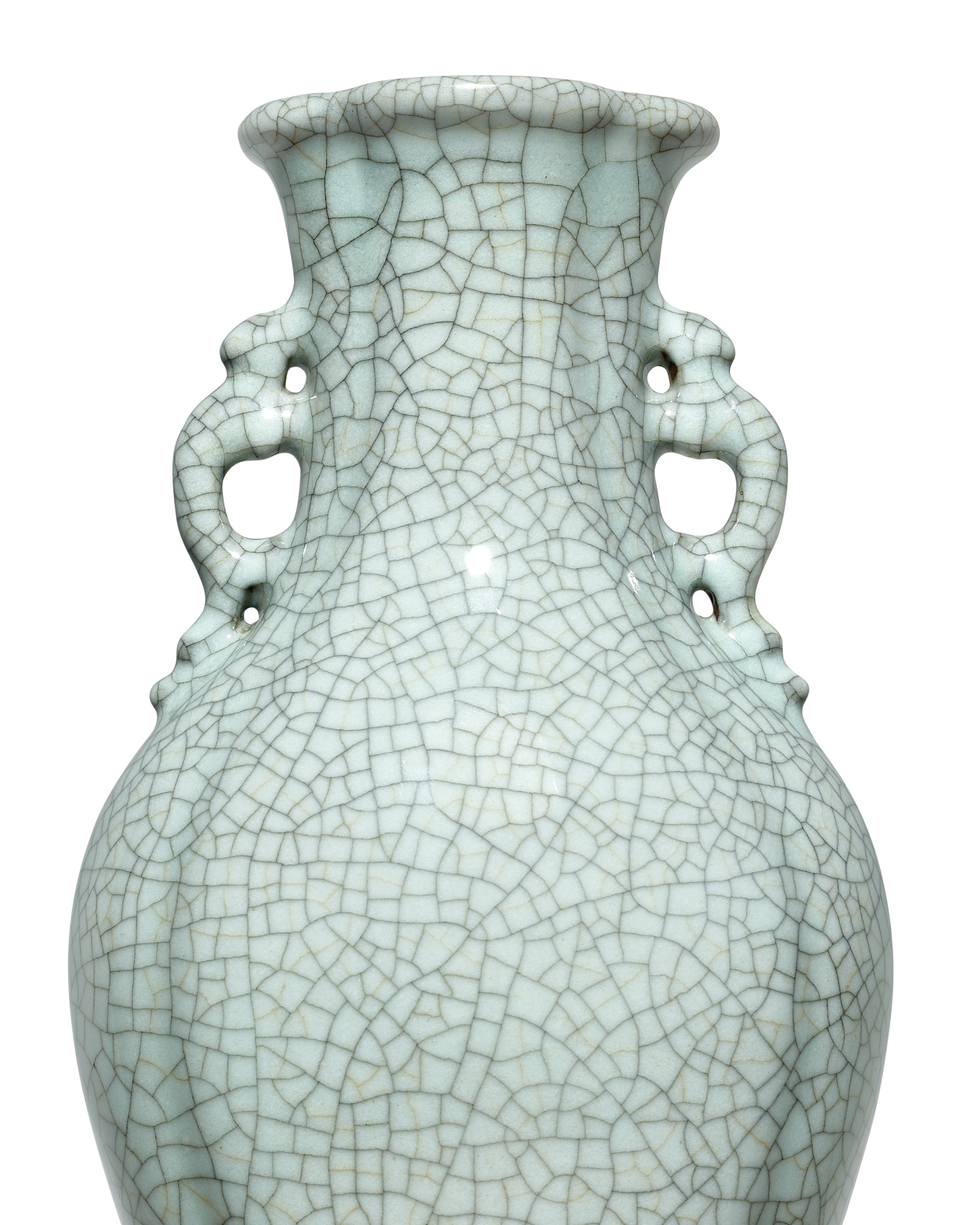
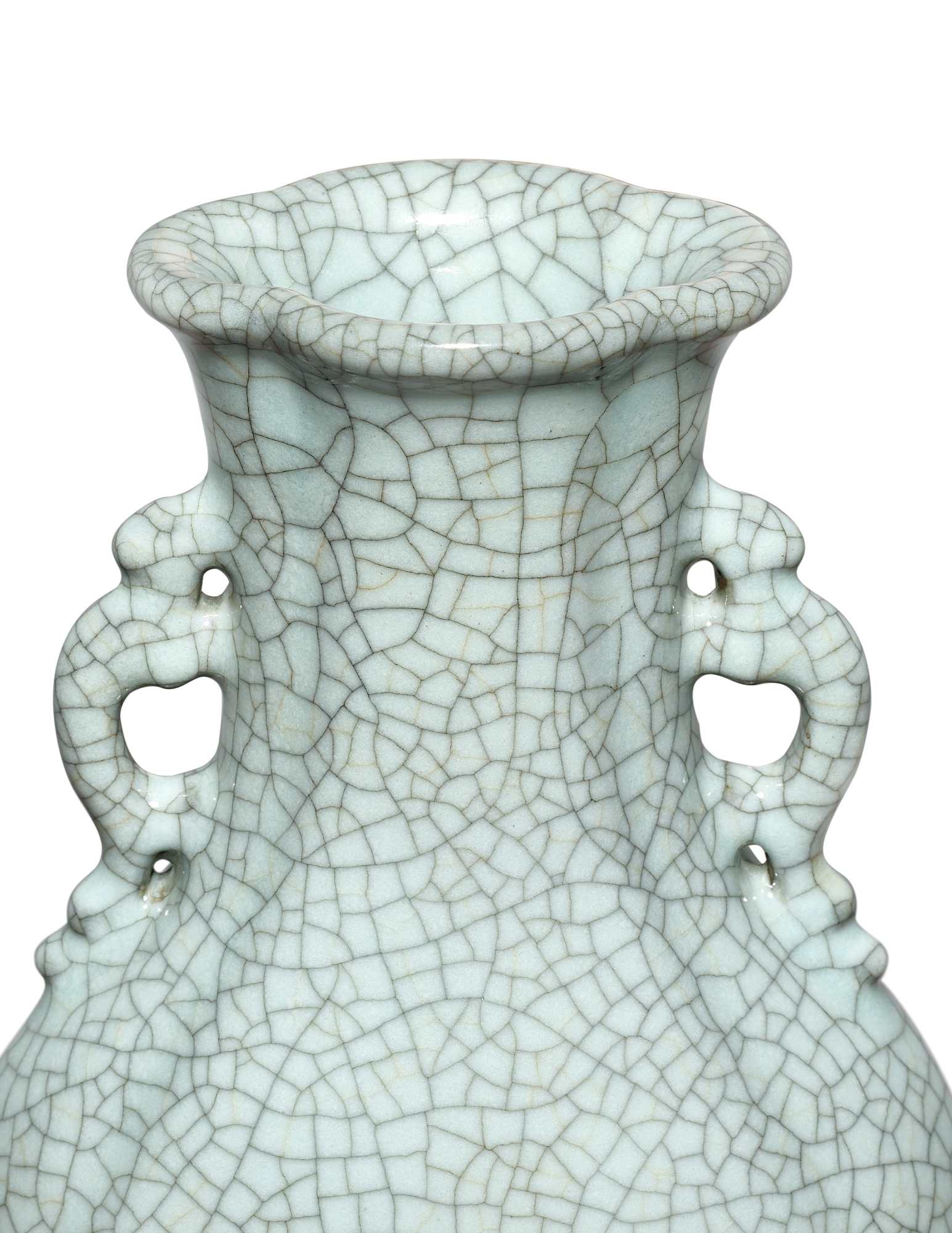
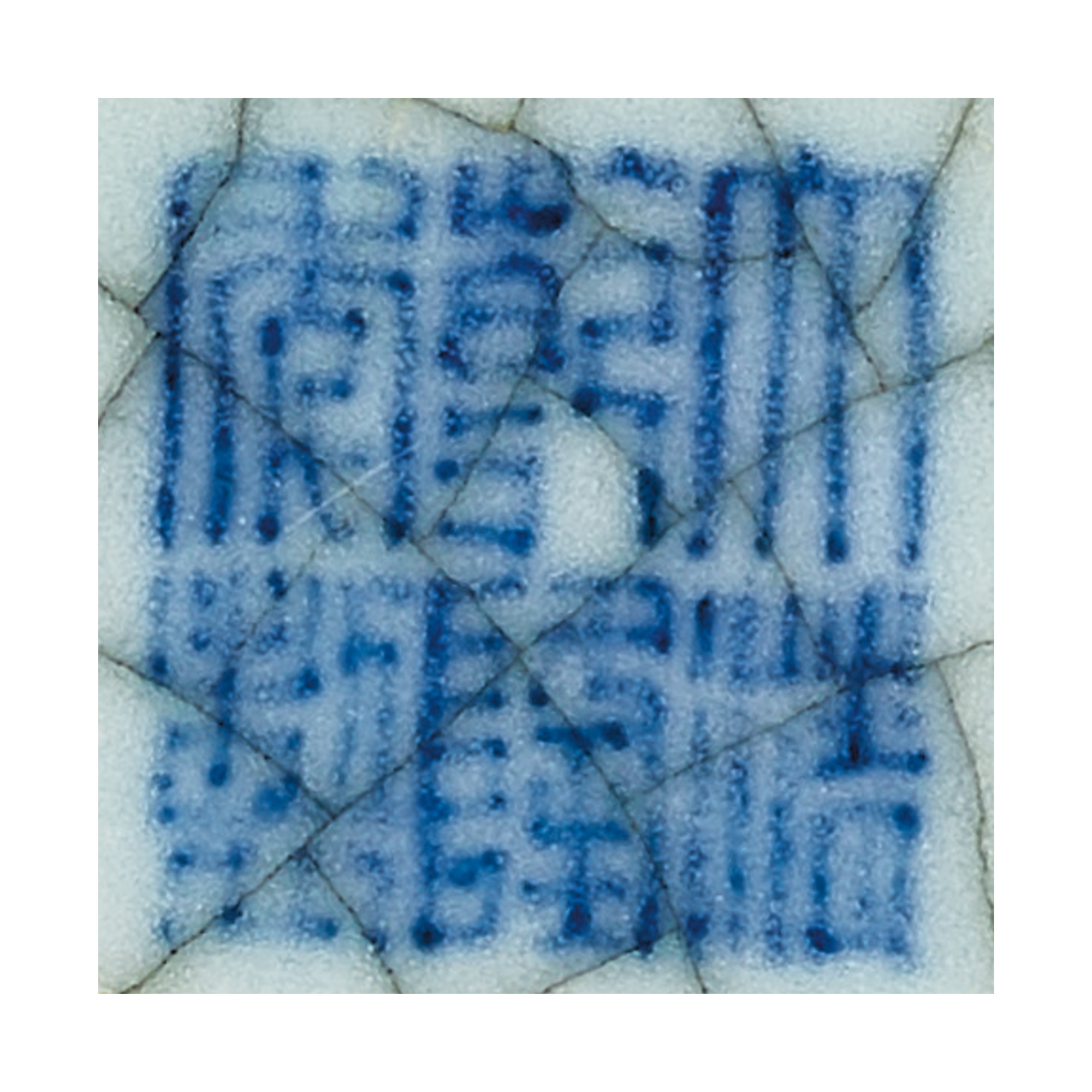
Estimate 2,400,000 — 2,600,000 HKD
LOT SOLD. 3,000,000 HKD
DETAILS & CATALOGUING
IMPORTANT CHINESE ART
08 OCTOBER 2019 | 2:30 PM HKT
HONG KONG
A FINE AND RARE GE-TYPE LOBED VASE
SEAL MARK AND PERIOD OF QIANLONG
of quatrefoil section, well potted with a flattened body elegantly rising from a splayed foot to a waisted neck gently flaring at the rim, flanked by a pair of stylised dragon handles, covered overall save for the footring with a greyish glaze suffused with a dense network of ‘iron-wire’ and golden crackles stopping neatly above the foot revealing the brown-dressed unglazed footring, the base inscribed with a six-character seal mark in underglaze blue, wood stand
31 cm, 12 1/8 in.
PROVENANCE
Collection of T.Y. Chao (1912-1999).
Sotheby’s Hong Kong, 18th November 1986, lot 88.
Christie’s Hong Kong, 31st March 1992, lot 577.
EXHIBITED
Ch’ing Porcelain from the Wah Kwong Collection, Art Gallery, Chinese University of Hong Kong, Hong Kong, 1973, cat. no. 20.
CATALOGUE NOTE
The current vase, with its outstanding crackled ge-type glaze and well-proportioned form, is an exceptional example of not only the Qianlong Emperor’s predilection for celebrated wares of the past – in particular the imperial wares of the Song dynasty (960-1279) and the Yongle – Xuande reigns (1403-1435) of the Ming dynasty – but also the technical developments in ceramic production as well as the creativity and level of innovation of the craftsmen working under the supervision of Tang Ying (1682-1756), Superintendent of the Imperial kilns in Jingdezhen. Under the rigorous standards that the Emperor upheld, craftsmen were prompted to search for and realise ever new designs that enabled them to showcase their technical proficiency and ability to hark back to antiquity.
Superbly decorated with an even glaze marked with an attractive matrix of ‘iron-wire’ and golden crackles, the present vase belongs to a group of vessels inspired by the celebrated ge wares of the Song and Yuan (1279-1368) dynasties. In addition to the crackles, which were often stained to enhance their prominence, these archaistic vessels were dressed on the unglazed bodies with a dark brown slip, as seen on the footring of the present vase, to simulate the so-called ‘iron foot’ characteristic of the stoneware prototypes.
The form of the vase also reflects elements borrowed from archaic bronze vessels and this is particularly evident in the skilful incorporation of the stylised dragon handles. With their heads sharply turned backwards, they evoke late Spring and Autumn period vessels, including two illustrated in Special Exhibition of Shang and Chou Dynasty Bronze Wine Vessels, National Palace Museum, Taipei, 1989, pls 69 and 70.
The current vase is very rare and only two closely related examples appear to have been sold at auction, the first sold in these rooms, 28th November 1978, lot 201, and later included in A Selection of Ming and Qing Porcelains, Eskenazi Ltd, London, 2004, cat. no. 17; and the other sold at Christie’s Hong Kong, 30th May 2006, lot 1365.
For a related, albeit smaller, guan-type vessel, demonstrating the Qianlong Emperor’s fascination with the past, see one similarly modelled with a quatrelobed body but bearing an underglaze-blue Qianlong imperial inscription eulogising the handled guan-type vase, published in Obtaining Refined Enjoyment: The Qianlong Emperor’s Taste in Ceramics, National Palace Museum, Taipei, 2011, cat. no. 76.
See also a Ming dynasty ge-type moonflask offered in this sale, lot 3615.
参考:严肃点,我们在这“打结”呢 | 给瓷器打个结
“包袱”在字典里有很多种解释,常见的比如说,它是相声界的术语,指的是经过细密组织、铺垫,达到的喜剧效果。把包袱抖响了是一个相声演员的能耐。还有一种解释是包裹物件用的布面。而在清朝的景德镇,有一种瓷器也是借用了包袱这个词,叫包袱瓶。
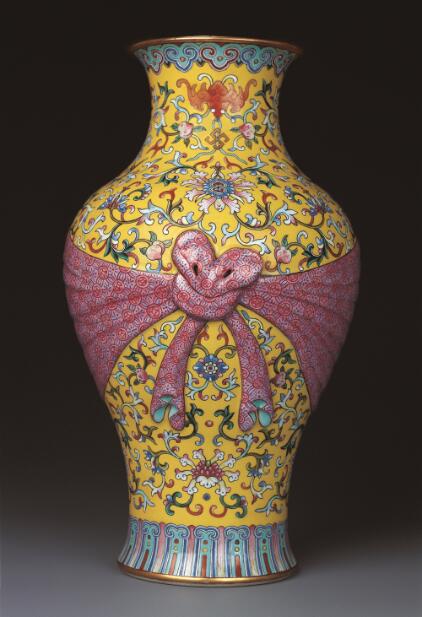
粉彩缠枝莲纹包袱瓶 清嘉庆 观复博物馆藏
包袱瓶创烧于清早期,流行于乾隆、嘉庆两朝,以粉彩较多见。在瓶身肩部装饰凸雕的包袱皮或者束带,丝织物的褶皱起伏细腻精到,用坚硬的瓷土来表现柔软的丝织物,用色彩鲜艳柔和的粉彩来表现丝织物的美感,两者的结合达到了审美的极致。此外,“包袱”与“包福”谐音,寓意幸福吉祥。由于该器型独特,纹饰优美,寓意美好,遂为后世争相仿制,也是宫廷皇家常见的御用之物。此件嘉庆时期的包袱瓶还保留有乾隆时期的工艺特征,画面繁缛,色泽艳丽明亮。底足署“大清嘉庆年制”六字篆书款。
参考:拍卖结果 > 香港苏富比2017春季拍卖会 > 中国艺术珍品 > 清乾隆 粉彩松绿地云蝠纹棱式包袱瓶《大清乾隆年制》款
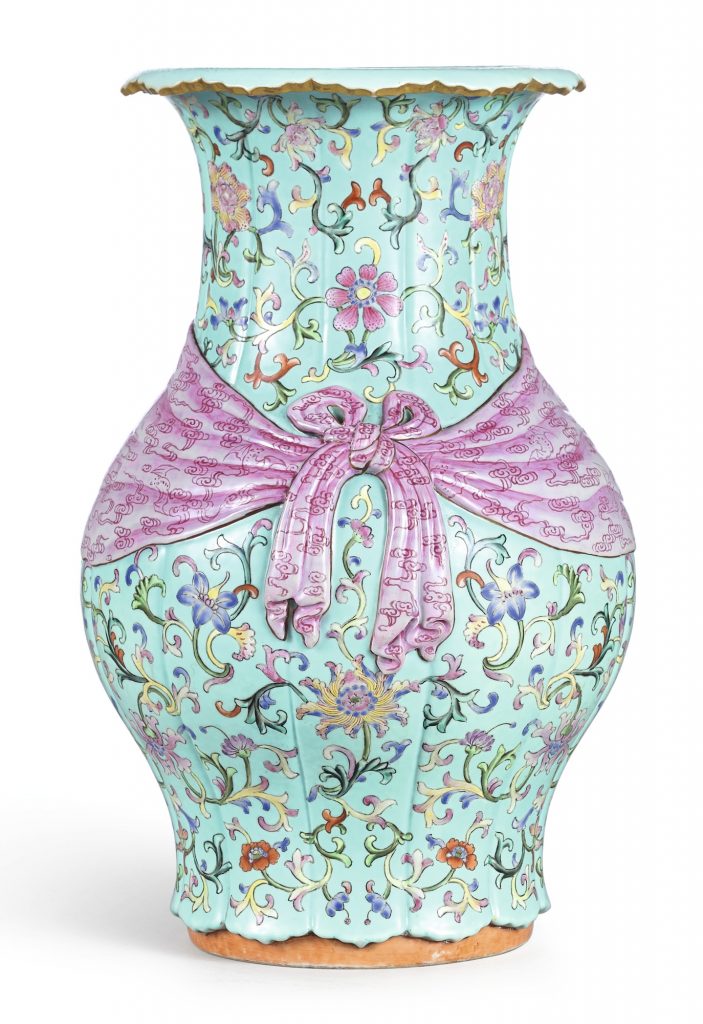
拍卖信息
Lot 3640 清乾隆 粉彩松绿地云蝠纹棱式包袱瓶《大清乾隆年制》款
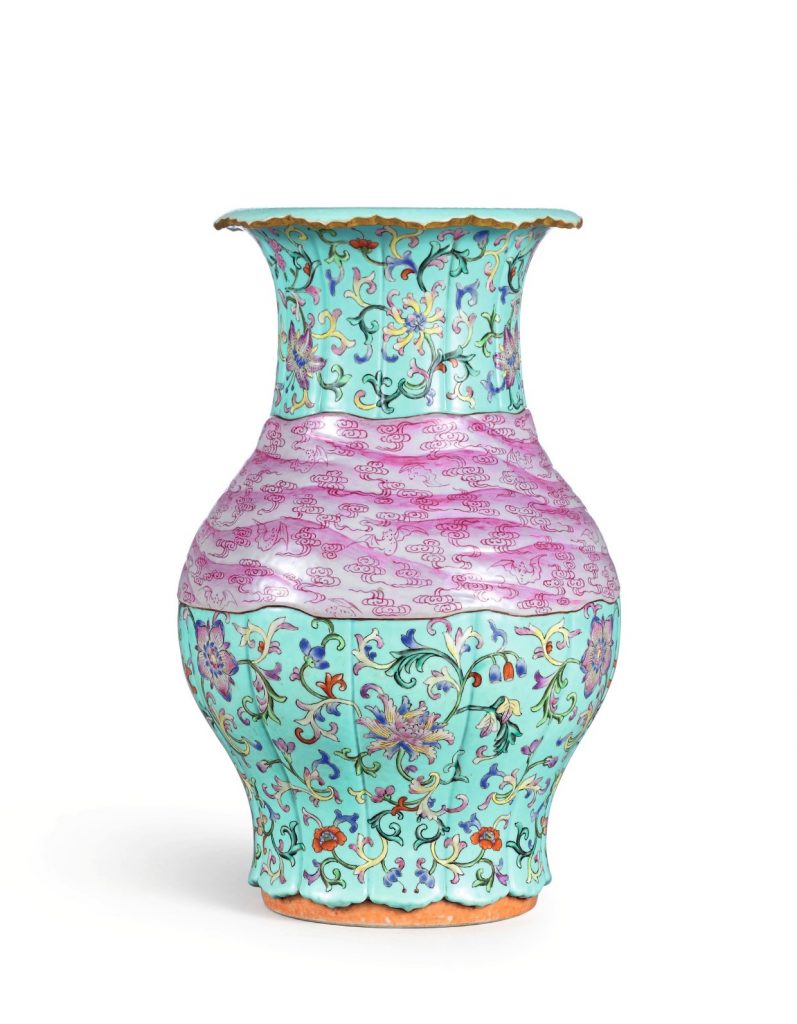
拍卖信息
Lot 3640 清乾隆 粉彩松绿地云蝠纹棱式包袱瓶《大清乾隆年制》款
作者 — 尺寸 31cm
作品分类 陶瓷>清代粉彩瓷器 创作年代 清乾隆
估价 HKD 2,000,000-3,000,000
专场 中国艺术珍品 拍卖时间 2017-04-05
拍卖公司 香港蘇富比拍卖有限公司 拍卖会 2017年春季拍卖会
《大清乾隆年制》款
说明 相关资料
此粉彩包袱纹瓷形饰出众,雅致像生,为弘历喜爱。景德镇御窑瓷匠奉乾隆帝命,推陈创新,所制珍品标新立异,巧夺天工,本品正为佳例,尤合帝意。乾隆年间,御匠工艺更见娴熟,材质出众,所制瓷器,愈见雄心。本瓶精巧臻妙,令人惊叹,乃像生瓷中之佳例精品。
乾隆年制之包袱纹瓷器,异常罕见,论器形、纹饰,本品举世无双,孤例也。相类饰有包袱纹之品,可参见北京故宫博物院收藏一松石绿地例,尺寸较小,录于《清宫珍藏康雍干瓷器图录》,香港,1989年,页359,图版40。另有一觚例,瓶口环饰如意云头纹,售于伦敦佳士得1999年6月15日,编号100。胡惠春家族旧藏粉彩粉地包袱纹盖罐一对,也可资参考,售于纽约苏富比1985年6月4日,编号72,后两度易手于香港苏富比,分别为1999年11月1日,编号400及2016年10月5日,编号3611。
此瓶所绘包袱纹,受启发于日式传统包袱布风吕敷,常见于日本漆器,例见一盒,展出于《东洋漆工芸》,东京,1977年,编号297。如此包袱装饰,除瓷器外,有见于乾隆年制各式器物之上,例如北京故宫博物院藏金属胎画珐琅彩黄地包袱纹罐,展于《Splendors of China’s Forbidden City. The Glorious Reign of Emperor Qianlong》,菲尔德博物馆,芝加哥,2004年,编号336。另可比较咸丰帝兄长恭忠亲王奕欣旧藏乾隆料瓶,整体作黄地牡丹凤纹包袱之形,瓶颈以粉色绶带打结束之,先后入 A.W. Bahr 及 Paul and Helen Bernat 伉俪收藏,录于莫士撝,《御制》,香港,1976年,图版41,售于香港苏富比1988年11月15日,编号77。
参考:拍卖结果 > 北京保利2019春季拍卖会 > 十面观止—十面灵璧山居暨海外名藏清瓷萃珍 > 清乾隆 洋彩松绿地加金宝相花如意口包袱花觚
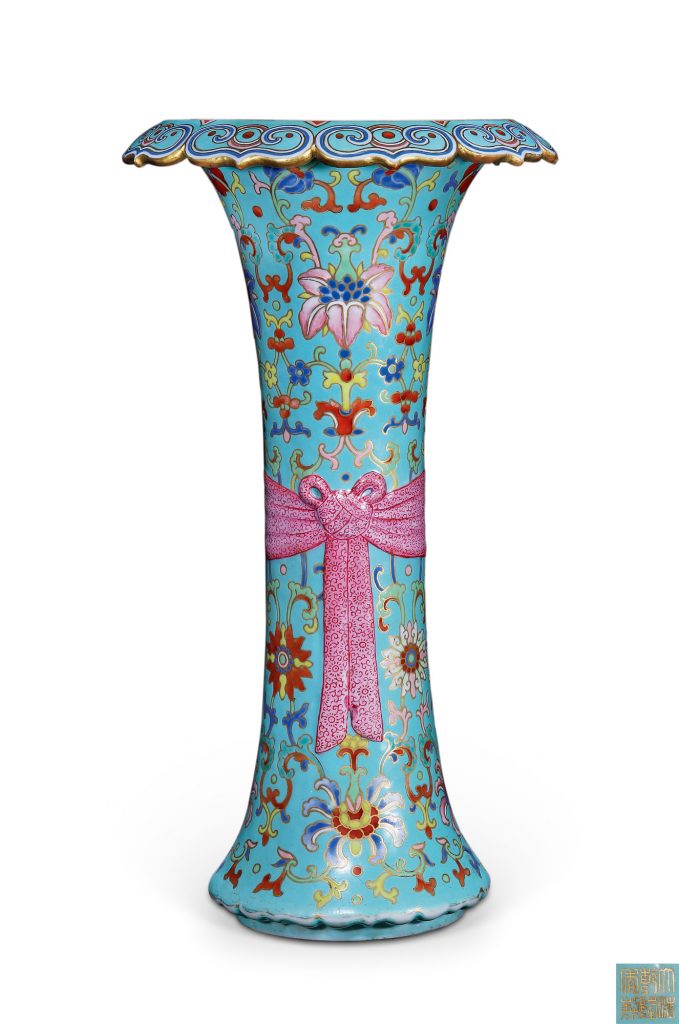
估价:4,000,000-6,000,000 RMB
成交价: 5,750,000 RMB (含买家佣金)
尺寸:
高31.5cm
拍品说明:
「大清乾隆年制」款 备注:• 法国南部家族旧藏,购于1920年;• 于2003年购自布鲁塞尔亚洲艺廊本品以如意云头纹口,束颈,直身,圈足。周身及足部松石绿釉为地,粉彩饰缠枝莲,瓶腹并勾勒绘有一包袱结带,极为罕见。整体纹饰间以洋彩勾勒,金彩描边,近足处亦以如意头纹,呈现出富贵祥和的气派。描绘笔触细腻,设色精妍,制作极为精美。底部松石绿釉地上金彩书「大清乾隆年制」六字三行篆书款。据乾隆三十七年四月二十六日九江关监督伊龄阿进单中所载「交淳化轩洋彩绿地吉庆一统尊成对」,应属同类器物。本品花卉为西洋花卉,且枝叶表现出阴阳光影,赋有立体感,受西方纹饰、绘画技法影响,属于「洋彩」瓷器。清代曾为雍正、乾隆两朝皇帝烧制瓷器的督陶官唐英曾这样表述:「洋彩器皿,本朝新仿西洋珐琅画法,圆琢白器,五彩绘画,摹仿西洋,故曰洋彩。人物、山水、花卉、翎毛无不精细入神,所用颜料与珐琅色同。」清宫档案《活计档》将瓷胎洋彩与瓷胎画珐琅同时归入「清宫珐琅器皿」,《陈设档》则将瓷胎洋彩与瓷胎画珐琅同时归入「乾隆款瓷胎」项下,这也说明了二者的关系密切。翻阅资料,各大馆藏及市场流通藏品,几难遇见相似作品。乾隆年制之包袱纹瓷器,异常罕见,论器形、纹饰,本品举世无双,孤例也。相类饰有包袱纹之品,可参见北京故宫博物院收藏一松石绿地例,录于《清宫珍藏康雍乾瓷器图录》,香港,1989年,页359,图版40。另有一例,售于伦敦佳士得1999年6月15日,编号100。如此包袱装饰,除瓷器外,有见于乾隆年制各式器物之上,例如北京故宫博物院藏金属胎画珐琅彩黄地包袱纹罐,展于《Splendors of Chinas Forbidden City.The Glorious Reign of Emperor Qianlong》,菲尔德博物馆,芝加哥,2004年,编号336。美国卡内基艺术博物馆旧藏的一件清乾隆松石绿地粉彩缠枝花卉浮雕五子登科包袱瓶,其大量使用松石绿釉地描金缠枝莲作为主体纹饰,亦可作比。
参考:捧在掌心的珍玩 – 徐展堂舊藏
清乾隆 豆青釉紅彩絲帶紋小尊「大清乾隆年製」款
拍品編號:938
場次:中國重要瓷器和藝術品
高度:11cm估價:HK$3,000,000 – 4,000,000
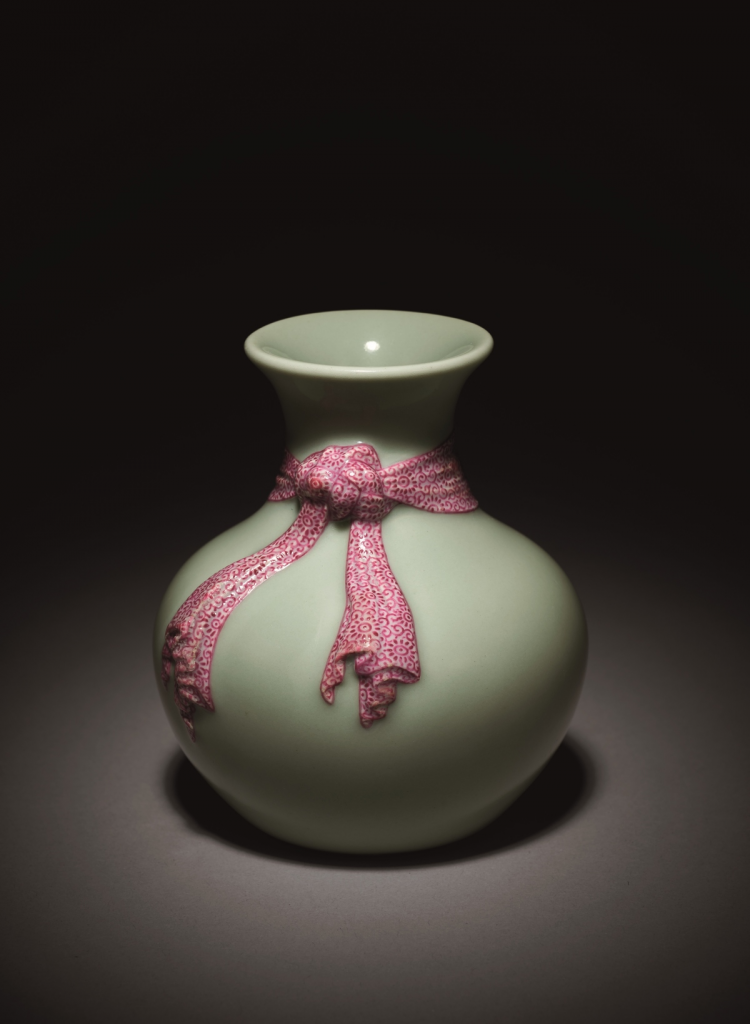
清乾隆 豆青釉紅彩絲帶紋小尊「大清乾隆年製」款
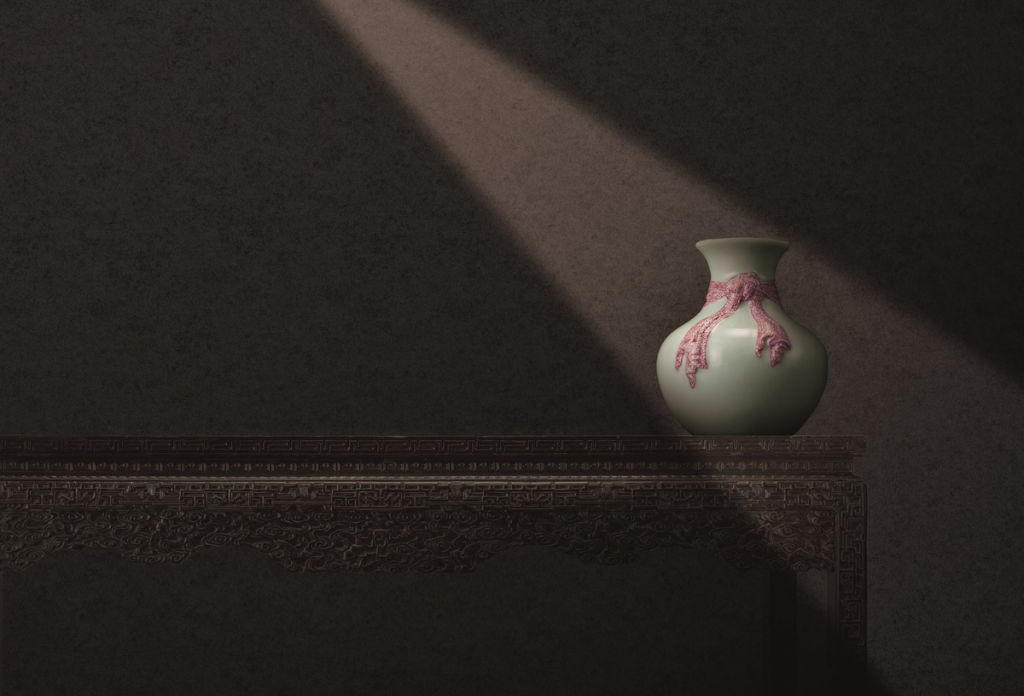
清乾隆 豆青釉紅彩絲帶紋小尊「大清乾隆年製」款
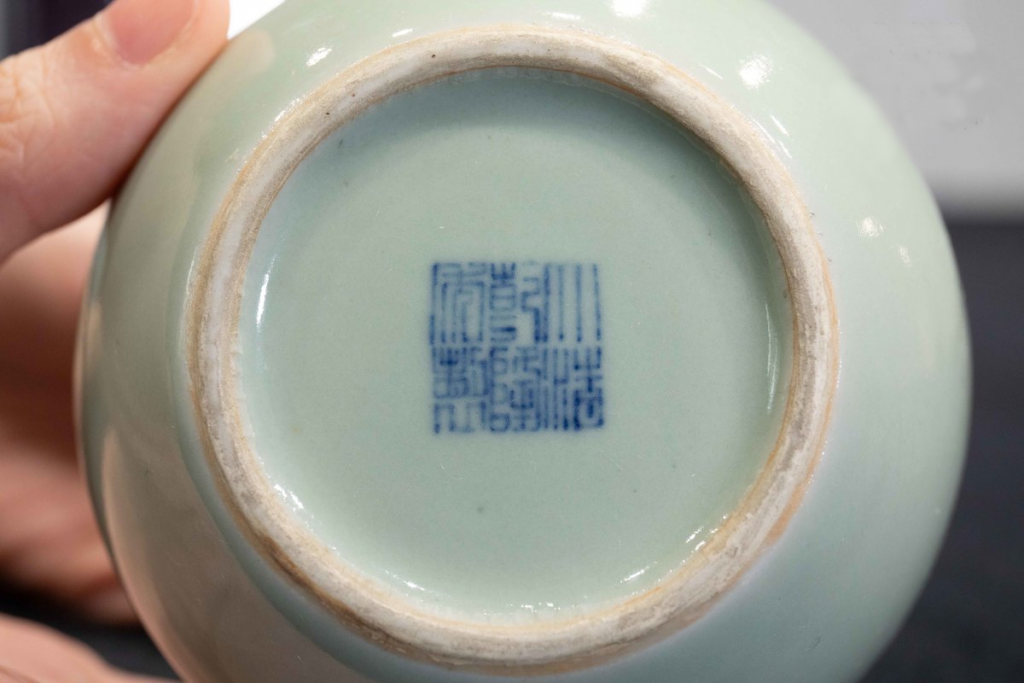
清乾隆 豆青釉紅彩絲帶紋小尊「大清乾隆年製」款
此件清乾隆「豆青釉紅彩絲帶紋小尊」,玲瓏小巧,尊身線條流暢,溫潤可人豆青釉之上,有一色澤瑰麗可人絲帶,更有細緻婉轉花紋在中悅目可人。此小尊乃清乾隆最為經典包袱式形制,更因是徐展堂舊藏,最令眾人矚目。
這種器形又稱「包袱尊」或「布袋尊」,清朝首創,有傳始燒於康熙年間,而此形制多見於雍乾,一般是在尊身上裝飾一凸雕的包袱巾或者是絲帶。
瓷器從唐代開始,多是表面光滑無比,簡素大雅。惟獨是到了清代的包袱尊,添了一大蝴蝶結,然而這樣的一添,簡單的器物頓添一道生機,更是吉祥之意洋溢:「包袱」和「包福」諧音,寓意幸福吉祥;絲帶古時又稱綬帶,「綬」諧音「壽」,有帶壽而來的意思。
小小一尊,看似簡單,其實越是小形制,越是難度高。把玩於手的小物,每一處細節即使肉眼難見,手一觸便可知。此小巧之尊,線條流暢,更是轉折之間,弧度多一分少一分都覺有違和感,想必是花盡了瓷工之心思,試驗了無數種樣式,方有此曼妙可人之品。
参考: Lot 842 清十九世纪 粉彩百蝶双喜纹盆
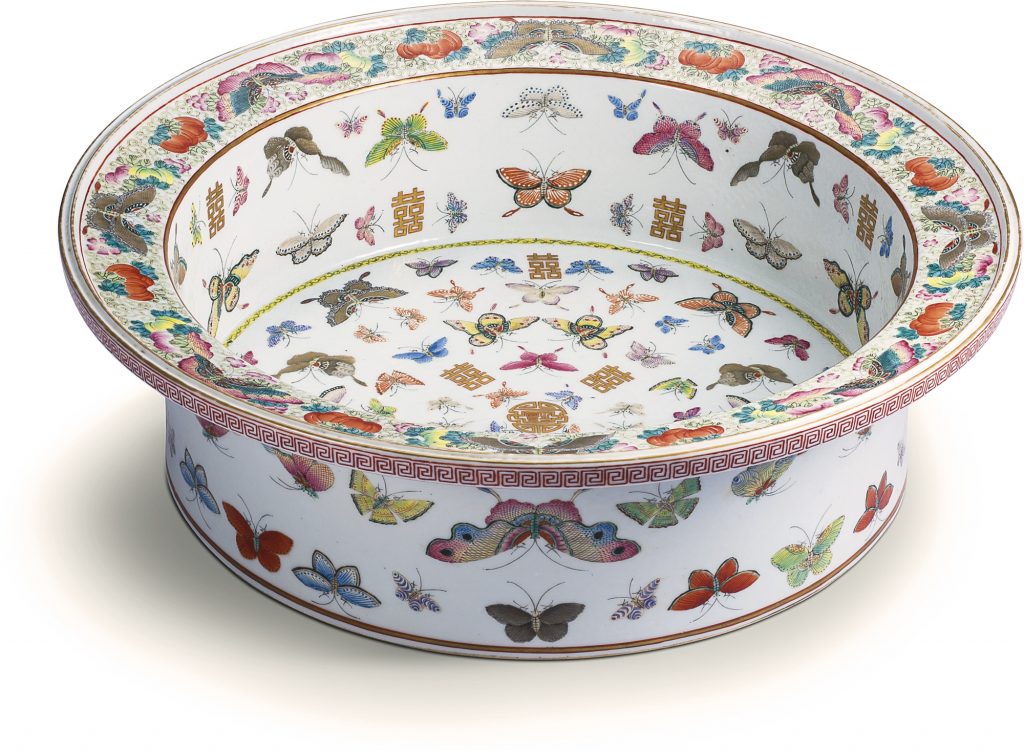
香港苏富比
估价:40,000-60,000 HKD
成交价: 325,000 HKD (含买家佣金)
参考:0023 清同治 黄地粉彩百蝶纹杯 (一对)
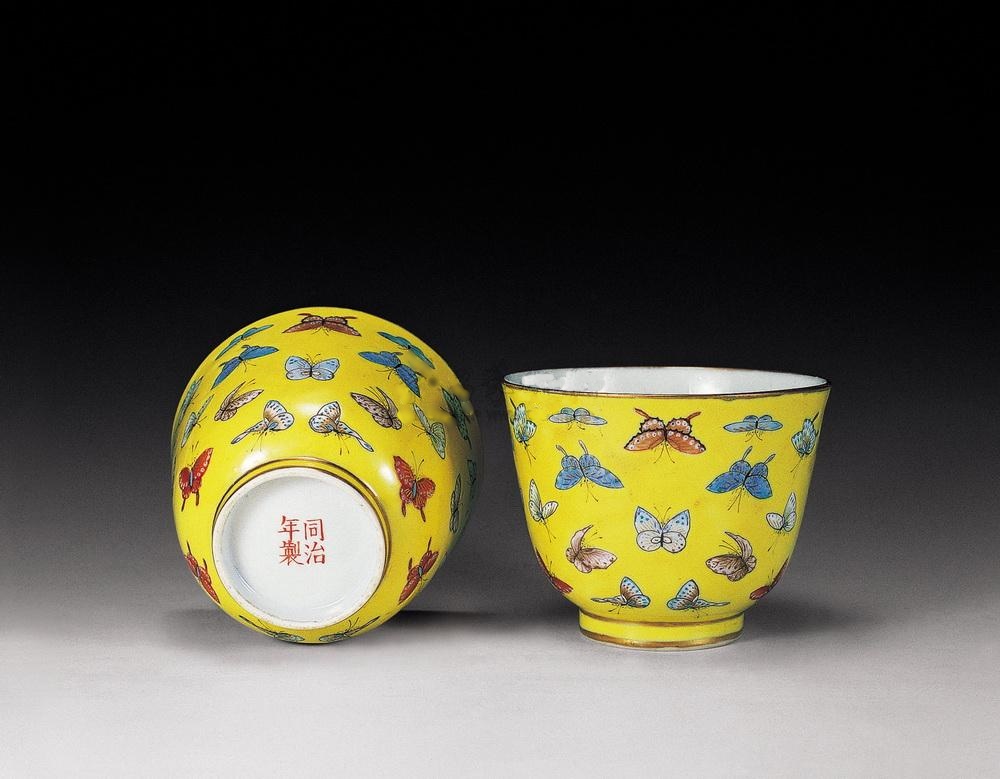
拍品信息
作者 — 尺寸 8.2cm
作品分类 陶瓷>清代粉彩瓷器 创作年代 清同治
估价 RMB 12,000-12,000
专场 2001春季文物展销会·瓷器玉器珠宝鼻烟壶 拍卖时间 2001-06-27
拍卖公司 天津文物 拍卖会 2001春季文物展销会
“同治年制”四字二行楷书款
参考:故宫收藏的黄地粉彩盘 黄地粉彩百蝶纹盘
黄地粉彩百蝶纹盘敞口,弧腹,圈足,足内红彩书“同治年制”4字楷书款。口沿饰金彩。盘内为黄地粉彩蝴蝶纹,盘外壁绘白地粉彩折枝牡丹纹、西蕃莲、莲花纹。
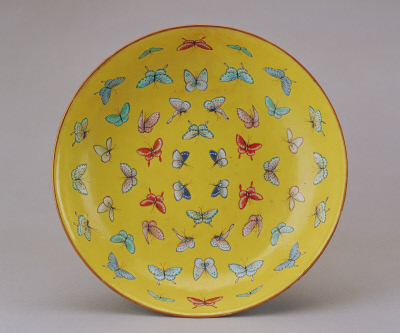
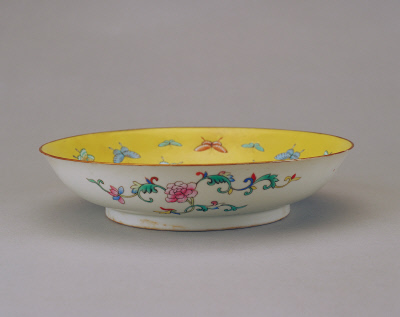
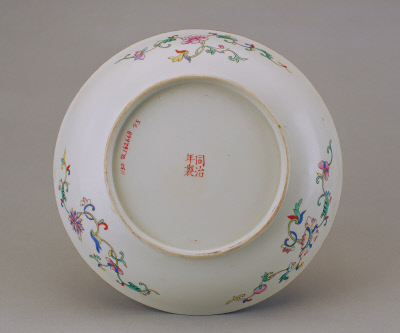
黄地粉彩百蝶纹盘,清同治,高5.1cm,口径22.2cm,足径13.3cm。
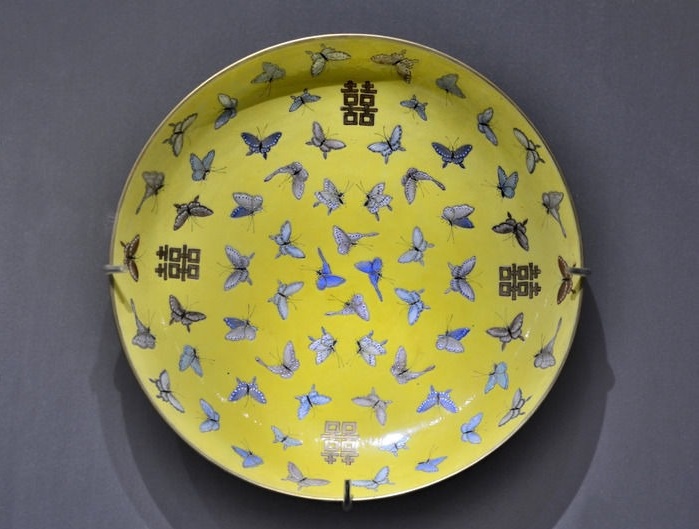
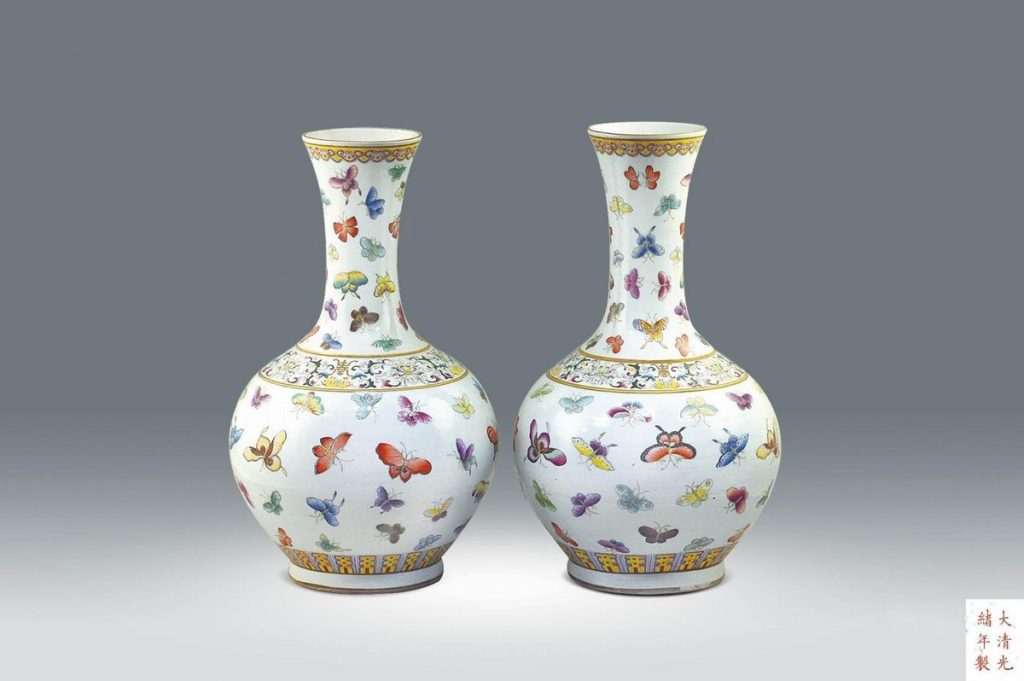
估价130,000至180,000
成交价184,000
类别陶瓷
作者 暂无
年代暂无
规格高36.5cm×2
预展时间–
预展地点——拍卖公司北京九歌国际拍卖有限公司
拍卖时间2011-06-10
拍卖会名称2011春季拍卖会
拍卖会专场瓷器杂项
拍卖地点国贸大酒店(国贸三期)三层聚贤宴会厅
拍品描述款识:大清光绪年制
参考: 拍卖结果 > 香港苏富比2016年春季拍卖会 > 中国艺术珍品 > 清十八世纪初 洒金铜狻猊獬豸纹双耳海棠式瓶《宣德年制》仿款
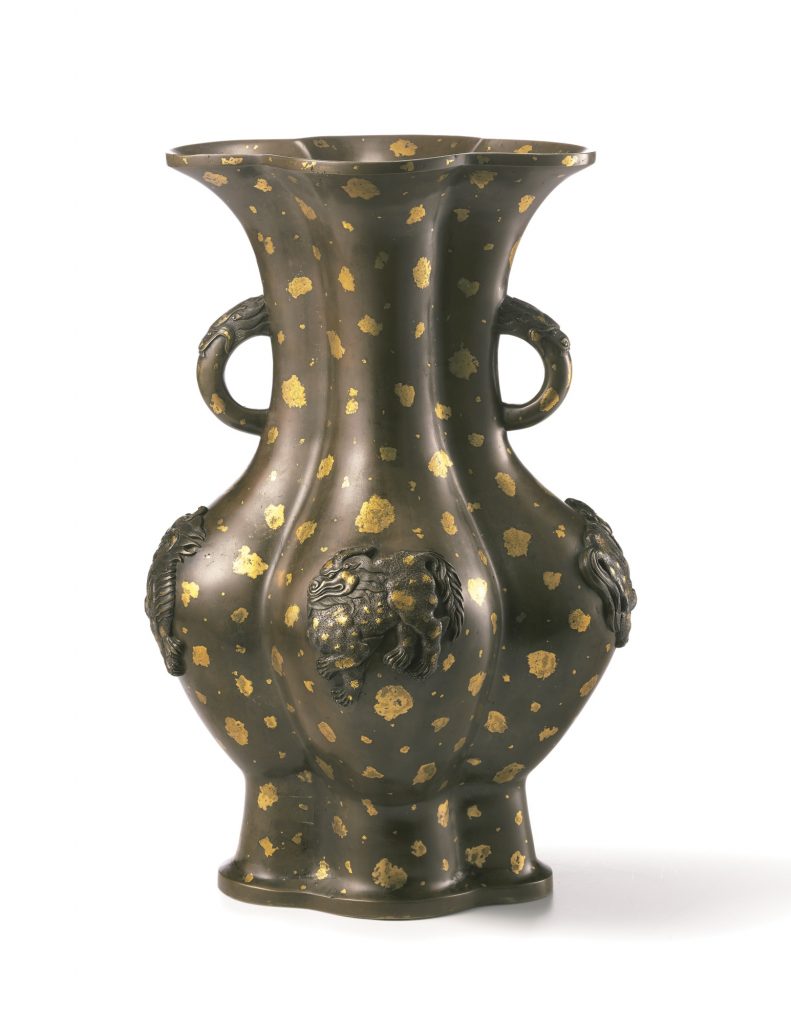
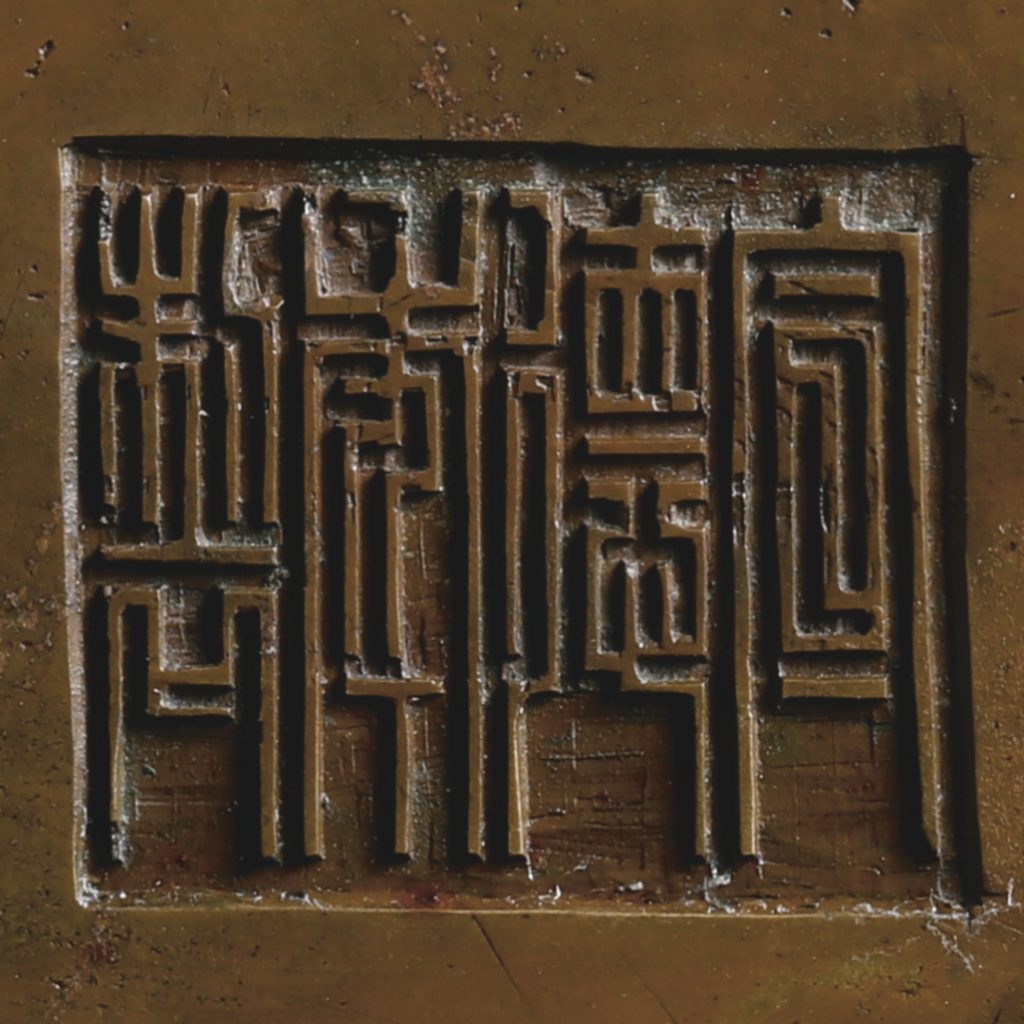
估价:600,000-800,000 HKD
成交价: 750,000 HKD (含买家佣金)
尺寸:
高40.9cm
拍品说明:
来源: John Sparks Ltd. 收藏,伦敦,1991年 伦敦佳士得1991年12月9日,编号54 Sydney L. Moss Ltd.,伦敦 出版: 胡广俊,《Later Chinese Bronzes – The Saint Louis Art Museum and Robert Kresko Collections》,圣路易 斯,2008年,编号21

![[临渊阁]天地一家春](https://www.antiquekeeper.ca/wp-content/uploads/2023/03/cropped-Asian-Art-Wallpaper-Painting3-6-3.jpg)

